Allison Collection Photos
March, 1944
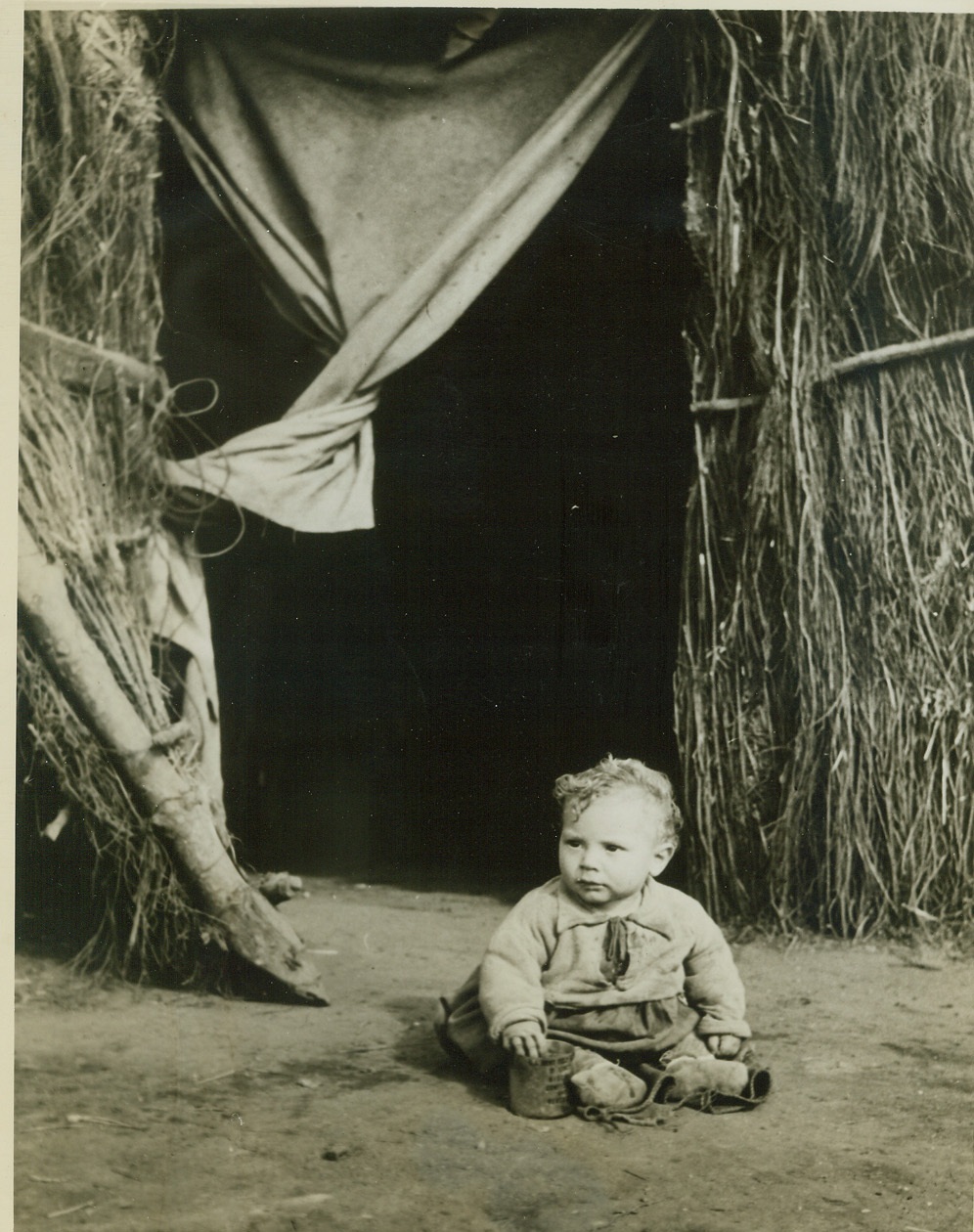
Grass Hut is Home to Him, 3/4/1944. Anzio, Italy – Playing quietly outside the entrance to the uncomfortable grass hut in which he and his folks live, this very young Italian boy is a member of one of many families left homeless when war came to Anzio. Their original home completely destroyed in the beachhead battle, the child’s family found refuge in the hut. Credit: (Official U.S. Navy Photo from ACME);
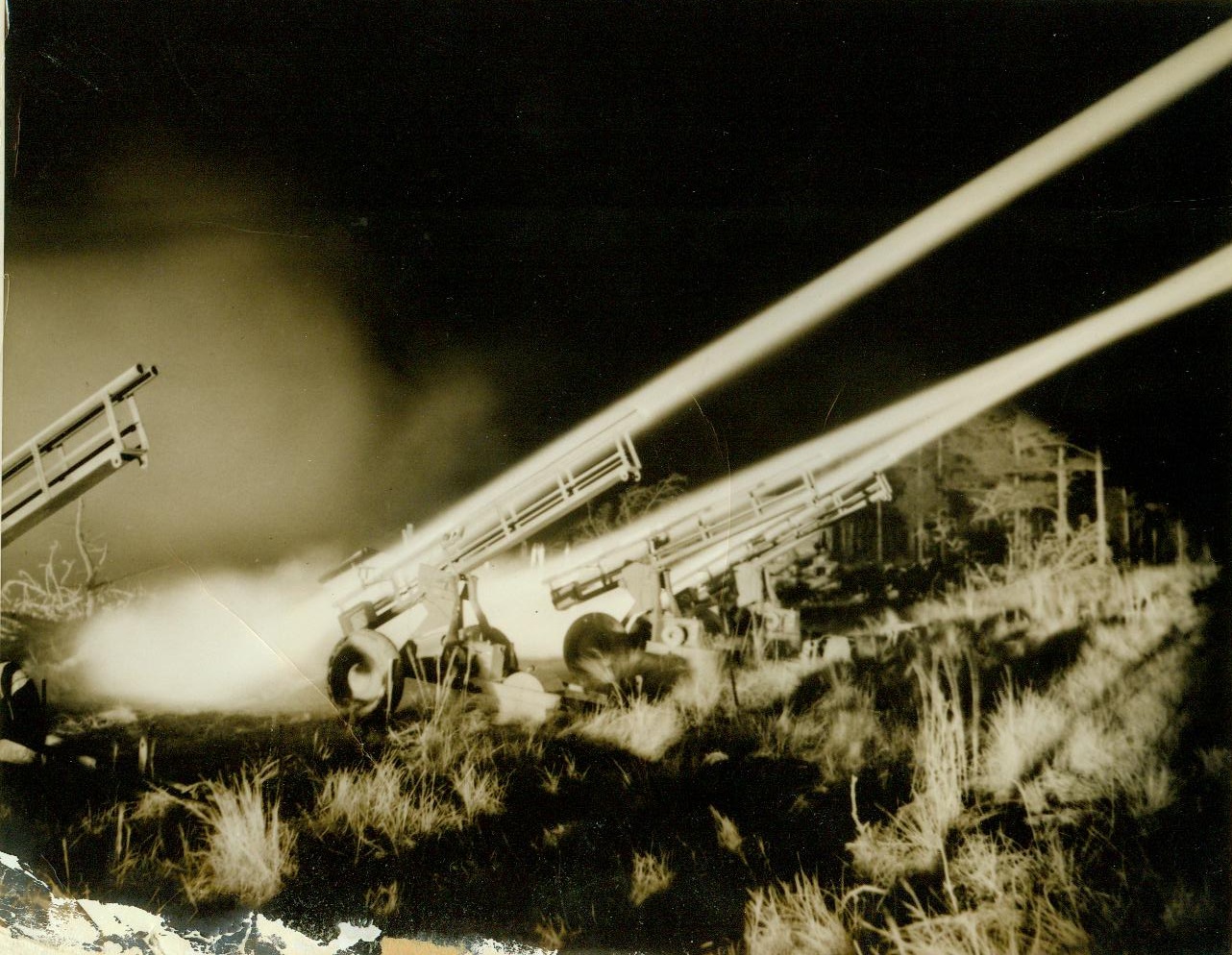
ROCKET TARGETS FOR ACK-ACK TRAINING, 3/8/1944. CAMP DAVIS, N.C. – Jet-propelled rocket targets are now being used to train anti-aircraft artillerymen at Camp Davis, giving our gunners practical experience in firing at “enemy planes” diving at terrific speed, and preparing them for action against the jet-propelled planes of tomorrow, should the enemy perfect such planes before the war is over. Fired from specially designed carriages, the rockets have an initial velocity of 450 miles per hour or 675 feet per second. They are released from the range at Holly Shelter, a Camp Davis firing point. Manning 50 caliber machine guns and 20 and 40mm weapons, the trainees improve their aim and accuracy as they track the fast-moving, 59-inch targets. The rocket always describes an approximate parabola and has a maximum horizontal range of about 2200 yards. The following photos show phases of rocket target practice by night and by day. NEW YORK BUREAU Here is a closeup of the launching carriages as the rockets zoom out of them. Leaving a cloud of bright dust on the ground behind the carriages, the targets cut a broad band of light in the sky. Credit: ACME;
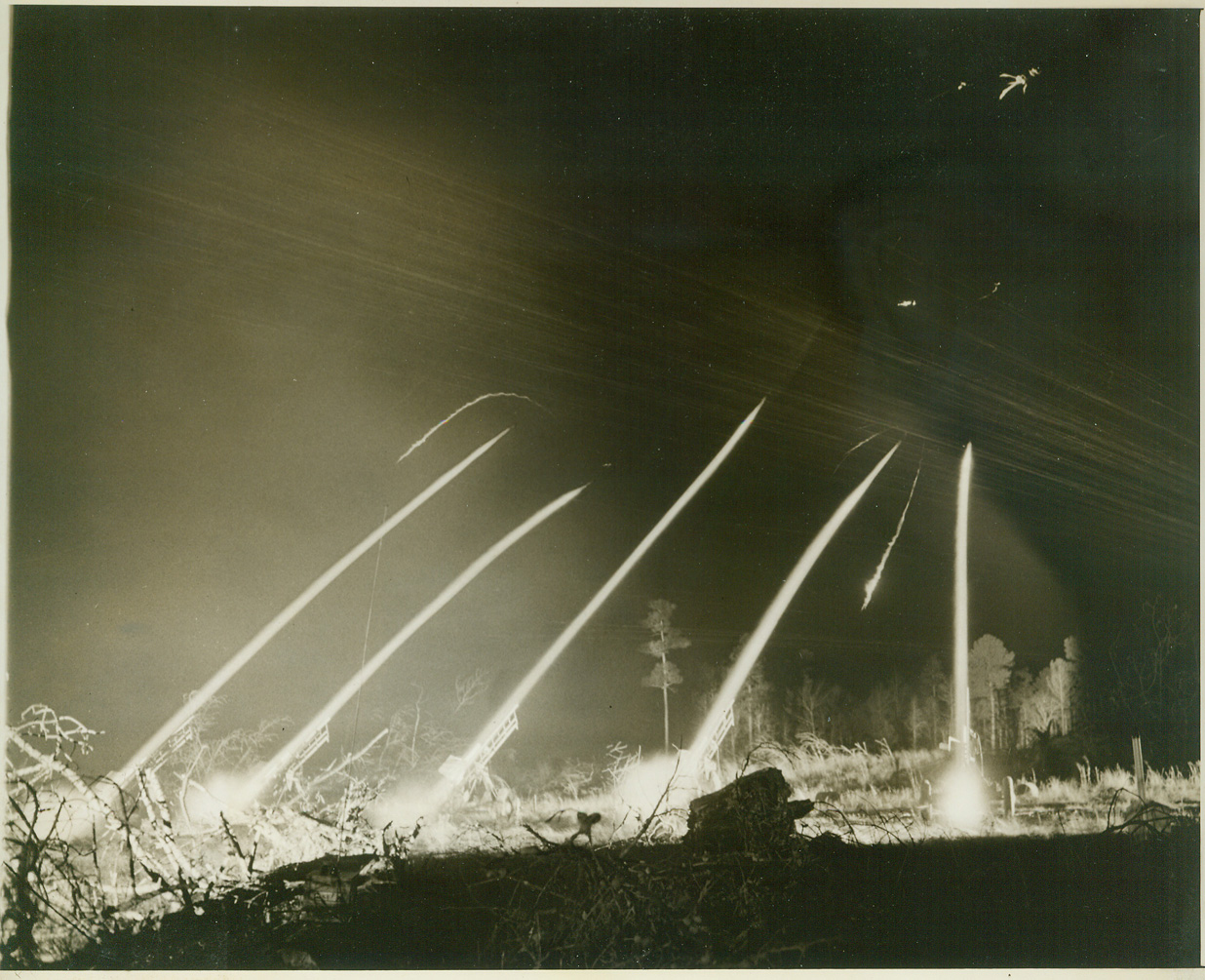
ROCKET TARGETS FOR ACK-ACK TRAINING, 3/8/1944. CAMP DAVIS, N.C. – Jet-propelled rocket targets are now being used to train anti-aircraft artillerymen at Camp Davis, giving our gunners practical experience in firing at “enemy planes” diving at terrific speed, and preparing them for action against the jet-propelled planes of tomorrow, should the enemy perfect such planes before the war is over. Fired from specially designed carriages, the rockets have an initial velocity of 450 miles per hour or 675 feet per second. They are released from the range at Holly Shelter, a Camp Davis firing point. Manning 50 caliber machine guns and 20 and 40mm weapons, the trainees improve their aim and accuracy as they track the fast-moving, 59-inch targets. The rocket always describes an approximate parabola and has a maximum horizontal range of about 2200 yards. The following photos show phases of rocket target practice by night and by day. NEW YORK BUREAU Streaking upward in thick, white streams, the rockets have barely left their launching carriages before they are caught in a web of anti-aircraft fire. Some of the jet-propelled targets have already been nipped, and their remains fall in thin streaks toward the ground. Credit: ACME;
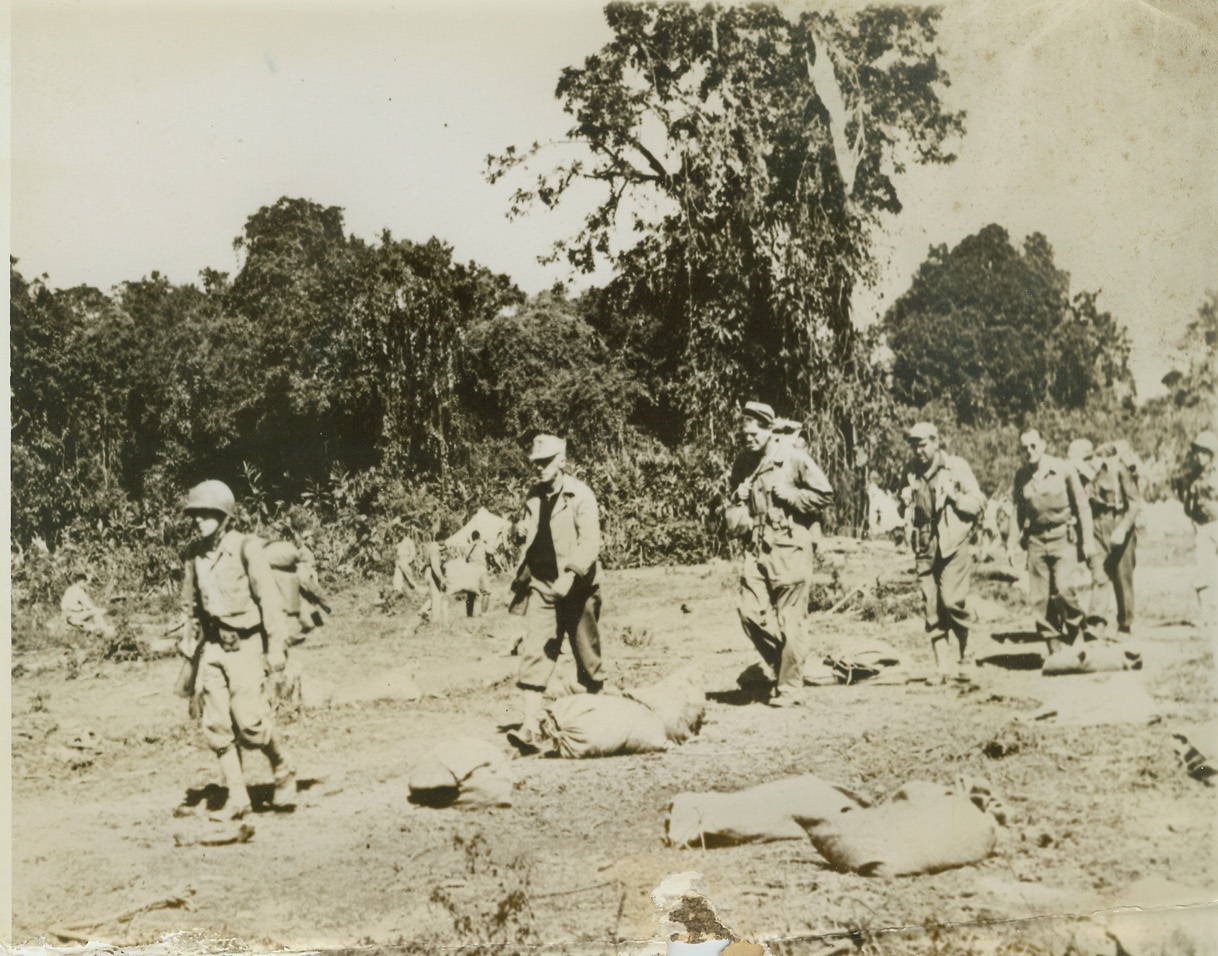
BURMA BATTLERS SUPPLIED BY AIR, 3/9/1944. BURMA – Marching over rough terrain to meet the Jap enemy, Lt. Gen. Joseph Stilwell (second in line) and a party of Yanks cross a field littered with supplies dropped by plane in the Hukawng Valley. It is in this Northern Burma territory that “Uncle Joe” was effectively trapped enemy forces, severing all lines of Japanese communication. Credit: ACME;
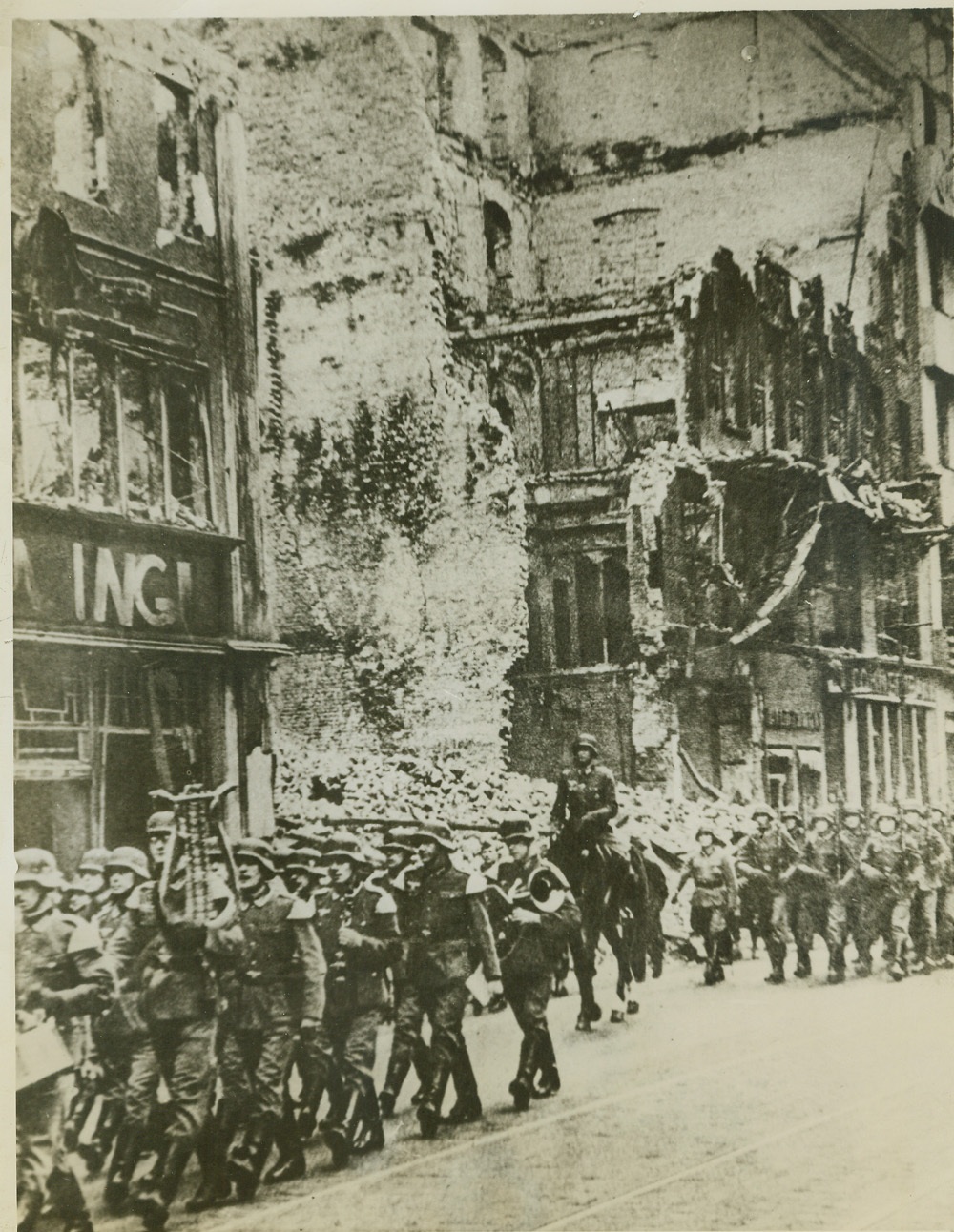
Morale Builders, 3/30/1944. Berlin – Trying to boost the morale of war weary Berliners, the victims of constant Allied bombings of that German city, a unit of the Reichswehp parades past blasted buildings through the shattered streets of Berlin. Martial music and the roll of drums accompany the marchers. Credit: (ACME);
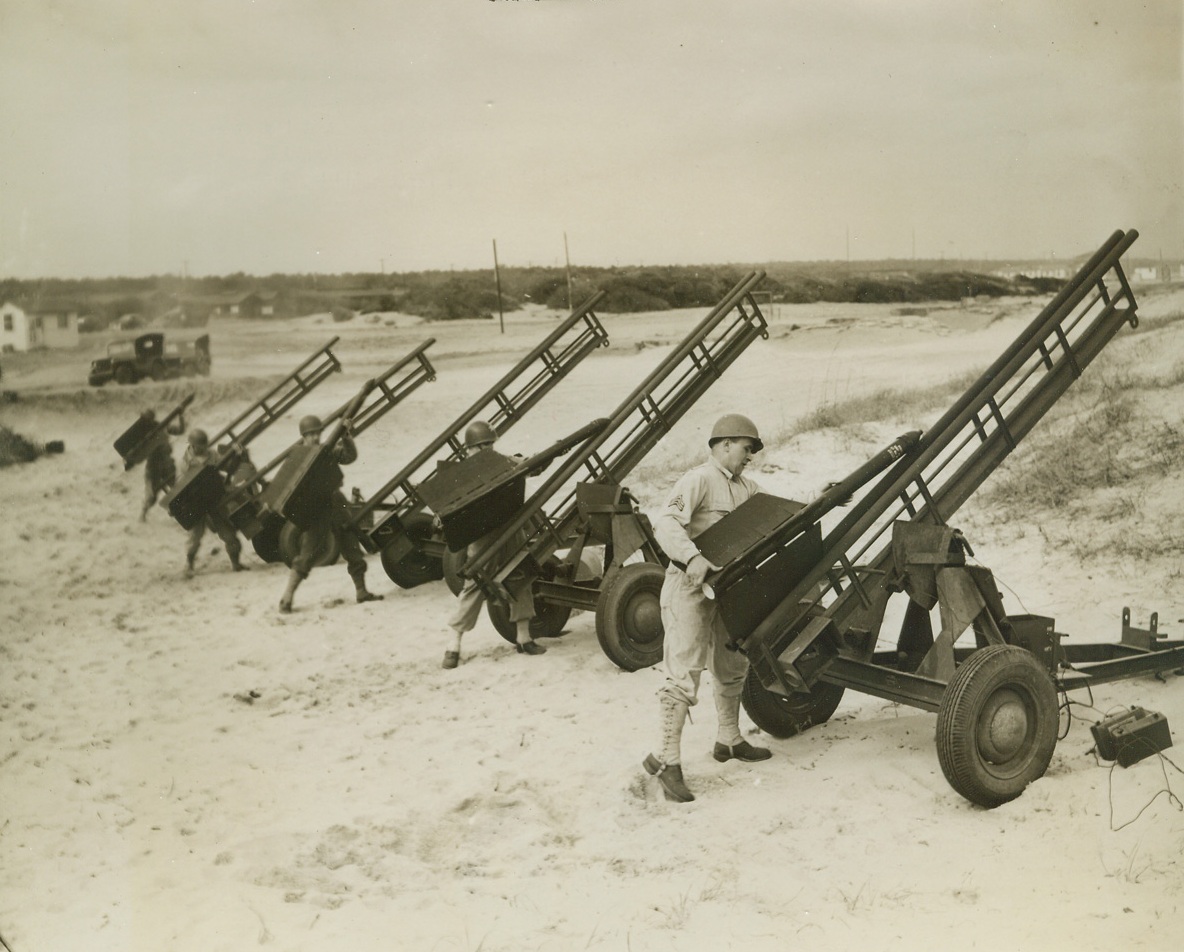
ROCKET TARGETS FOR ACK-ACK TRAINING, 3/8/1944. CAMP DAVIS, N.C. – Jet-propelled rocket targets are now being used to train anti-aircraft artillerymen at Camp Davis, giving our gunners practical experience in firing at “enemy planes” diving at terrific speed, and preparing them for action against the jet-propelled planes of tomorrow, should the enemy perfect such planes before the war is over. Fired from specially designed carriages, the rockets have an initial velocity of 450 miles per hour or 675 feet per second. They are released from the range at Holly Shelter, a Camp Davis firing point. Manning 50 caliber machine guns and 20 and 40mm weapons, the trainees improve their aim an accuracy as they track the fast-moving, 59-inch targets. The rocket always describes an approximate parabola and has a maximum horizontal range of about 2200 yards. The following photos show phases of rocket target practice by night and by day. NEW YORK BUREAU One man is all that’s needed to load one of the speedy jet-propelled targets onto the strange-looking launching carriage. One fin fits into the narrow groove between the railings that form the nose of the carriage. Here, five of the launchers are loaded at the same time. Credit: ACME;
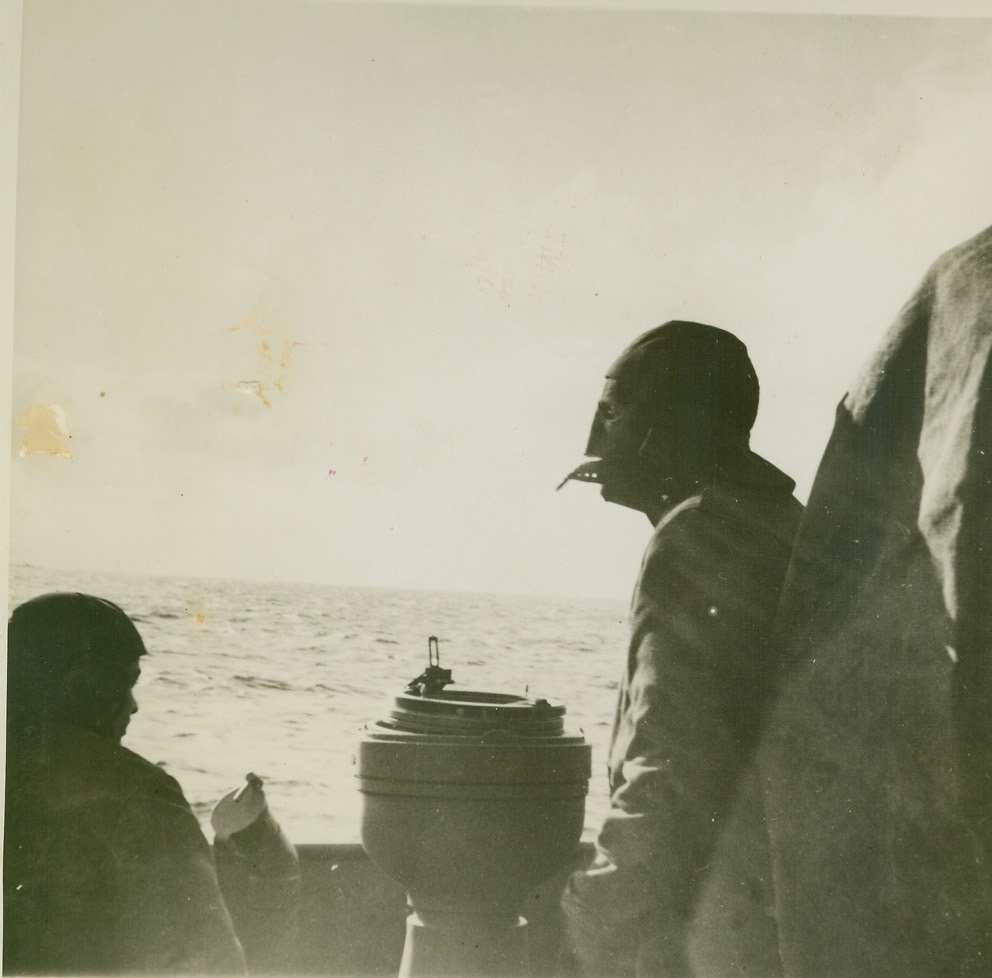
JAPAN, HO!, 3/2/1944. SOMEWHERE IN THE PACIFIC – Lookouts of a U.S. Naval Task Force which shelled Japan’s big base at Paramushiro in the northern Jkuriles early in February wear face masks for protection against biting wind and icy spray as the force steamed on its way. It may have been this lookout who first sighted the Nipponese mainland. Credit: ACME;
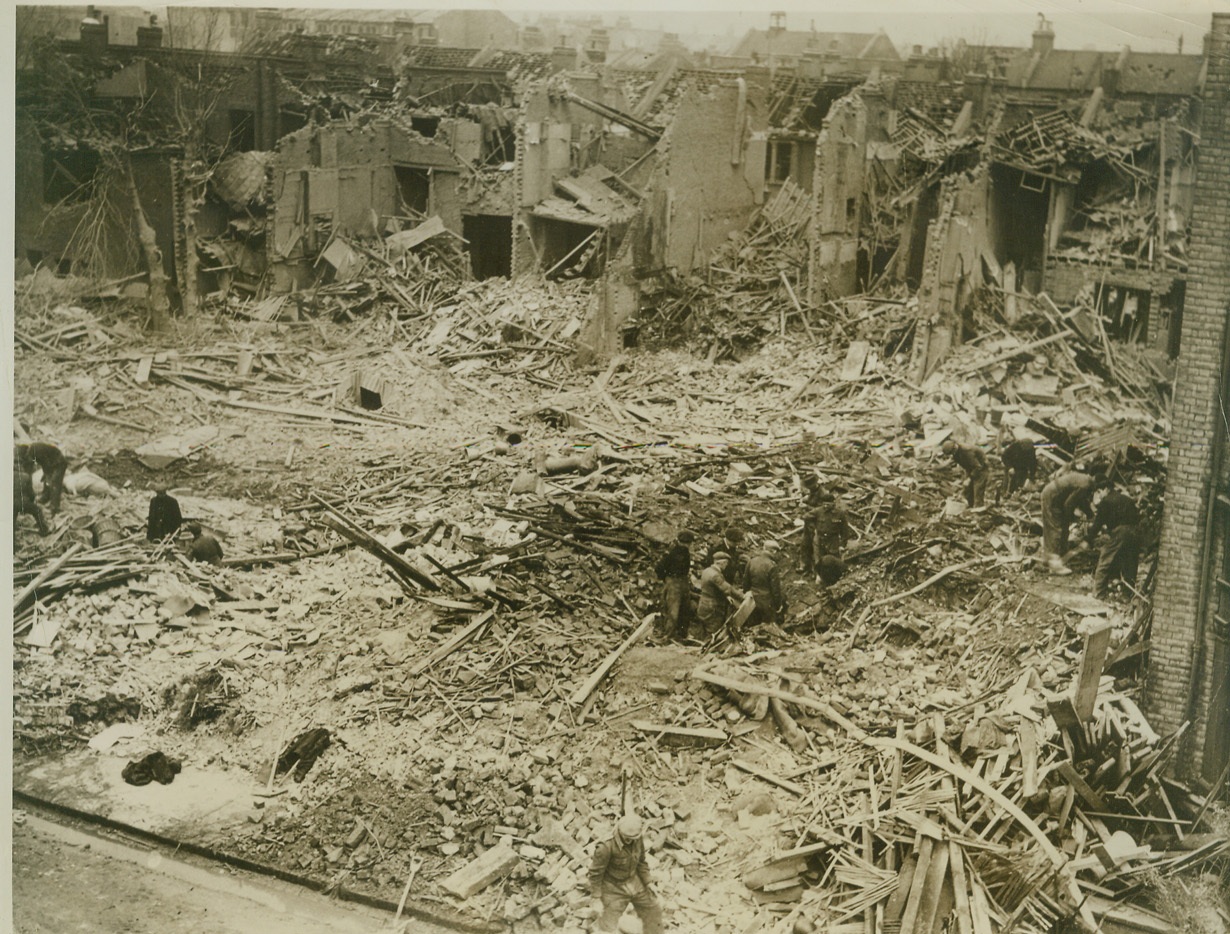
HUNTING FOR THOSE WHO WERE TRAPPED, 3/4/1944. LONDON – Rescue workers dig through great piles of bomb debris, hunting for trapped victims of a Nazi night raid over this residential section of London. Dropping incendiary and explosive bombs among the homes, the enemy raiders turned the district into a shambles. Credit: ACME;
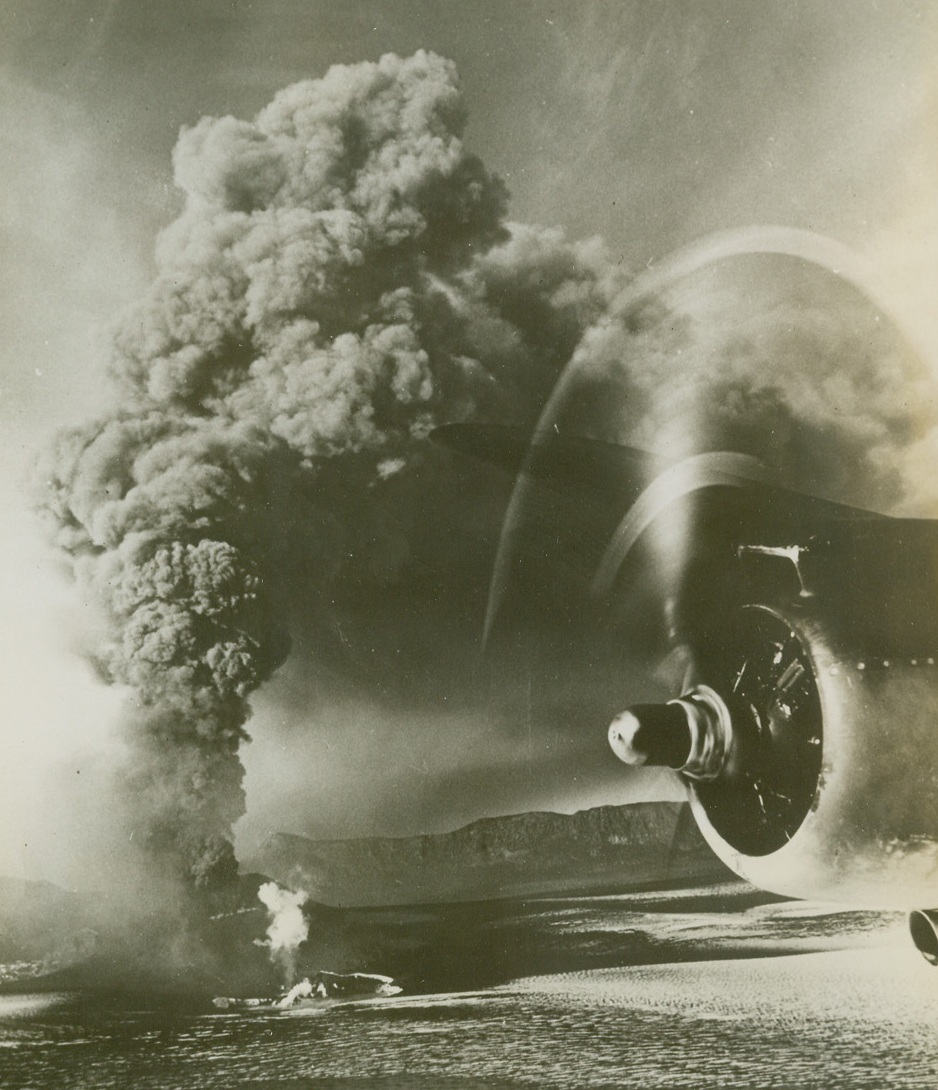
Aleutian Island Volcano, 3/30/1944. MT.VENIAMANOF, ALASKA – Out on the tip of the Alaskan peninsula Mt. Veniamanof, oldest known volcano and estimated to have reached a height of 18,000 to 20,000 feet before top of the crater blew off, sends up billows of black smoke as it slowly builds up new crater inside the old one. This remarkanle picture was made from nose of Naval Air Transport Service Plane by a pilot-photographic officer on cargo passenger flight from Seattle, Wash., to Alaska and the Aleutian Islands.Credit: ACME;
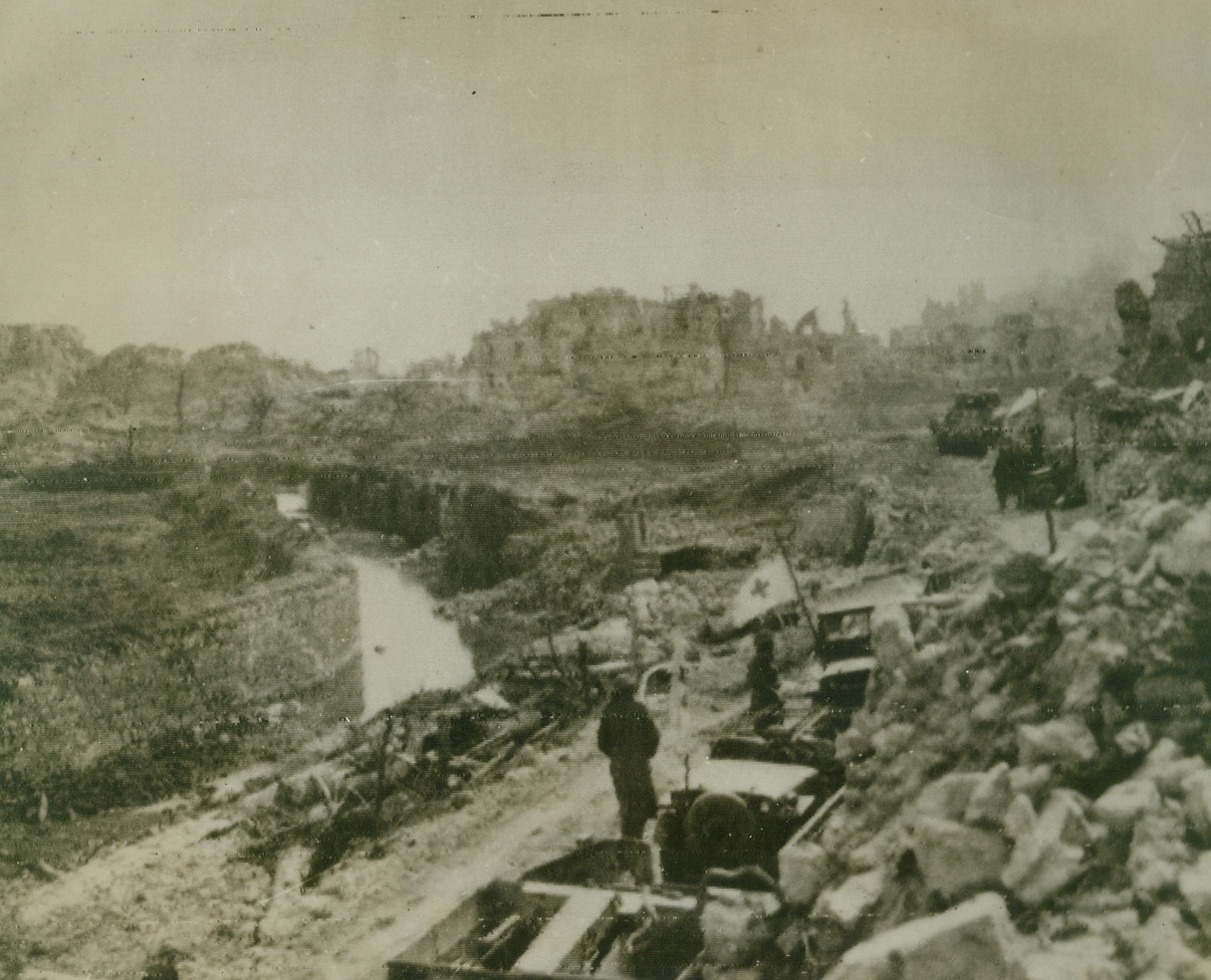
ENTERING “CITY OF THE DEAD, 3/20/1944. This photo, flashed to the U.S. by radio today, shows a long line of Red Cross and patrol vehicles, pausing behind the shelter of piles of rubble, just before entering Cassino, Italy, following the Allied “obliteration raid”—heaviest of the war—on the town. German paratroops, landed after the raid, put up stubborn resistance, but today, all but a section of the southern part of Cassino was in Allied hands. Note ruined buildings (background in photo) marking the terrific destruction wreaked by Allied bombs.Credit: U.S. Signal Corps radiophoto from Acme;
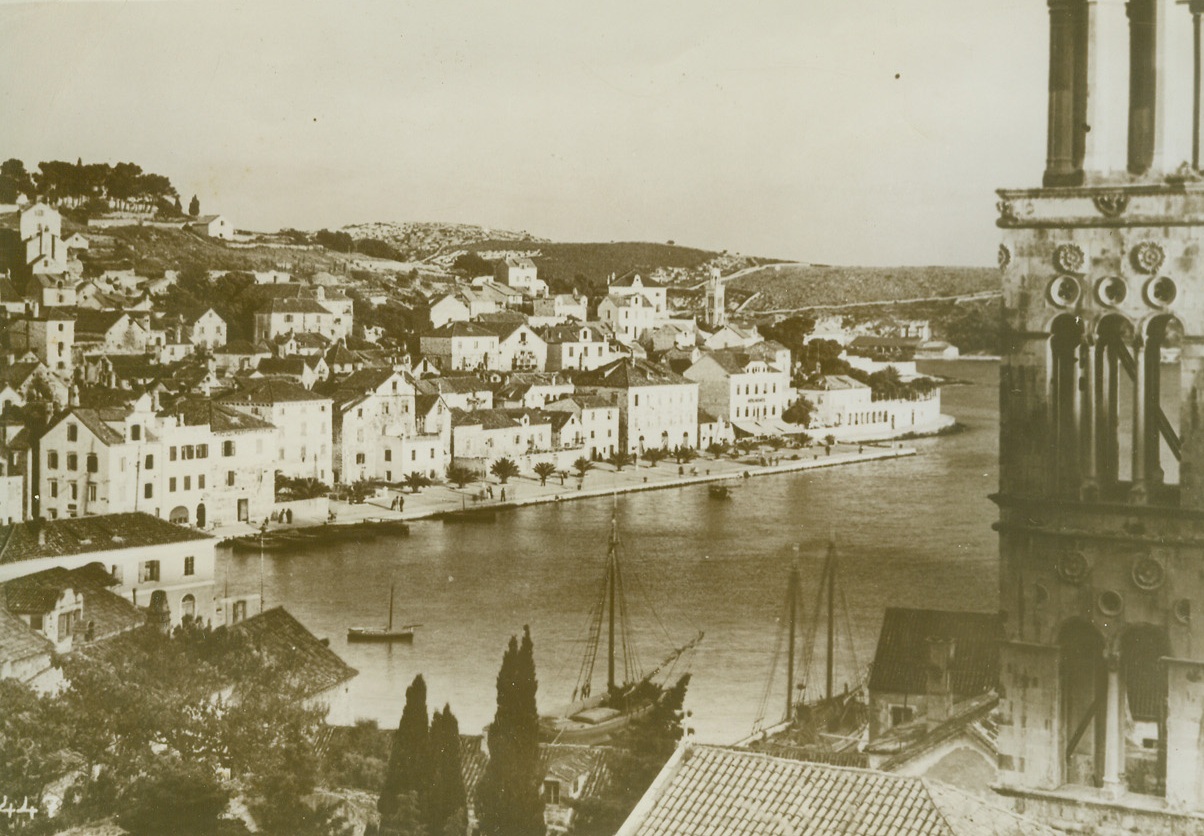
Partisans Take Hvar, 3/28/1944. Hvar Island—Aided by Allied air, ground, and naval forces, Jugoslav partisans captured the island of Hvar, 25 miles below the Dalmatian port of Split, giving the Allies a possible base for an invasion of Jugoslavia. The strategically-located island was captured after three days of fighting, and about 100 German men and officers and Facists were taken prisoner. Here is a general view of the harbor of Hvar. Credit: ACME.;
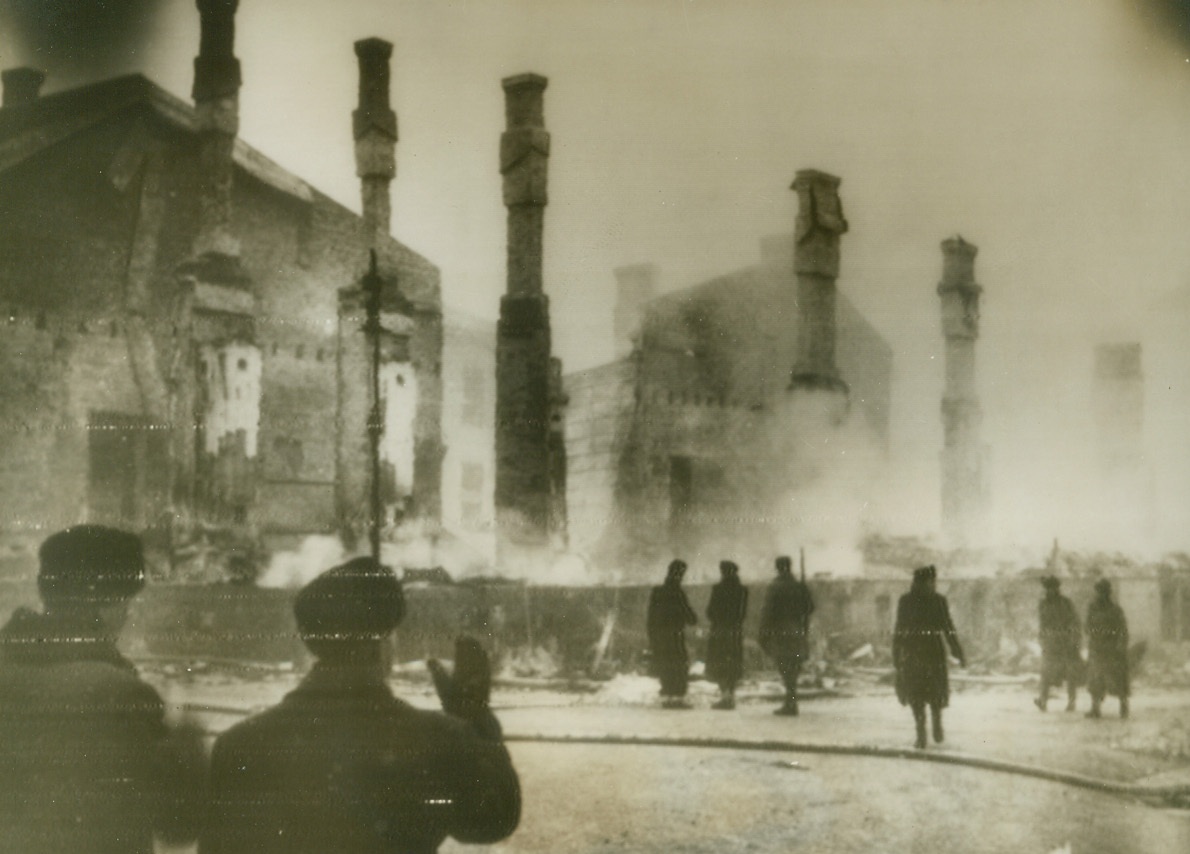
Peace-Persuader, 3/7/1944. Finland—The 600-plane Russian raid on Helsinki, February 26, “completely devastated a quarter in the central part of the city which appears to be an industrial area of the Finnish capital. Russia’s promise of continued aerial bombardment until Finland got out of the war probably speeded the peace negotiations now in progress. (Photo radioed from Stockholm to New York today). Credit: ACME radiophoto.;
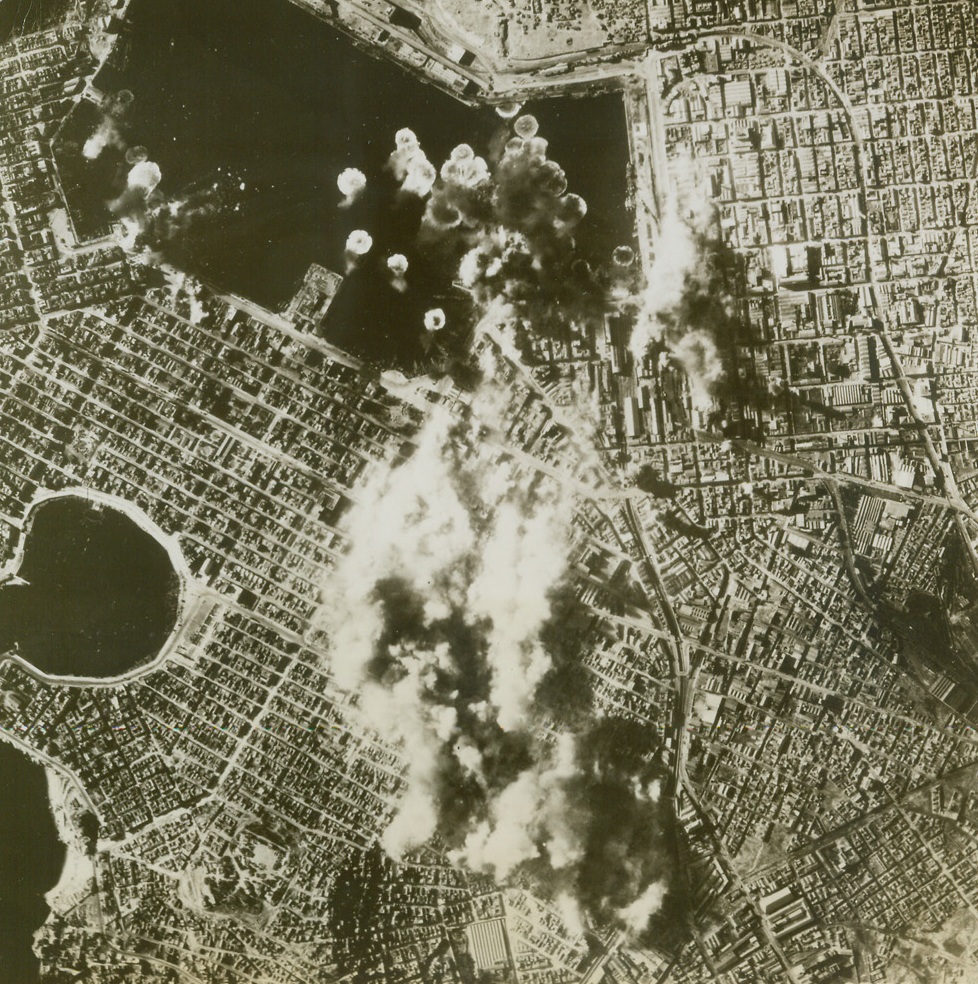
Bomb Athens Harbor, 3/31/1944. ATHENS, GREECE—Clouds of smoke rise from the bomb-battered dock area of Athens, one of the vital German supply centers in the Eastern Mediterranean, after a raid by B-17’s of the U.S. 15th Air Force. German-held airfields near Athens are often the target of raiding American bombers, whose “eggs” are aimed at knocking out Nazi communications in war-torn Greece. Credit: U.S. ARMY AIR FORCES PHOTO from ACME.;
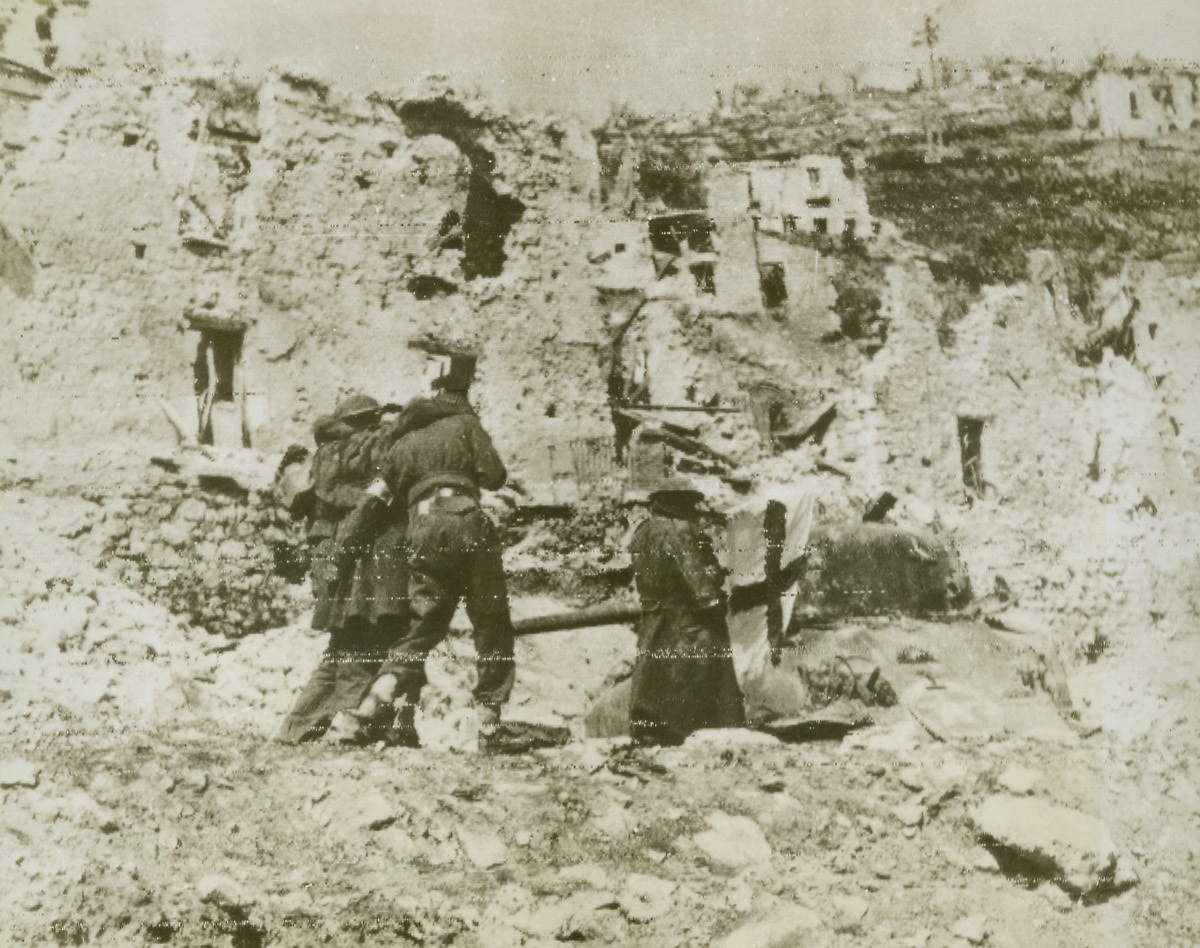
Wounded Return, 3/31/1944. CASSINO, ITALY—With the flag of the Red Cross waving protectively before them, wounded New Zealand warriors are helped back from the fighting lines in Cassino area. With one arm slung over the shoulder of each medical corpsman helping him, one of the fallen fighters stumbles through the ruined sector. Credit: OWI radiophoto from ACME.;
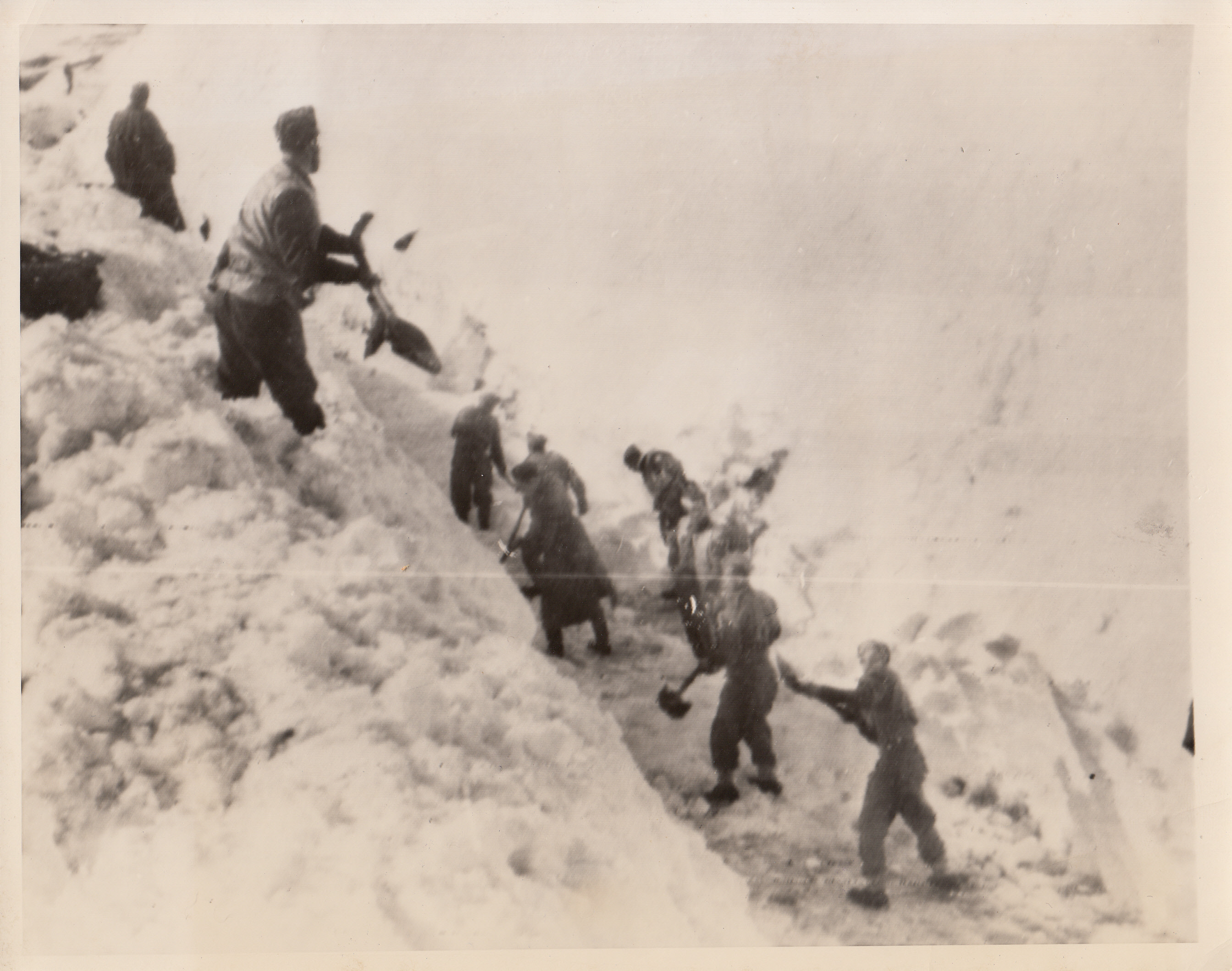
Fighting Polish Sappers, 3/27/1944. ITALY—Polish Sappers, who are fighting the Nazis in Italy are shown digging a roadway from under a heavy coat of snow.;
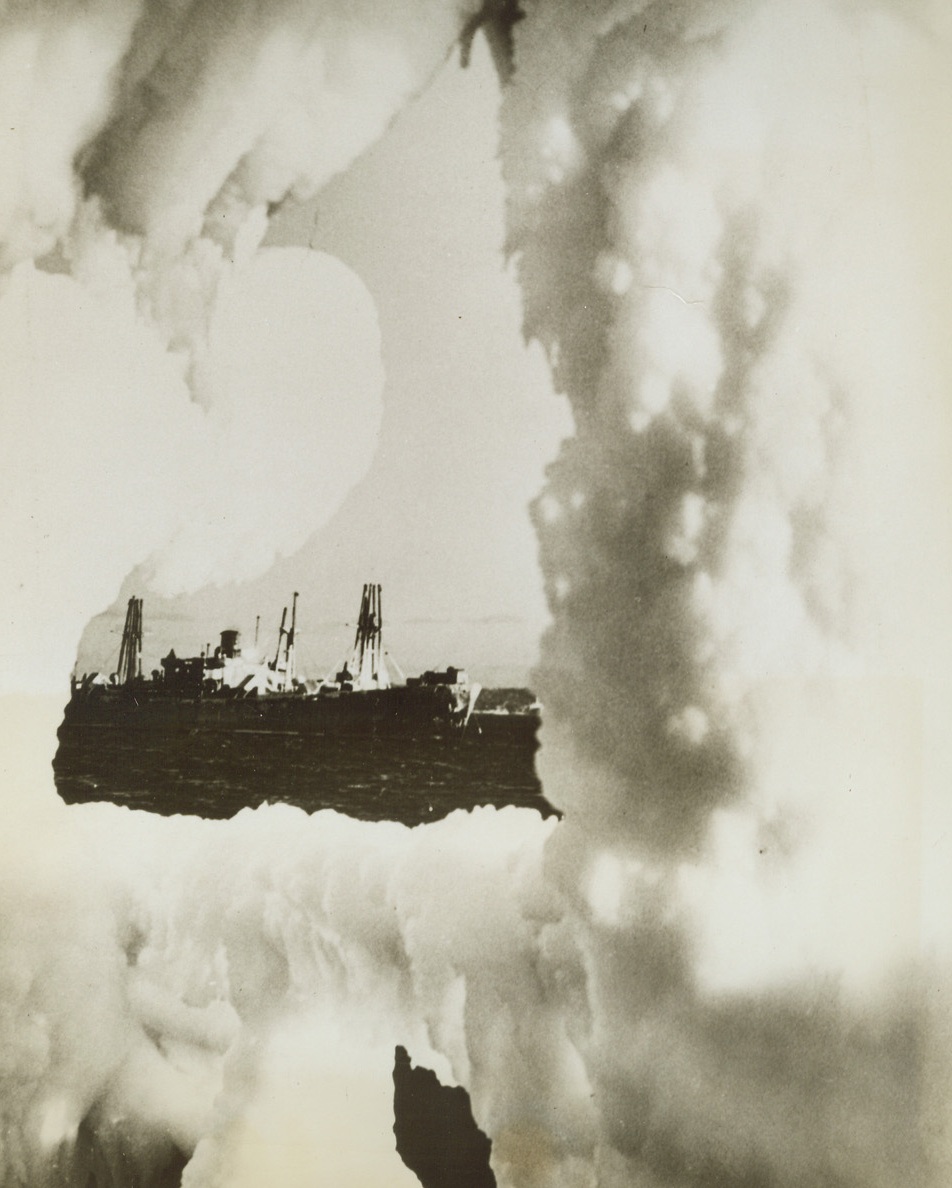
Ice-bound, 3/26/1944. NORTH ATLANTIC—A Royal Canadian Navy Corvette comes back from North Atlantic convoy escort duty heavily coated with ice. Disagreeable atmospheric conditions such as this indicates the struggle that goes on in the shipment of material and troops going overseas. The picture of the ice-free ship in the background was taken from the guard-rail of the ice-laden vessel.;
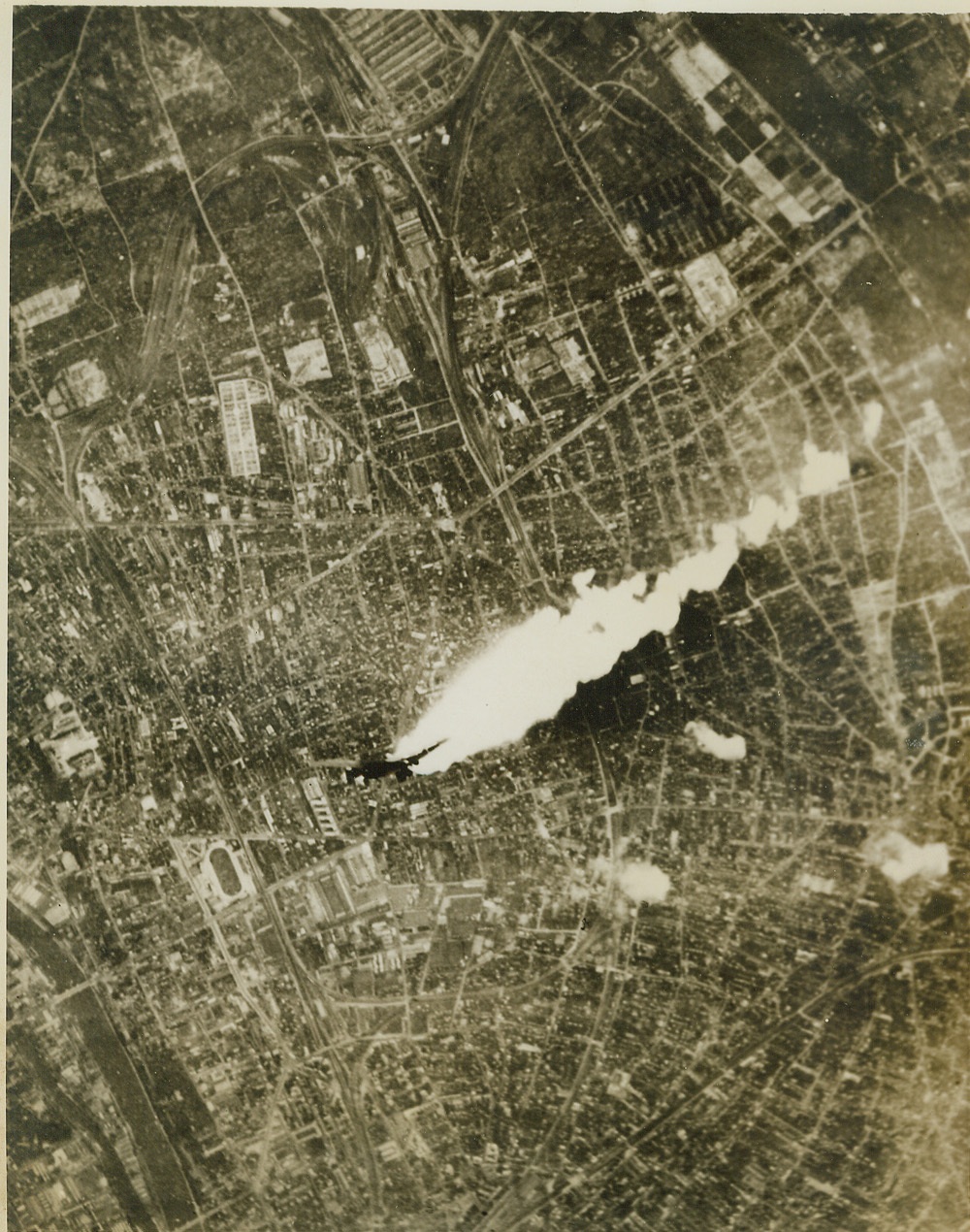
Death Dive of a Fortress, 3/6/1944. With a 400-foot streamer of white-hot flame trailing from its right wing, an American Flying Fortress hit by German flak over Paris, dives to its doom in the streets of the city below. Credit: (U.S. Army Air Forces Photo from ACME);
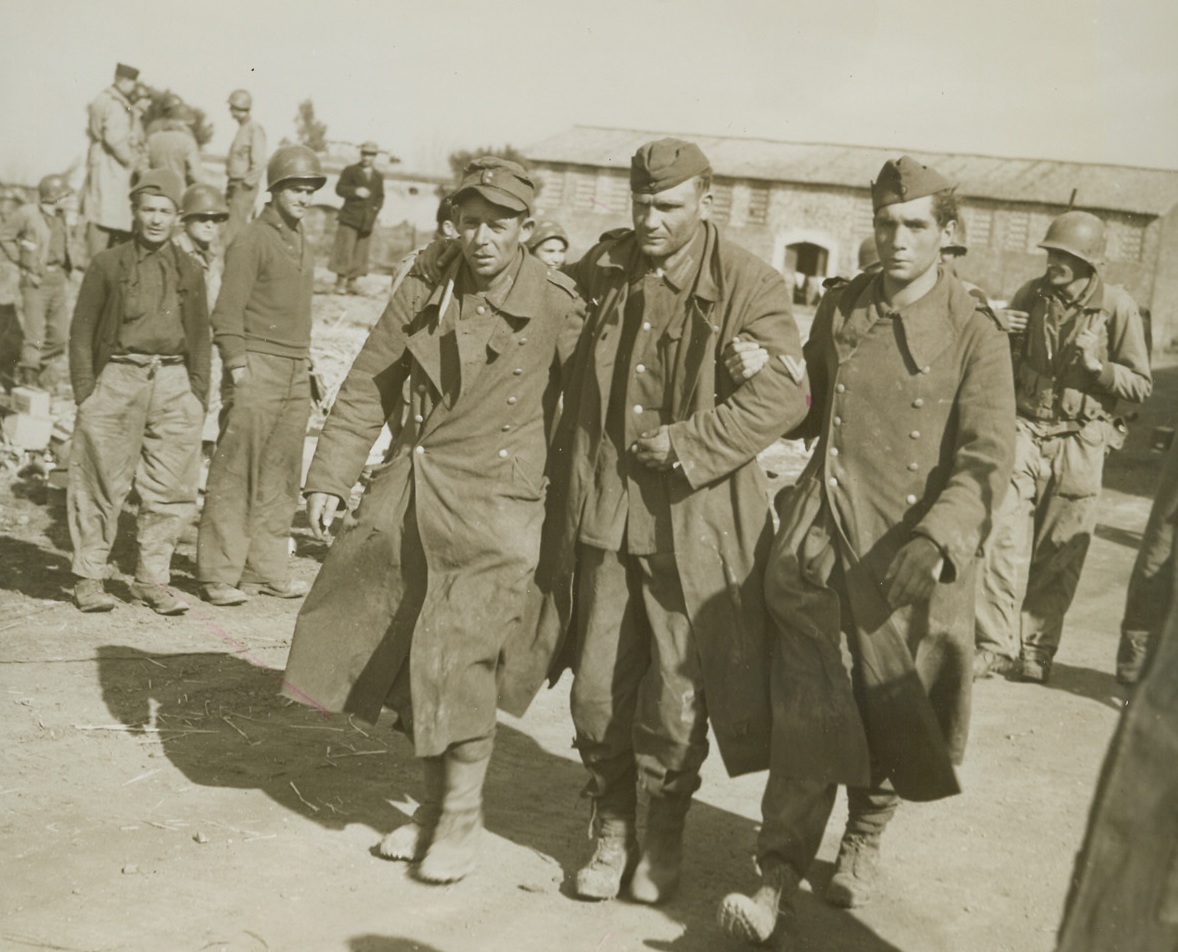
Helping Wounded Captive, 3/3/1944. CARROCETA, ITALY—A pair of angry-looking Nazi captives help a wounded buddy along as they are led to a prisoner of war cage behind Allied lines in Italy. Surrounded by an armored division thrust during the fighting new Carroceta, the Germans surrendered to Fifth Army infantrymen. Credit: ACME PHOTO BY SHERMAN MONTROSE FOR THE WAR PICTURE POOL.;
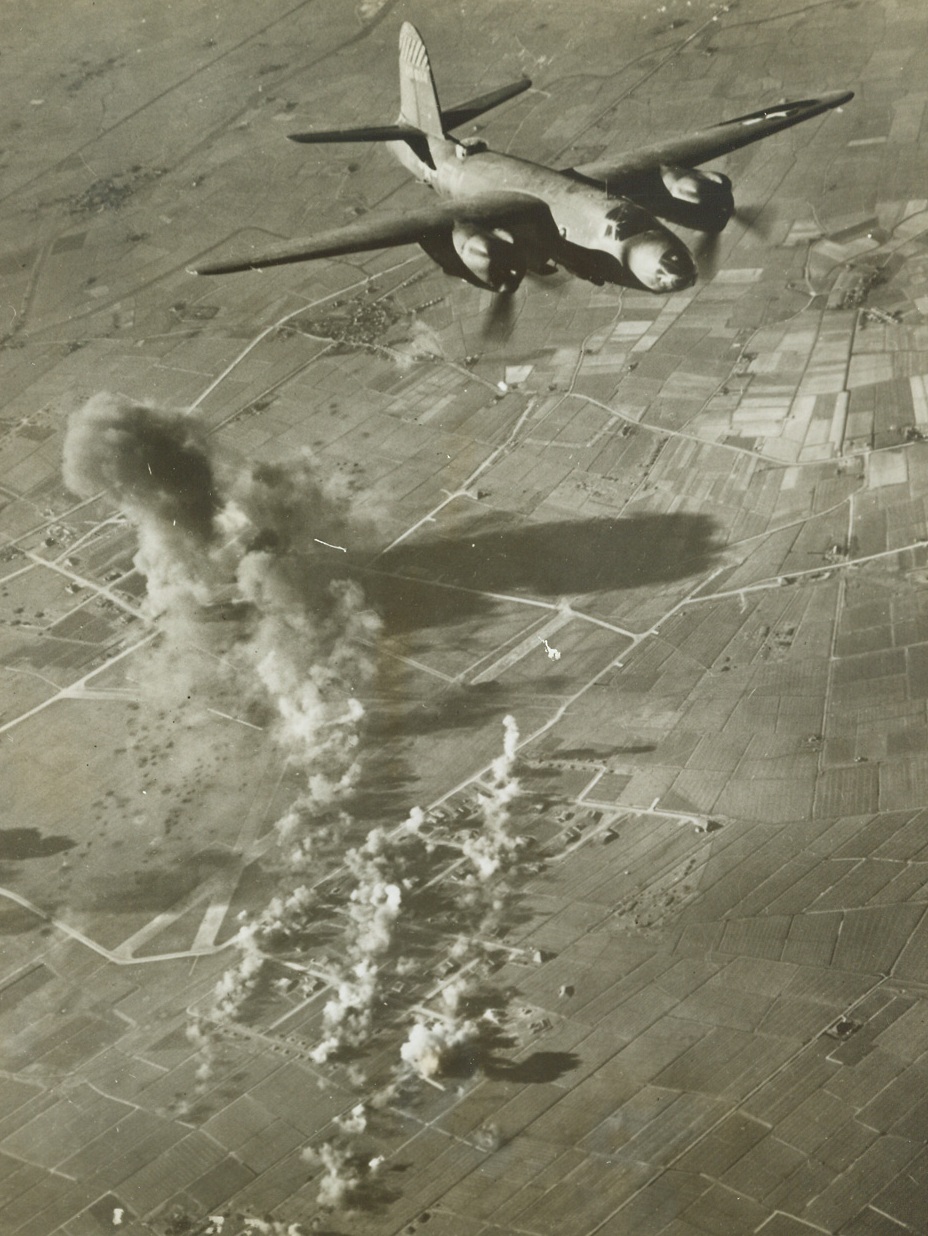
NAZI AIRDROME GETS A SCIENTIFIC MAULING, 3/9/1944. LEEUWARDEN, HOLLAND—Her bomb-bay doors wide open, a B-26 marauder roars over a Nazi airdrome at Leeuwarden, Holland where three paths of bombs cut squarely through a large dispersal area containing numerous aircraft shelters. A concentration of bombs has hit a fuel dump at the other end of the German base while at the extreme left a shadow cast by smoke rises from still another dispersal area (not shown in photo). The Ninth Air force medium bombers are continuing to give enemy airdromes in western Europe a scientific pounding.Credit: Acme;
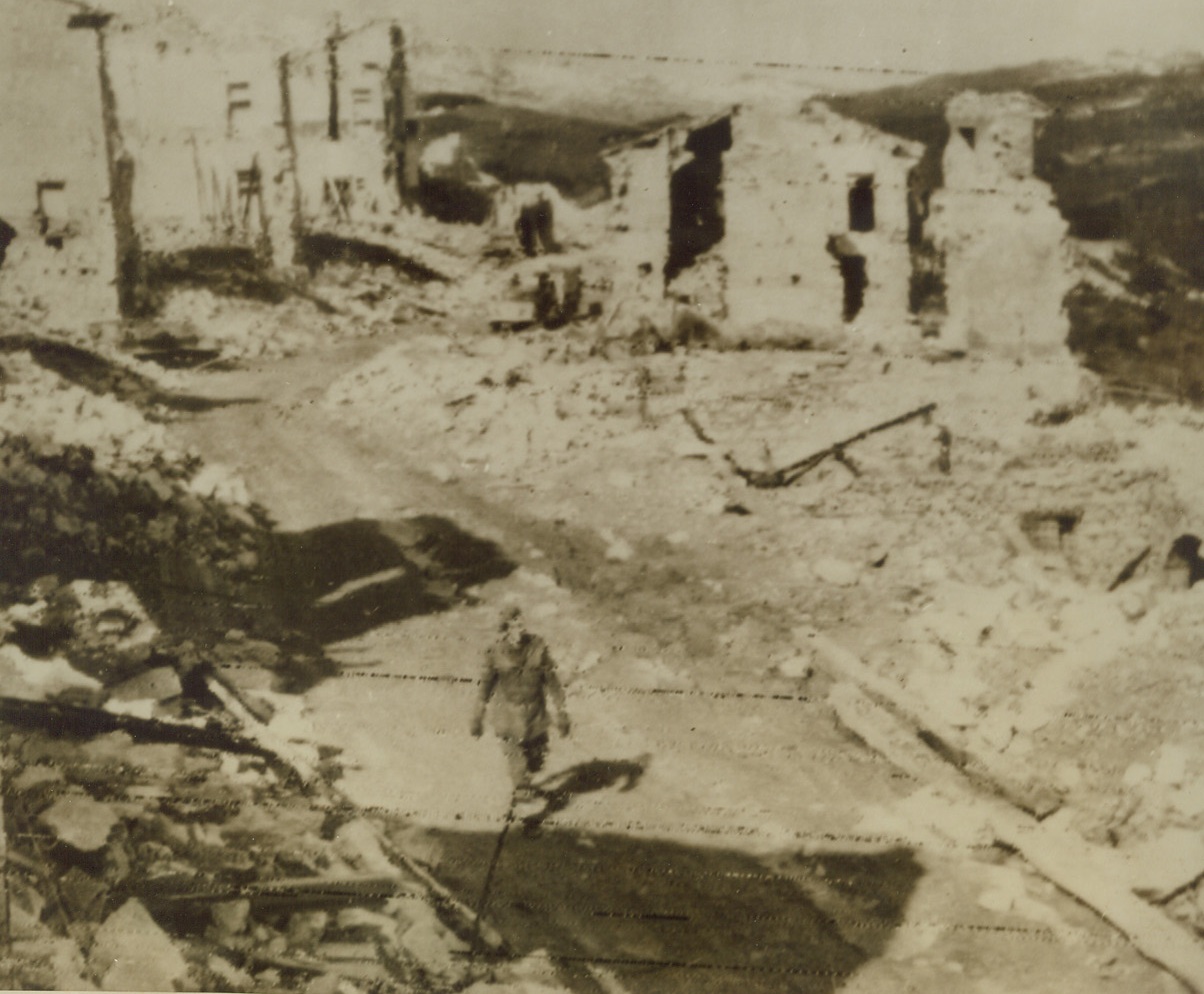
GERMANS LEAVE DESTRUCTION IN THEIR WAKE, 3/27/1944. ITALY—All that remains of this Italian city, San Pietro are ruins and destruction by the Germans shortly before their retreat from the city. An English tommy is walking among the wreckage.Credit: Acme;
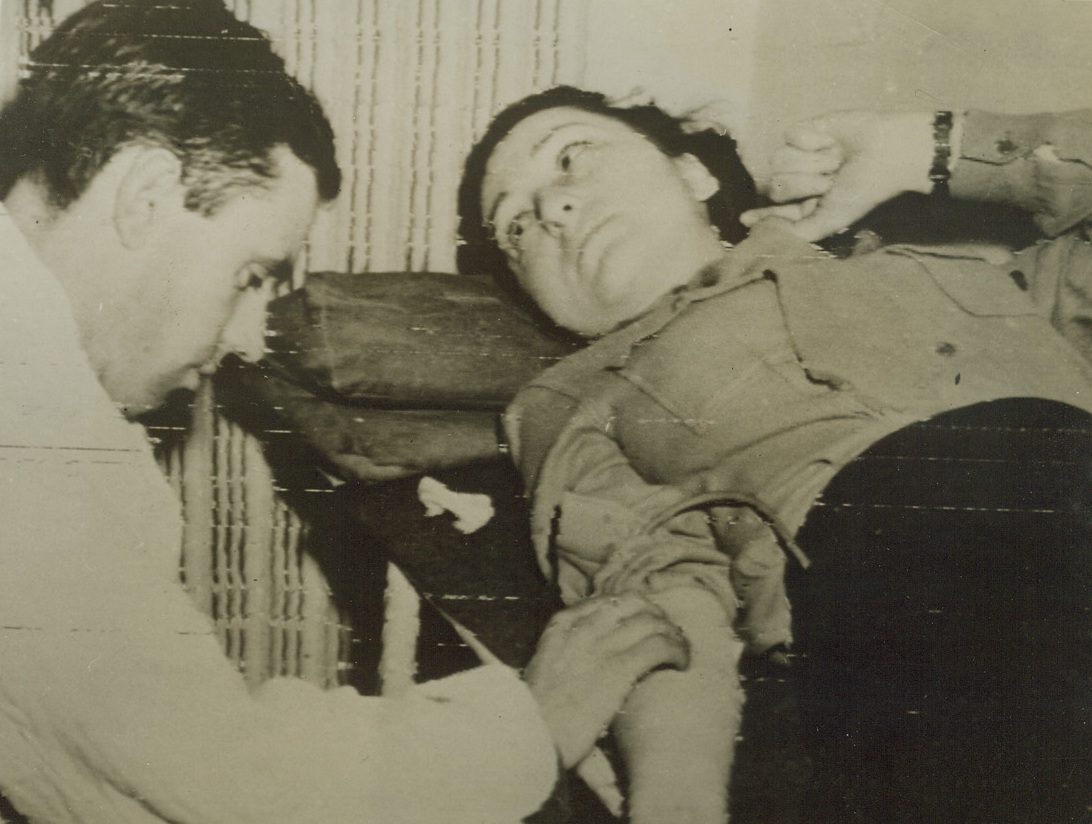
THEY GIVE THEIR BLOOD, TOO, 3/4/1944. ITALY—As if they weren’t already doing their part for the Allied cause, WACs of the 15th USAAF, stationed in Italy, jumped to answer an emergency appeal from the Fifth Army front for type “O” blood donations. First Lt. Elizabeth Ray of Oklahoma City, Okla., was the first of our girls in khaki to donate her blood. Attending is Pvt Leo Moyse of Cornwall, England, who is with the British 5th Transfusion Unit. Credit: U.S. Signal Corps Radiotelephoto;
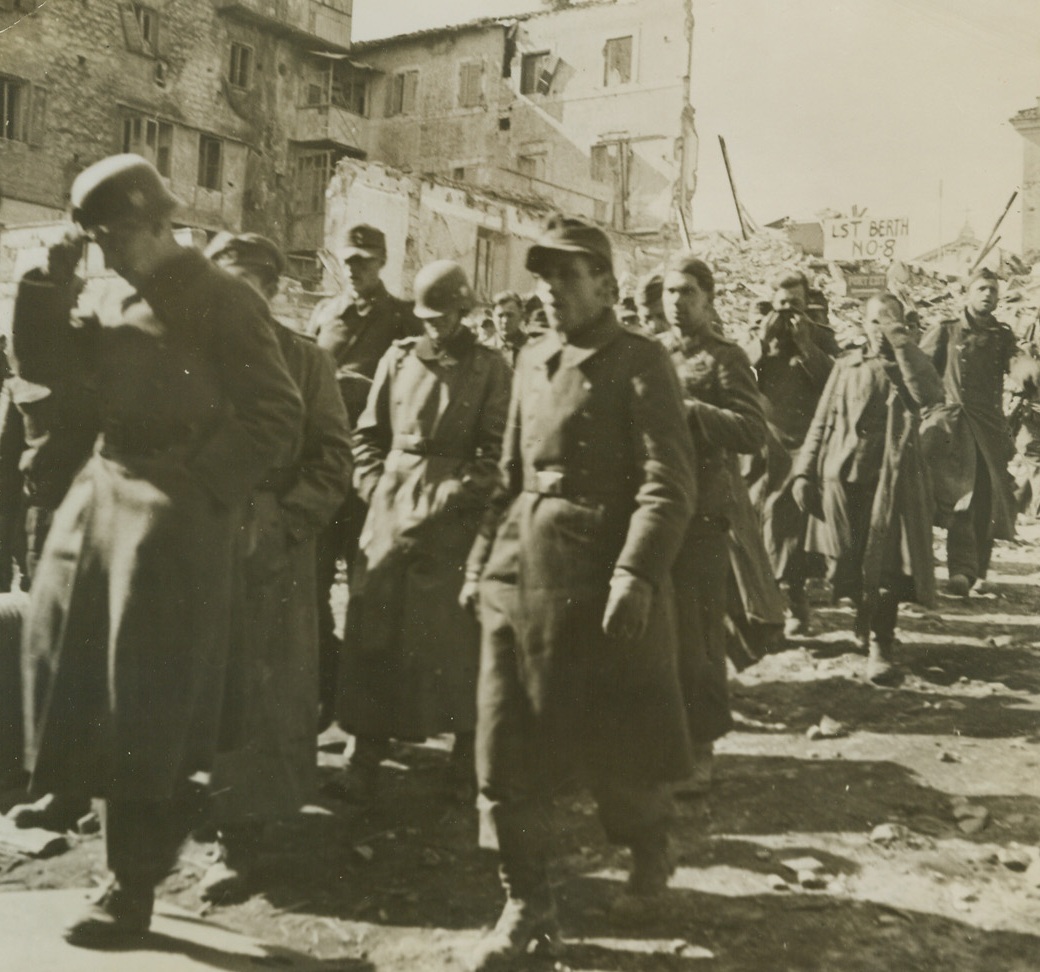
WOULD-BE CONQUERORS REACH ANZIO, AT LAST, 3/4/1944. ANZIO, ITALY—Anzio was the goal for these Nazi warriors, who fondly hoped to march through the Italian town as conquerors. But they came to Anzio as prisoners, taken in the bloody battle for the beachhead below Rome. Some try to hide their faces as they march down to a ship that will take them to a behind-the-lines prison camp. In background are the ruins of the Italian coastal town. Credit: Official U.S. Navy photo from Acme;
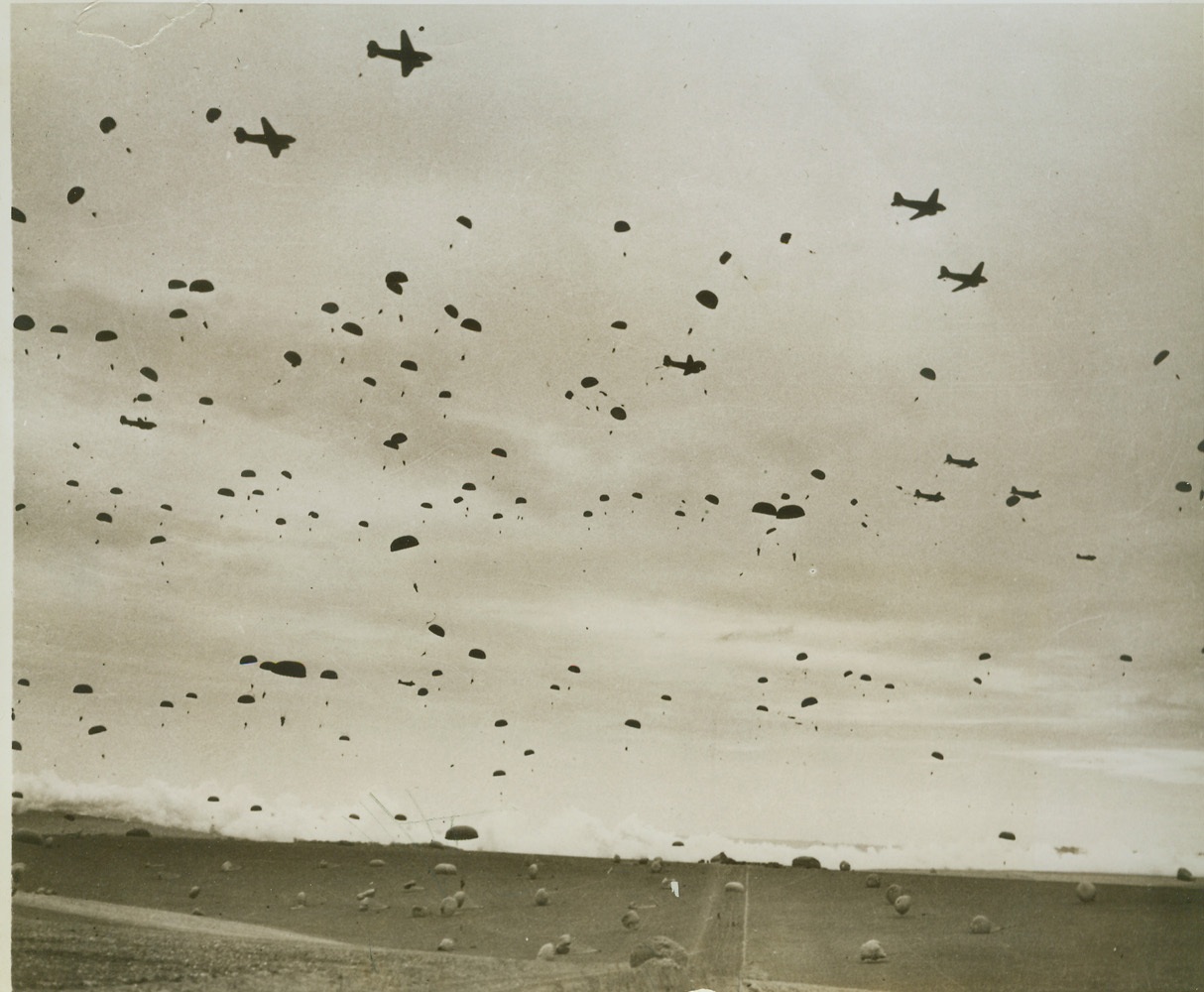
Parachute Maneuvers Over the United Kingdom, 3/31/1944. ENGLAND -- Hundreds of parachutes cover the ground and fill the air during recent maneuvers of the Ninth Air Force Troop Carrier Command in the United Kingdom. The T.C.C. transports men to combat area, evacuates wounded and carries airborne engineers and their equipment. Credit (Official AAF Photo from ACME);
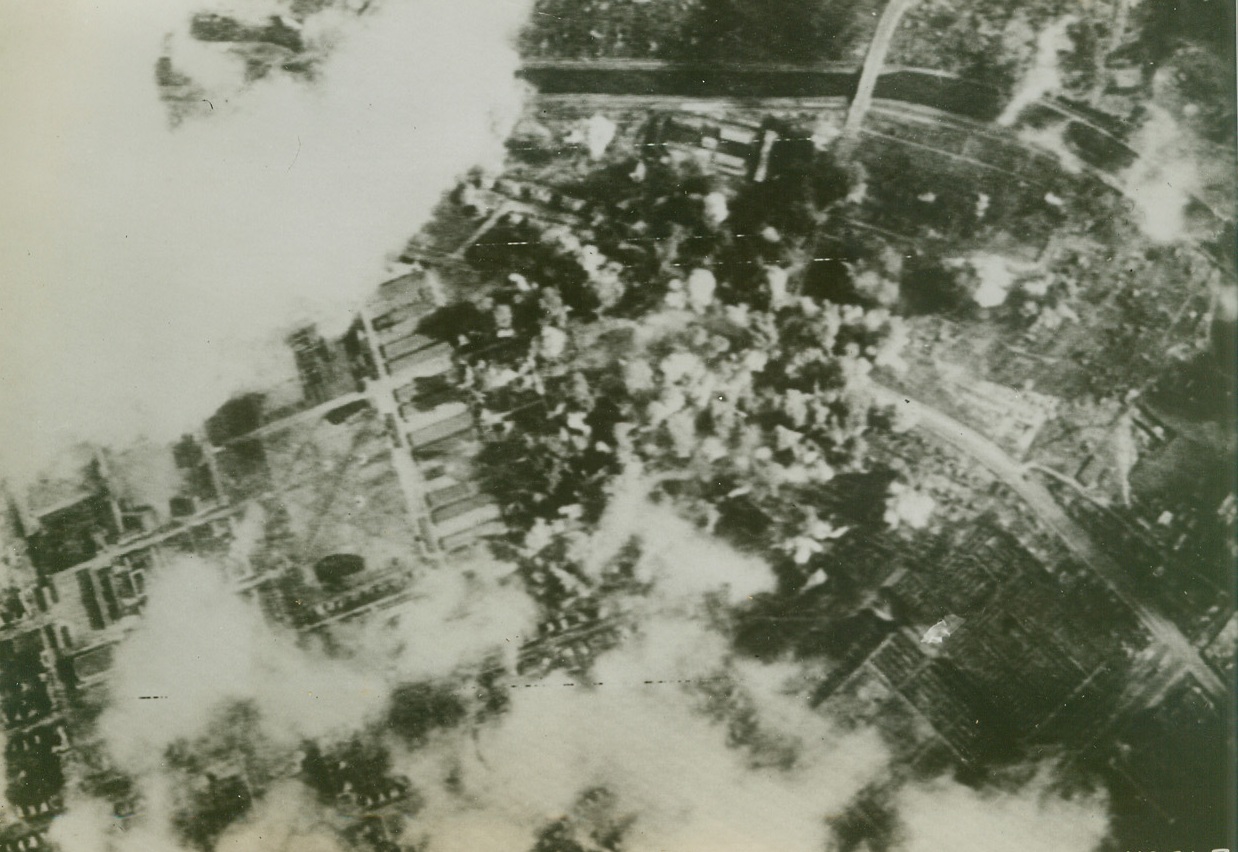
UNITED STATES BOMBS BURST ON BERLIN, 3/8/1944. American calling cards bursting on targets in the March 6th raid on Berlin in the second time in three days. Liberators and Fortresses took part in the raid. Credit: U S Army Air Force photo via radiotelephoto from Acme;
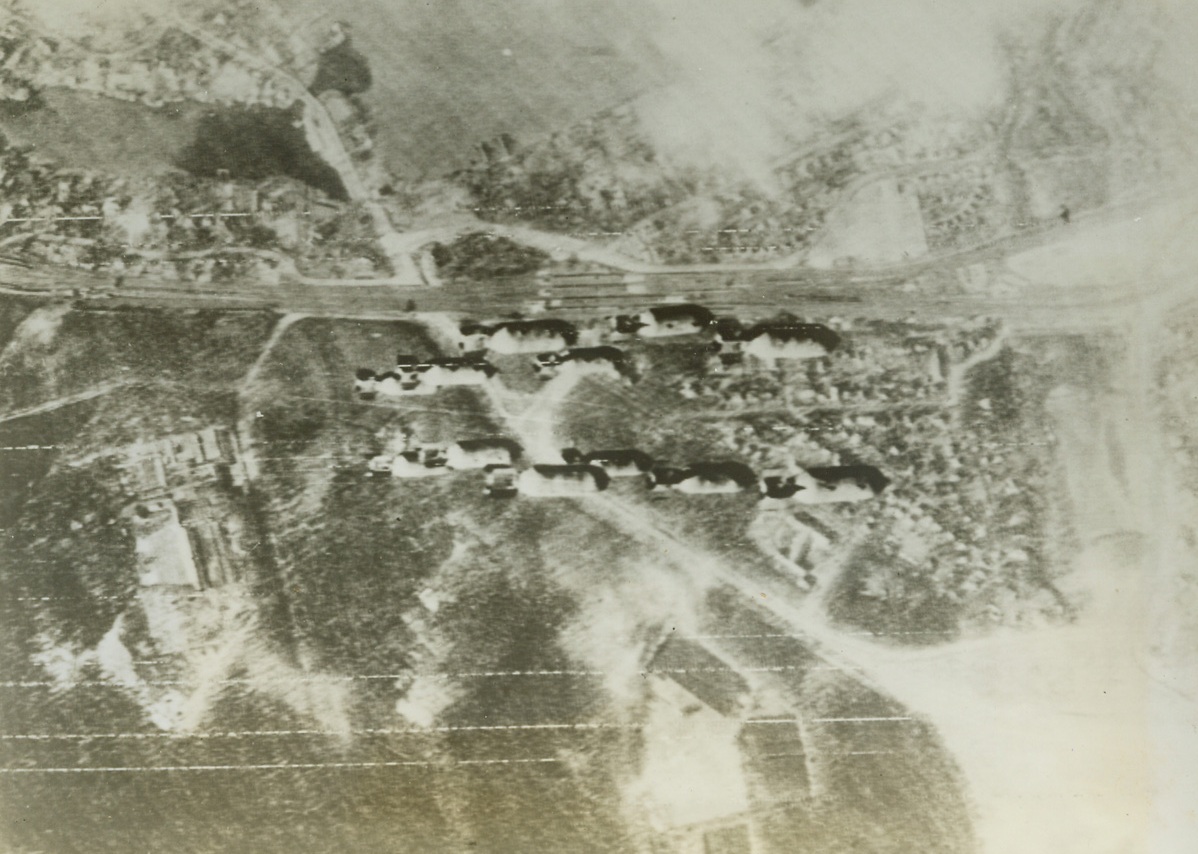
UNITED STATES BOMBS DROPPING ON BERLIN, 3/8/1944. American calling cards on their way downward to blast Berlin in the raid of March 6th. Liberators and Fortresses took part in the raid. American Air Force fighters accounted for 83 German planes. These bombs seem to be directed at railroad trackage. Credit: U S Army Air Force photo via radiotelephoto from Acme;
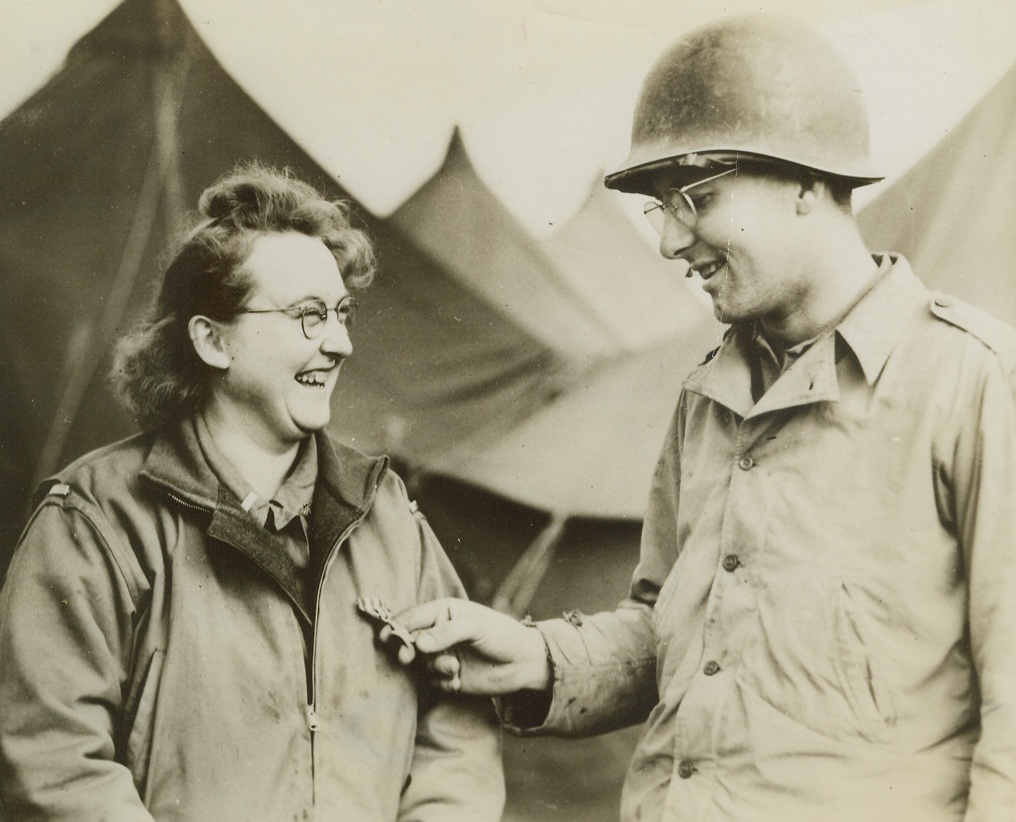
HEROINE OF THE BEACHHEAD, 3/8/1944.ITALY—Cpl. Richard Nordwall, Rockford, Ill., is admiring the Silver Star of Lt. Elaine A. Roe, U.S. Army nurse who won the decoration on the Anzio-Nettuno beachhead for her gallantry in action when Germans shelled field hospital to which she was attached last month. Lt. Roe helped carry out evacuation of 42 patients during the shelling. Lt. Roe is from White Water, Wisc. Credit: Acme;
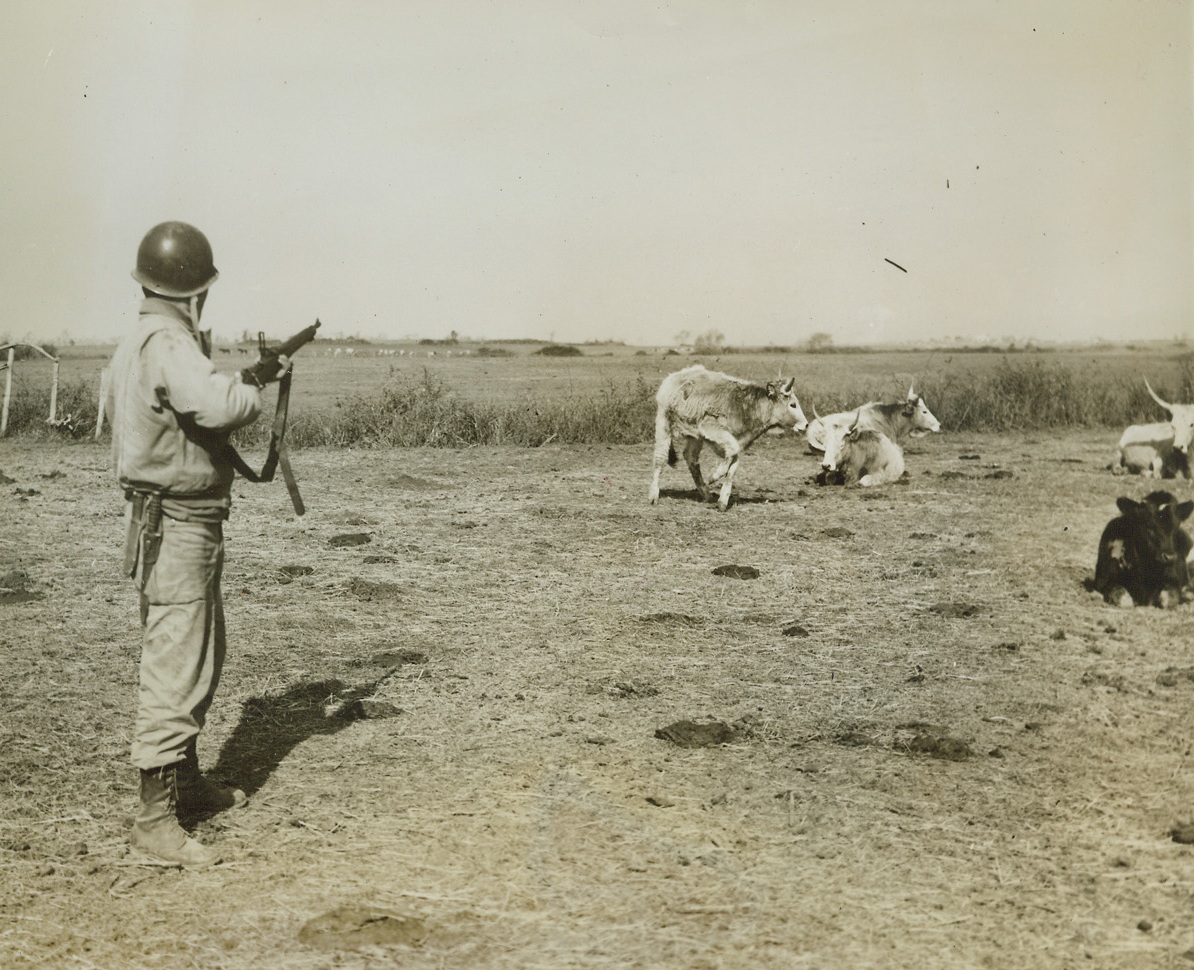
HUNTING FOOD INSTEAD OF NAZIS, 3/8/1944. ITALY—Pvt. Ralph hardman, of Connor, Ga., spots a young bull in a herd of cattle and gets his rifle into position for the kill. He took time off from hunting Nazis because he and his buddies bought the animal from an Italian farmer in the Anzio-Nettuno area to provide a change of diet and relief from the monotonous “C” rations. Credit: Acme photo by Charles Seawood, War Pool Correspondent;
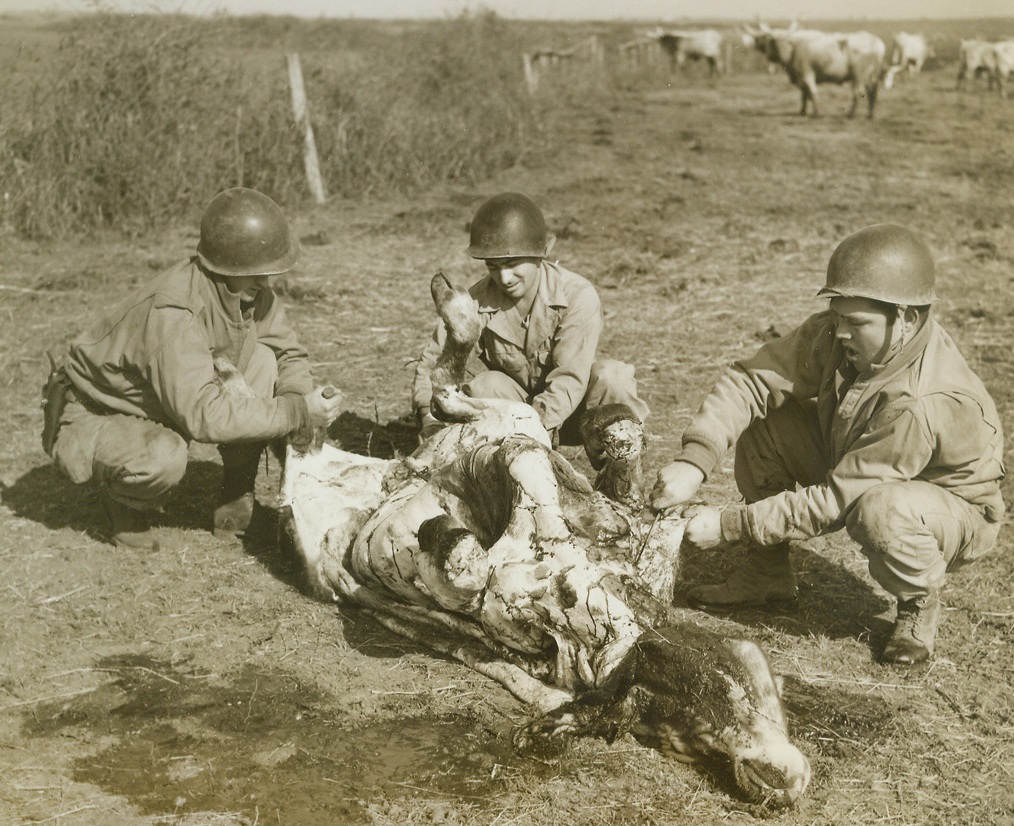
SLAUGHTER AT THE FRONT, 3/8/1944. ITALY—Several U.S. soldiers in the Anzio-Nettuno area bought a young bull from an Italian farmer to provide a change from “C” rations. After killing the animal with a rifleshot, Pvt. Ralph Hardman, Connor, Ga., helps Sgt. James Carroll, Walton, Okla., and Pvt. John Swigert, Baltimore, Md., clean and dress the animal. Only a few miles away are the Germans and the front lines. Killing was done to the accompaniment of incoming and outgoing shellfire. Credit: Acme photo by Charles Seawood, War Pool Correspondent;
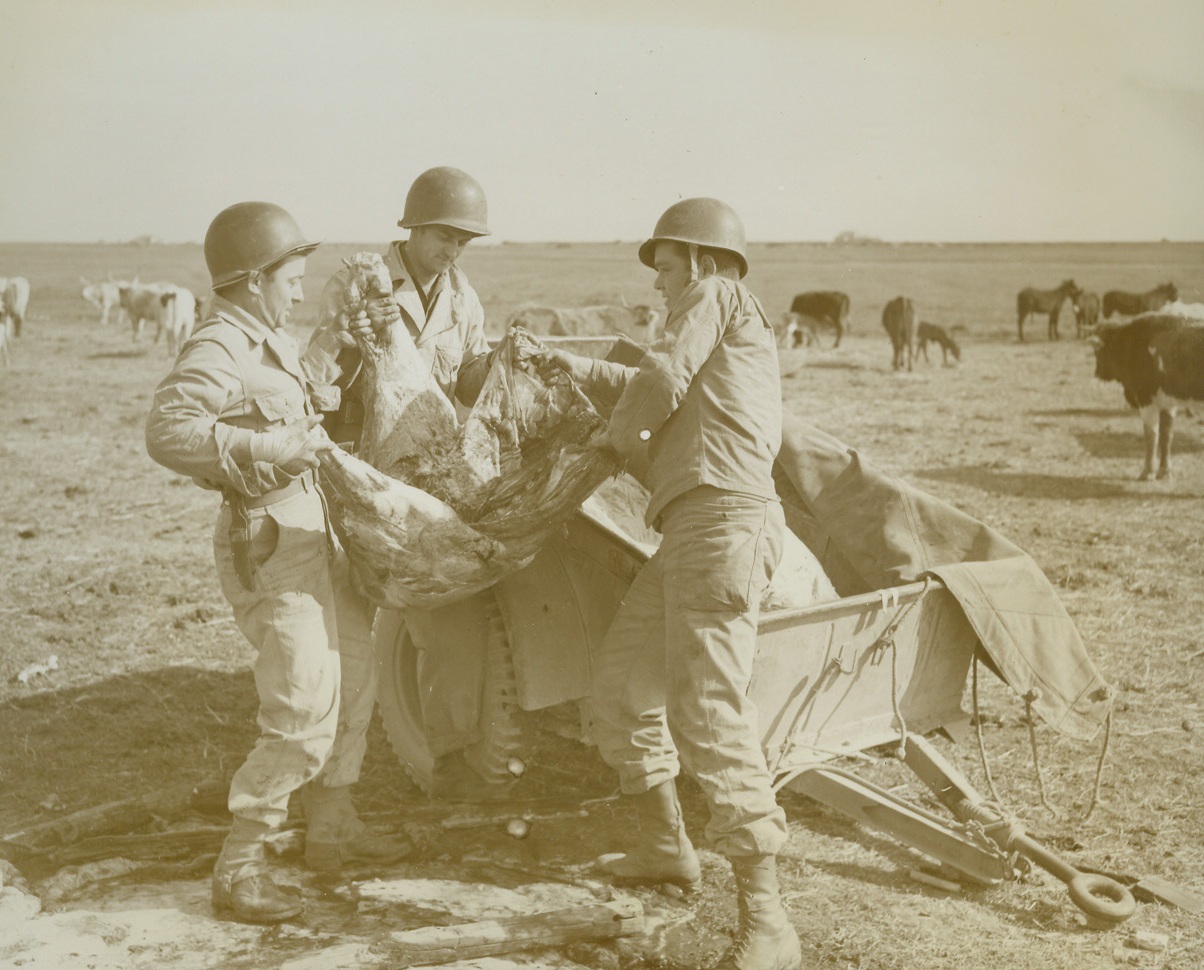
A CHANGE FROM “C” RATIONS, 3/8/1944. ITALY—G.I.’s fighting in the Anzio-Nettuno beachhead area get a little weary of “C” rations so a group of them purchased a young bull from an Italian farmer to provide a change of diet. After killing and dressing the animal, three soldiers load the welcome beef into a trailer headed for a mess kitchen. Credit: Acme photo by Charles Seawood, War Pool Correspondent;
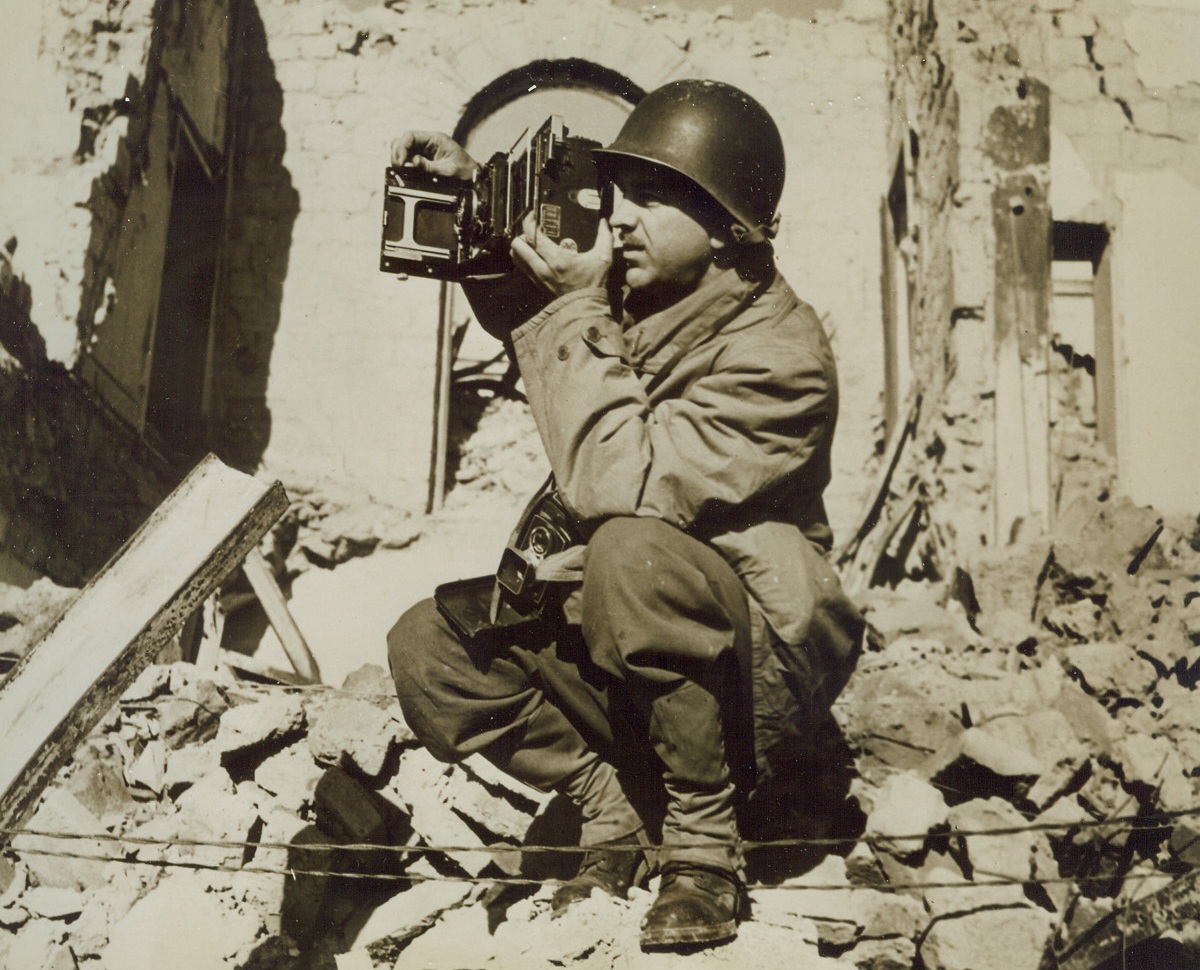
Get That Picture!, 3/3/1944. NETTUNO, ITALY – Squatting on a pile of bomb-debris, Charlie Seawood, Acme Newspictures photographer for the war picture pool, is ready to make a picture of the bomb ruins of battle-scarred Nettuno. Credit Line – WP – (Acme)A;
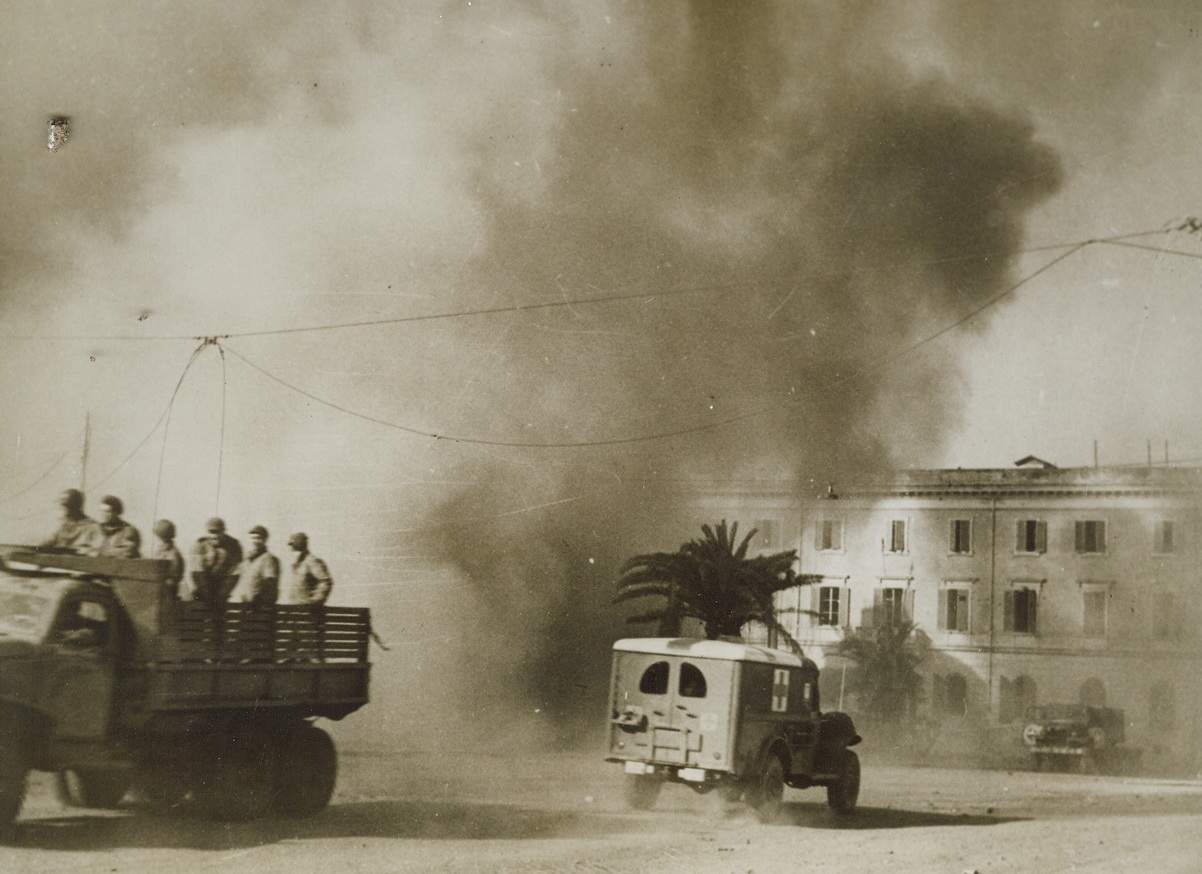
Nettuno Shelled, 3/29/1944. NETTUNO, ITALY -- An American Field Service ambulance and a truck carrying soldiers pass through the dust expelled from a 88mm shell, which exploded in the main square at Nettuno, Italy. Credit Line (ACME);
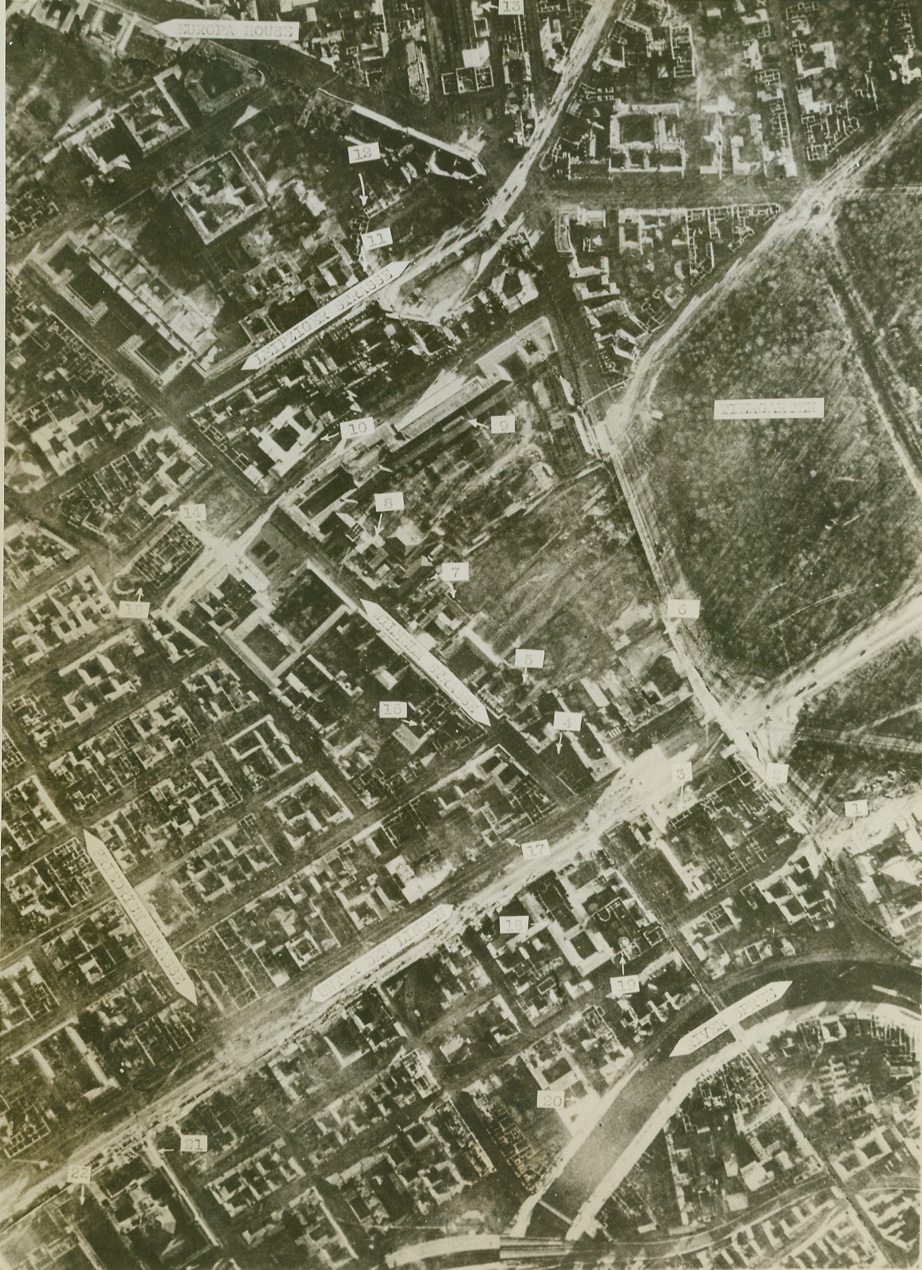
Berlin -- Before and After, 3/30/1944. - Ministry of Armaments and Munitions, gutted; 3 - French Embassy, gutted; 4 - British Embassy, gutted; 5 - Ministry of Food and Agriculture, severely damaged; 6 - Goebbel's private residence (top floors burned out but roof repaired); 7 - Old President's Chancellery (probably Ribbentrop's residence) and Foreign Office; 8 - Hitler's Chancellery and residence (badly damaged, but roof repaired); 9 - New Reich Chancellery (undamaged); 10 - Ministry of Transportation and State Railway Directorate, gutted; 11 - Offices of Goebing (damaged, but repairs in progress); 12 - Forestry Office (wrecked); 13 - Potsdamer station, wrecked; 16 - Ministry of Fisheries, mostly gutted; 17 - Ministry of Education, damaged; 18 - Home office, burned out; 19 - Army Records Office, (damaged by fire); 20 - Post Office, (damaged by fire); 21 - State Library (damaged); Here is a photo of the heart of Berlin, vital nerve center of the Third Reich, made on March 8th. Compare with Acme photo, made in September, 1943, before the Allies began to bomb Berlin in earnest. Key: 1 - Reichstag, burned out in 1933, now further damaged; reasury, damaged 15 - Kaiserhof Hotel (Top floors burned out); 22 - University (damaged) Cr;
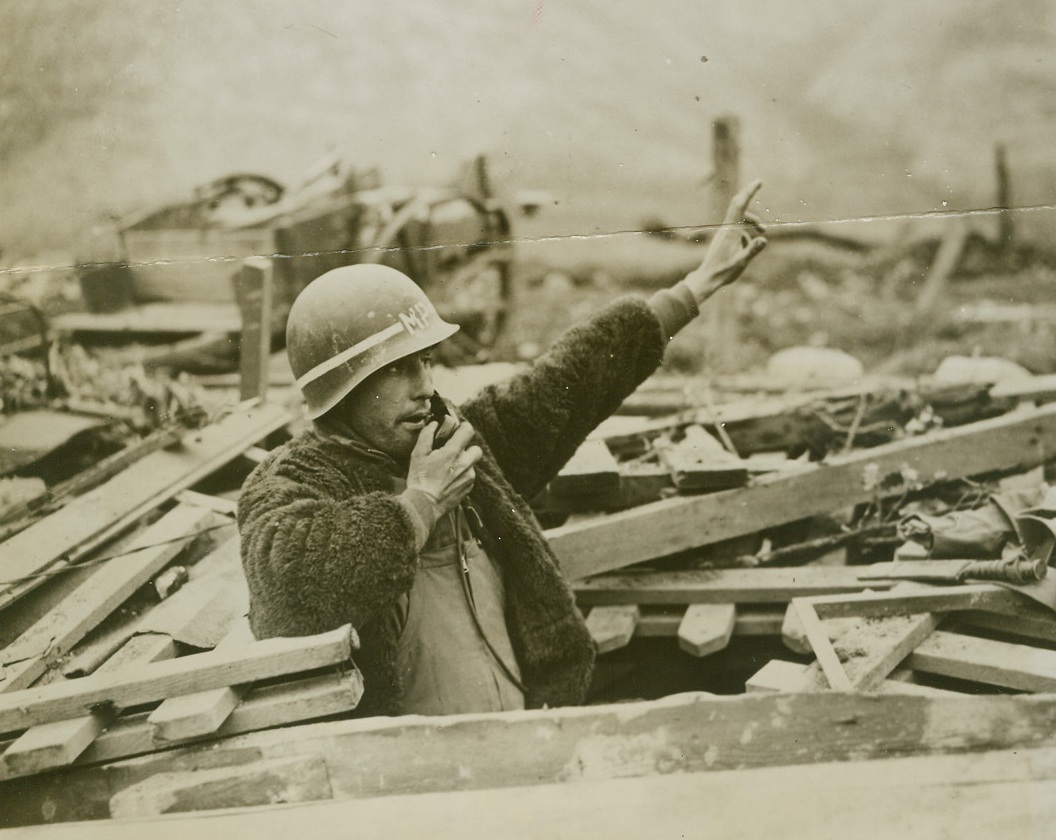
No Taxis Here, 3/29/1944. ITALY -- Under pressure of enemy artillery fire Pvt. William McGunnis, Huntington, W. Va., an M.P. of the 34th Division, was forced to "dig in" for safety while performing his traffic duties on the Gustav Line, north of Cassino, which today still remained in German hands. Allied forces, however have succeeded in maintaining their vantage points surrounding the city. Credit (Official US Army Photo from ACME);
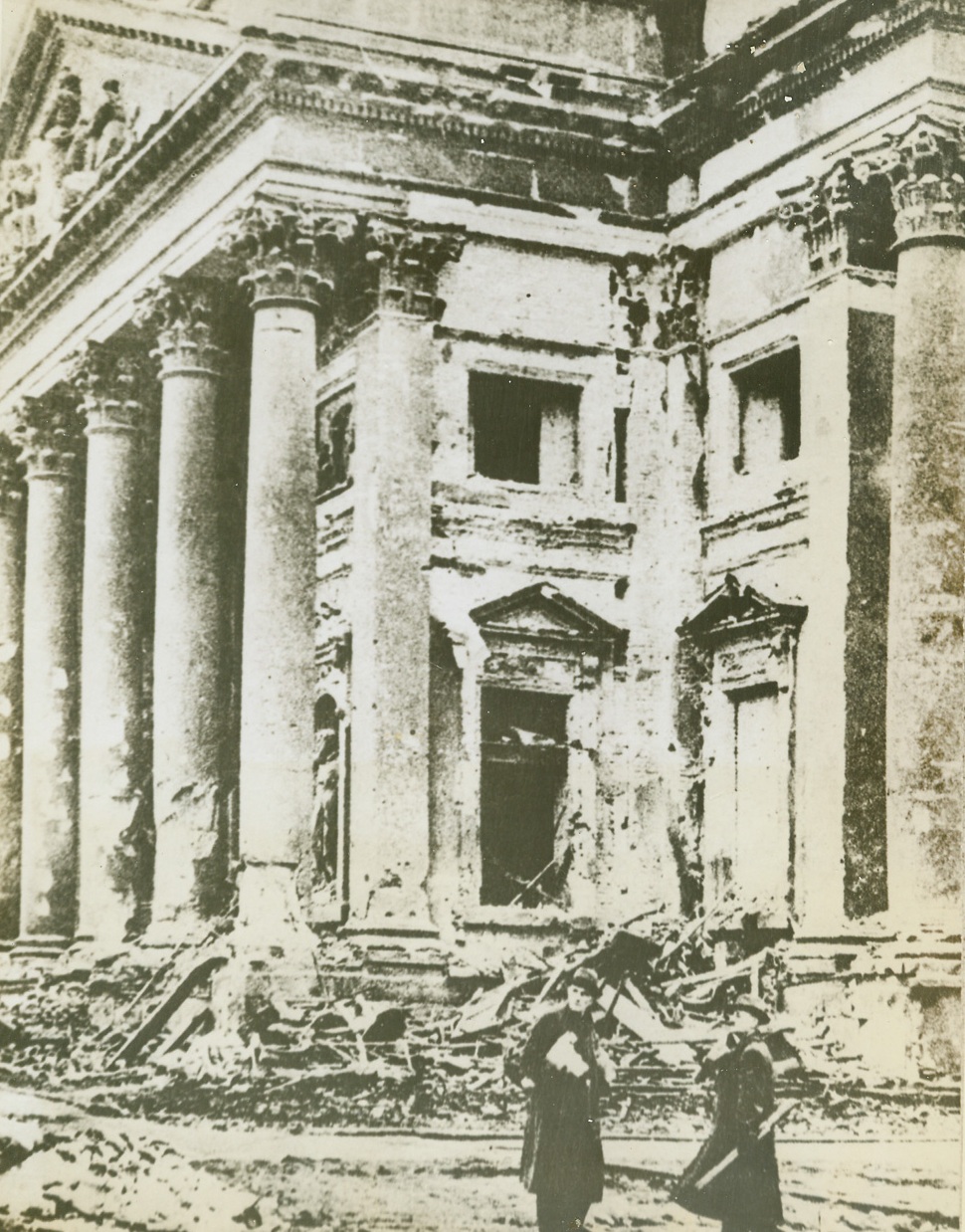
Battered Cathedral, 3/30/1944. BERLIN -- Here is the German Cathedral in Berlin, battered and torn after an Allied air raid over the city, according to the German caption accompanying this photo, which was obtained through a neutral source. The Nazis weep crocodile tears over the damage done to the house of worship although Hitler's followers recognize no God other than their fanatic Fuehrer. Credit Line (ACME);
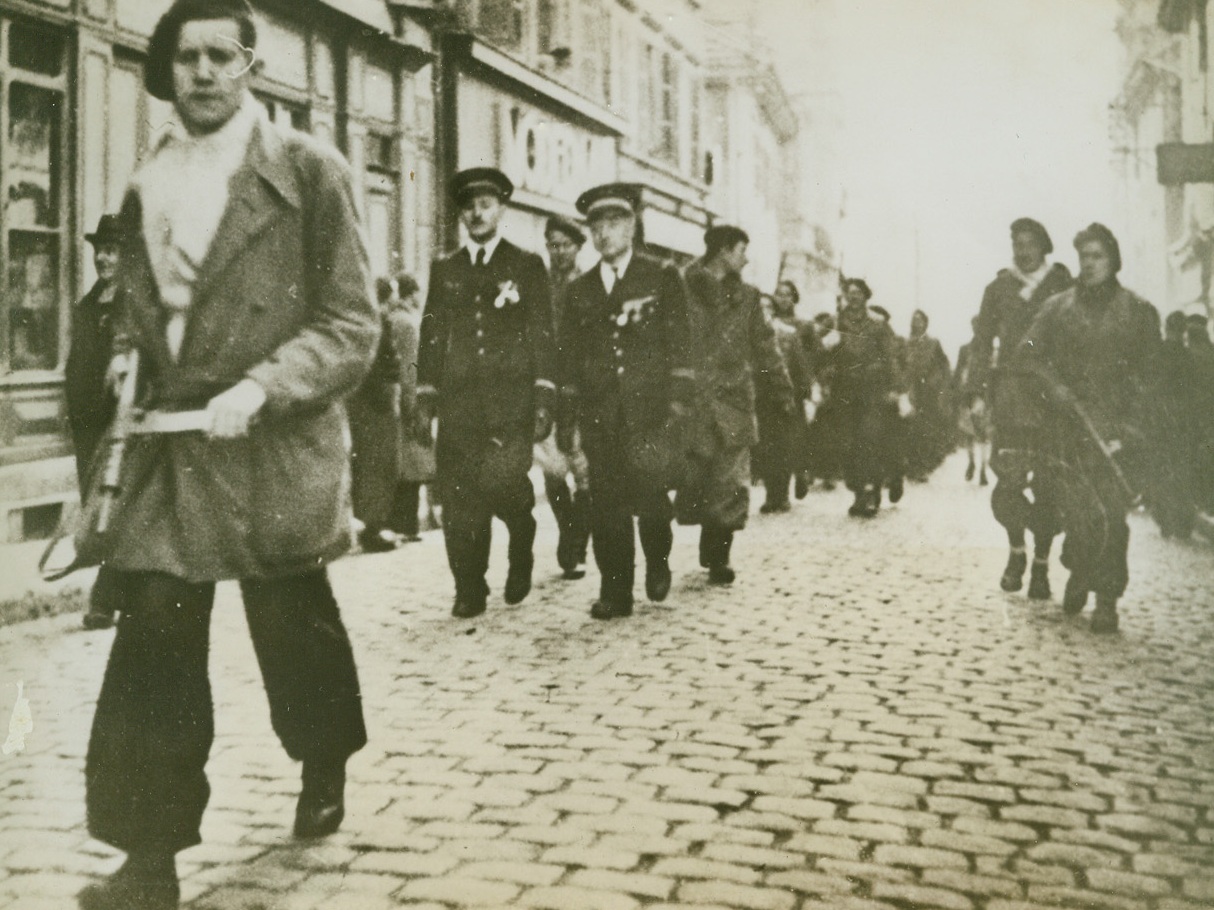
Maquis Take Over, 3/28/1944. OYONNAX -- November 11, 1943 will be long remembered by natives of Oyonnax, 20 miles west of Geneva, for that was the day on which the Maquis took over the town for a two-hour Armistice Day celebration. Demonstrating their ability as soldiers, the Maquis "captured" the town, held the celebration, and drove back to their hidden camps. Meanwhile Nazi and Vichy authorities waited 12 miles away, deceived by posters announcing that the celebration would be held in another town. Here the Maquis march thru the streets of Oyonnax, with French Air Force officers in foreground. Credit Line (ACME);
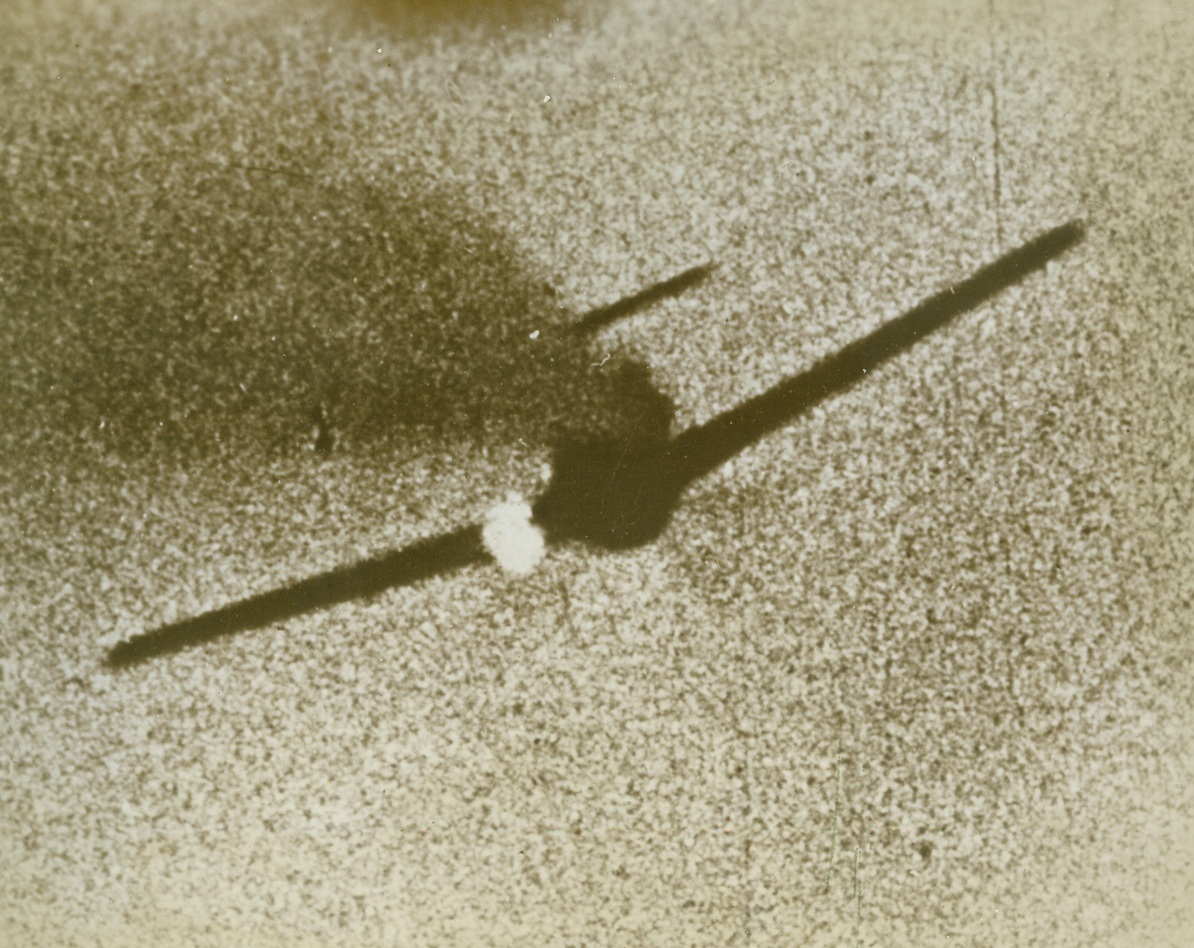
Nazi Plane Turns Rocket, 3/29/1944. After being blasted by a Thunderbolt pilot of the U.S. Army Air Forces, this German Focke-Wulf 190 trails smoke and flame from its engine and falls like a blazing rocket toward the earth below. Credit Line (U.S.A.A.F. Photo from ACME);
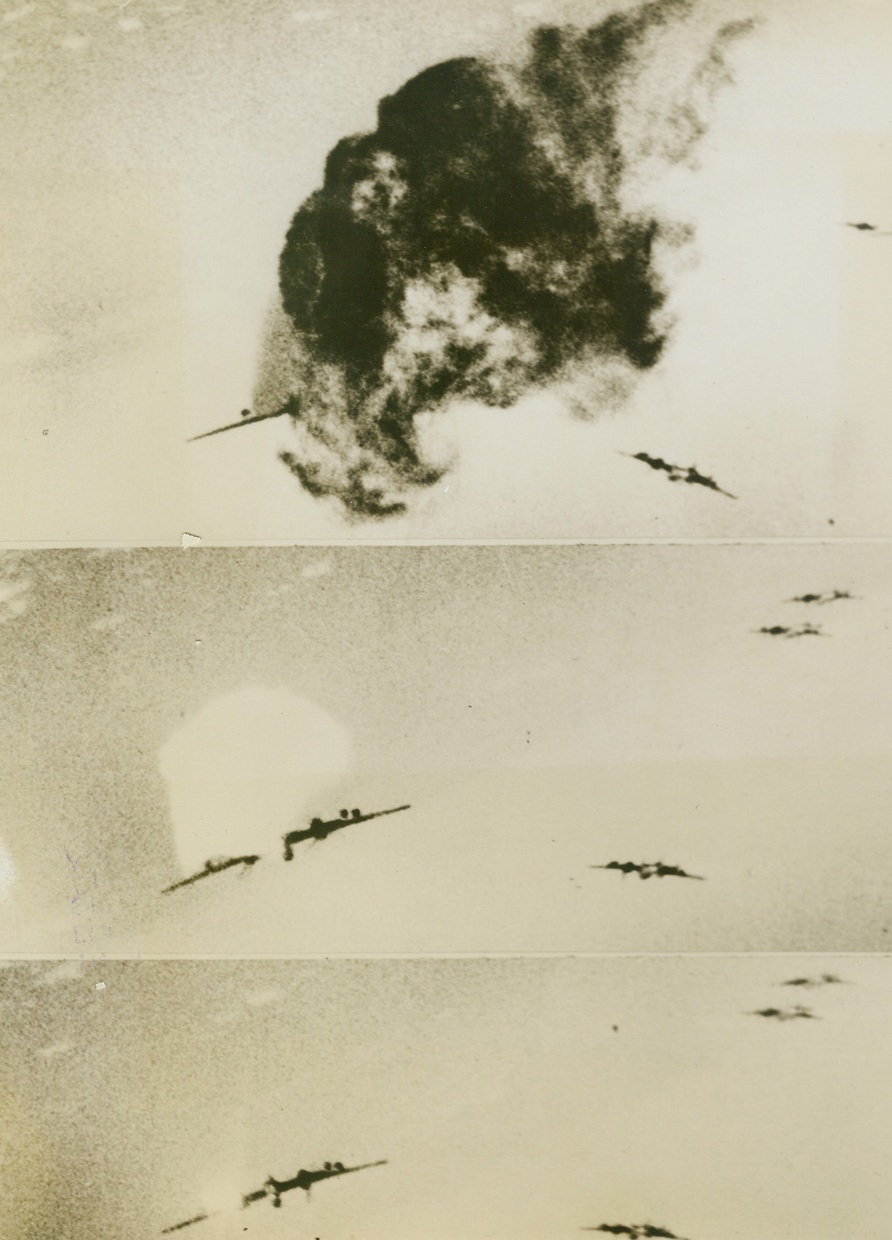
The End of a ME 110, 3/31/1944. OVER, EUROPE – This combination photo shows the end of a Nazi ME 110, which was picked from the skies by the Thunderbolt flown by Lt. Paul A. Conger of Piedmont, Calif., during a recent raid over Hitler’s Europe. At top, the enemy plane is hit and bright flame bursts from its wing. In center, smoke pours from the fatal strike, and at bottom the plane goes up in a swirl of black smoke. At least three enemy planes, beside the target ship, can be seen in each photo.Credit Line (ACME);
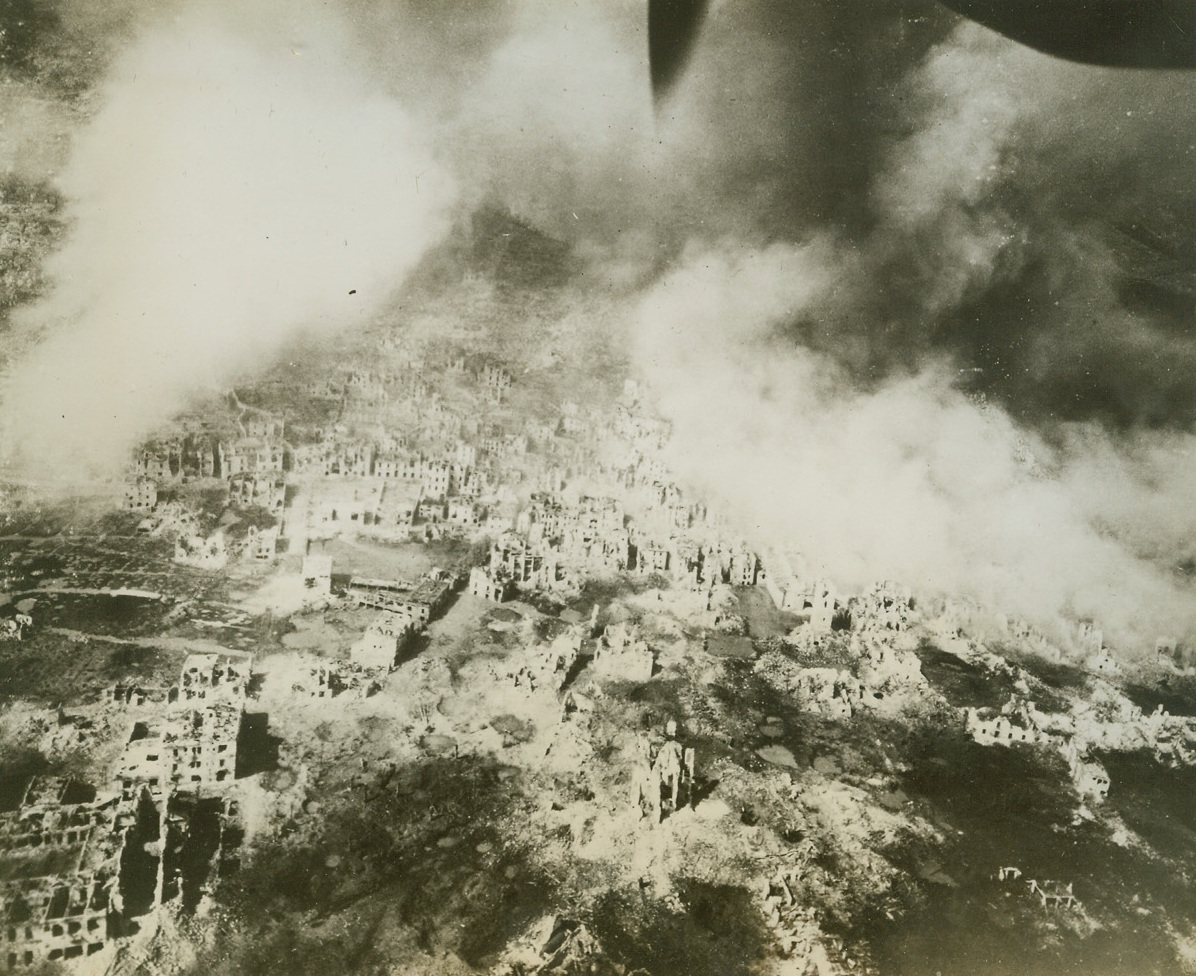
Pall of War Over Cassino, 3/29/1944. ITALY – Taken from a U.S. Army Air Force Reconnaissance plane a few minutes after the last wave of bombers left a record breaking aerial assault on this Italian town, photo gives a close-up view of the devastation left in the bomber wake.Credit (U.S. Army Air Force Photo from Acme);
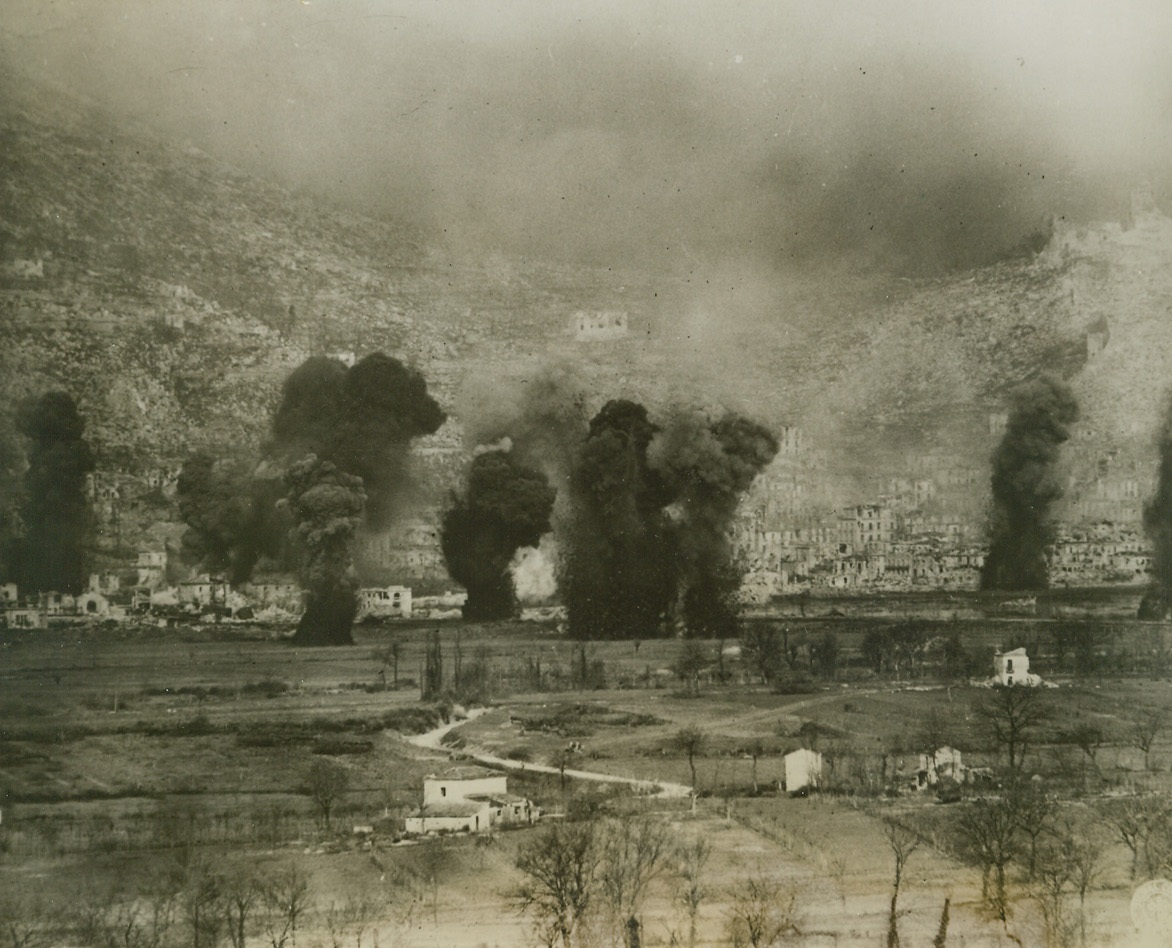
Another Pounding for Cassino, 3/29/1944. ITALY – Huge smoke columns mark exploding Allied shells and bombs in another terrific bombardment, as German troops hidden molelike in the ruins of Cassino, resist desperately the advance of Allied 5th Army forces. Some idea of the height of the smoke columns can be obtained by comparing them with buildings in the foreground. Credit Line ( U.S. Signal Corps Photo from Acme);
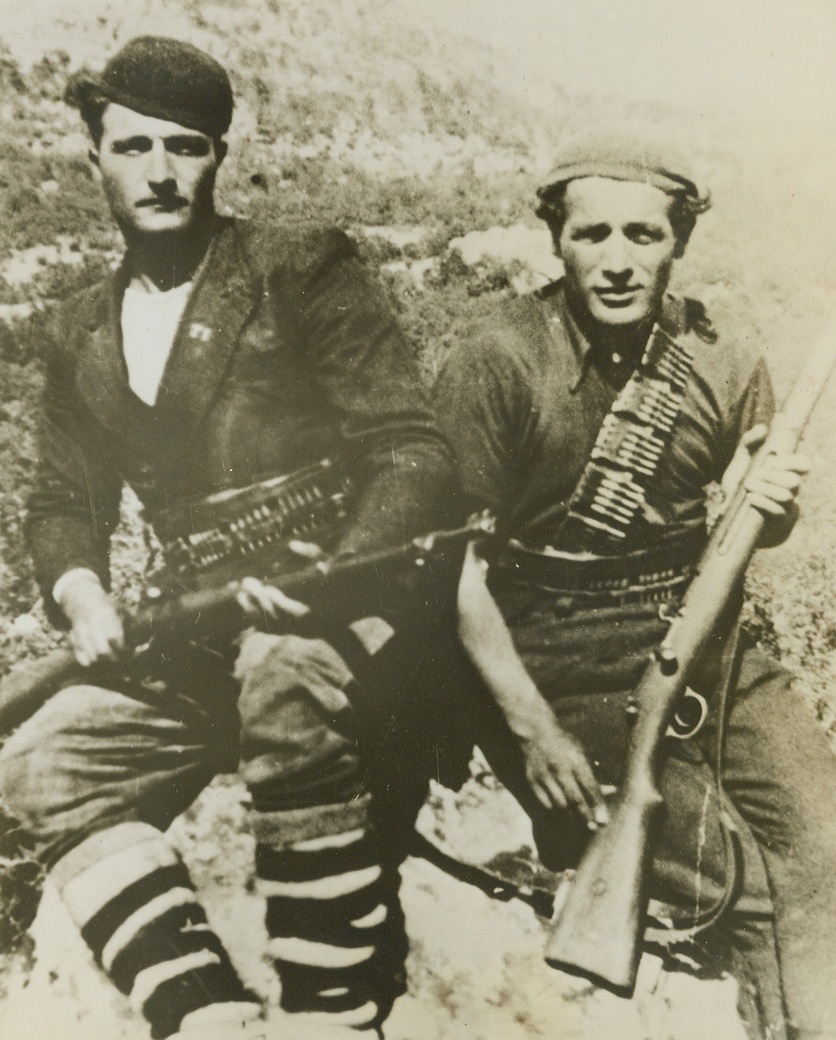
"Freedom, Or Death!" - The Andartes' Credo, 3/29/1944. GREECE - High in the mountains of Greece a storm of vengeance is gathering over the heads of Nazi occupation troops that are despoiling once happy land, and starving, terrorizing and murdering its people. This "storm" is the growing band of Greek patriots, the Andartes, who are training and plotting for the day of liberation. Even now, "lightening" strikes at German outposts in the form of sharp, deadly Andarte raids, and railway trains and bridges have been blown to bits by these grim, hardy guerillas. Every day, harassed Greek civilians find escape from the "New Order" in the mountain retreats of the Andartes, bringing with them their meagre belongings and new tales of Nazi terrorism. The Andartes have sworn that someday, soon, Greece will be free again. The only alternative to their vow, is death. In this series of photos, just released in New York by the Greek Office of Information, activities of the Andartes are shown. Two fighters of the Ardartes armed with efficient-looking rifles, and wearing makeshift uniforms, are seated atop a rock high in the mountains of Greece.;
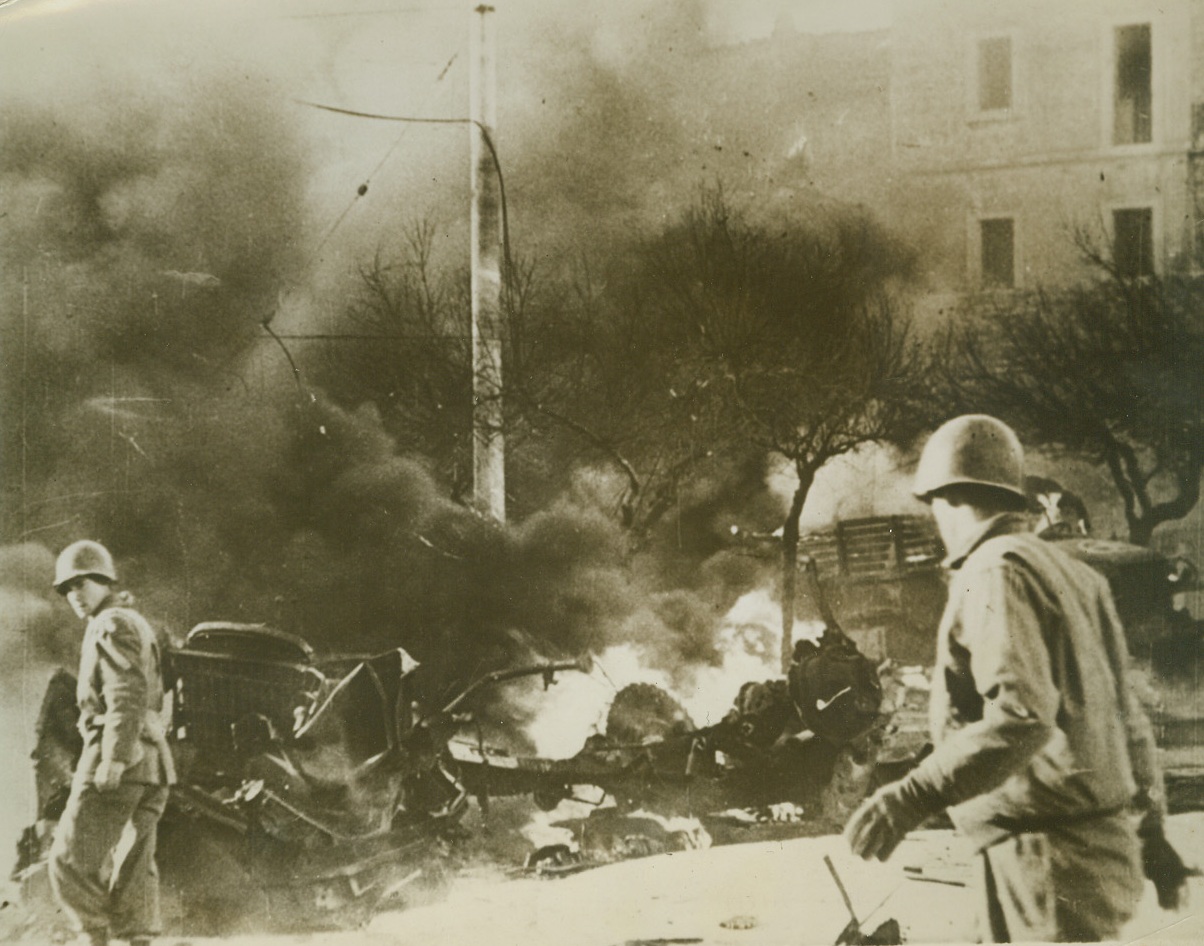
After the Raid, 3/11/1944. NETTUNO, ITALY – Two Yanks examine the still-flaming remains of Army vehicles that were set on fire by bombs during a German air raid on Nettuno. The raiders visit the beachhead areas so regularly that the Allied Military Government has moved the entire civilian population of Nettuno and neighboring Anzio to less dangerous areas.Credit Line – WP – (Acme);
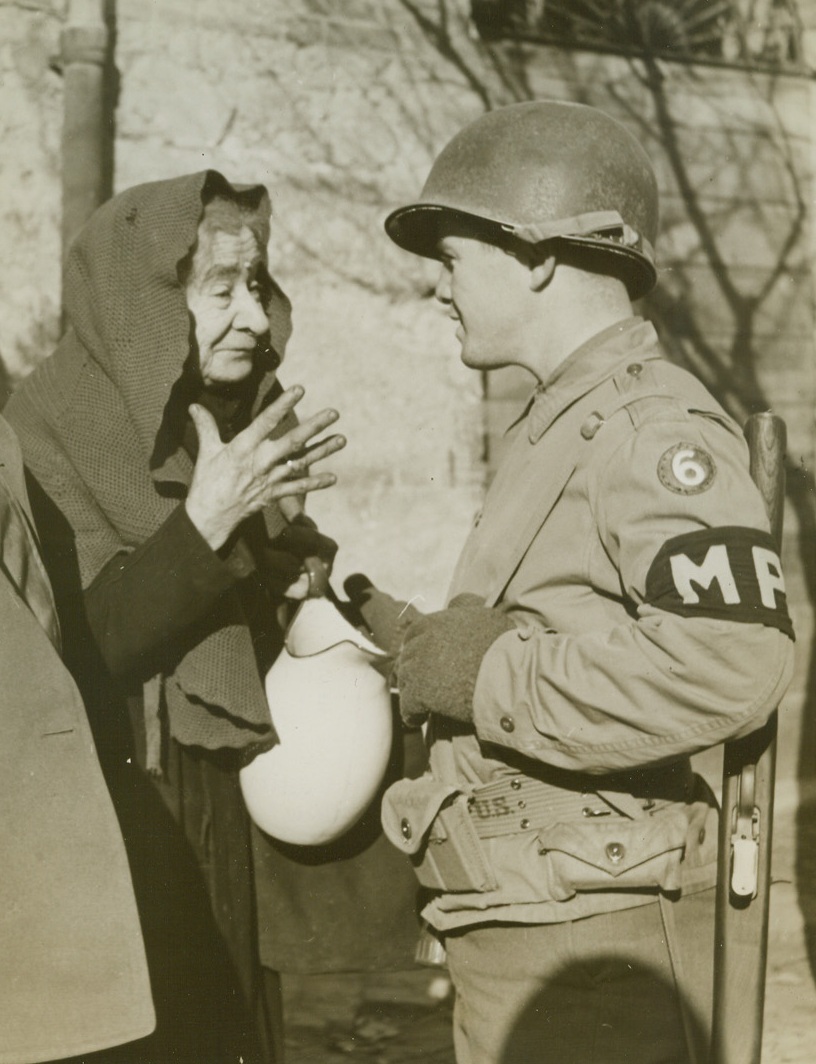
“Most Kissed Woman”, 3/11/1944. NETTUNO-ANZIO BEACHHEAD – Unlike other Italian towns, where beautiful signorinas waited to greet advancing Yanks with kisses, the Nettuno-Anzio beachhead was barren of feminine attraction, except for 81-year-old Signora Marcella Giorgi. One of the few women permitted to remain behind (because she must care for her invalid husband) when other civilians were evacuated from the area, she’s a one-woman welcoming committee from Allied fighting men. She insists on kissing every arriving soldier by way of greeting. Signora Giorgi is shown here chatting with Pfc. George W. DeNicola. Credit Line (Acme photo by Charles Seawood for the War Picture Pool) WP;
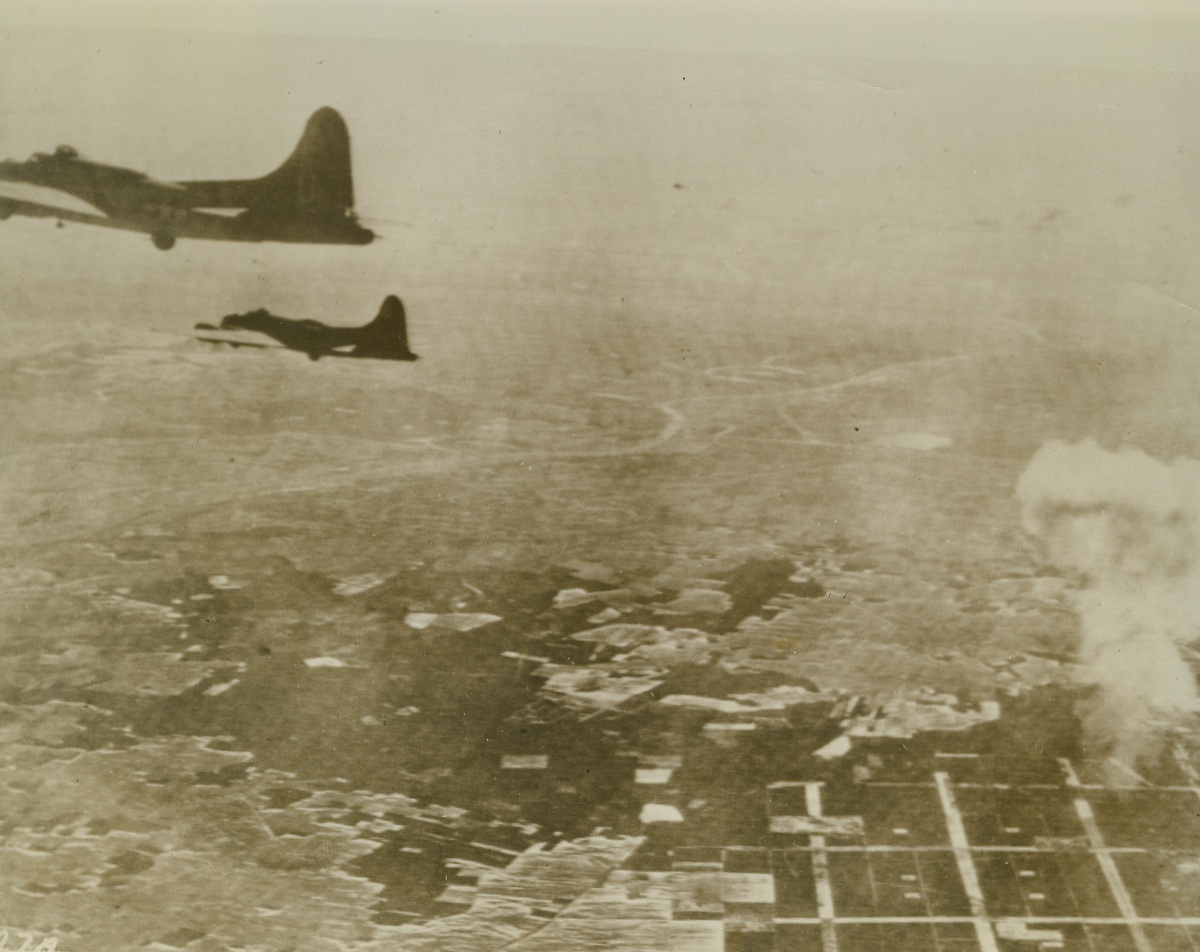
Among Those Missing, 3/10/1944. GERMANY – A shattered Flying Fortress wears a shroud of smoke (right) after a direct hit from flak over a Berlin suburb. Sister ships roar on, during the daylight raid of March 6th.Credit (U.S. Army Air Forces Photo via Radiotelephoto from Acme);
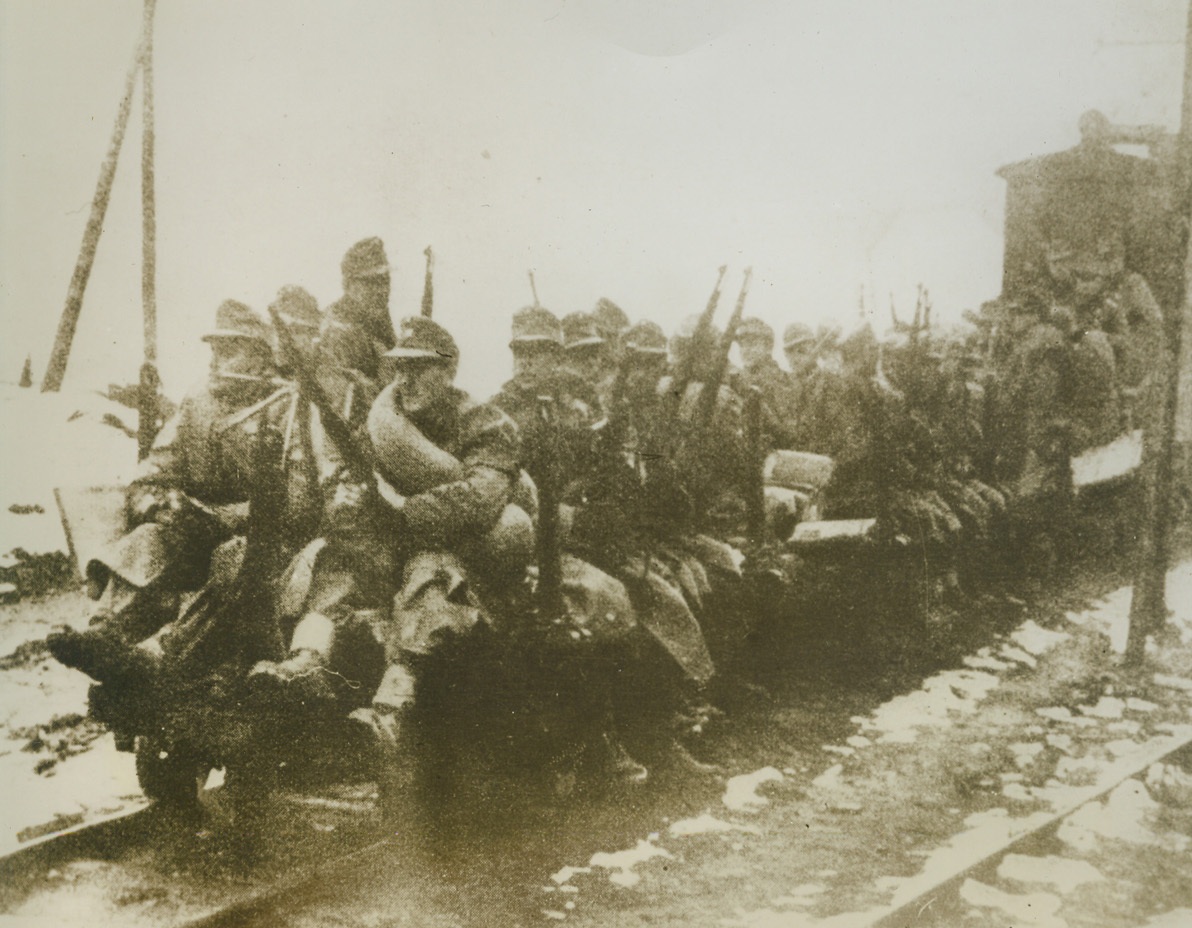
They Keep Their Eyes Peeled, 3/12/1944. YUGOSLAVIA – Never daring to turn their eyes from the surrounding countryside for fear that Yugoslav partisan fighters will catch them off guard, these Nazi infantrymen dangle their legs from a flatcar as they begin an uncomfortable journey to new positions. Fighting a losing battle against Marshal Tito’s guerillas, the Germans are constantly harassed by the Yugoslavs. Photo obtained through a neutral source.Credit Line (Acme);
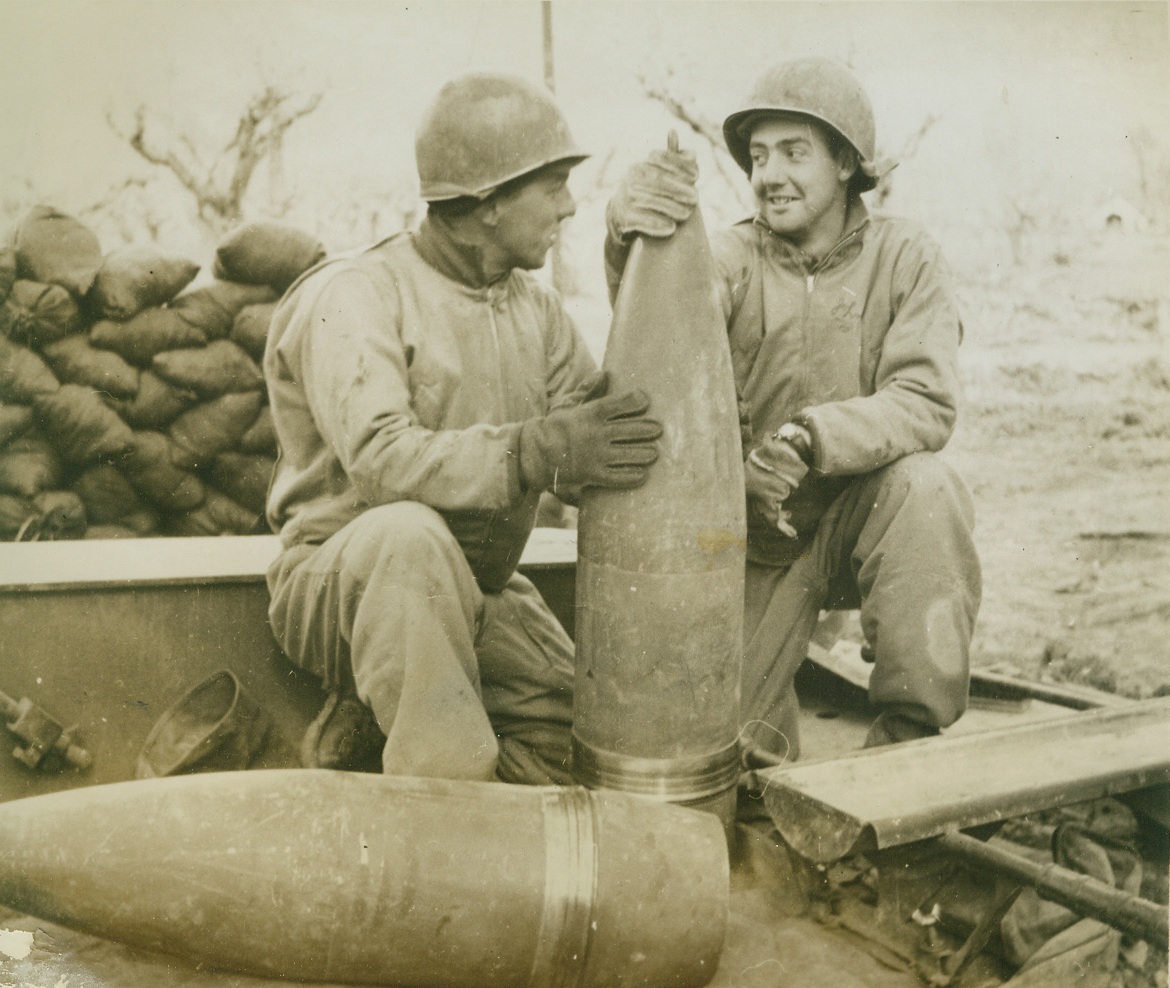
Nazi-Busters, 3/5/1944. ITALY – Each shell for the Army’s new 240 mm. Howitzer is a 345-pound headache for the Germans in Italy where the giant field piece is being used for the first time. Two Pennsylvanians, Pfc. Henry Maracsky (left) of McAdoo, and Pvt. John A. Rochm, of Philadelphia, examine a pair of the heavy shells. Credit Line (Acme);
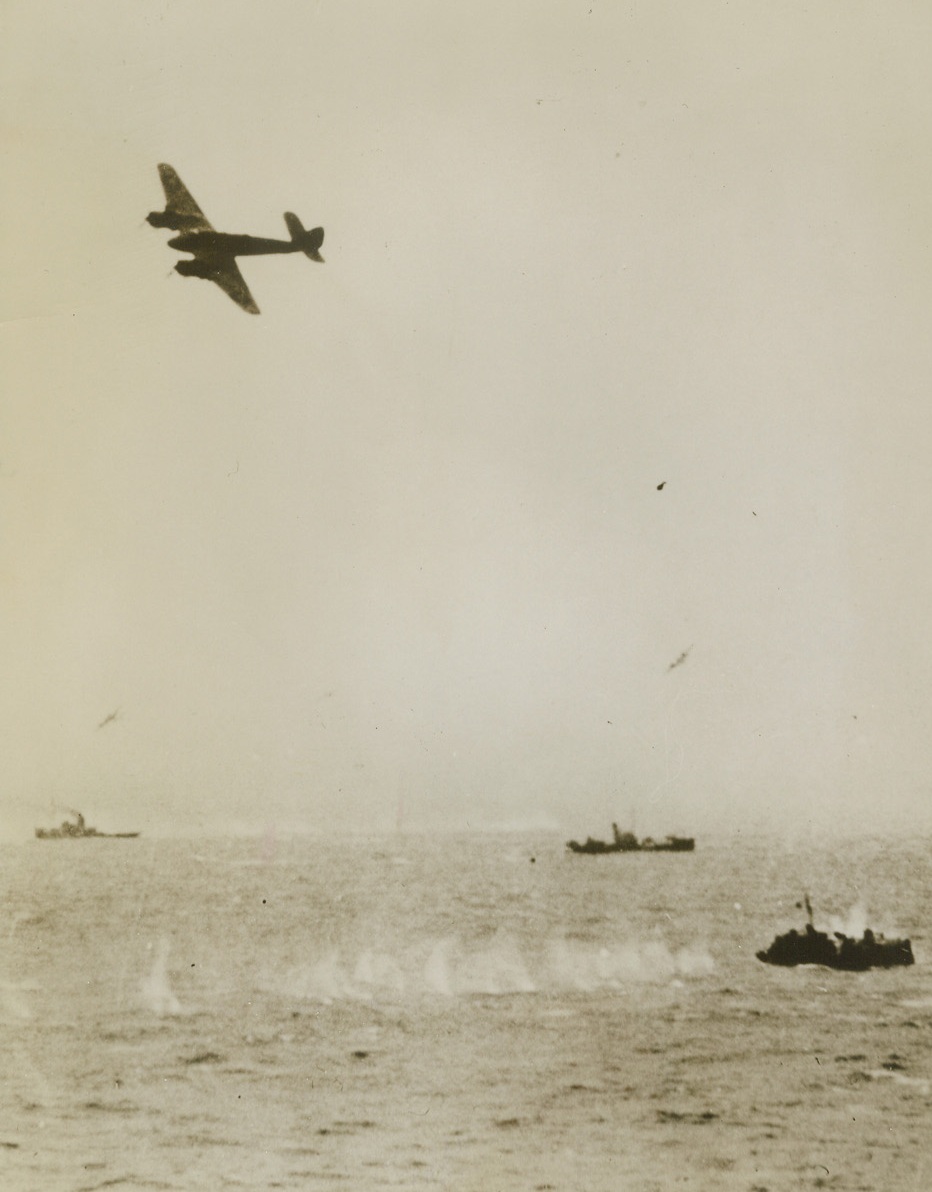
German Convoy Caught, 3/18/1944. OFF THE COAST OF HOLLAND – Sighted by British planes of the RAF Coastal Command, this convoy of merchantmen bringing supplies to the Axis suffered a heavy attack off the coast of Holland on March 1st. Wheeling back and forth over the group of merchant ships, the warbirds peppered their targets with cannon fire.Credit Line (British Official Photo from Acme);
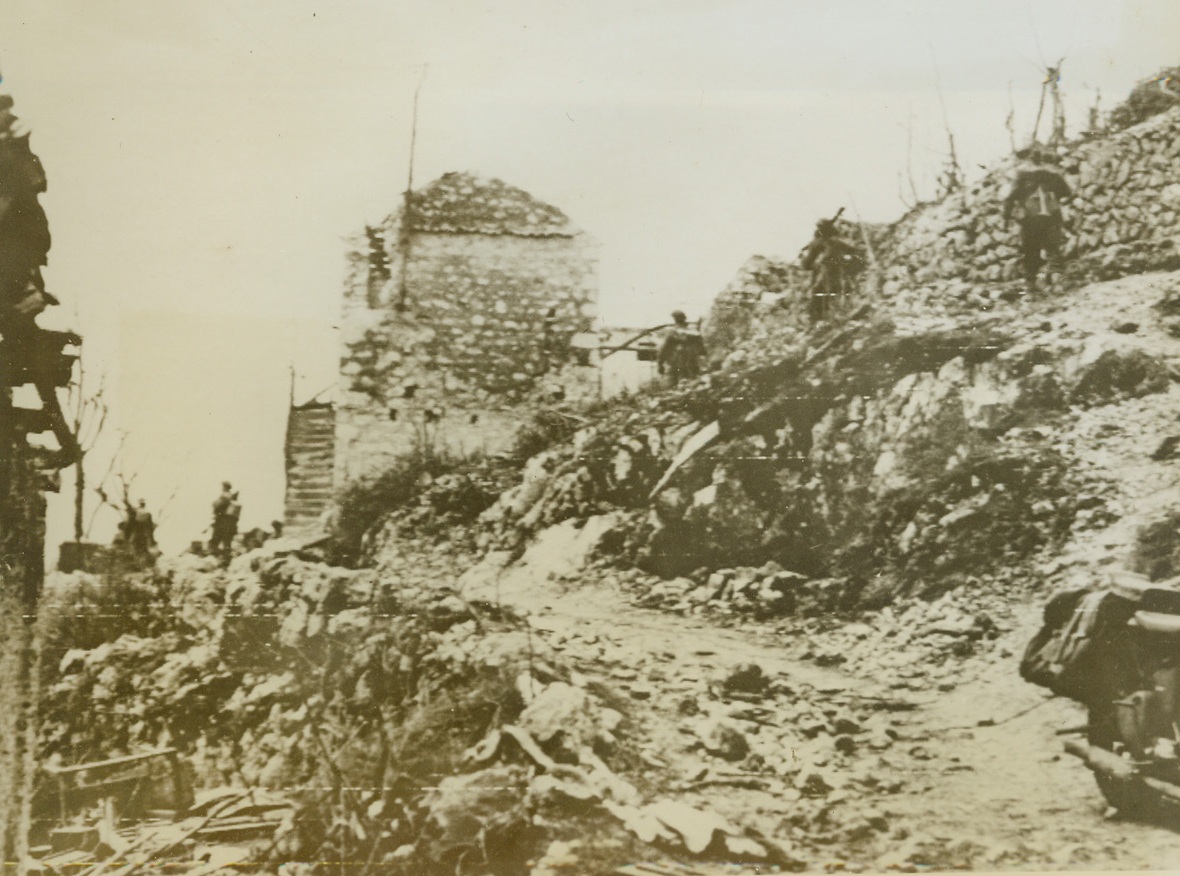
Into Ruined Cassino, 3/20/1944. Allied troops press forward on the outskirts of the flattened city of Cassino, Italy, smashing against stubborn resistance put up by German paratroopers landed in Cassino after Allied aircraft had bombed the city in the heaviest “obliteration raid” of the war. Although New Zealand troops today captured the Continental Hotel, bulwark of Nazi resistance, fierce fighting continues in the southern part of the city.Credit Line (Acme Photo via Army Radiotelephoto);
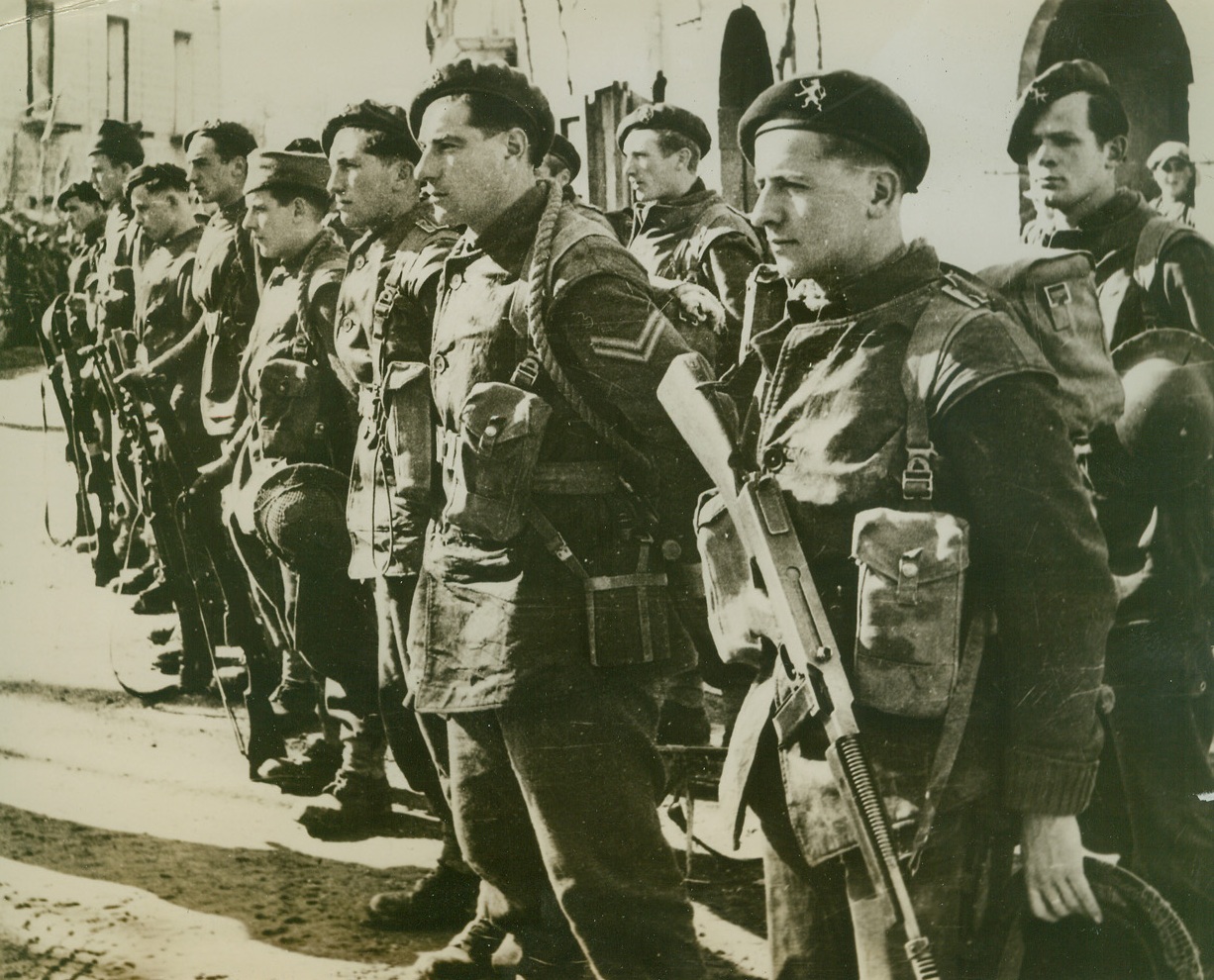
Fighting With Allies in Italy, 3/13/1944. ITALY – After spending two weeks wiping out Nazi machine gun nests in the mountainous region north of the Garigliano River, Belgian commandos return to their temporary base at the foot of Mount Camino, Italy. The hard-fighting Belgians are battling the Germans alongside of the Americans and British. Credit Line (Acme);
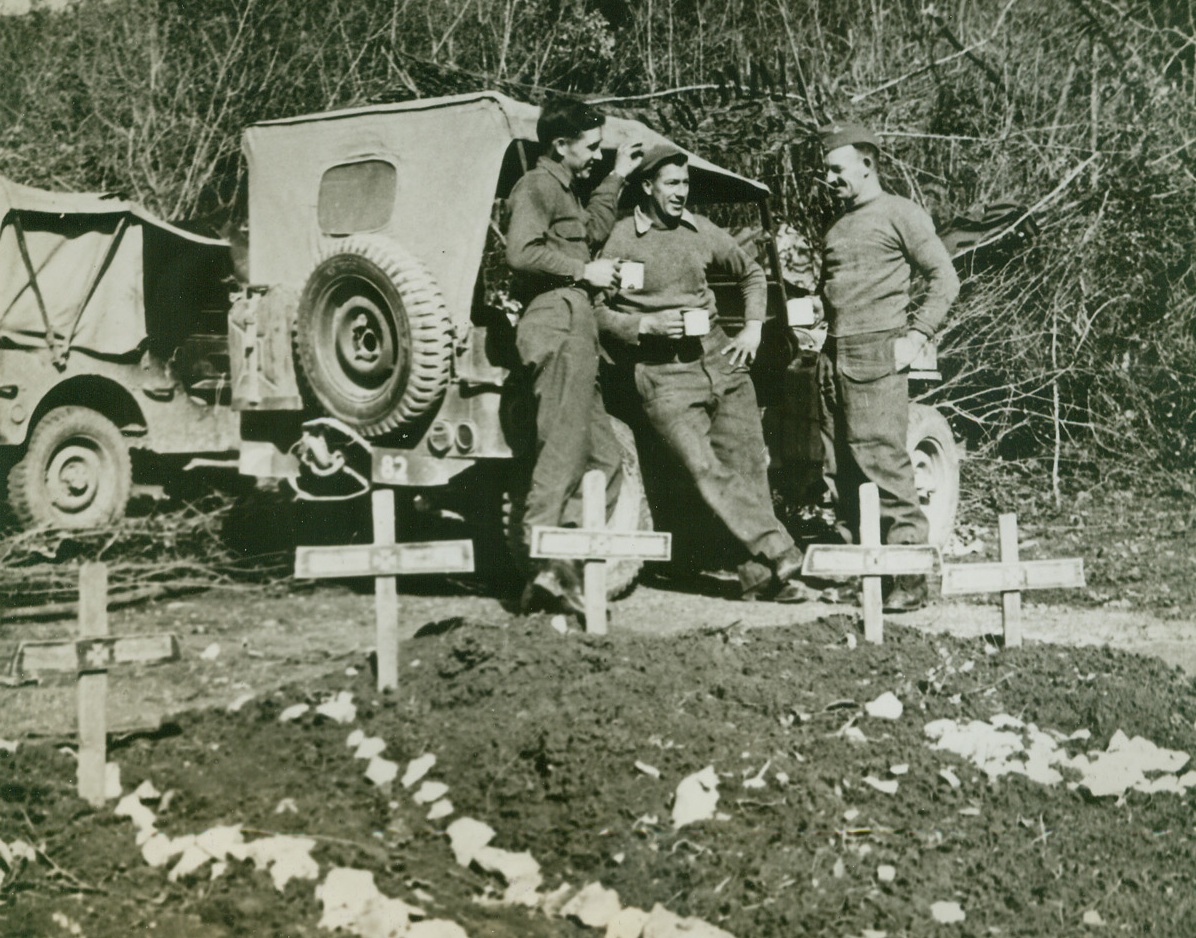
Over the Coffee Cups, 3/20/1944. ITALY – Leaning against a Jeep, Allies from Texas and New Zealand, enjoy a cup of coffee “somewhere in Italy.” Left to right, are: Pvt. Howell Hasten, Lorreta, Texas; and Gunner Ted Boys, of Hellersville, N.Z.; and Gunner Jim Jenkins, of Christ Church, N.Z. In the foreground are German graves left by the enemy in his retreat toward Cassino.Credit Line (Acme) (WP);
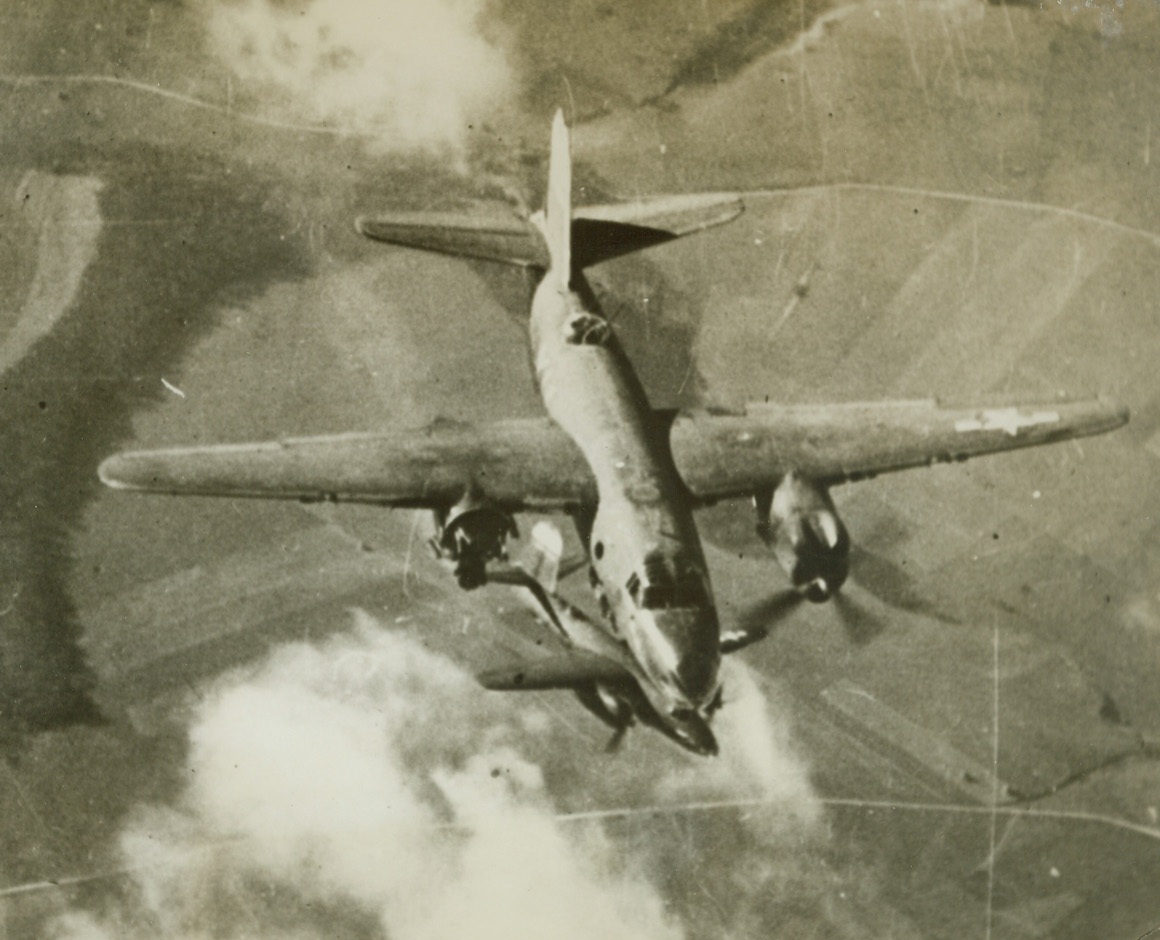
One Engine Still Going Strong, 3/9/1944. OCCUPIED EUROPE – A direct hit from a Nazi flak battery tore out an entire engine (left of photo) of this Ninth Air Force Marauder just a few seconds before the aerial photo was made from another bomber in the formation. The crippled B-26 medium bomber is shown falling behind in the formation. Below, another Marauder flies on, untouched by the heavy curtain of flak.Credit Line (Acme);
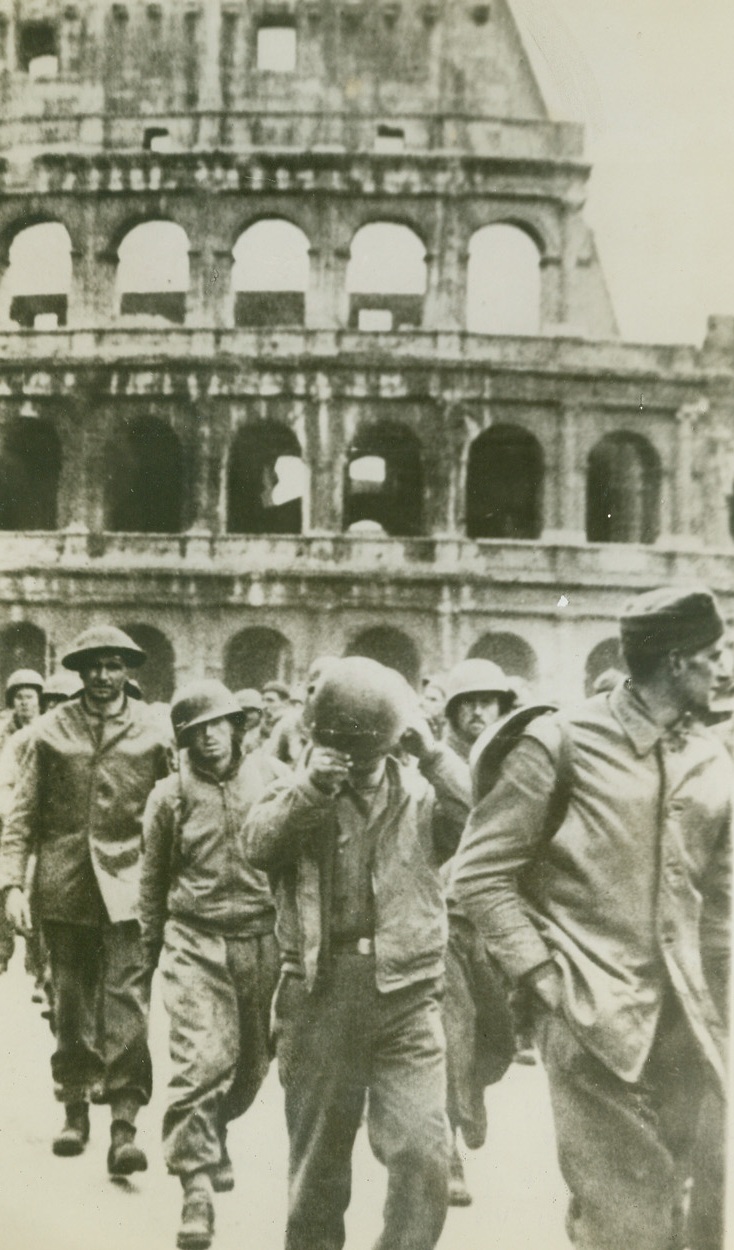
ALLIED PRISONERS IN ROME—NAZIS SAY, 3/13/1944. ROME, ITALY—According to the German caption, this photo, from the Berlin Illustrieerte Beobachter, shows British and American prisoners captured during the Nettuno beachhead fighting marching through Rome. The ruins of the Colosseum are in the background. Credit: Acme;
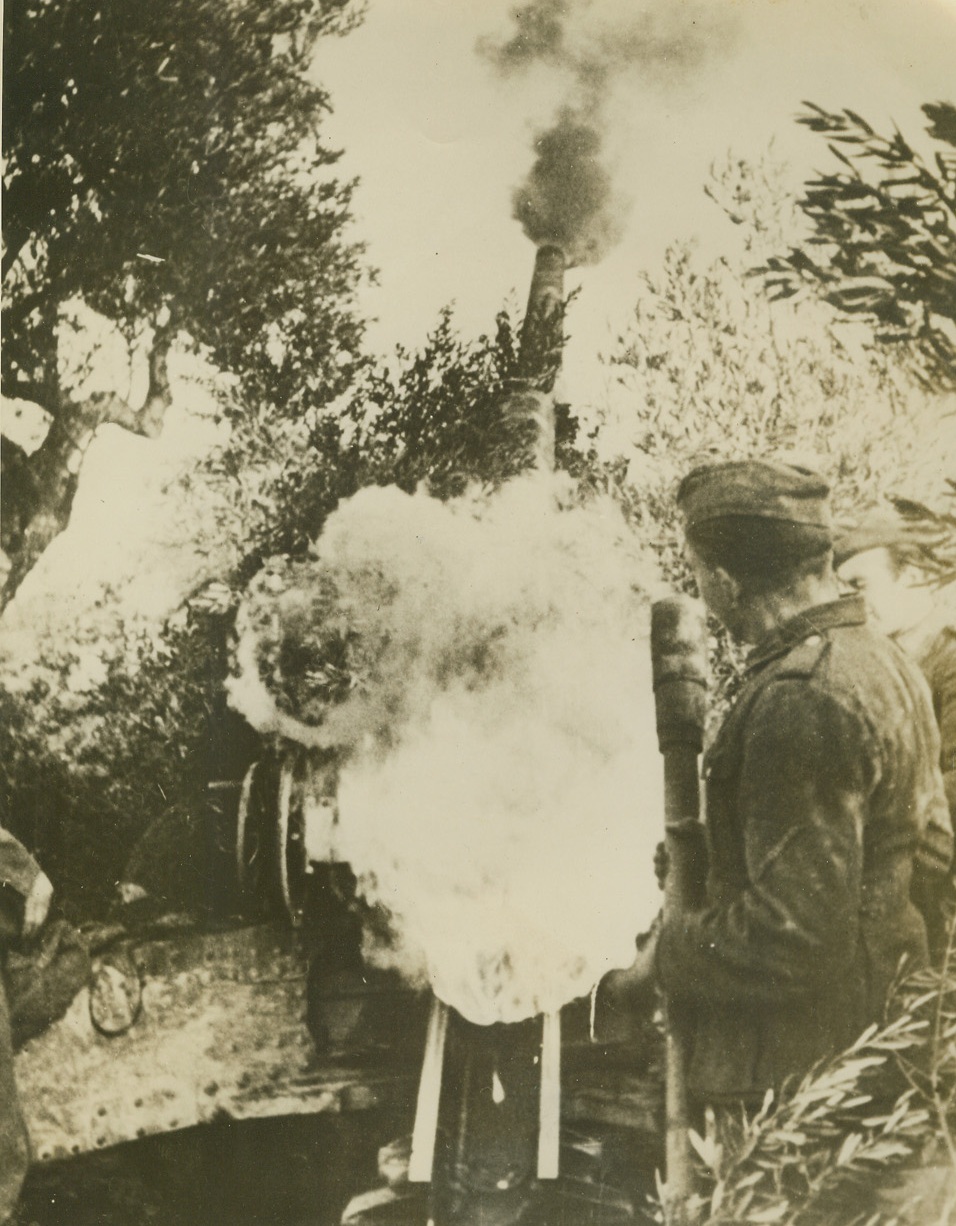
GERMAN BACKFIRE, 3/12/1944. ITALY—Smoke bursts forth from the muzzle and breech of a heavy German gun in action somewhere in Italy, according to German caption accompanying this photo received through neutral sources. This rear view of Nazi gun is symbolic of the way the Blitz turned into a slow-but-sure retreat. Credit: Acme;
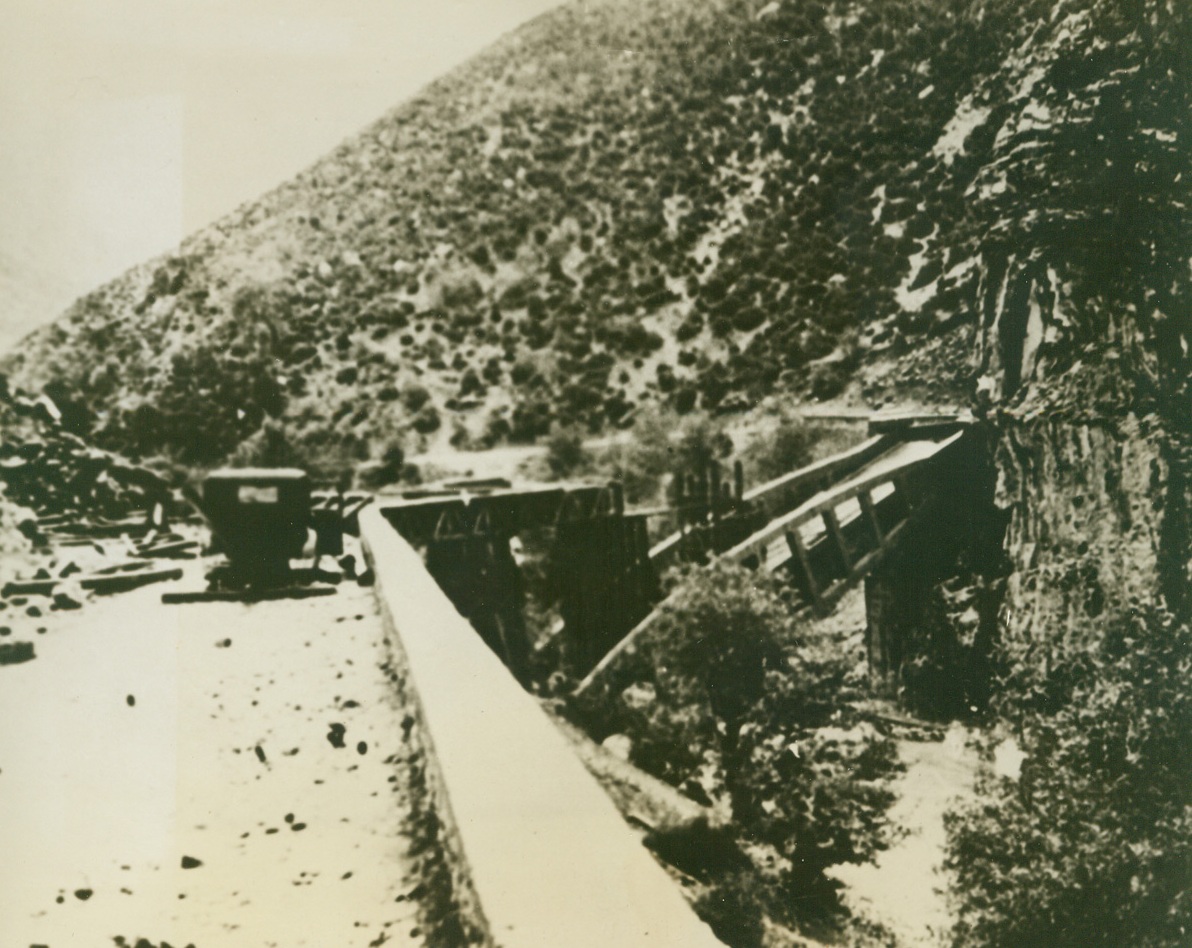
FREEDOM, OR DEATH!”—THE ANDARTES’ CREDO, 3/29/1944. GREECE—High in the mountains of Greece a storm of vengeance is gathering over the heads of Nazi occupation troops that are despoiling this once happy land, and staving, terrorizing and murdering its people. This “storm” is the growing band of Greek patriots, the Andartes, who are training and plotting for the day of Liberation. Even now, “lightning” strikes at German outposts in the form of sharp, deadly Andarte raids, and railway trains and bridges have been blown to bits by these grim, hardy guerillas. Every day, harassed Greek civilians find escape from the “New Order” in the mountain retreats of the Andartes, bringing with them their meager belongings and new tales of Nazi terrorism. The Andartes have sworn that someday, soon, Greece will be free again. The only alternative to their vow, is death. In this series of photos, just released in New York by the Greek Office of Information, activities of the Andartes are shown. NEW YORK BUREAU EVIDENCE OF ANDARTE ACTIVITY—Here a bridge along a mountain raod in Thessaly has been blown up, blocking the movement of supplies and reinforcements to Nazi mountain outposts. Credit: Acm;
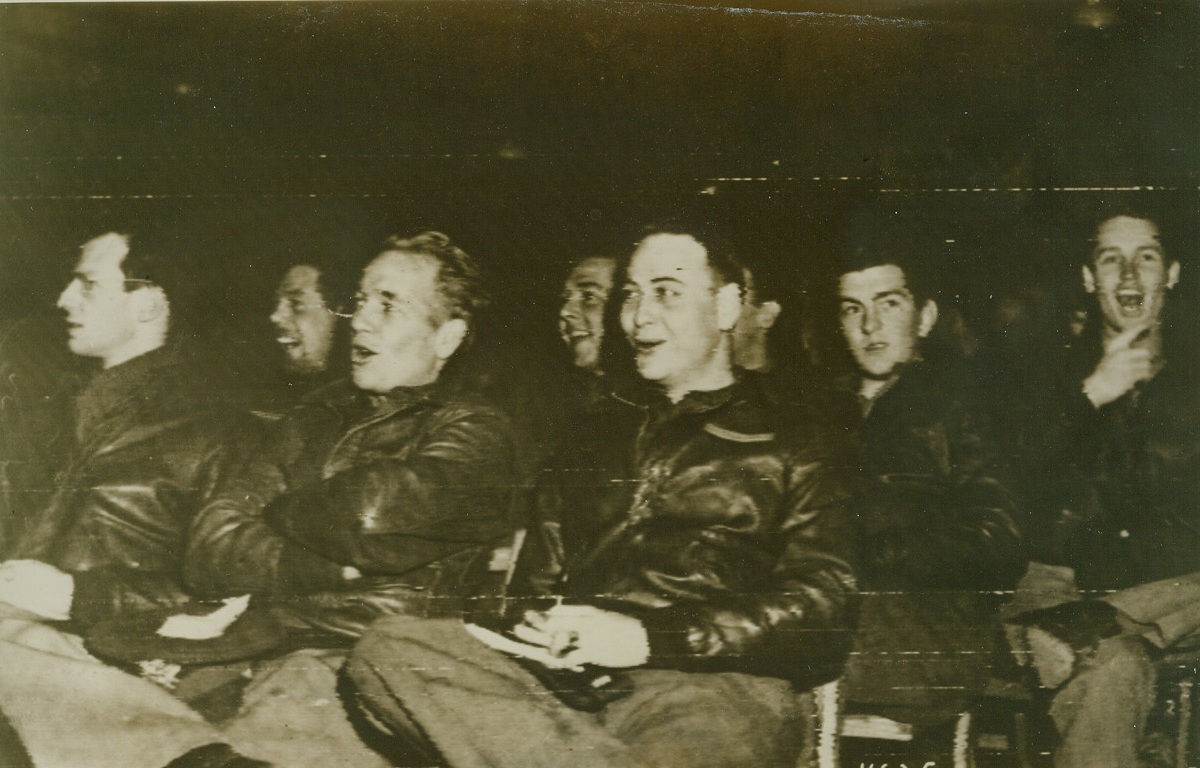
BERLIN ASSIGNMENT DRAWS CHEERS, 3/8/1944. A few seconds before this photo, which was flashed to the U.S. by radio today, was made crew members of this Flying Fortress group were told they were to bomb Berlin. Were they downhearted? Look at the smiles on their faces, as they cheer the news! Credit: USAAF photo via radiotelephoto from Acme;
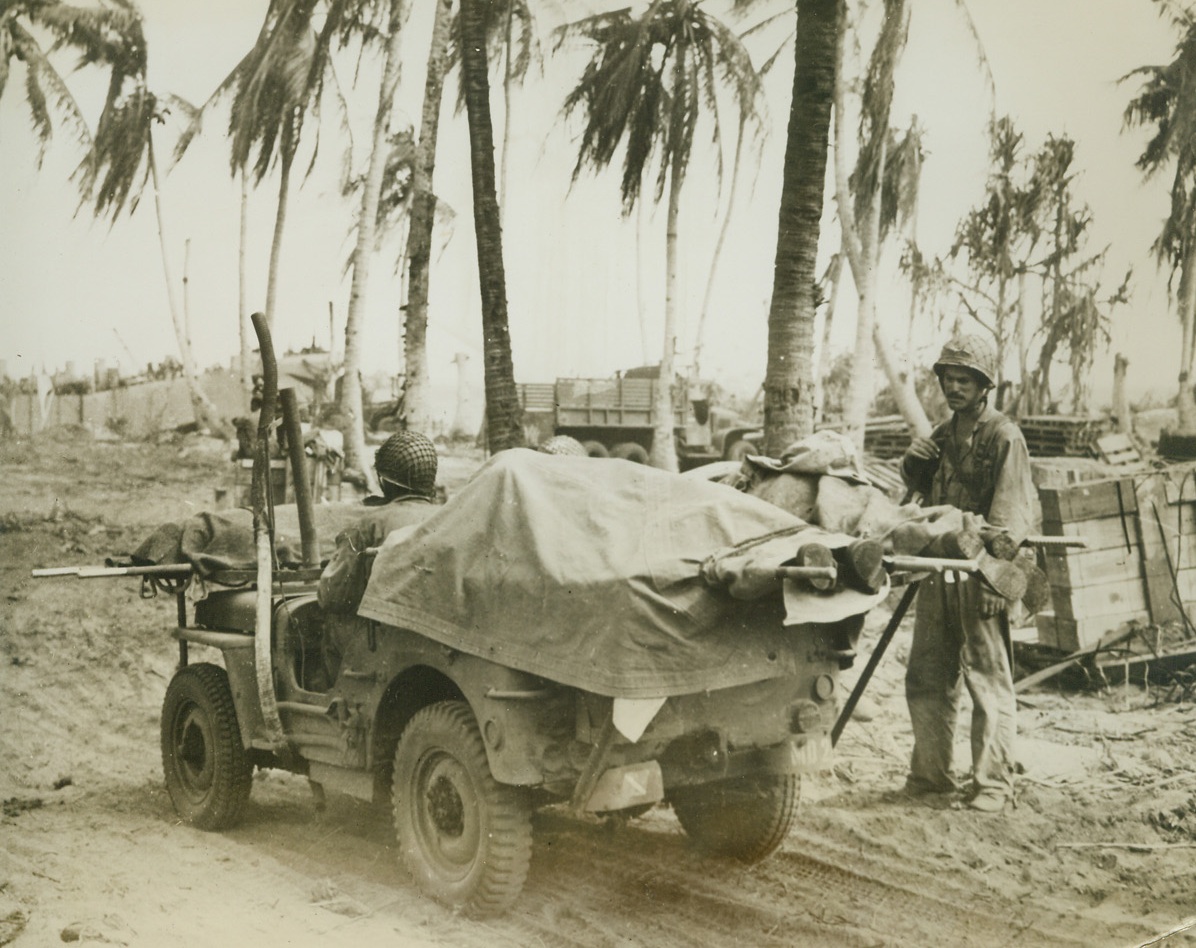
JEEP SERVES AS A HEARSE, TOO, 3/6/1944. ENIWETOK ISLAND—The versatile Jeep takes on a grim task on Eniwetok Island. Covered by a tarpaulin, bodies of American dead are carried away for burial on the island. Soldier at right sadly watches as his buddies take their last ride. Credit Line (ACME);
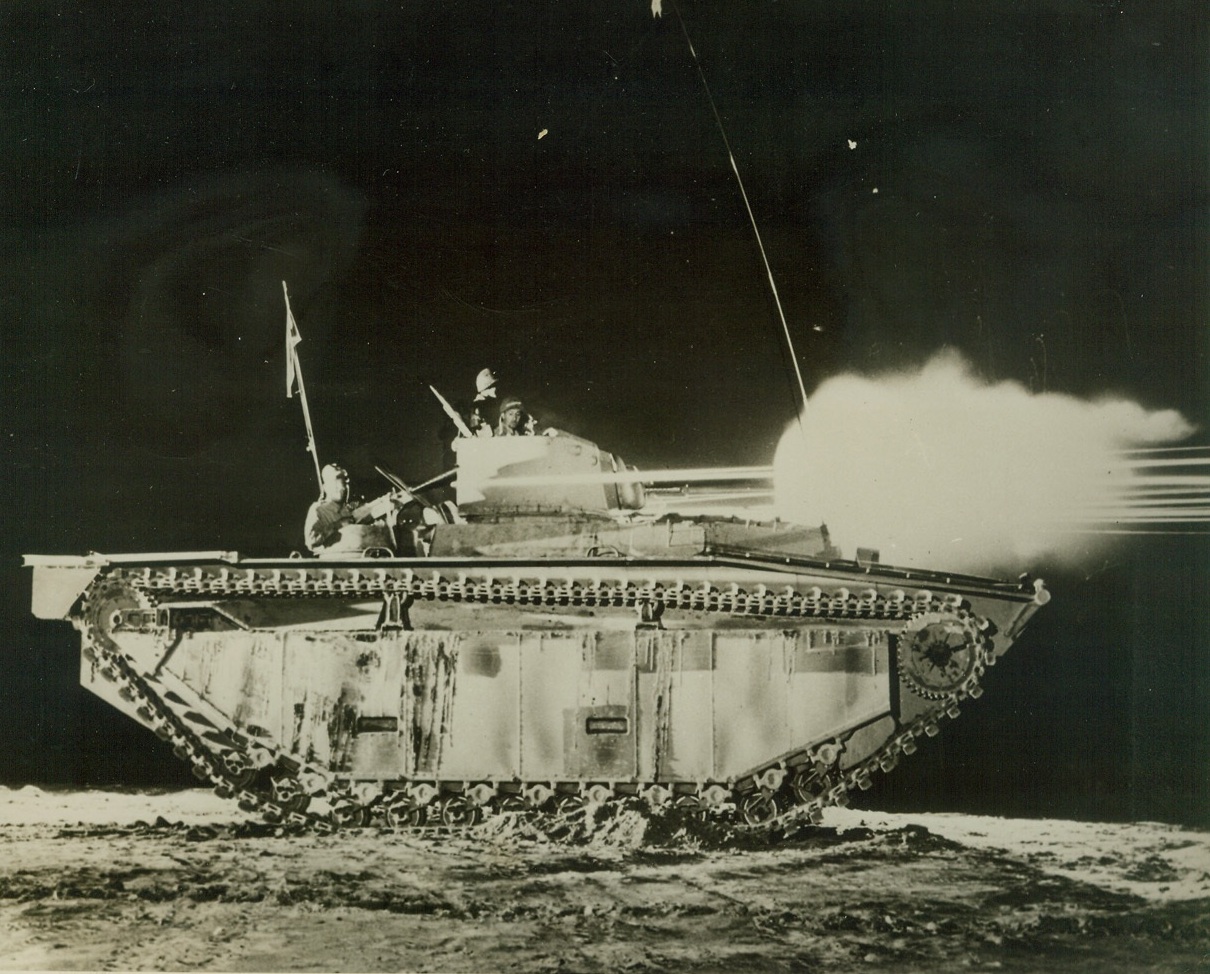
New "Water Buffalo" Packs a Wallop, 3/9/1944. WASHINGTON, D.C.-- In this photo, released by the Navy Department in Washington today, the 37mm. cannon and two 50cal. machine guns of a new LVT (A)-1 amphibious tank fire in unison to send streams of steel out over the test firing range. Illuminating the "Water Buffalo" with the glare. The new hard-hitting tank, similar to its predecessors except that it has its 37mm. cannon mounted in a turret, has already played an important role in the invasion of Jap strongholds in the Pacific. The vehicle, through its ability to travel with ease in water or on land, is a valuable invasion asset. Credit: (Official U.S. Navy Photo from ACME);
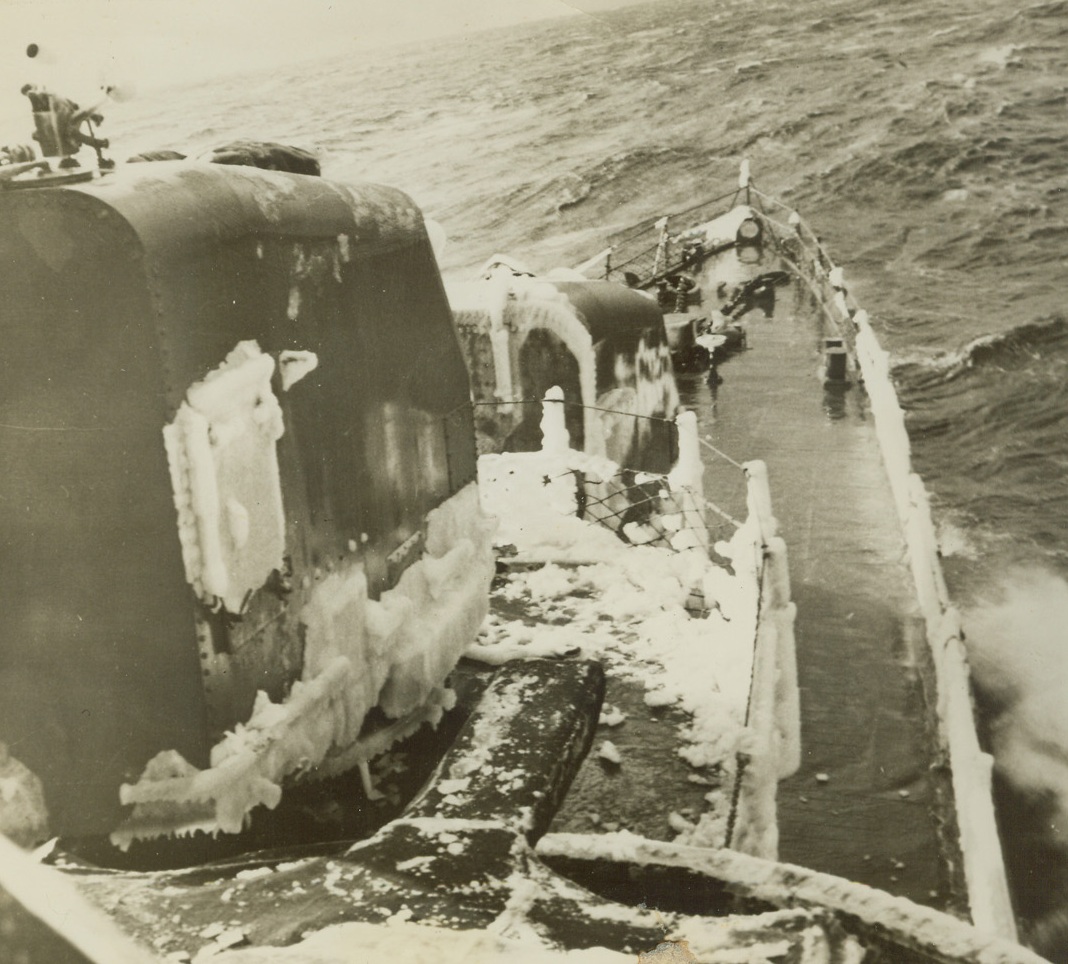
Cold Work, 3/2/1944. Somewhere in the Pacific – Ice forms along the decks and rails of the U.S. Task Force ships which shelled Paramushiro, Japanese Naval Base in the Northern Kurile Islands early in February. The raid marked the first time American Warships had come so close to Japanese home territory since the outbreak of war. Shore installations and a merchant vessel were damaged. The Task Force escaped unharmed. Credit: ACME;
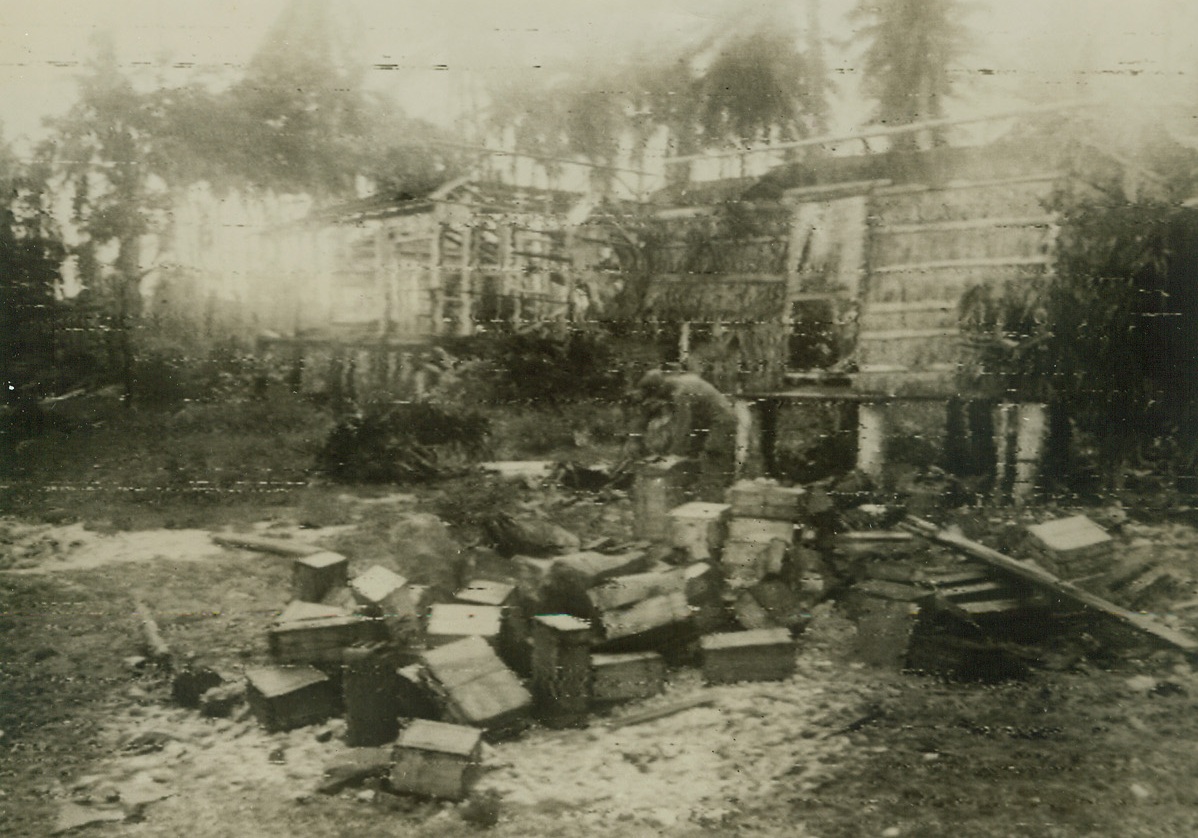
Checking Yank Supplies on Los Negros, 3/2/1944. Los Negros Island – Two members of the First U.S. Cavalry Division check supplies on the beach at Los Negros, after the American landing on this island of the Admiralty group. In the background can be seen Jap grass huts and supply dumps, wrecked by the pre-invasion air and sea bombardment. Photo was taken during a heavy rain by Acme photographer Tom Shafer. Gen. MacArthur, who personally directed the invasion Feb. 29, from the bridge of a ship of the Task Force, announced today that the Admiralty Invasion had been planned merely as a reconnaissance in force, but when it was discovered how completely the Japs were taken by surprise, the move was turned into a complete occupation. Credit: ACME photo by Tom Shafer for the War Picture Pool via Signal Corps Radiophoto;
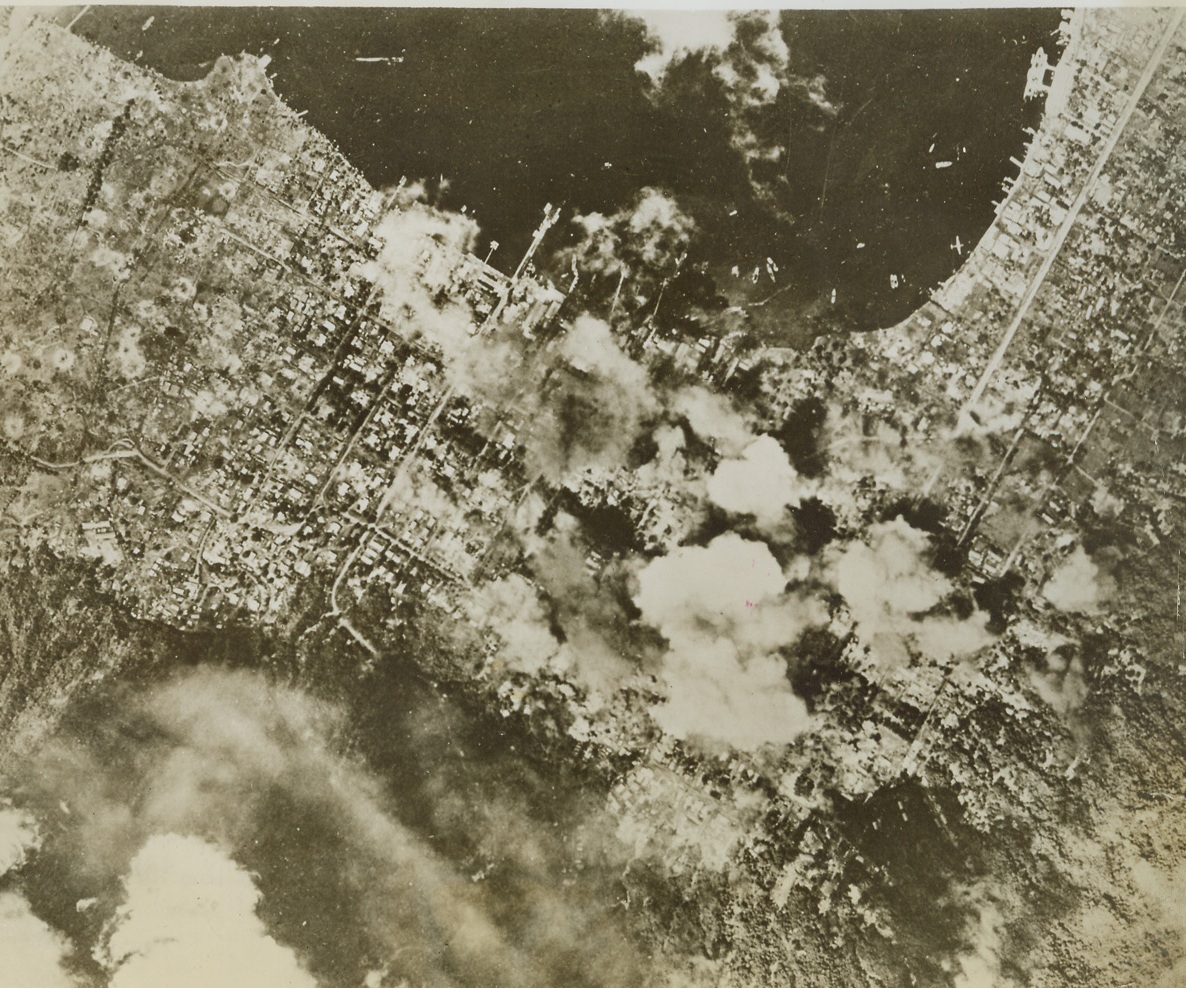
Bombs Blast City of Raboul, 3/26/1944. Raboul – Bombs explode in heart of city of Raboul, New Britain, Japanese staging and supply base in Southwest Pacific during a recent raid. Credit: Official U.S. Navy photo from ACME;
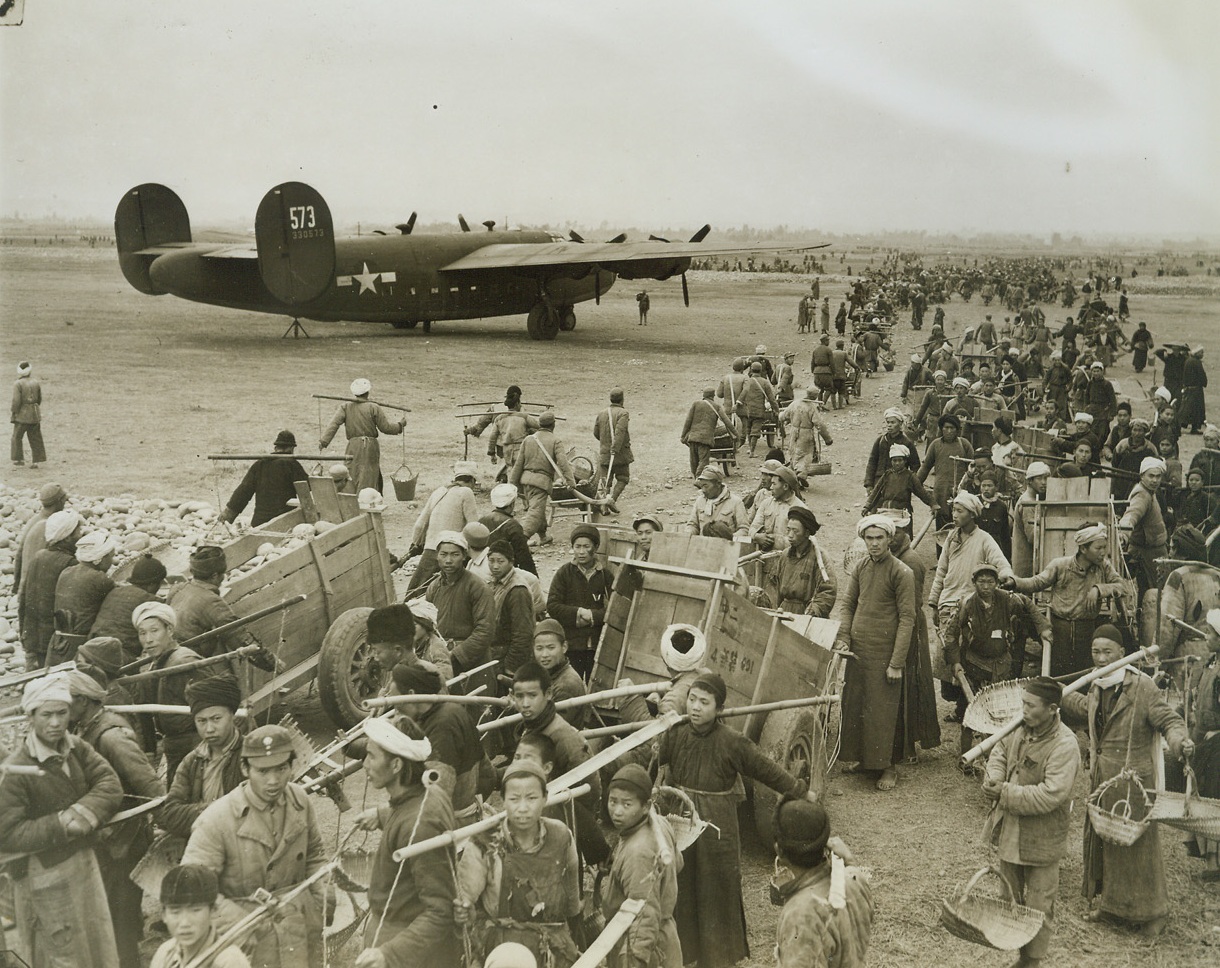
Airfield-Handmade, 3/31/1944. China – Lack of modern equipment and machinery isn’t stopping the resourceful Chinese from building modern airfields in China. Three hundred thousand Chinese workers have been conscripted to do the job. A hundred thousand little handmade wheelbarrows are used to transport materials – and even the chipping of stones for the runways is done by hand. American Engineers, working in conjunction with Chinese Army Engineers, are supervising the job. Photo shows: Long lines of laborers use every conceivable means of conveyance in transporting stones and dirt to build the runway. Credit: ACME photo by Frank Cancellare for the War Picture Pool;
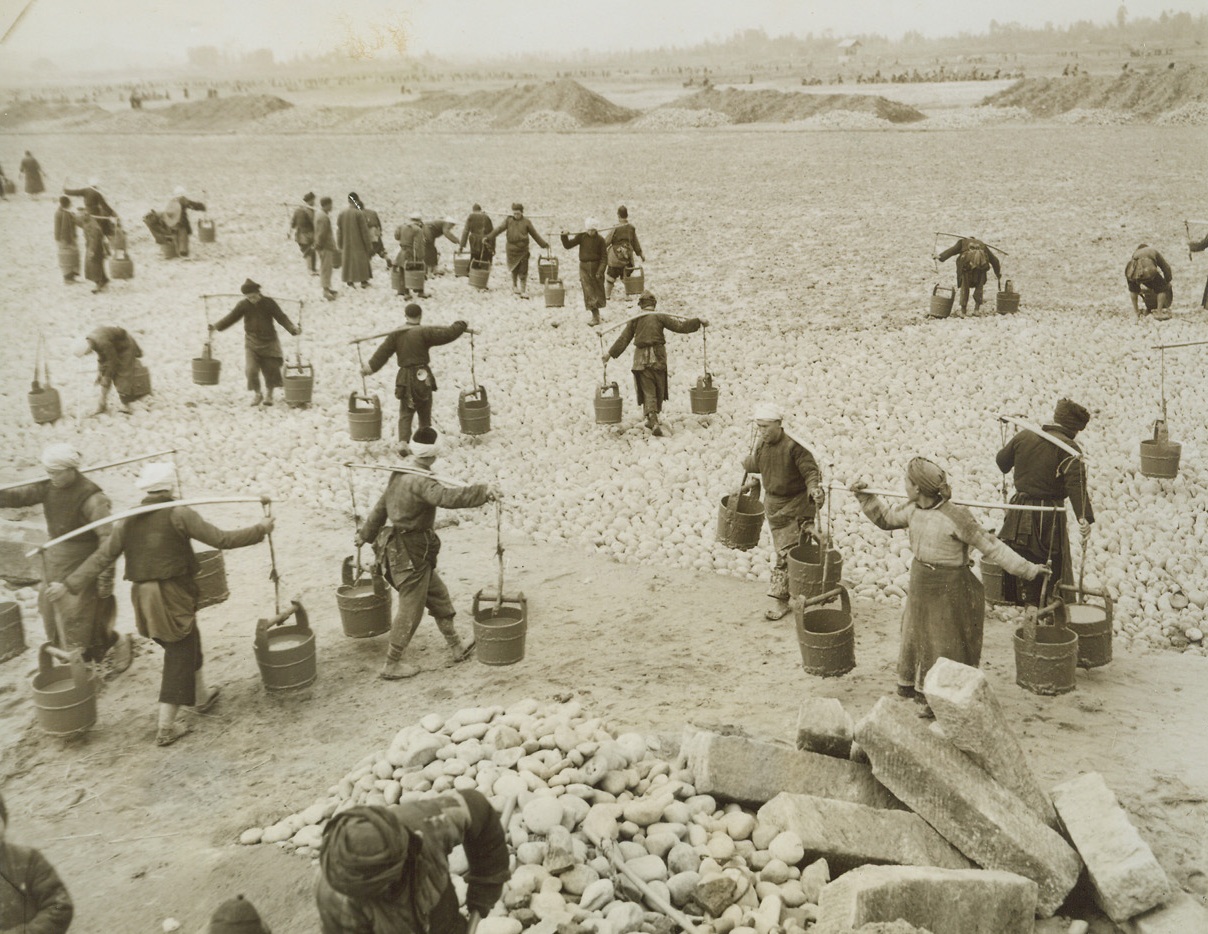
Airfield-Handmade, 3/31/1944. China – Lack of modern equipment and machinery isn’t stopping the resourceful Chinese from building modern airfields in China. Three hundred thousand Chinese workers have been conscripted to do the job. A hundred thousand little handmade wheelbarrows are used to transport materials – and even the chipping of stones for the runways is done by hand. American Engineers, working in conjunction with Chinese Army Engineers, are supervising the job. Photo shows: The Chinese workers pour “slurry” to fill in the holes on a runway. Credit: ACME photo by Frank Cancellare for the War Picture Pool;
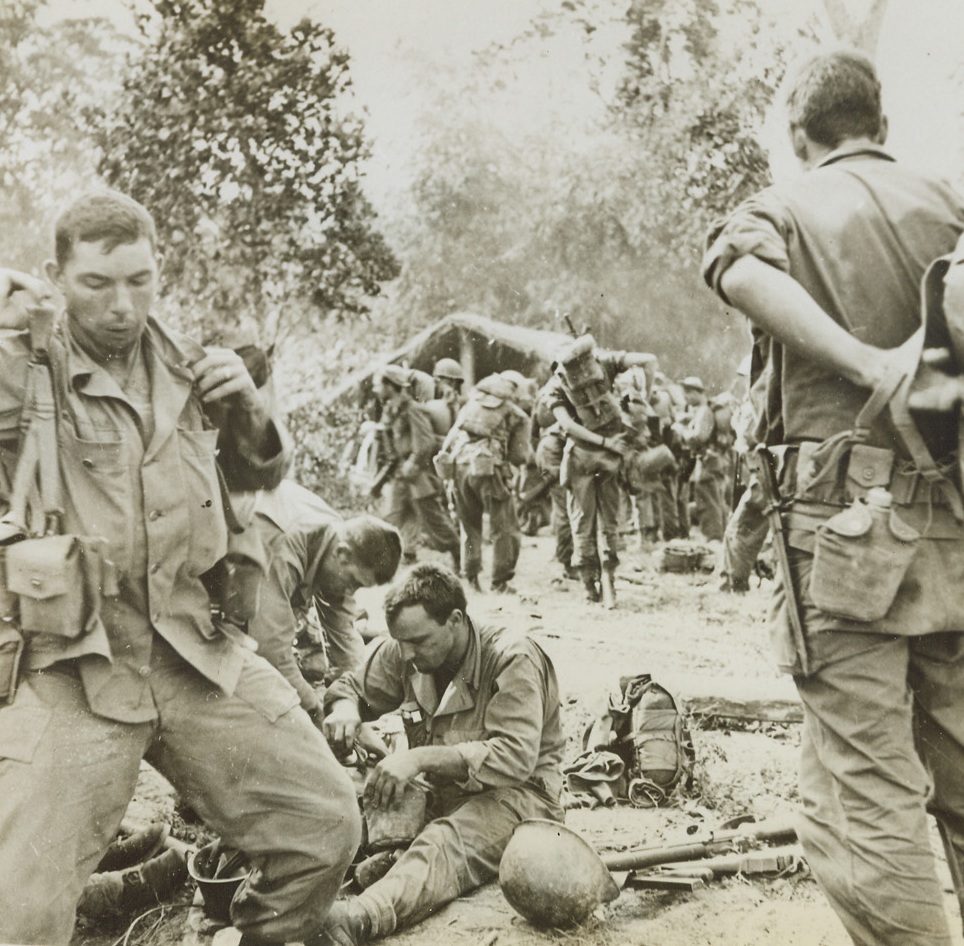
A Brief Rest for the Weary, 3/31/1944. Northern Burma – Battle-weary Yanks rest during a brief meal period in a deserted Kachin Village in the Hukawng Valley, Northern Burma. The troops have just returned from four days continuous fighting in the front lines. They are members of Gen. “Joe” Stilwell’s American and U.S. trained Chinese forces, who are successfully driving out the Japs from Northern Burma. Credit: ACME;
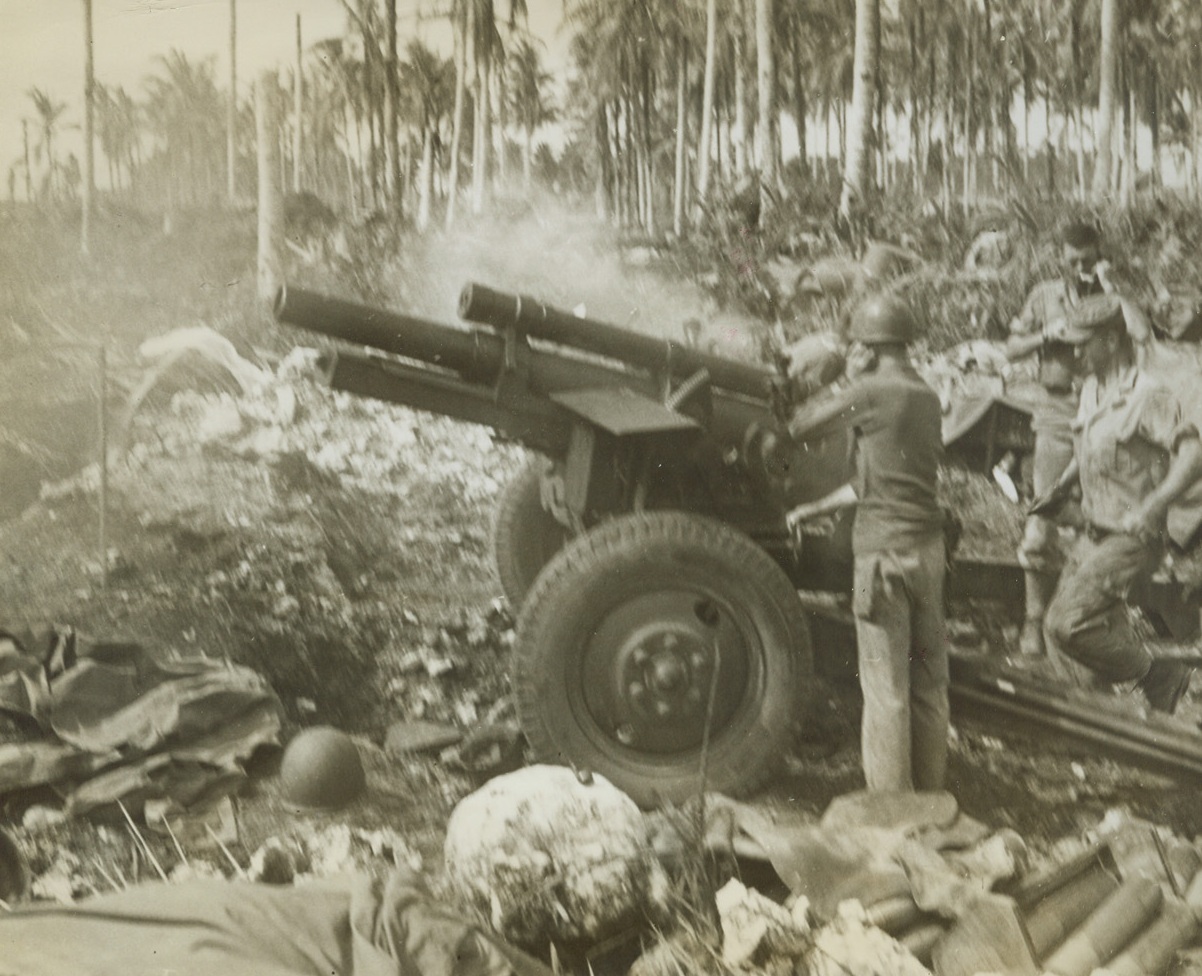
Cleaning ‘Em Up, 3/23/1944. Los Negros, Admiralty Islands – An Allied 150mm gun dishes out plenty of trouble for Japanese troops remaining on Los Negros Island after Yanks had conquered most of the isle. The gun station is in the heart of a battered coconut grove that was blasted by air and sea forces before ground troops landed. Credit: ACME photo by Frank Prist, Jr., for the War Picture Pool;
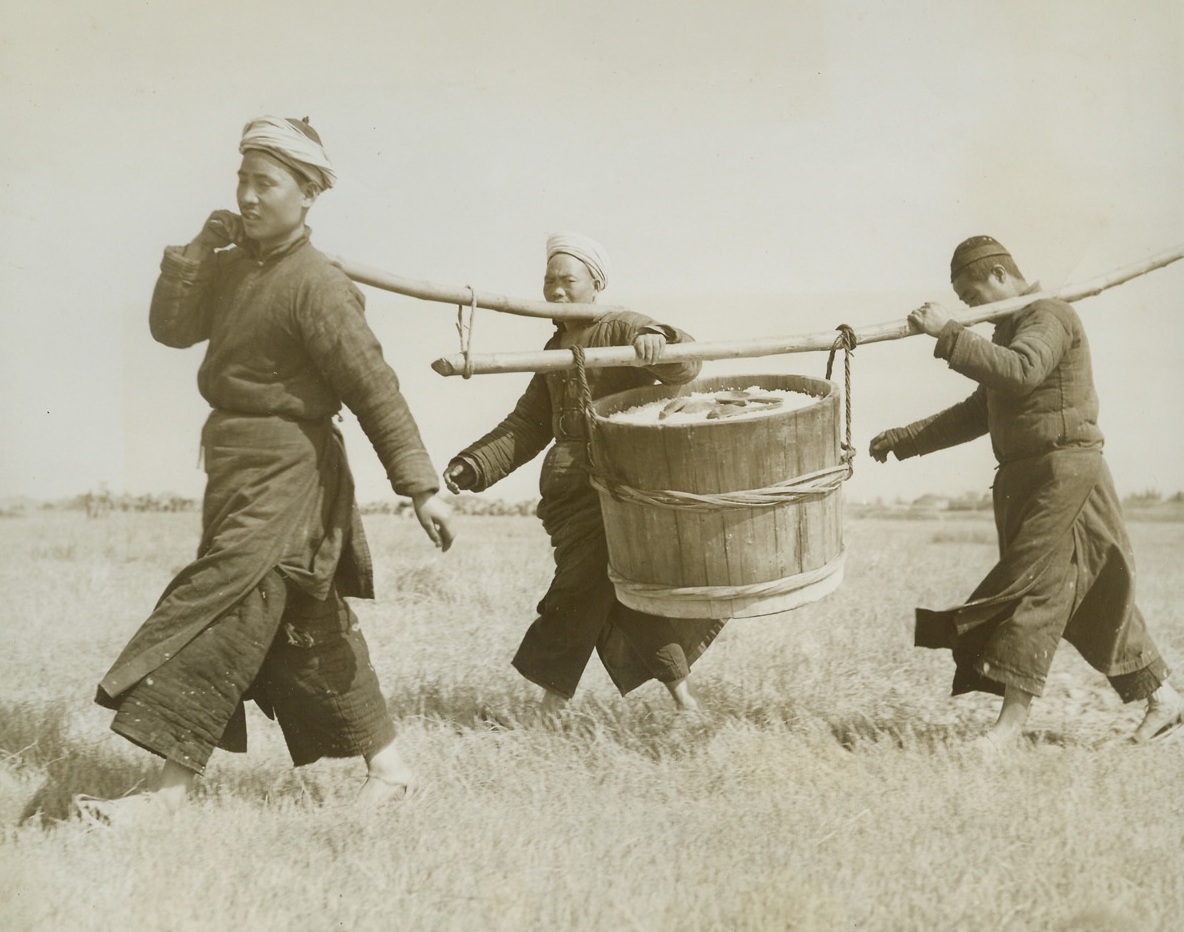
Airfield-Handmade, 3/31/1944. China – Lack of modern equipment and machinery isn’t stopping resourceful Chinese from building modern airfields in China. Three hundred thousand Chinese workers have been conscripted to do the job. A hundred thousand little handmade wheelbarrows are used to transport materials – and even the chipping of stones for the runways is done by hand. American Engineers are supervising the work, in conjunction with expert Chinese Army Engineers Photo shows: The laborers eat their meals out on the runway so that no time is lost going to and from lunch. This Chinese K.P. outfit carries a bucket of rice out to the workers. Credit: ACME photo by Frank Cancellare for the War Picture Pool;
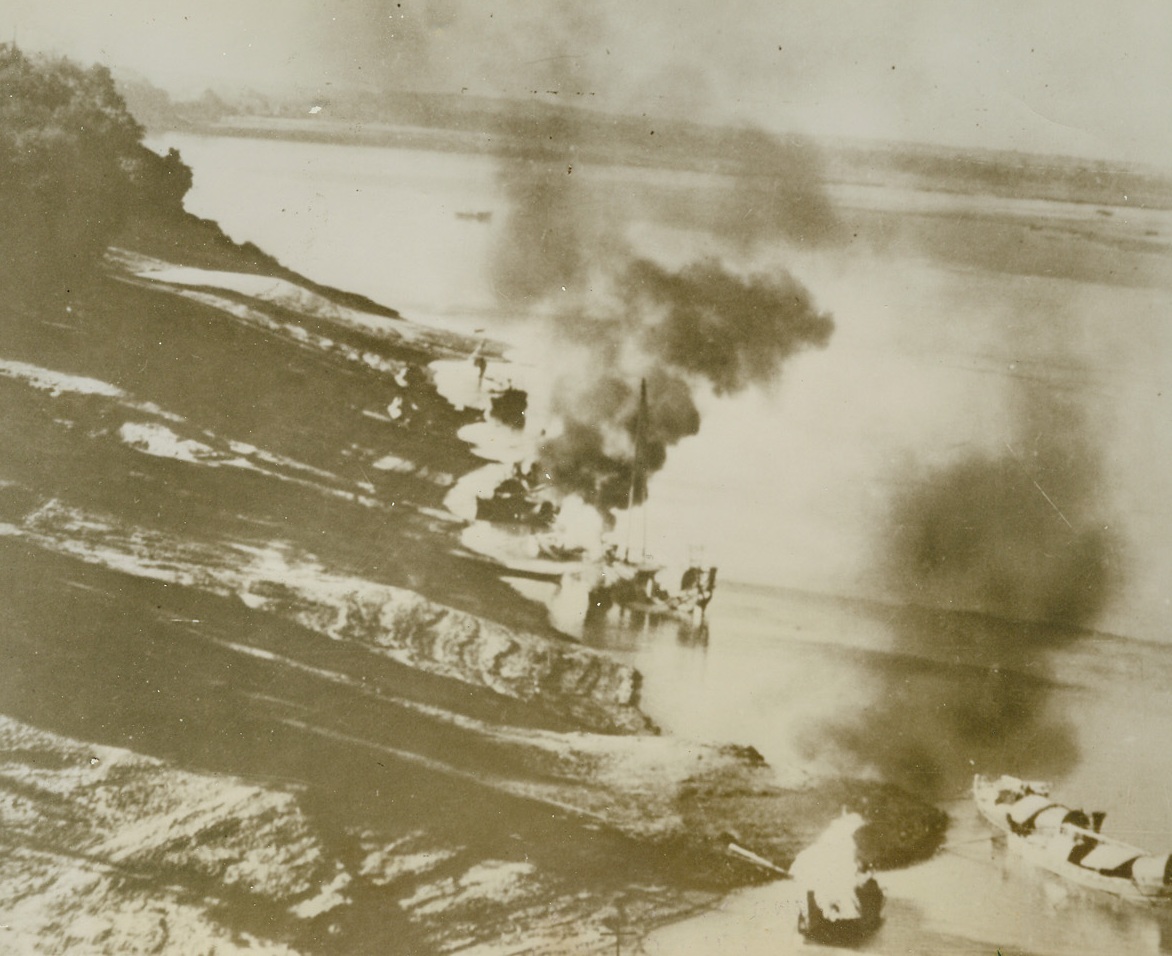
Beaufighters Strike Swiftly, 3/12/1944. BurmaGiving off clouds of black smoke, indicating that they were probably loaded with petrol or oil, five native craft used by the Japs for river transportation is set ablaze, set by a Beaufighter attack at Yotahaya a few miles south of Magwe on the Irrawadday River, Burma. The R. A. F. planes struck swiftly and sharply with excellent results.Credit: ACME;
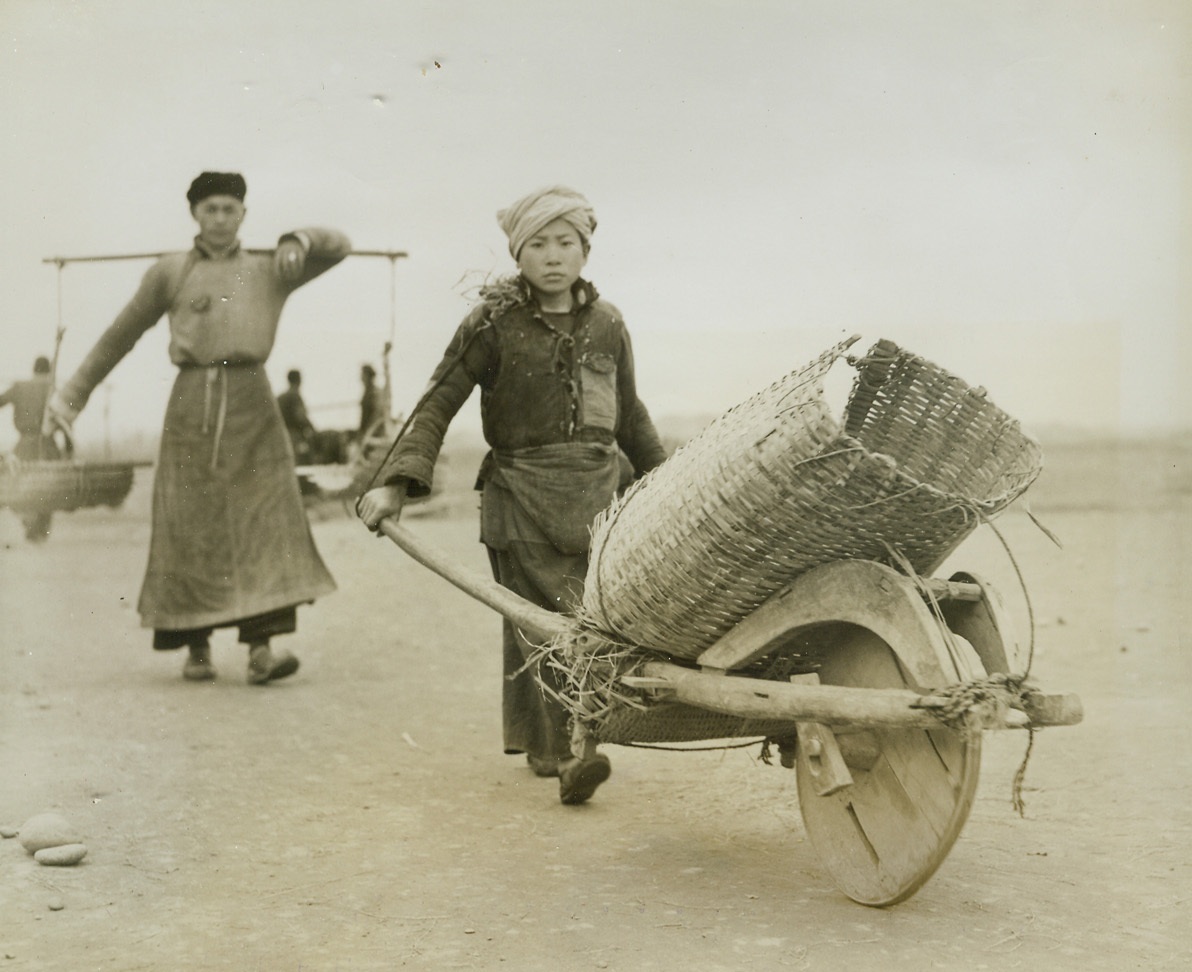
Airfield—Handmade, 3/31/1944. Lack of modern equipment and machinery isn’t stopping the resourceful from building modern airfields in China. Three hundred thousand Chinese workers have been conscripted to do the job. A hundred thousand little handmade wheelbarrows are used to transport materials—and even the chipping of stones for the runways is done by hand. American engineers working in conjunction with expert Chinese army engineers are supervising the job. Photo shows: a young Chinese boy carries essential materials to a runway, using a wheelbarrow constructed of bamboo and wood to carry his load.Credit: ACME Photo by Frank Cancellare for the war picture pool.;
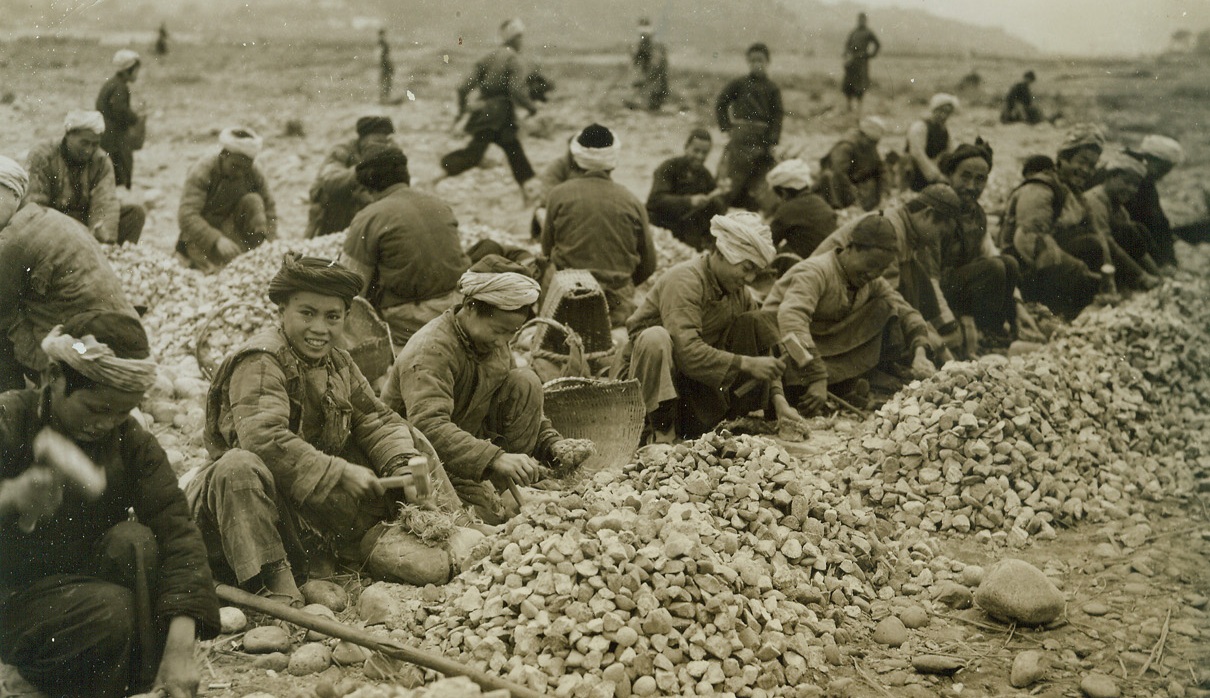
Airfield – Handmade, 3/31/1944. China – Lack of modern equipment and machinery isn’t stopping resourceful Chinese from building modern airfields in China. Three hundred thousand Chinese workers have been conscripted to do the job. A hundred thousand little handmade wheelbarrows are used to transport materials – and even the chipping of stones for the runways is done by hand. American Engineers, working in conjunction with expert Chinese Army Engineers, are supervising the job. Photo shows: A formation of Chinese workers busily chips the stones for the runway by hand.Credit: ACME photo by Frank Cancellare for the War Picture Pool;
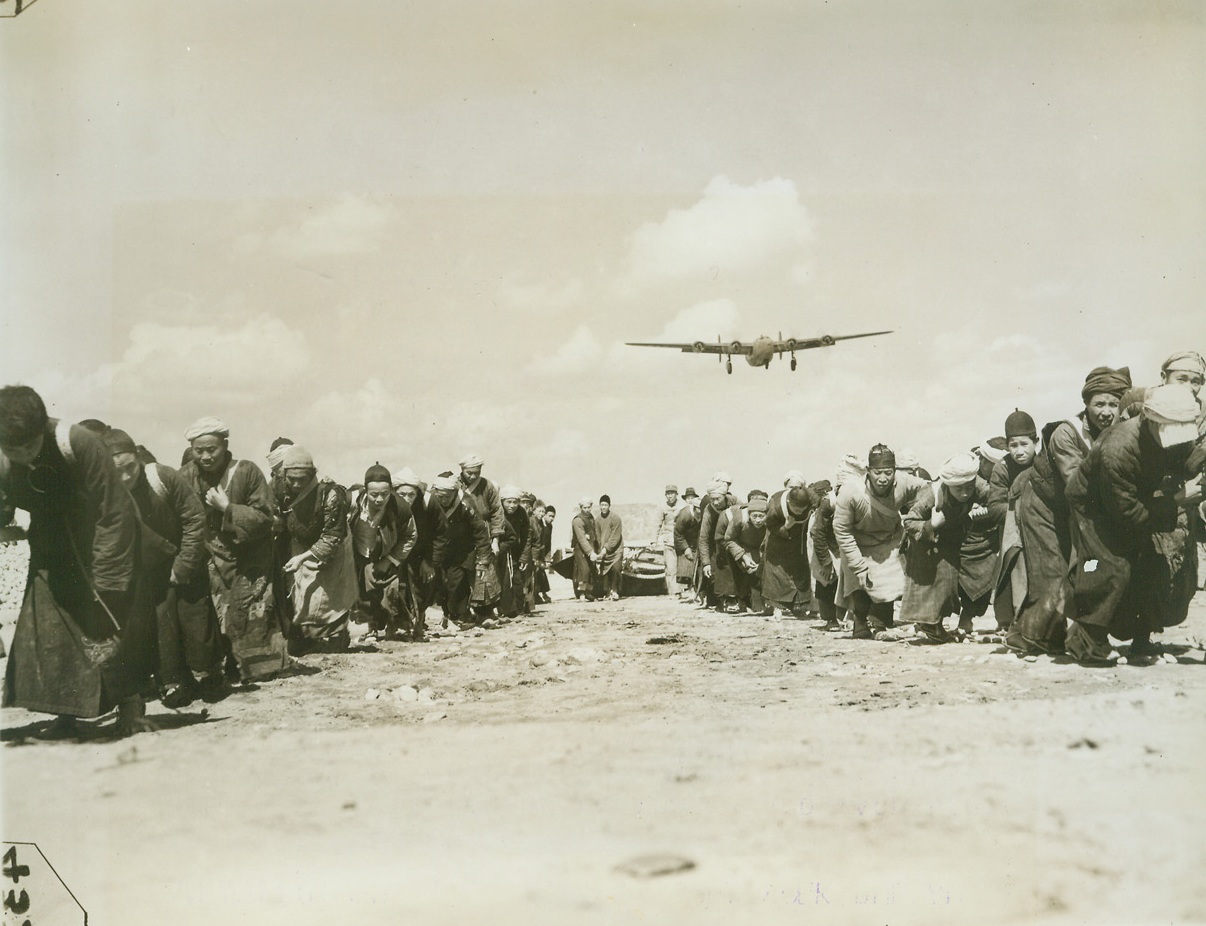
Airfield -- Handmade, 3/31/1944. China – Lack of modern equipment and machinery isn’t stopping the resourceful Chinese from building modern airfields in China. Three hundred thousand Chinese workers have been conscripted to do the job. A hundred thousand little handmade wheelbarrows are used to transport materials – and even the chipping of stones for the runways is done by hand. American engineers, working in conjunction with expert Chinese Army Engineers, are supervising the job. Photo shows: drawing a sharp contrast between modern machinery and medieval labor, this Liberator boars over a group of coolies as they strain at the back-breaking job of hauling a huge stone roller over the runway. Credit line(ACME photo by Frank Cancellare for the War Picture Pool) – WP;
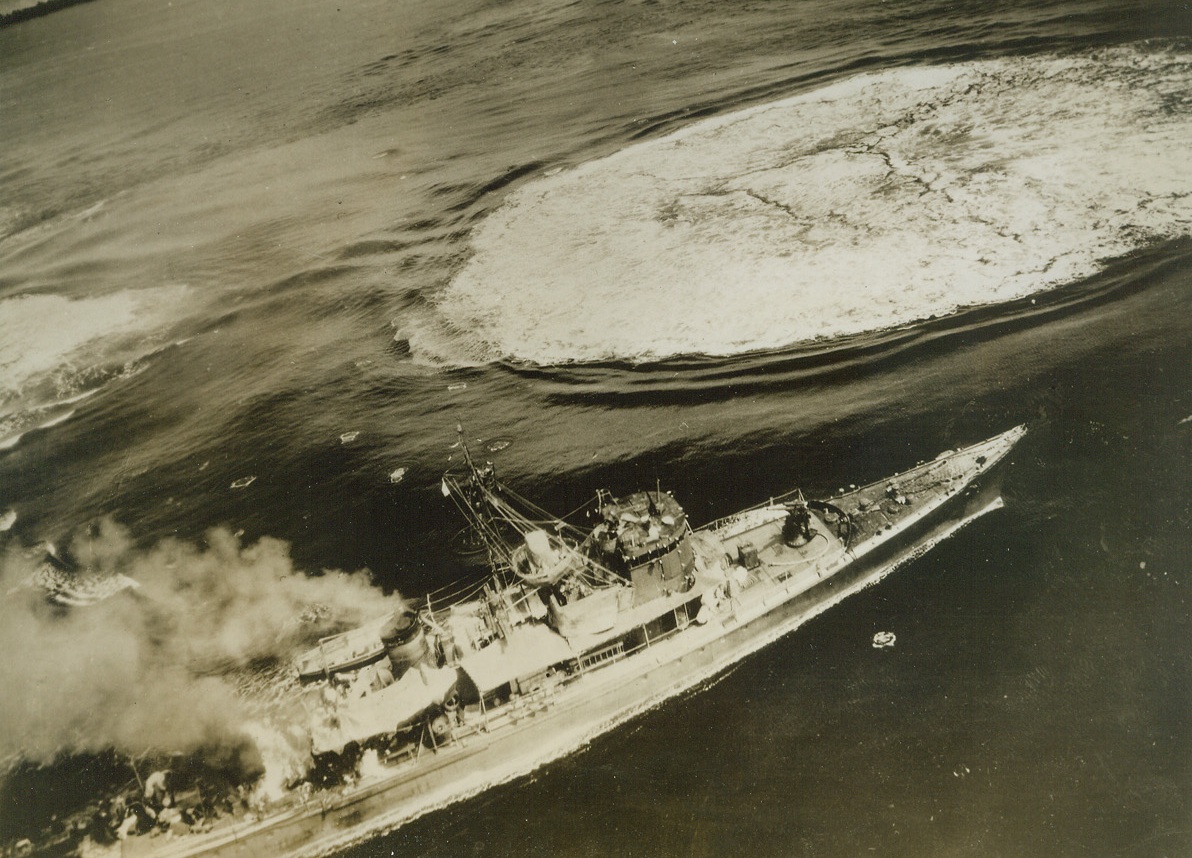
Marked for Davy Jones, 3/8/1944. This remarkably clear photo taken from a bomber of the U.S. Army 5th Air Force, and just released in the U.S., shows a Jap destroyer burning fiercely from a direct hit abaft the stack, just before Yank planes finished the warship off. Only a few crew members can be seen on deck, as the bombers roared in for the attack, (two Japs are huddled just forward, and below the bridge). The destroyer was one of 17 Nip vessels sunk. In the American air attack off Mussau island, about 50 miles Northwest of New Ireland. (this is the original of a radio photo serviced you previously). Credit line (USAAF photo from ACME);
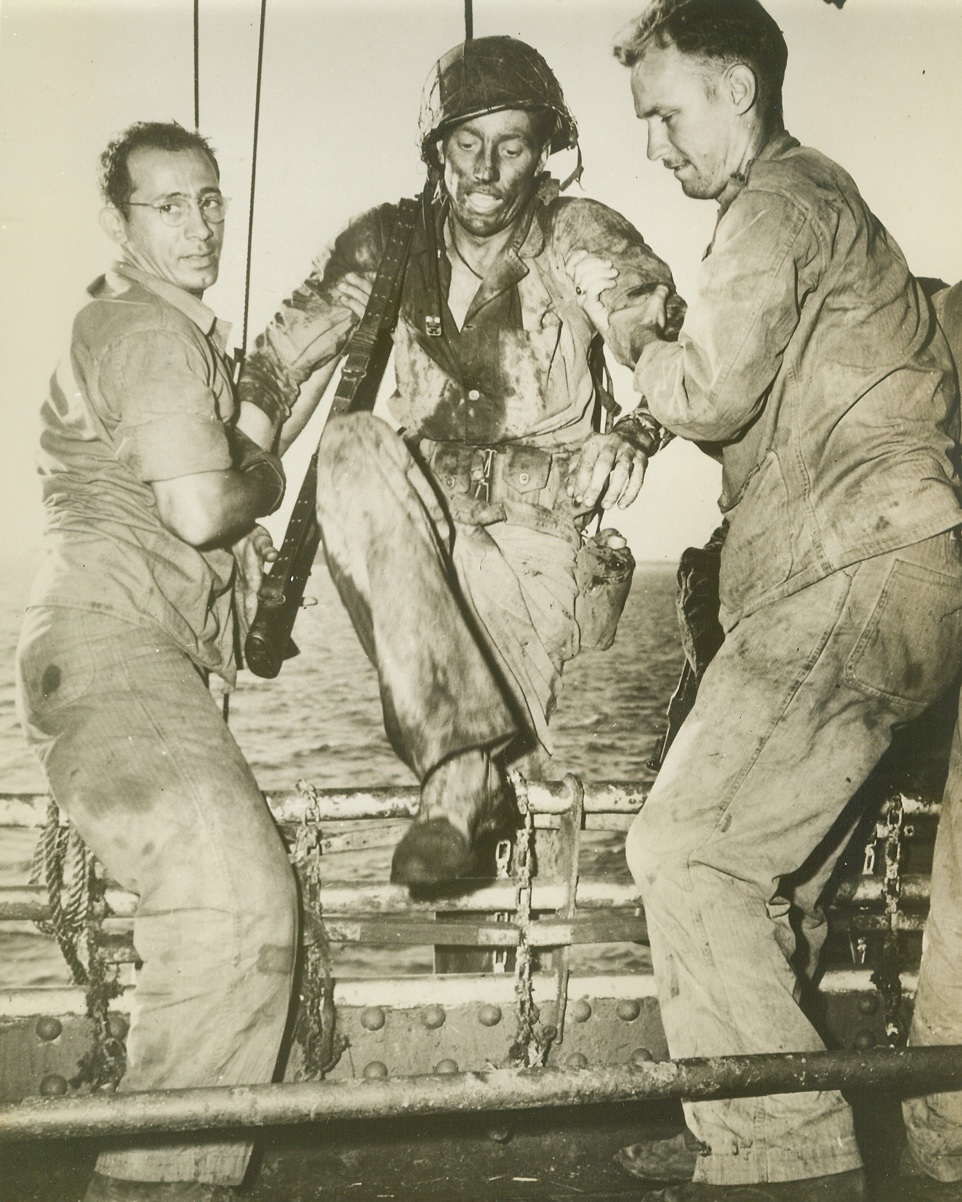
Back from Eniwetok “Hell”, 3/9/1944. Washington, D.C. – Coast Guardsmen assist a battle-blackened Marine over the side of an assault transport after two days of intensive fighting had wiped out the Japs at Eniwetok Atoll in the Marshalls. That’s not camouflage on his face, but coral dirt which smeared his face as he burrowed into the ground to avoid being hit by Nip snipers. Credit (U.S. Coast Guard photo from ACME);
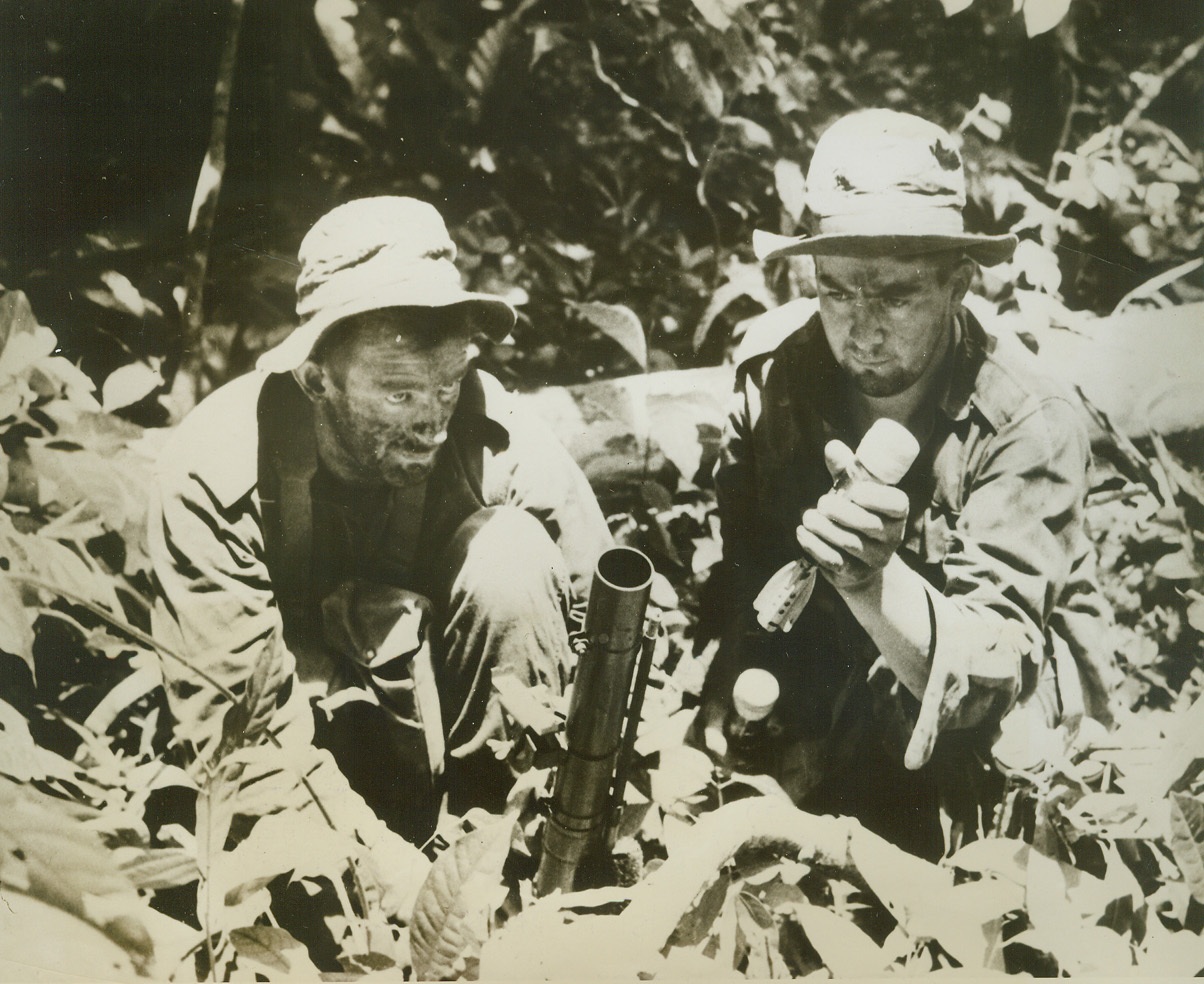
Jap-Busting on Green Island, 3/13/1944. Solomon Island – Two New Zealanders, Fred Mazengarb (left), of Gisborne, N.Z.; and William Elmiger, of Tearoha, N.Z. get ready to lob a deadly mortar shell at the Japs on Green Island, after allied forces had landed on the island just North of Bougainville, last Feb. 16th. Credit line (U.S. Navy official photo from ACME);
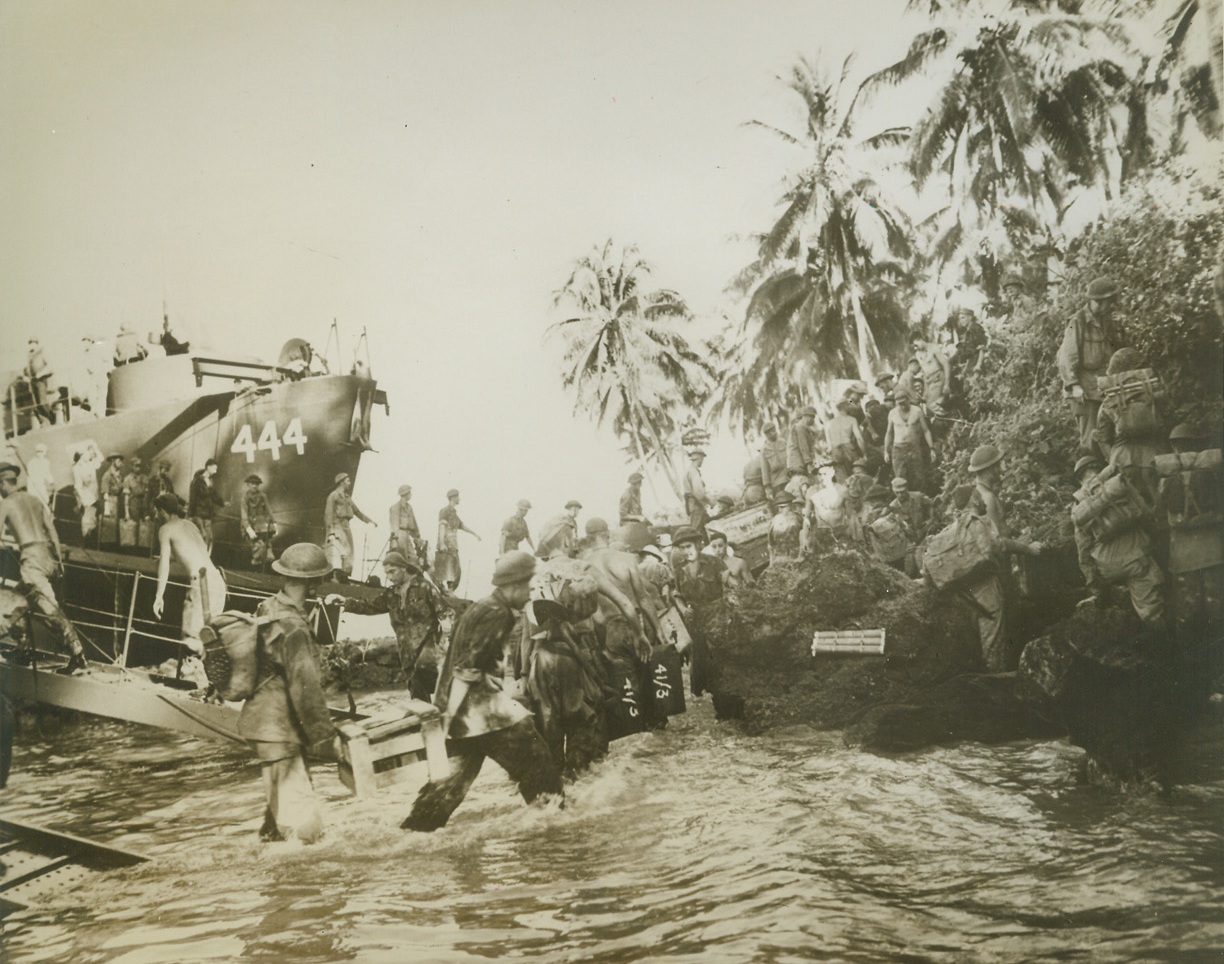
Green Islands in Allied Hands, 3/13/1944. Washington, D.C: American and New Zealand forces, covered by the U.S. Navy, land and occupy the Green Islands just North of Bougainville. This photo, made a right after the landing, is typical of others in the growing list of Pacific invasions. Overhanging palms and thick underbrush border the shore where sweating New Zealanders, rifles set aside for the time, labor in the tropic heat to unload a landing craft. Credit (ACME);
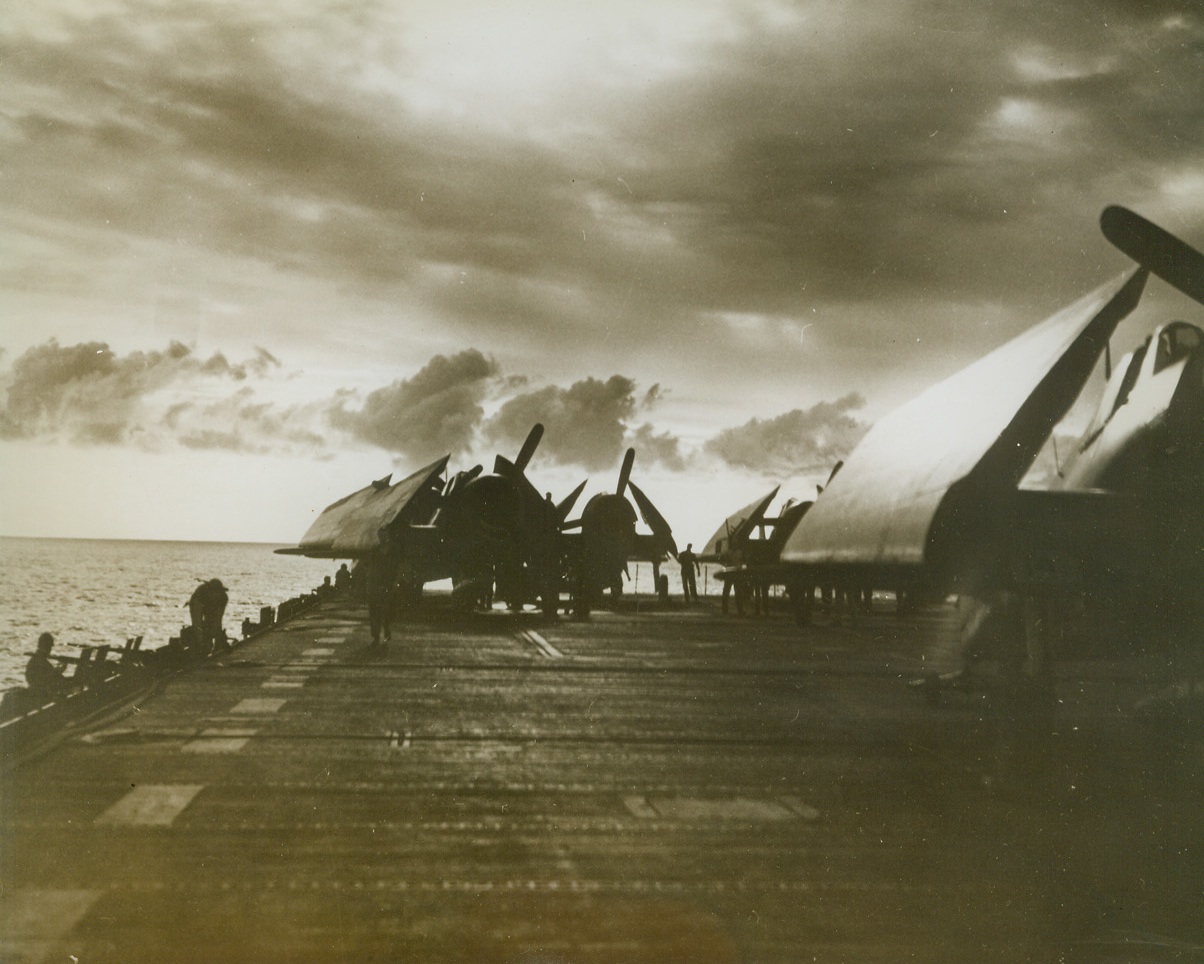
War birds at Rest, 3/21/1944. Central Pacific – Silhouetted against the clouds and the sunset, these planes aboard an aircraft carrier of the U.S. Navy Pacific fleet are at rest with their wings folded. At the first sign of action, however, they are ready for a quick takeoff. Credit Line (U.S. Navy photo from ACME);
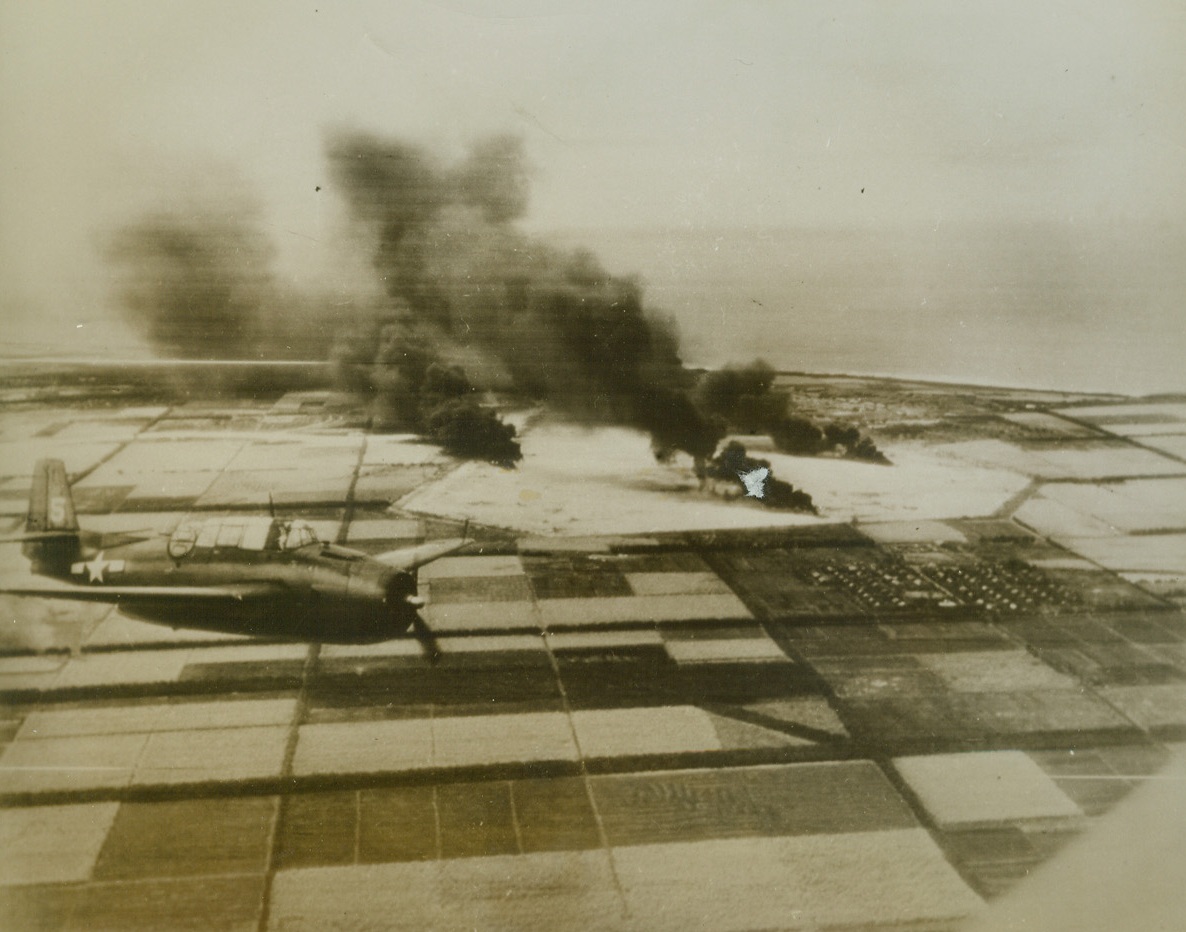
Navy Planes Blast Mariana Island, 3/7/1944. Tinian Island – Huge pillars of smoke rise from direct hits on Jap planes and supplies scored by Navy carrier-based dive bombers during a raid on Tinian island in the Marianas. One of the planes which blasted the Japs (left) soars above the orderly squares of the sugar cane fields adjoining the enemy airstrip. Credit line (ACME);
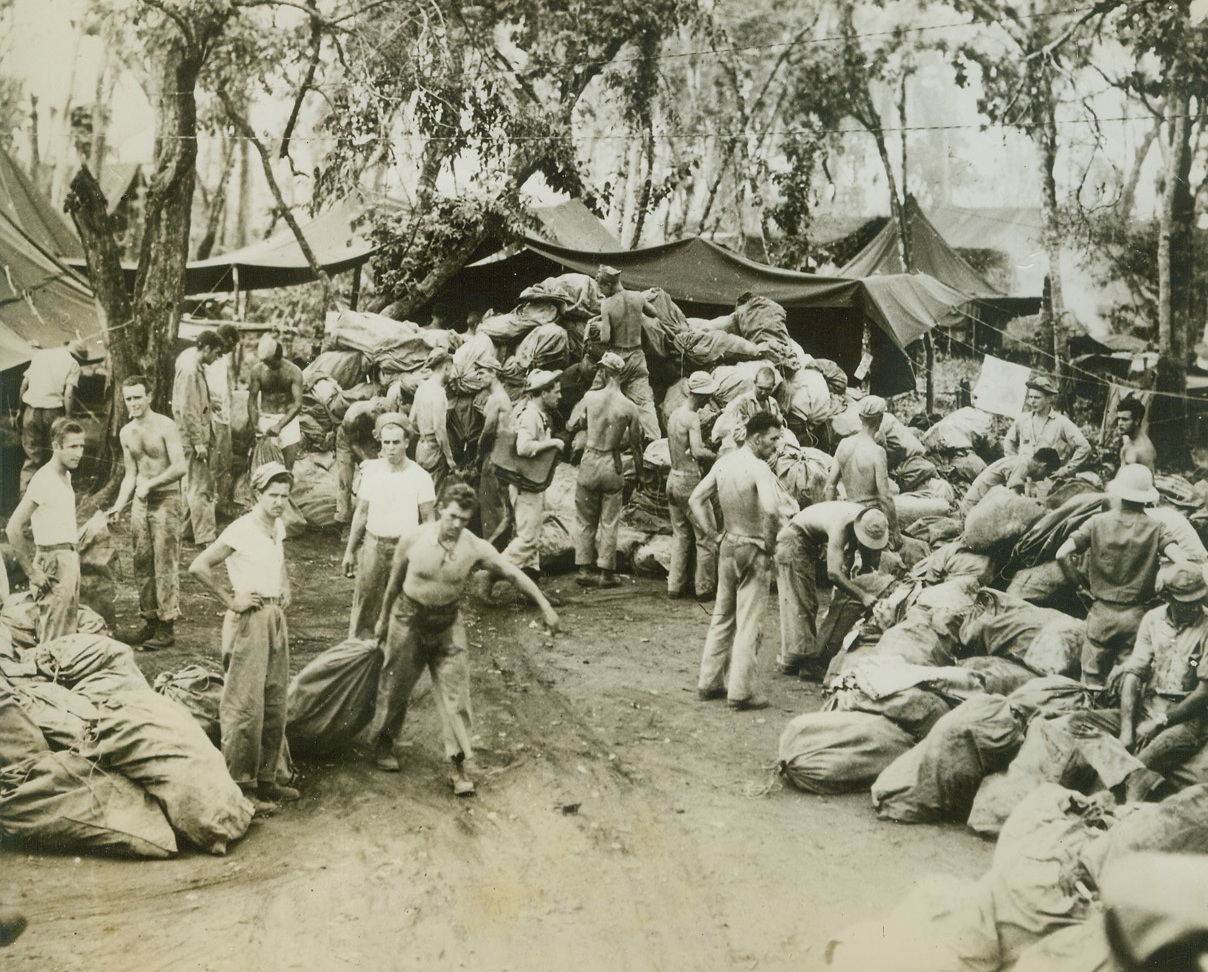
Mailman Comes to Gloucester, 3/12/1944. Cape Gloucester – Less than a week after the Marines hit the beach at Cape Gloucester, their mail arrived. Here hundreds of sacks of the best morale builder in the world are sorted a short distance behind the enemy lines. Credit line (Official Marine Corps photo – ACME);
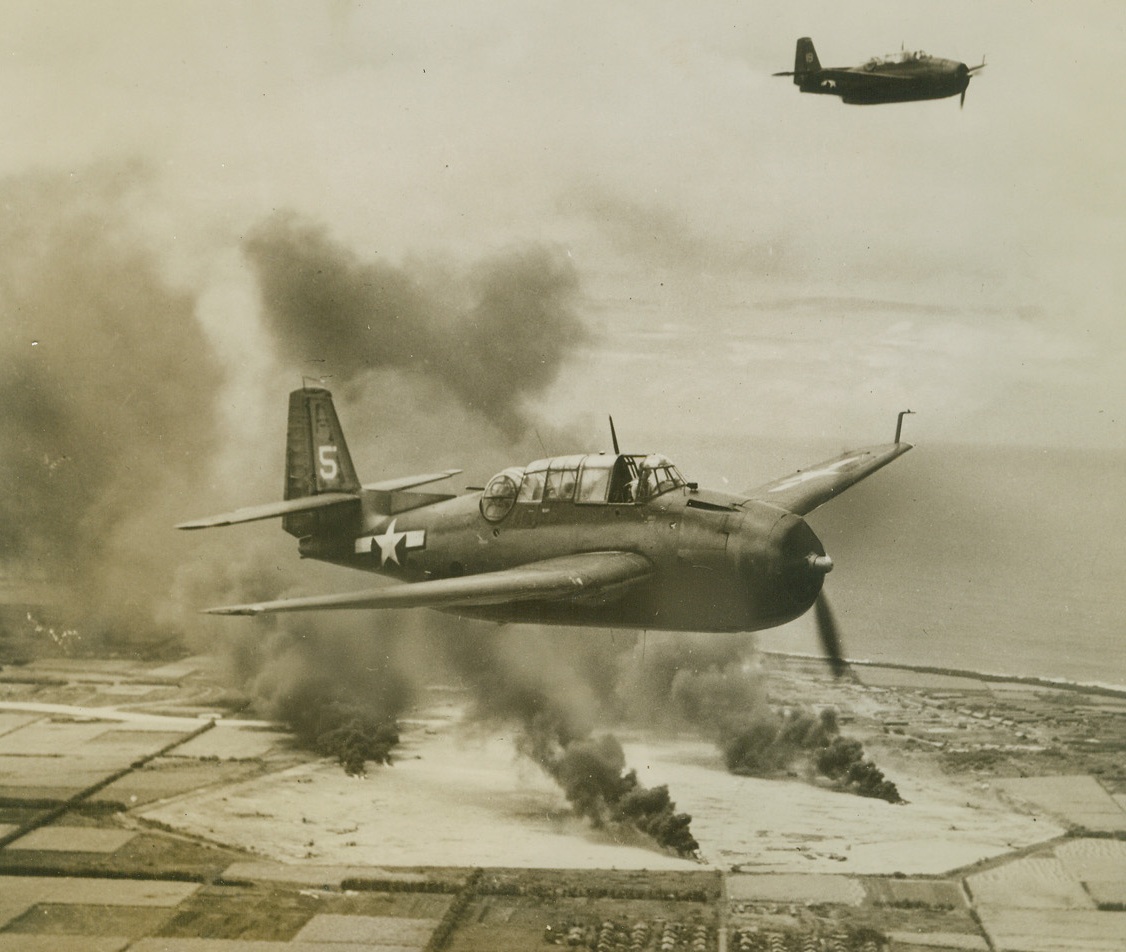
Jap Planes Blasted in Marianas, 3/10/1944. Tinian Island Huge pillars of smoke rise from direct hits on Jap planes on Tinian island airfield as a result of attack by TBF Avengers in the Marianas. Our planes breeze away from their destructive work. Square patterns in foreground are sugar cane fields adjoining the enemy airstrip. Credit line (ACME);
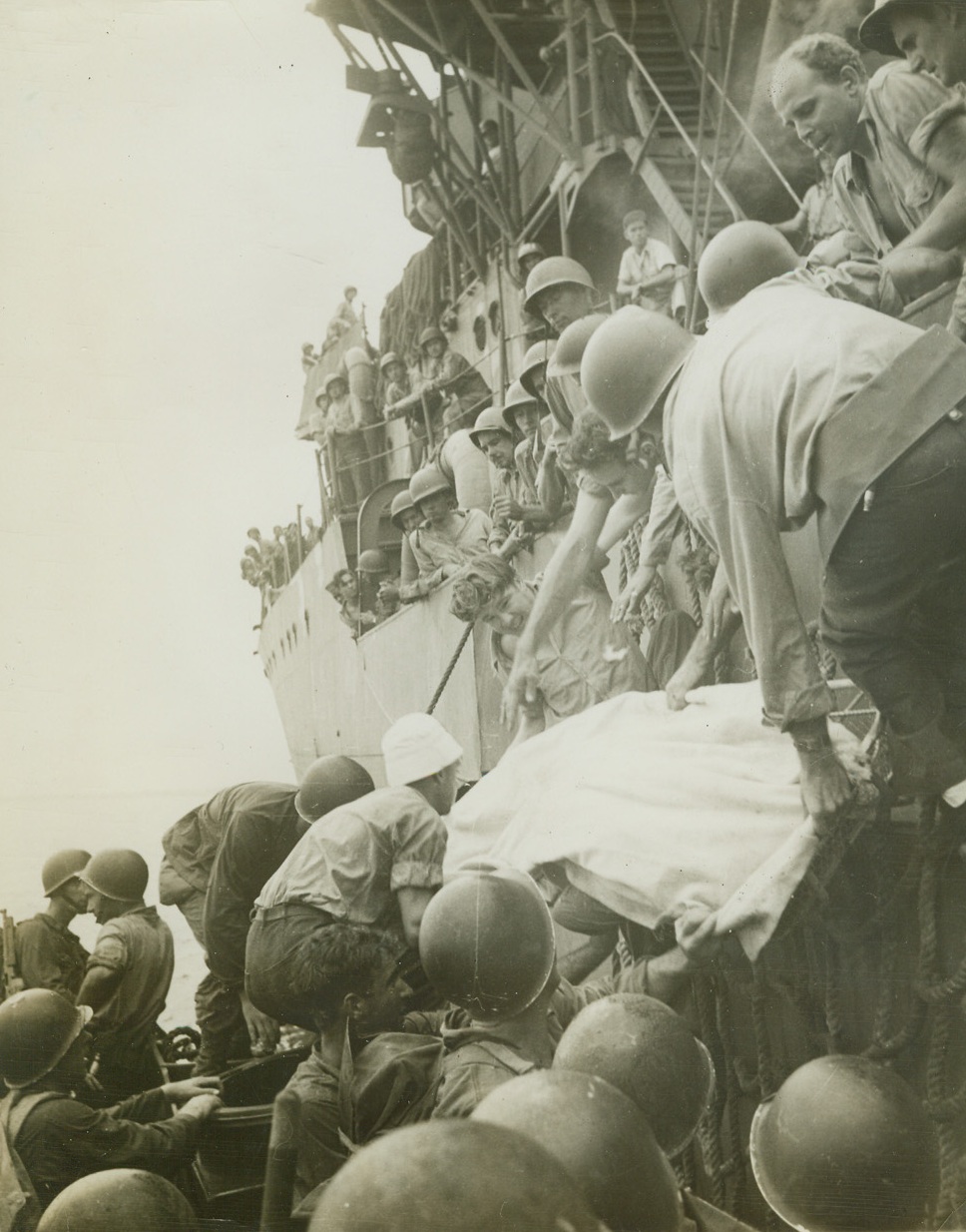
Los Negros Casualty Brought Aboard Destroyer, 3/14/1944. Los Negros Island, - Wounded in first moments of action after storming Los Negros island. This soldier is lifted aboard destroyer for medical aid. Photo by Frank Prist, Jr., ACME photographer for War Pool. Credit line ACME;
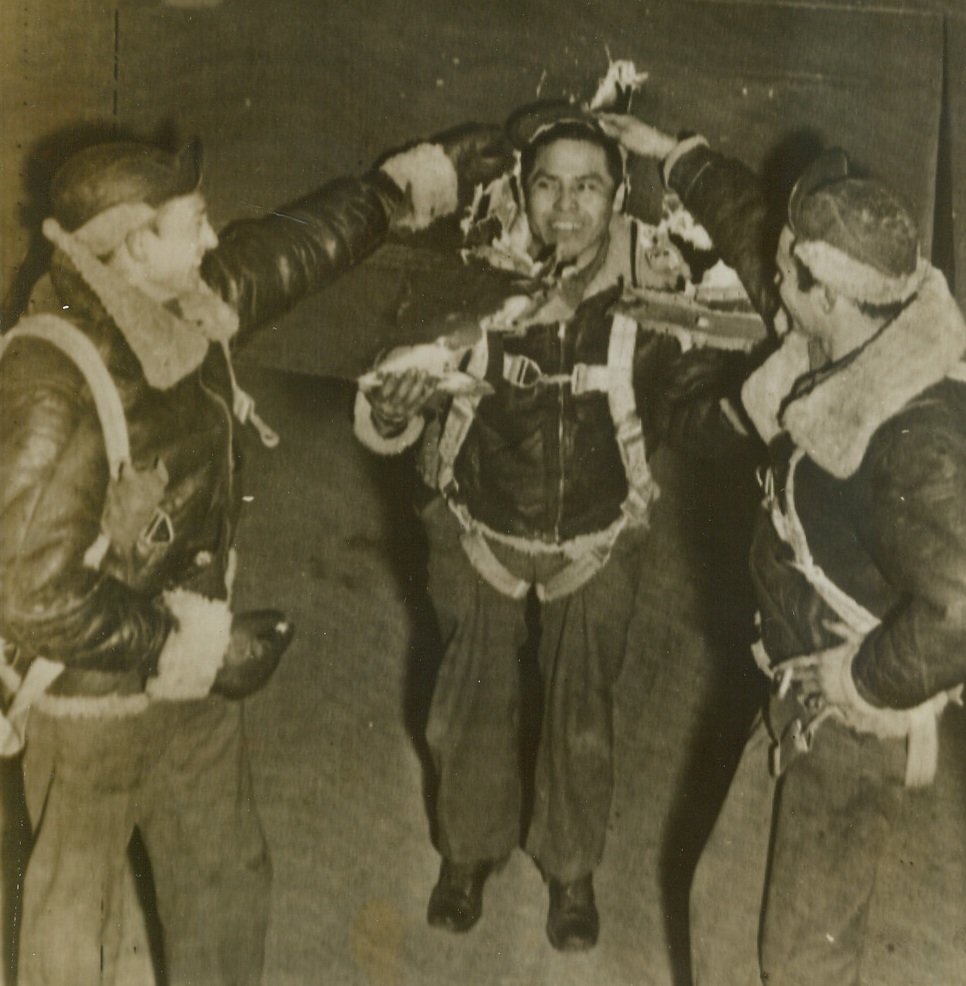
Lucky Indian, 3/10/1944.
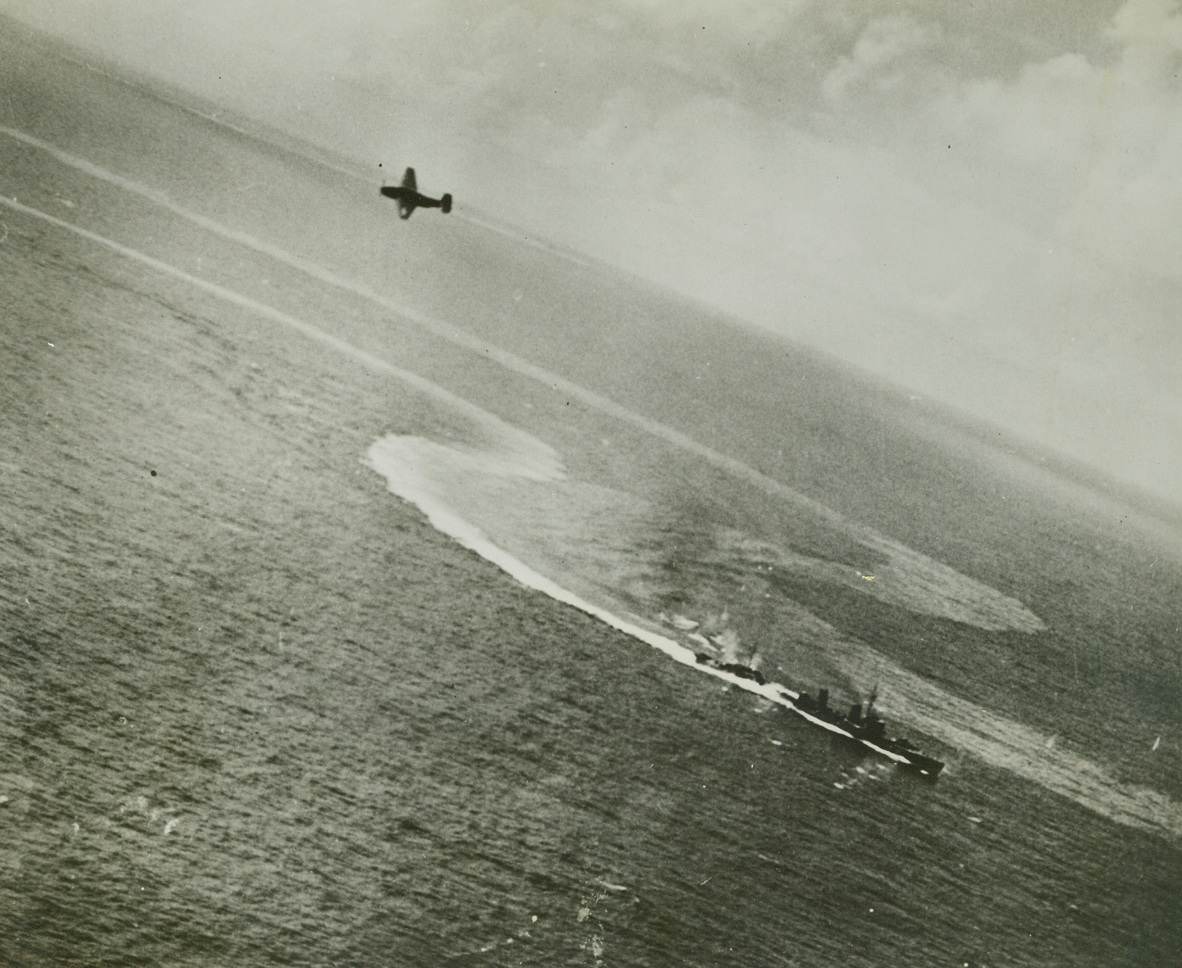
Headed For Disaster, 3/23/1944. Its after-section seemingly severed as a white comber roars over it scuppers, a damaged Japanese destroyer of the Asashio class vainly maneuvers in an attempt to escape the attack of a U.S. Navy Grumman Avenger (top, left), during the raid on Truk, last Feb. 16. A short time later, the Nip warship joined the growing number of her sister ships at the bottom of the Pacific. Credit line (U.S. Navy photo from ACME);
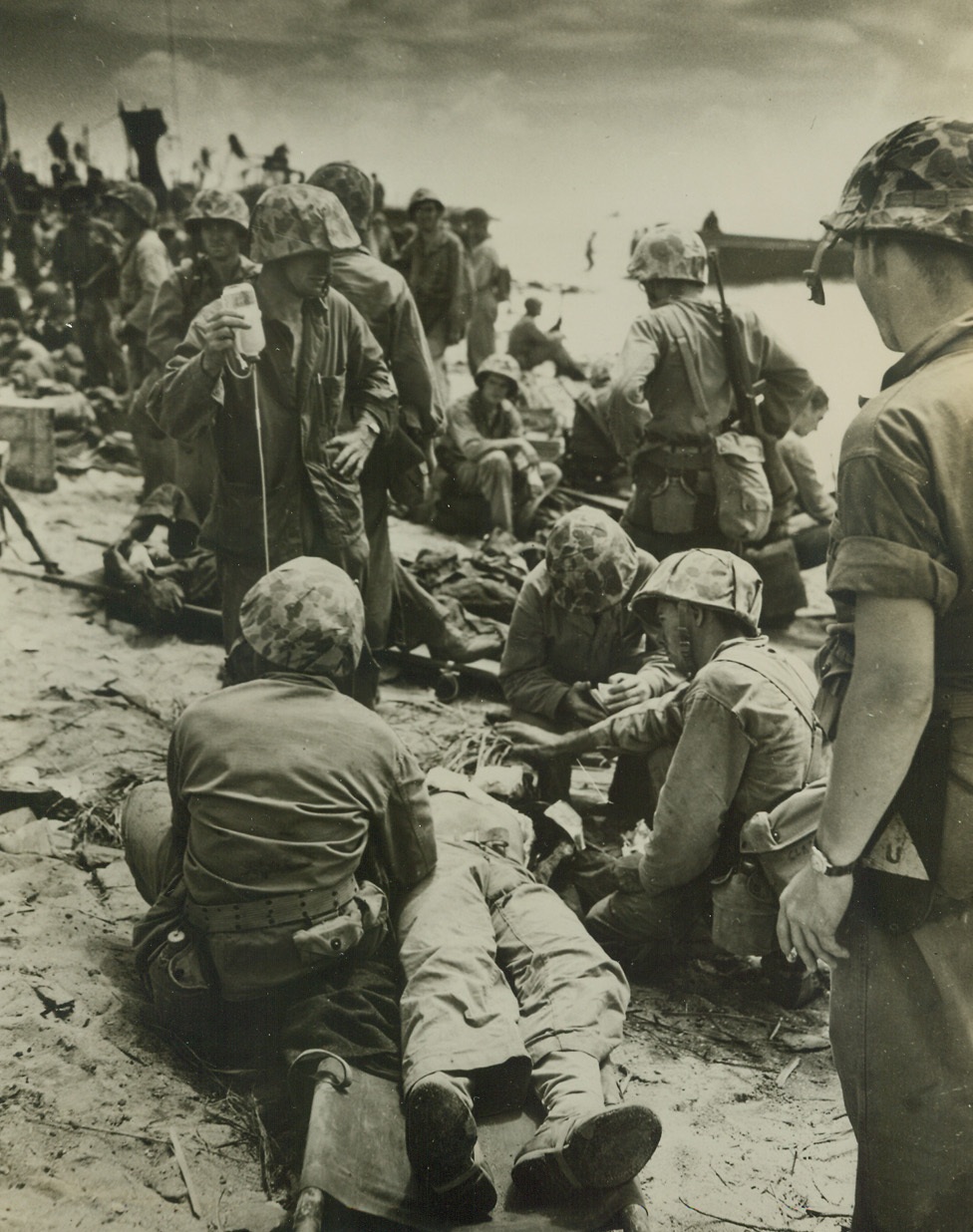
Blood Plasma Saves Eniwetok Hero, 3/23/1944. Eniwetok Atoll – American Marines give blood plasma to a wounded comrade after blasting their way ashore on Eniwetok Atoll. Somewhere, back home in the U.S., someone was responsible for saving this Marine’s life with their donation to the Red Cross blood bank. Credit line (U.S. Coast Guard photo from ACME);
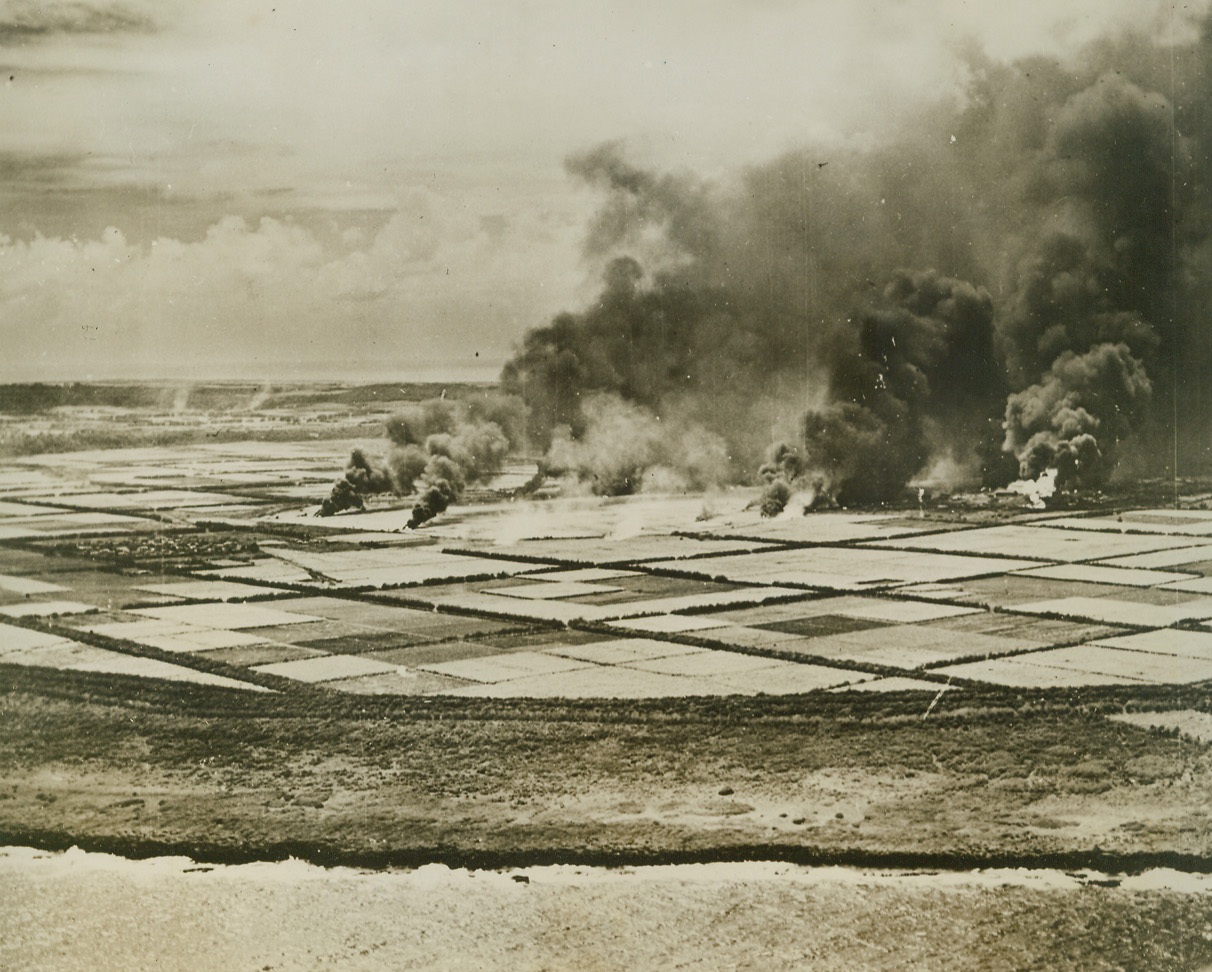
Tinian Island Airstrip Bombed, 3/6/1944. Tinian Island – Japanese planes burning on airstrip on Tinian island, Jap stronghold in the Mariannas, following attack by U.S. Navy carrier-based planes on Feb. 23rd. Sugar cane fields form a pattern around the airport.Credit line (U.S. Navy photo from ACME);
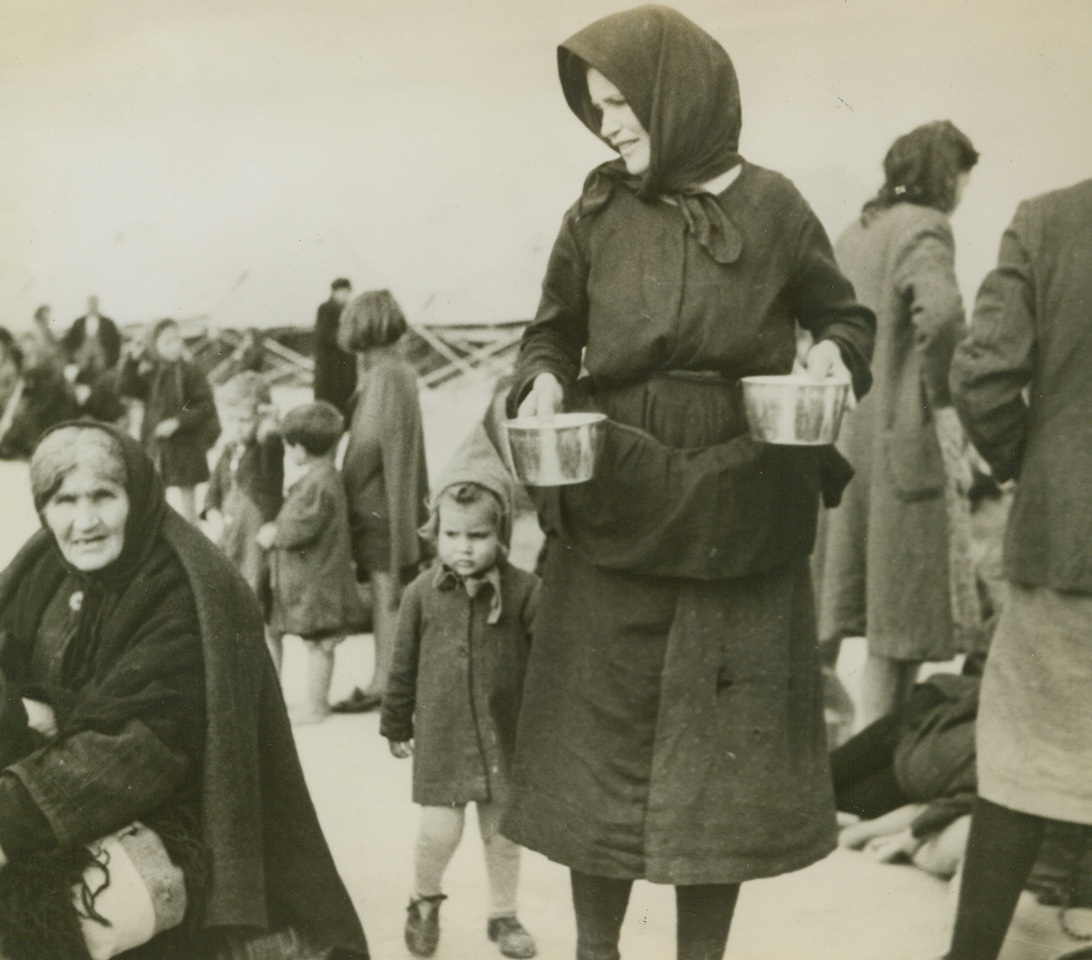
They Escaped From the Nazis, 3/11/1944. Middle East—Aided by underground units of Tito’s guerillas, a group of 25,000 Yugoslav partisan refugees escaped from islands and towns along the Adriatic coast, slipping from under the noses of the Nazis to the safety of an Allied desert camp in the Middle East. There they exchanged their ragged clothing for garments distributed by the American Red Cross and were fed and clothed by Allied Relief Agencies. This somberly clad woman carries two tin bowls of soup for herself and her little girl. This is an exclusive ACME photo.Credit: ACME.;
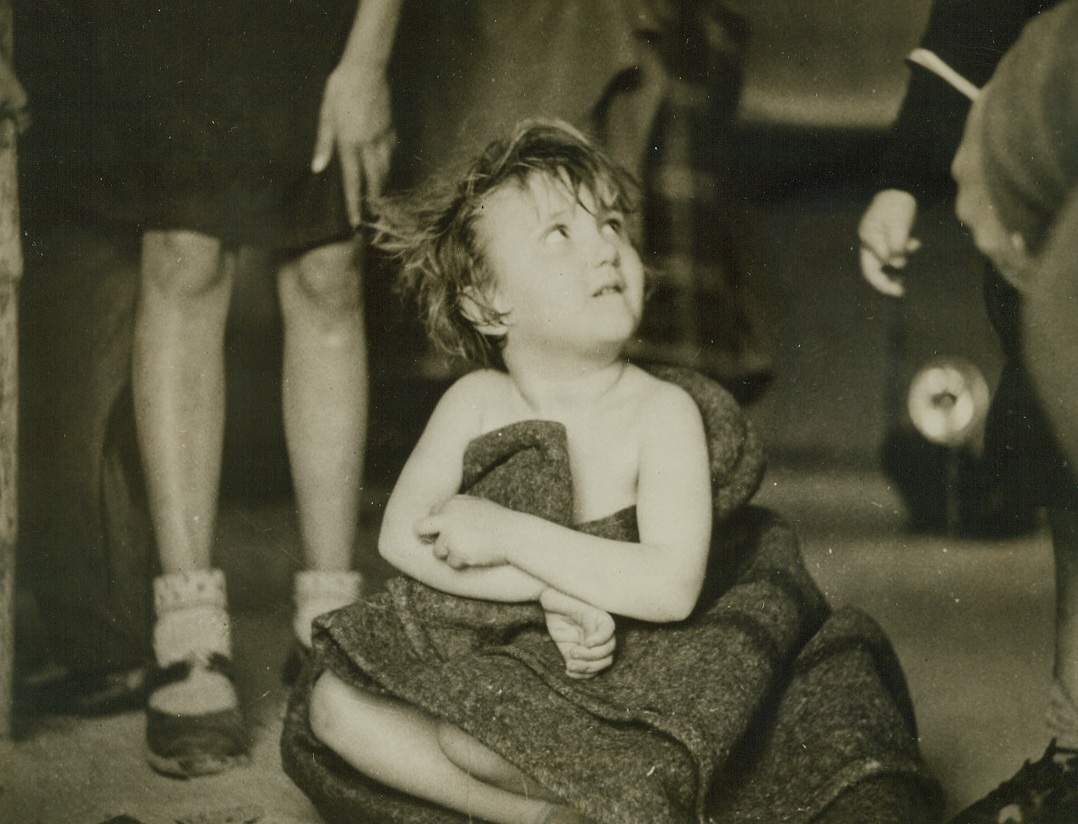
Hiding Her Shame, 3/11/1944. Middle East—Hugging a blanket to her nakedness, this embarrassed little Yugoslav refugee exchanged her rags for American Red Cross clothing when she arrived at a desert camp in the Middle East with a contingent of 25,000 Yugoslav partisan refugees. Aided in their escape from the Adriatic coast and islands by underground elements of Marshal Tito’s guerillas, women and children in the group were accompanied by only aged and disabled men. They will be resettled in the Middle East by British authorities. This is an exclusive ACME photo.Credit: ACME.;
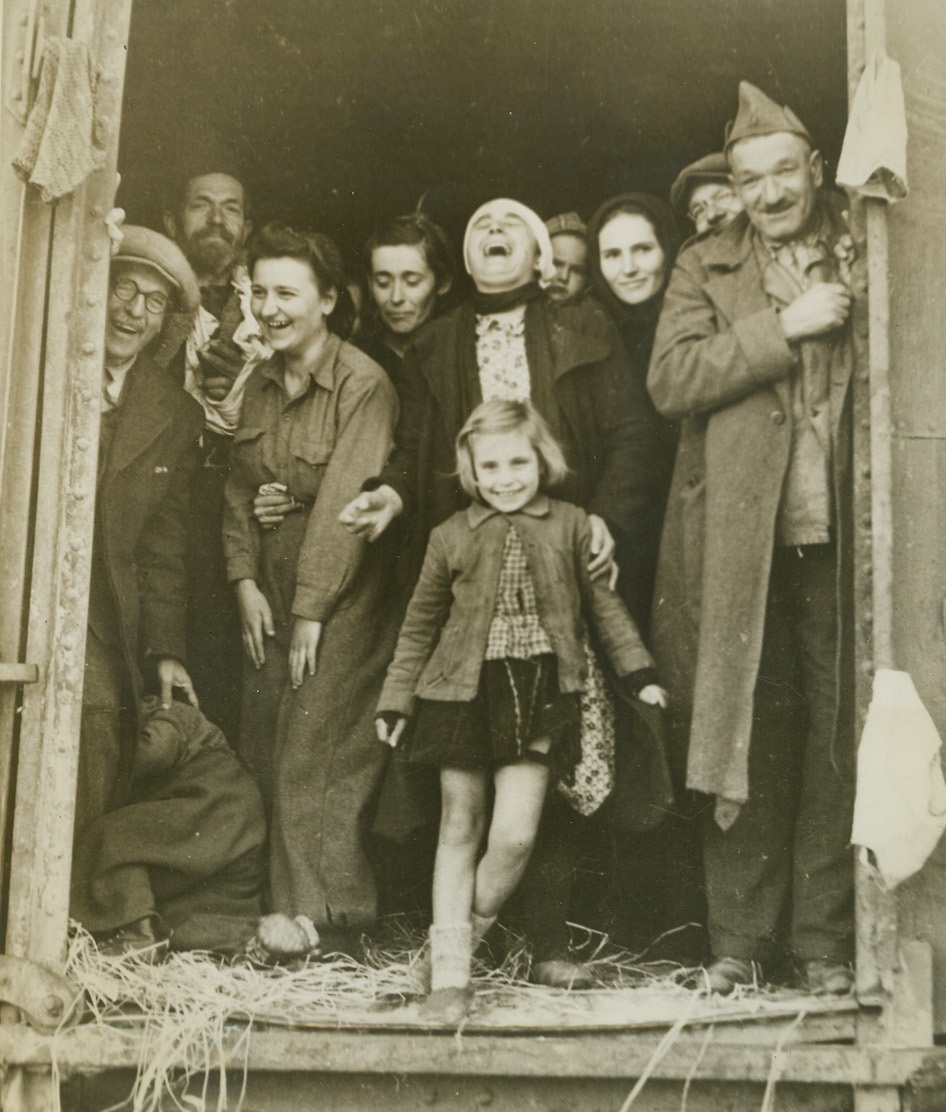
Safe At Last!, 3/11/1944. Middle East—Almost hysterical with joy as they arrive at their destination—a desert camp in the Middle East—these Yugoslav refugees laugh happily from the door of a box car. Aided in their escape from islands and towns along the Adriatic coast by underground elements of the Yugoslav guerillas, 25,000 of the refugees reached the camp safely. The group consisted mostly of women and children, accompanied by a few aged and disabled men. This is an exclusive ACME photo.;
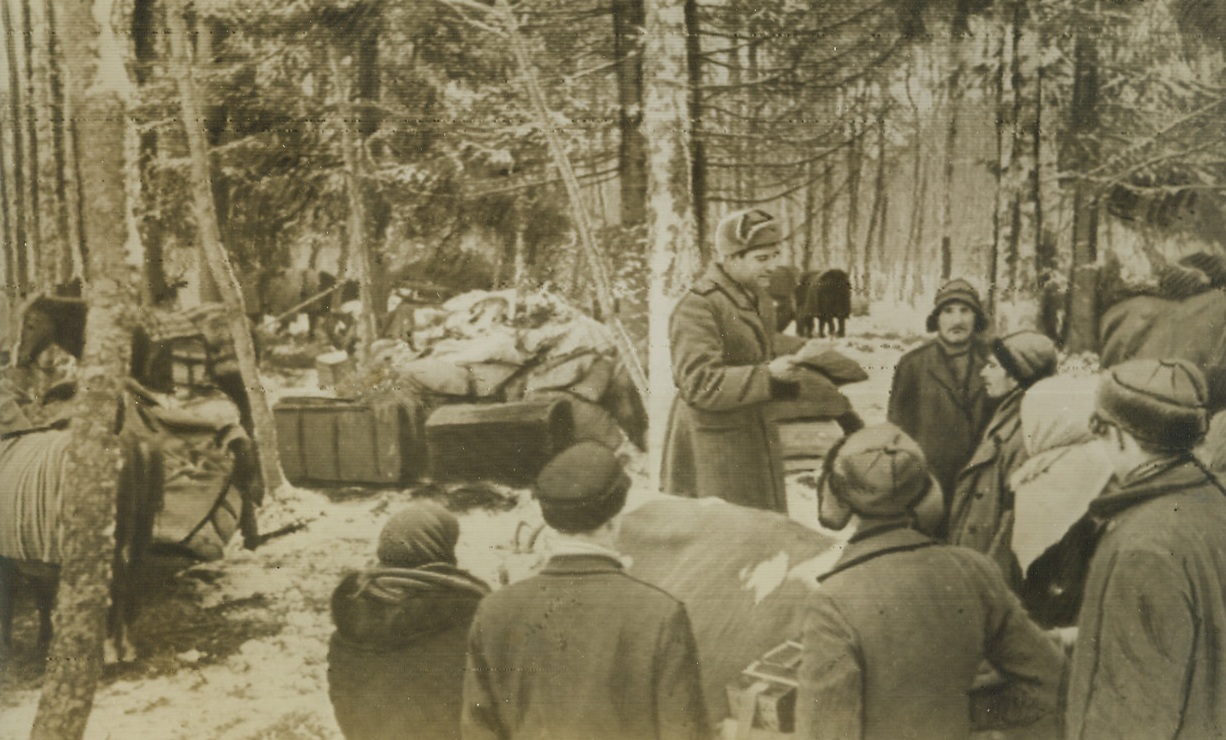
Advancing Reds Meet Forest Dwellers, 3/5/1944. Estonia—Estonians, who took to the wild forests of their country to hide from the Germans, gather around an officer of the Soviet forces now attacking southeast of Vitebsk, near Pskov and Narva. Fighting is fierce for Pskov, the Baltic gateway city almost on the borderline of Russia and Estonia, with the Germans trying to stem the Red Tide along an intricate network of “hedgehog” defenses. Credit: ACME radiophoto;
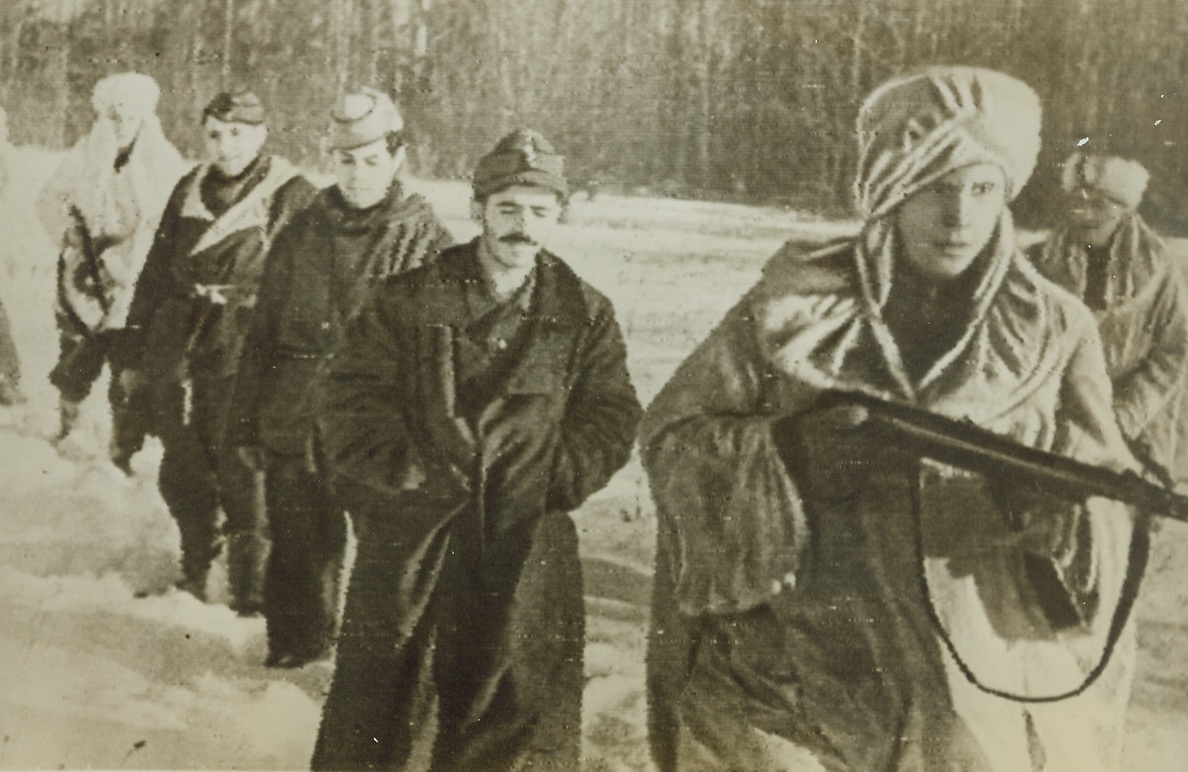
Red Army Takes Spanish Prisoners, 3/9/1944. On the Leningrad Front—White-robed Red Army fighters lead three of their newest prisoners of war back from the Soviet-Nazi fighting lines on the Leningrad front. The prisoners are Spanierds—probably members of Franco’s blue division which, this photo indicates, is still fighting with the Nazis on the Russian front. Credit: ACME radiophoto.;
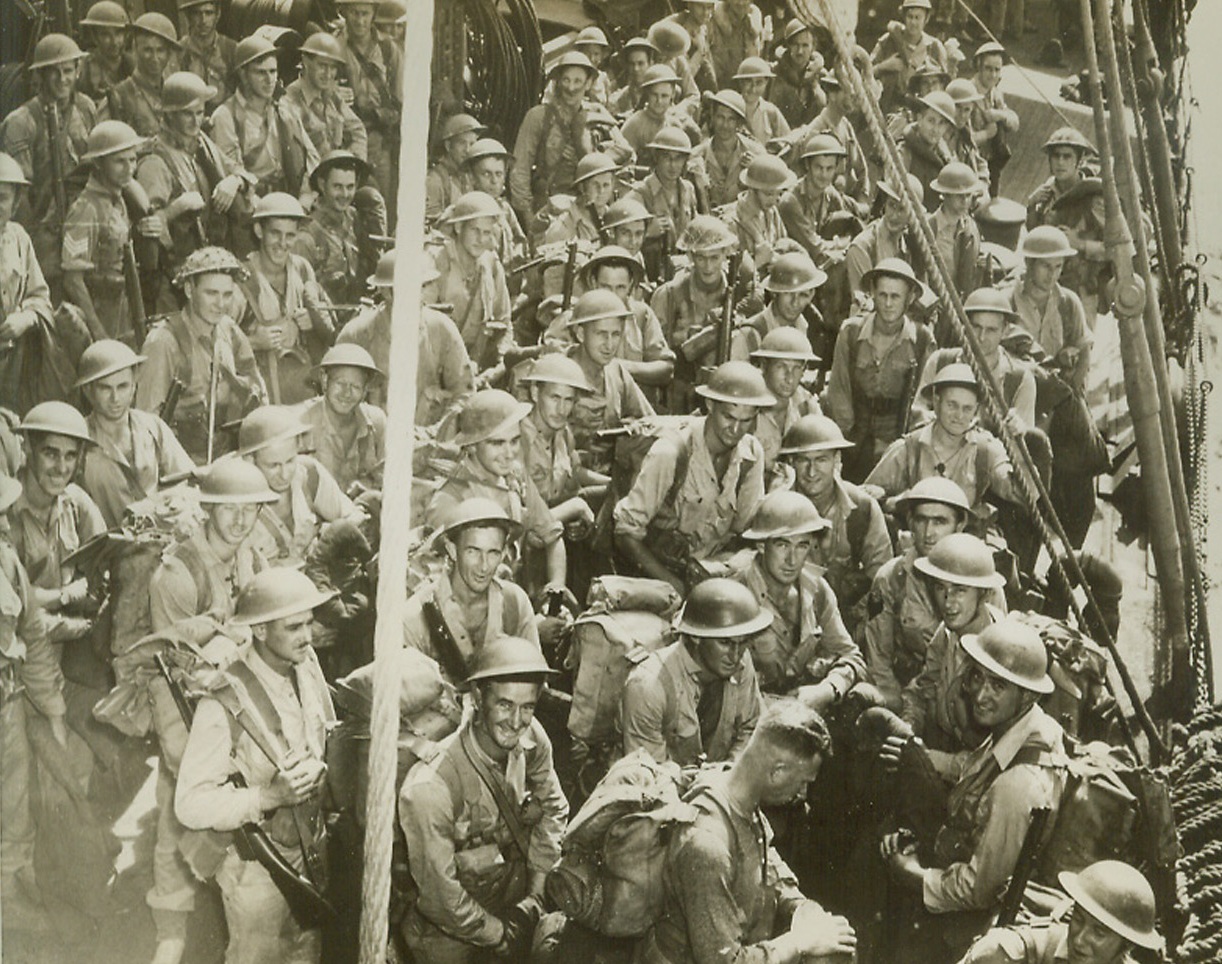
Ready to Go, 3/14/1944. Washington, D.C.: Troops of the British Empire, hardened veterans, stand on the deck of a U.S. Coast Guard-manned transport, waiting to go over the side in landing boats during invasion maneuvers. They will join the United Nations’ mounting attack power in the Pacific, in due time. Credit: U.S. Coast Guard photo from ACME.;
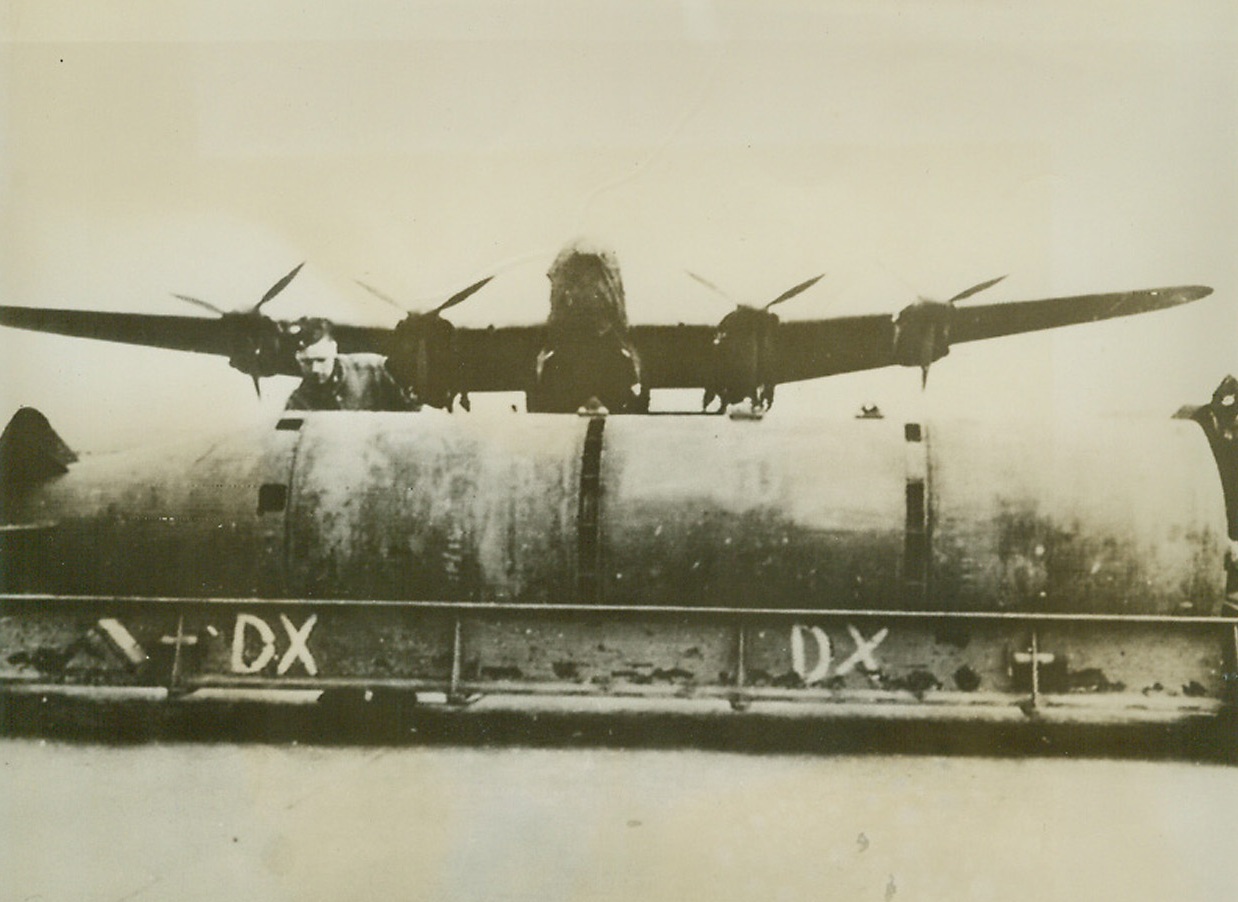
Britian’s Super Block-Buster, 3/13/1944. England—The first photo of the R.A.F.’s six-ton bomb shows the “super-super-block-buster” in front of a Lancaster bomber that carries it. The comparable size of the bomb and plane is distorted, since the six-tonner is closer to the camera than the bomber which has a 102-foot wing span. The gigantic missiles of destruction were used to blast a Nazi-directed plane engine plant at Albert, France, on the night of March 2, and a few of them leveled most of the Gnome-Rhone plane engine works in an earlier night raid.;
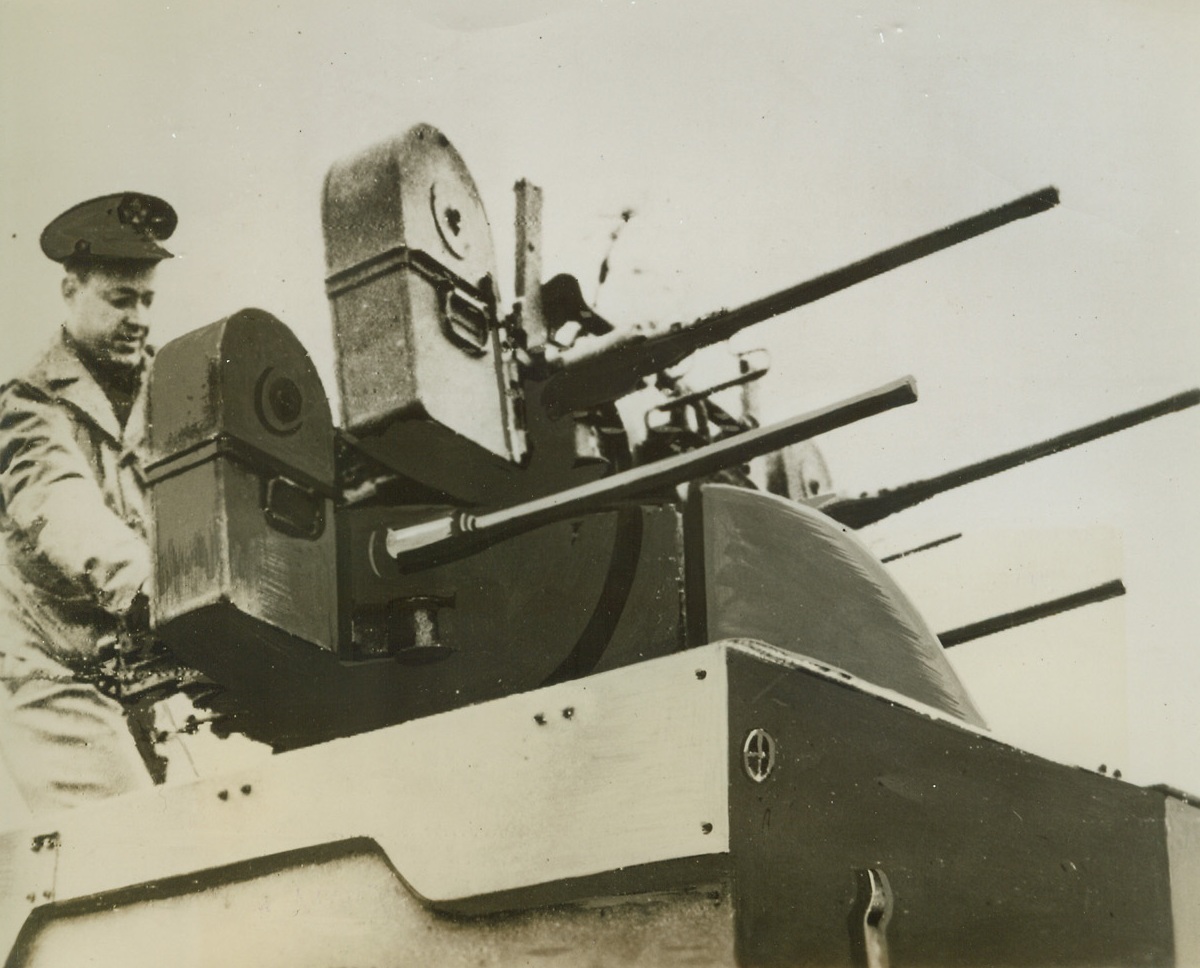
New “Wasp Wagon” Carries a Sting, 3/20/1944. An American soldiers fires the guns on one of the Army’s new mobile anti-aircraft weapon—a half-truck mounting four 50-calibre machine guns. The guns swing together to cover a wide arc of the sky, as well as along the ground. Credit: Official OWI radiophoto from ACME.;
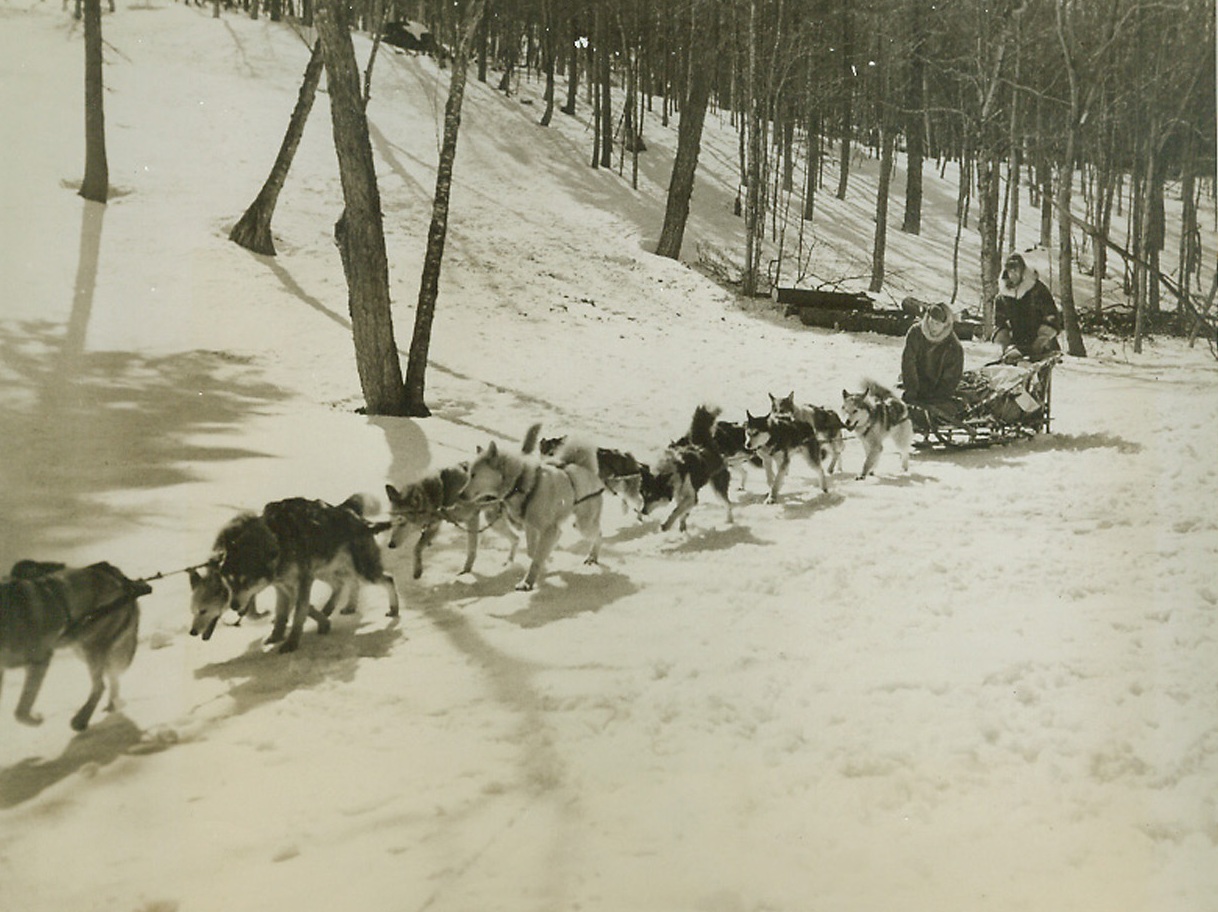
Rescuing Crashed Fliers in the North, 3/7/1944. Manchester, N.H.—To rescue pilots and crewmen of planes forced down in Artic or semi-Artic country, the search and rescue section of the North Atlantic wing of the Air Transport Command has been organized. Equipped and trained to cover difficult terrain in all kinds of weather, the base camps of the section are always ready to answer calls for assistance. This series of photos taken at a search and rescue section base camp at Manchester shows how a crashed flier is rescued. While this was not an actual case of answering a distress call, the instance was carefully staged to follow the procedure of a typical rescue. Using a dog team and a sled, a rescue team starts out to locate and rescue the flier who has been forced down. Credit: ACME.;
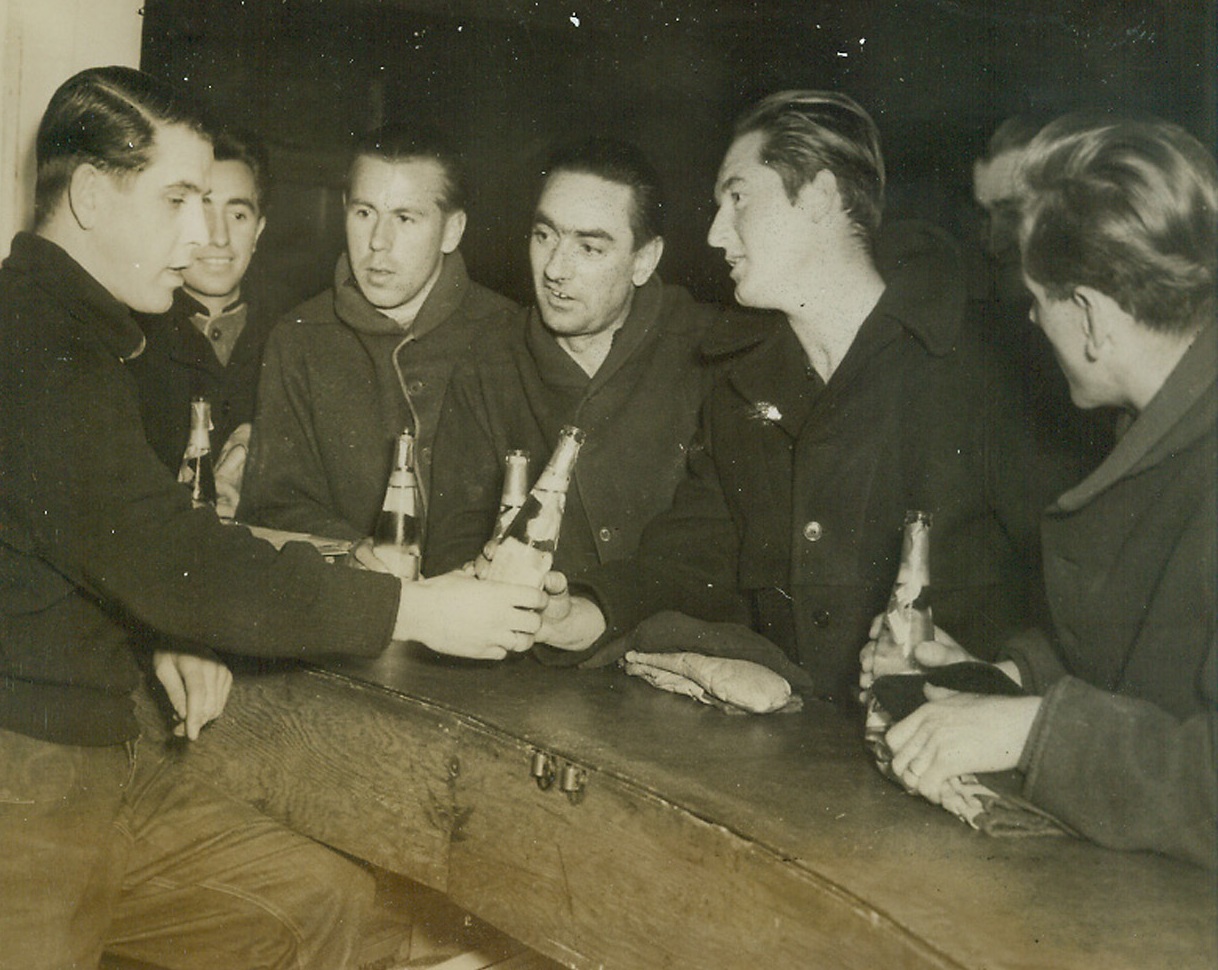
Nazis Help Out in North Woods, 3/12/1944. Camp Evelyn, Mich.—Several hundred German prisoners from Rommel’s Afrika Korps have been brought to two former CCC camps in northern Michigan near Evelyn and Sadinaw where they will learn the use of the double-bitted Michigan ax and the two-man saw with which they will cut pulp and chemical wood in this critical manpower shortage area. Geneva conference provisions forbid prisoner of war participation in hazardous work, so these men will engage in less dangerous, but still necessary operations. Photo #2: German war prisoners drink 3.2 beer in the canteen of Camp Evelyn, Mich. where they can also buy cigarettes, candy, and soft drinks with the 80 cent canteen script they earn daily in the woods. (U.S. Army Photo). Credit: ACME.;
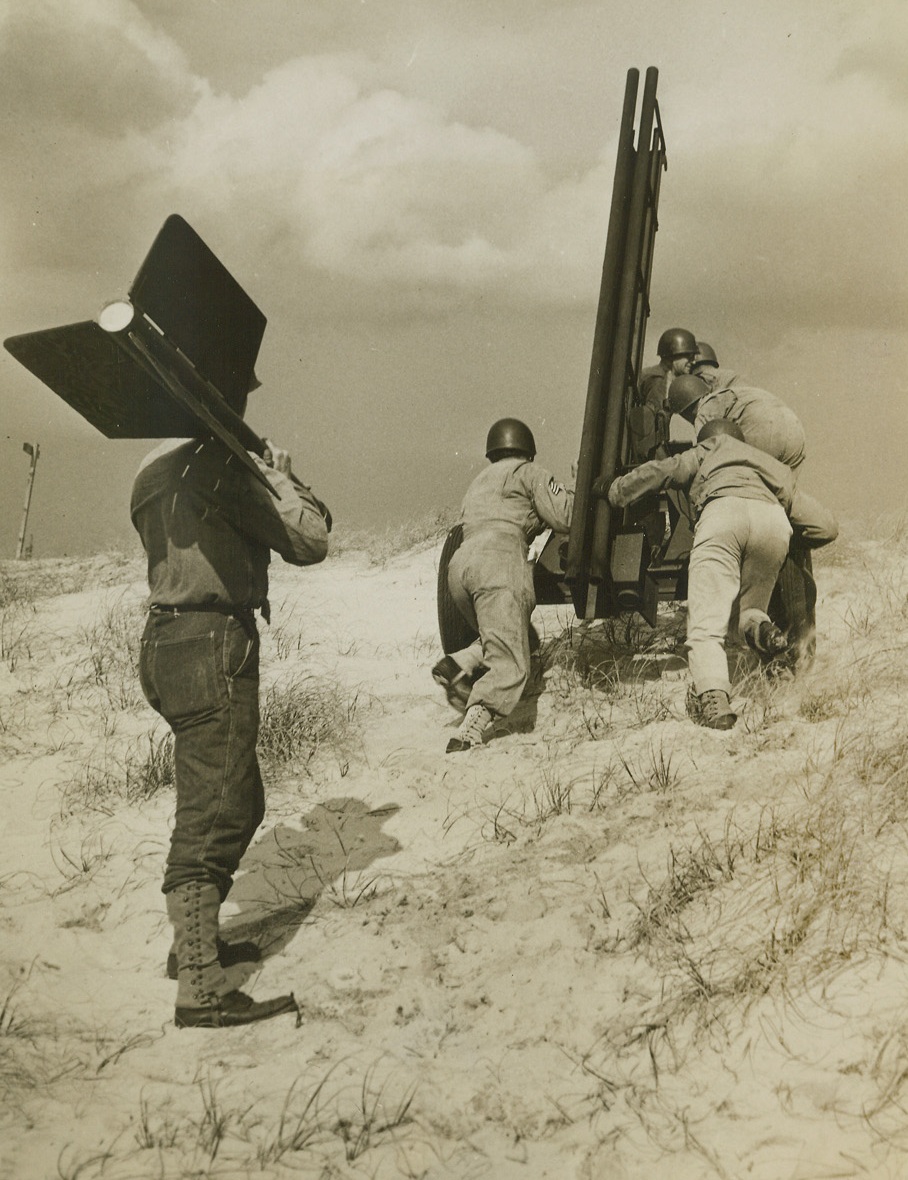
Rocket Targets for Ack-Ack Traininga, 3/8/1944. Camp Davis, N.C.—Jet-propelled rocket targets are now being used to train anti-aircraft artillerymen at Camp Davis, giving our gunners practical experience at firing at “enemy planes” diving at terrific speed, and preparing them for action against the jet-propelled planes of tomorrow, should the enemy perfect such planes before the war is over. Fired from specially designed carriages, the rockets have an initial velocity of 450 miles per hour or 675 feet per second. They are released from the range at Holly Shelter, a Camp Davis firing point. Manning 50 caliber machine guns and 20 and 40 mm weapons, the trainees improve their aim and accuracy as they track the fast-moving, 59-inch targets. The rocket always describes an approximate parabola and has a maximum horizontal range of about 2200 yards. The following photos show phases of rocket target practice by night and by day.New York BureauWhile other members of the rocket-launching crew push the specially designed carriage into place at Holly Shelter, another crewman carries the heavy, triple-finned rocket on his shoulder. The rockets are painted white, when fired at night, to increase visibility.Credit: ACME.;
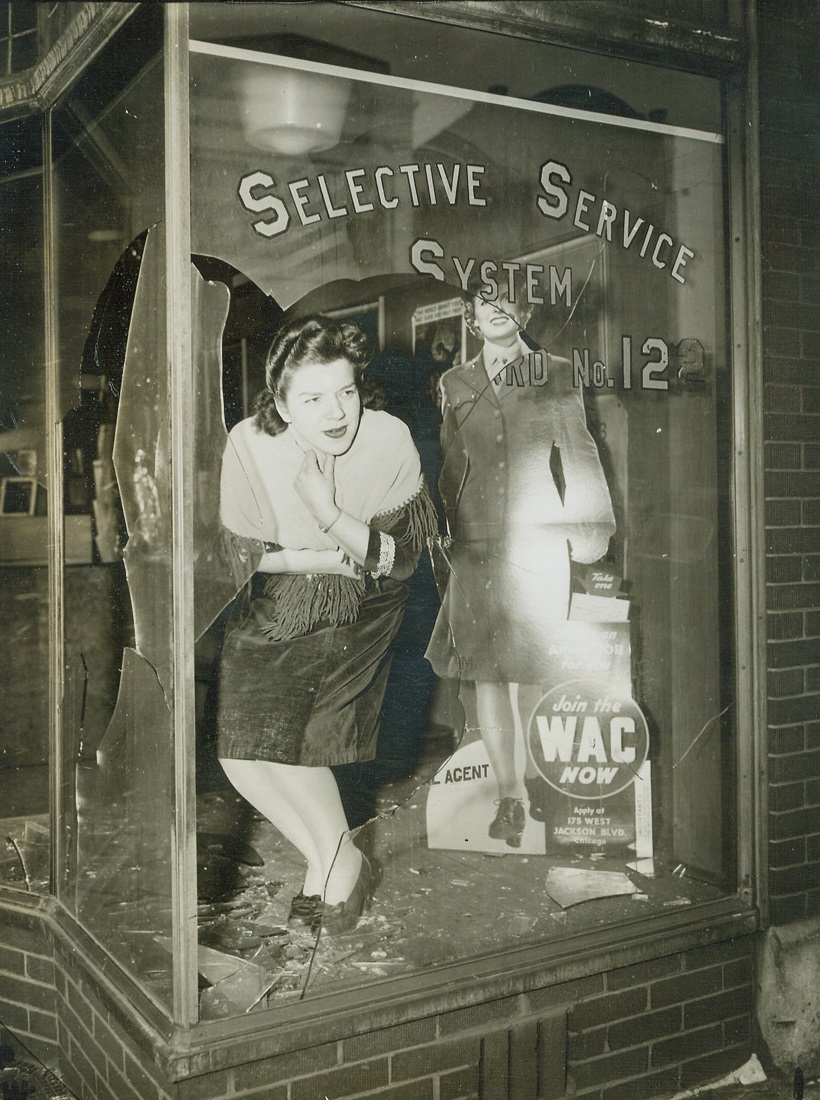
Draft Office Smashed, 3/8/1944.Chicago – Six huge plate glass windows and a glass door of the office of Selective Service Board No. 122 in Chicago were smashed by an early morning marauder whom neighbors reported drove a plant through the glass. Officials blamed this, the second attack, on “discontented people who don’t want to go into service or see their friends go.” Here, Theresa Munari, a draft board clerk, inspects the damage. Credit: ACME;
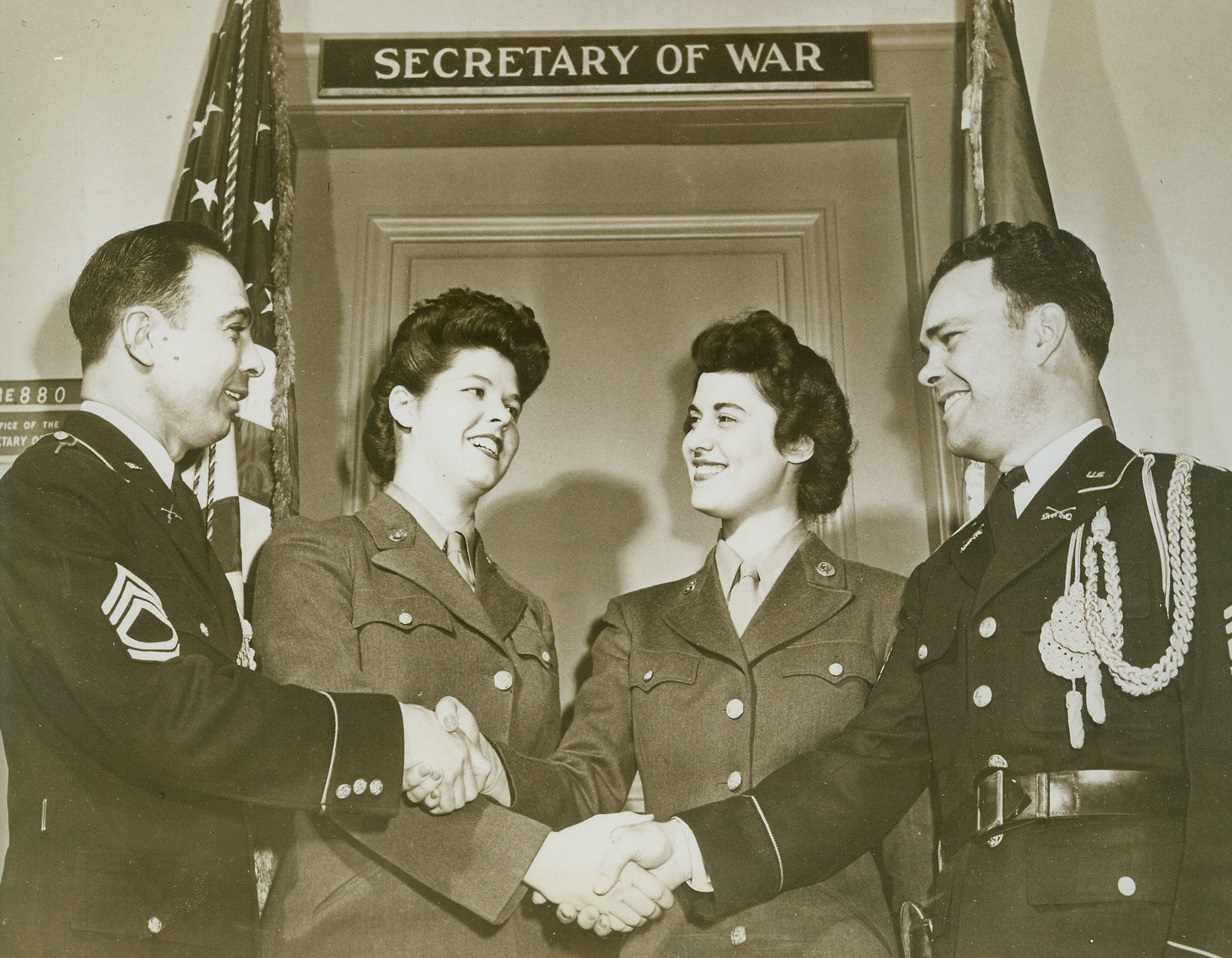
New Aides to Secretary of War, 3/28/1944. Washington, D.C.-The War Department announced that WACs have replaced men as enlisted aides to the Secretary of War at his office in the Pentagon building here. Photo shows, left to right, as new aides in front of Secretary’s office, come to take over: Sgt. Michael Altier, of Easton, Pa.; Pvt. Betty R. Cameron, of Ft. Collins, Colo.; Pvt. Marie H. Santoli, of Brooklyn, NY; and Sgt. Cecil Combs, of Portland, Ore. Credit: ACME.;
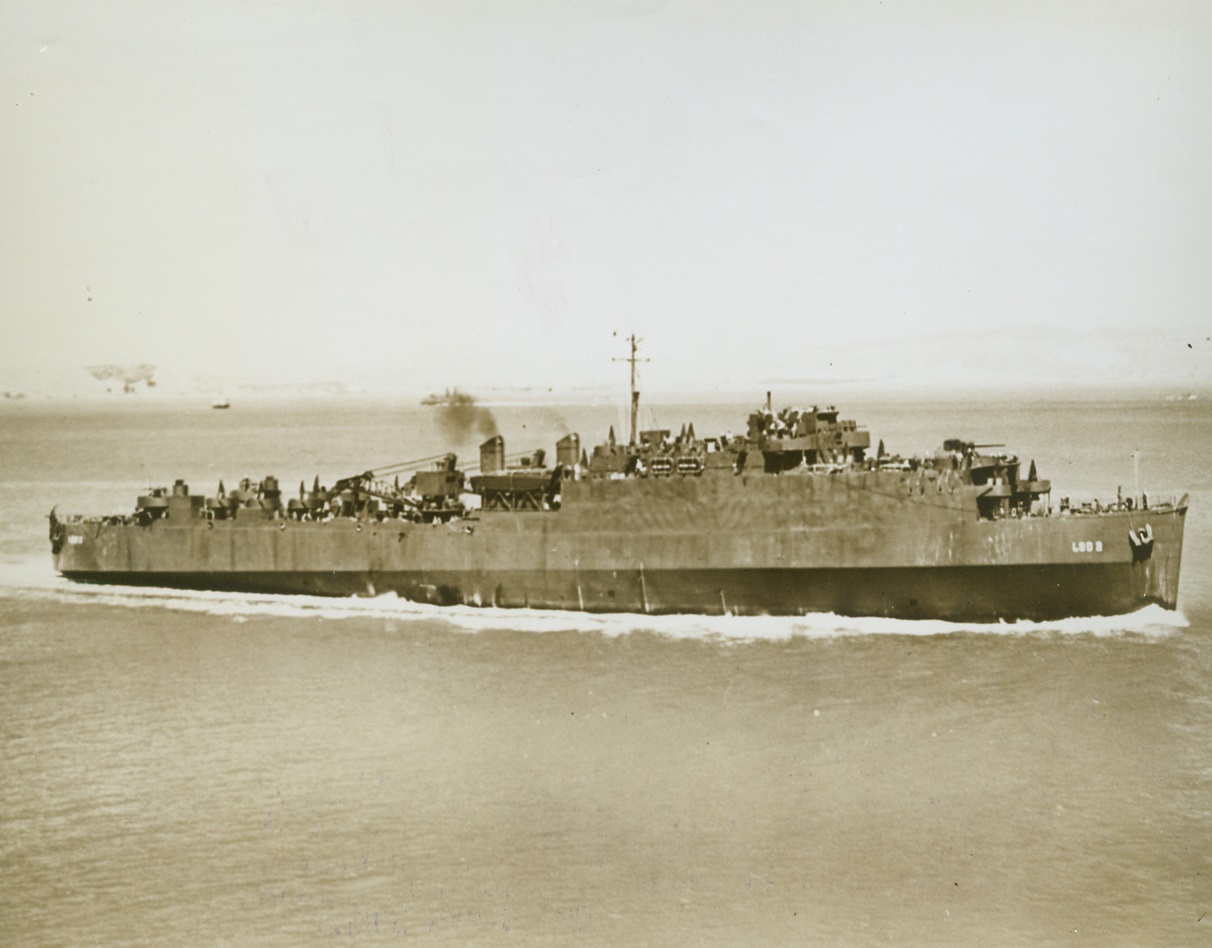
Uncle Sam’s LSD, 3/28/1944. Here is one of the larger vessels in the American Navy’s fast-growing amphibious fleet. An ocean-going craft, it is an LSD (Landing ship, dock), scheduled to play an important role in Uncle Sam’s future invasions. Credit: Official U.S. Navy photo from ACME.;
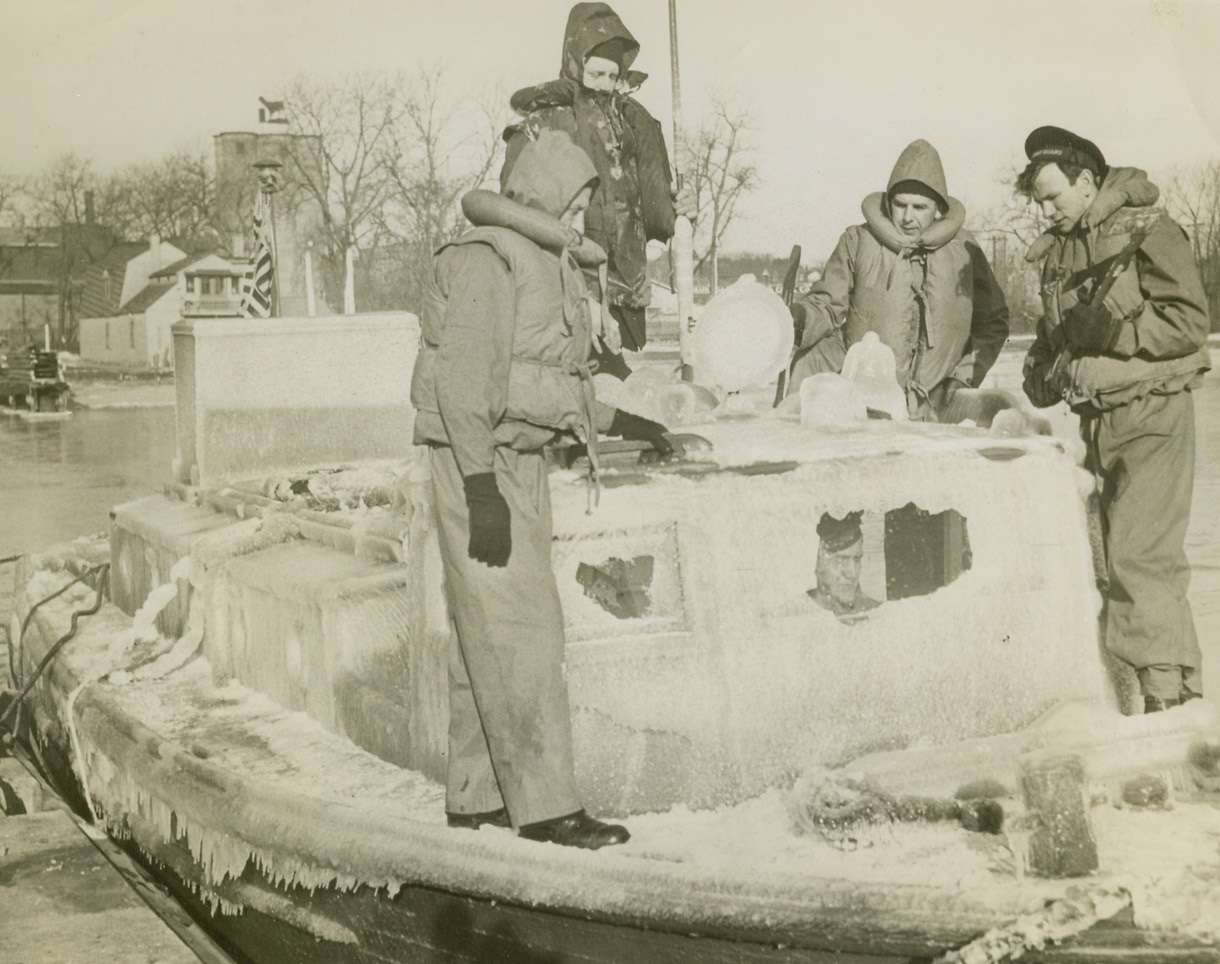
Hoax Sends Out Lake Patrols, 3/9/1944. Waukegan, Ill.—Authorities are searching for the person calling himself “Col. Jones of the Civil Aeronautics Patrol” whose telephone call reporting a tanker in distress off Waukegan sent 14 Coast Guard boats from the Lake Michigan stations into freezing weather and a rough sea. CAP has no such person on its lists and no sinking tanker was discovered. Crew of this ice-covered picket boat which returned to its Waukegan base includes: Noble Baker, Birmingham, Ala.; (left) L.F. Baker, Tekemah, Neb.; Anthony Enos, Waukegan, Ill.; and Clarence A. Breska, Milwaukee. Credit: ACME.;
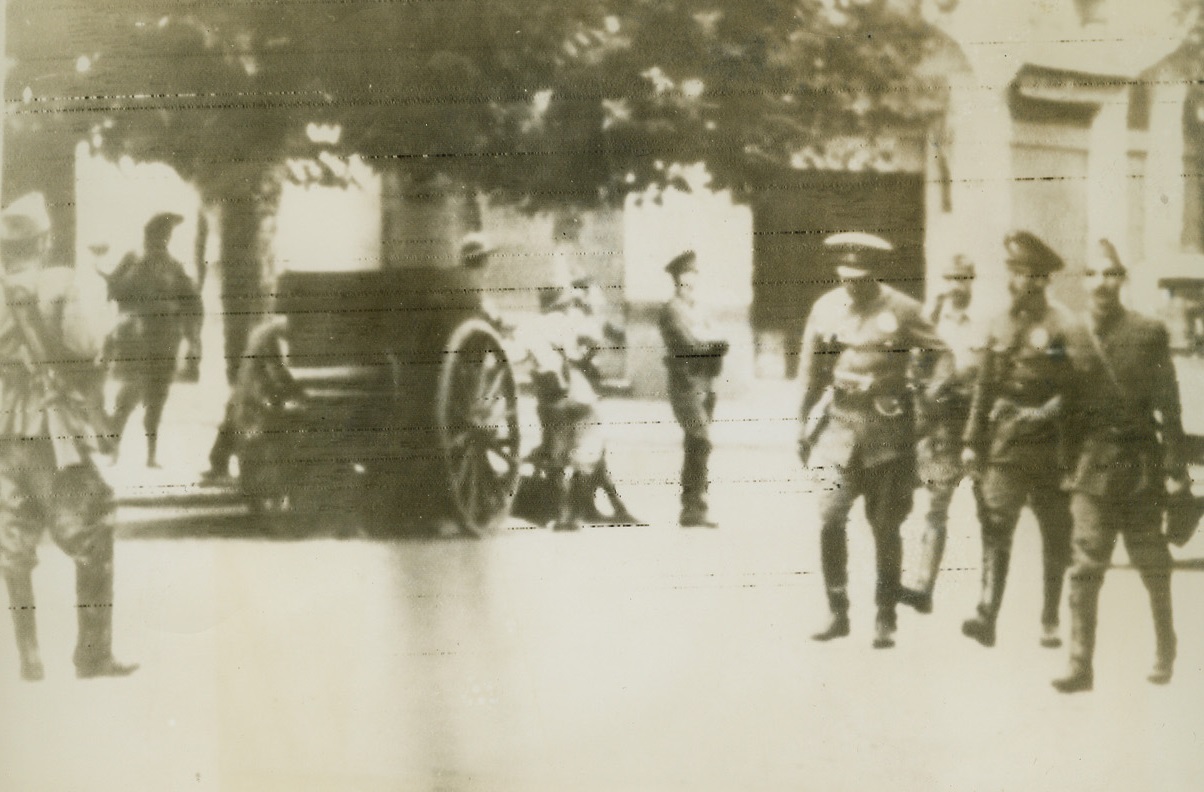
Soldiers in the Streets, 3/3/1944. Buenos Aires—There were soldiers in the streets of Buenos Aires again last week as Argentina’s nationalist military clique, which had opposed breaking of relations between Argentina and the Axis, staged a bloodless Coup D’Etat. Here, on Lomas de Zamora Street in a suburb of Buenos Aires, soldiers guard a field piece, keeping it ready for action. Credit: ACME radiophoto.;
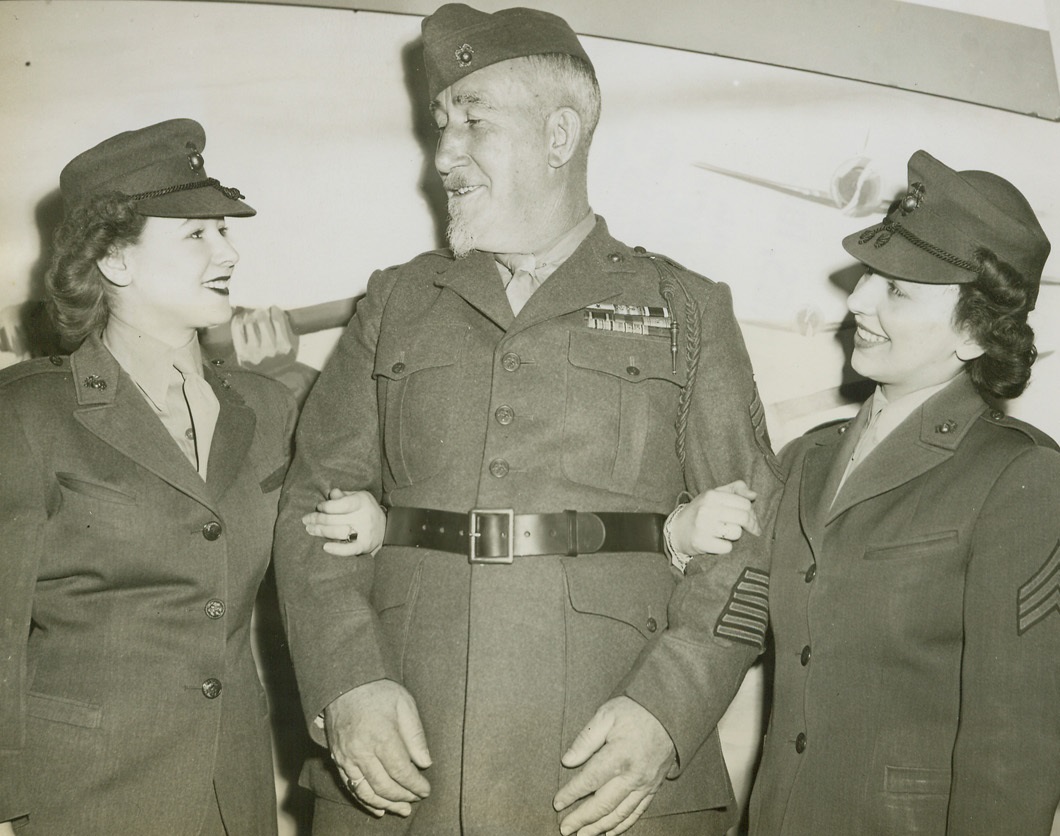
Marine Hero Returns, 3/29/1944. Chicago -- Veteran Marine gunner Sgt. Lou Diamond has proved the enemy can’t distract him, but it’s a different story when he meets pretty lady leathernecks Sgt. Betty Fitzgerald (left) and Sgt. Lorraine Ptacek while visiting Chicago. Sgt. Diamond earned his place among Marine legendary characters when he lobbed a shell down the chimney of an abandoned farmhouse during World War I. In World War II, he won a citation for accurate mortar fire after landing with the first waves at Guadalcanal and Tulagi. Only when a minor ailment sent him to the hospital did an amazed doctor discover he was 53 years old. Now Diamond is en route to Parris Island, South Carolina, to be an artillery instructor. Credit: ACME;
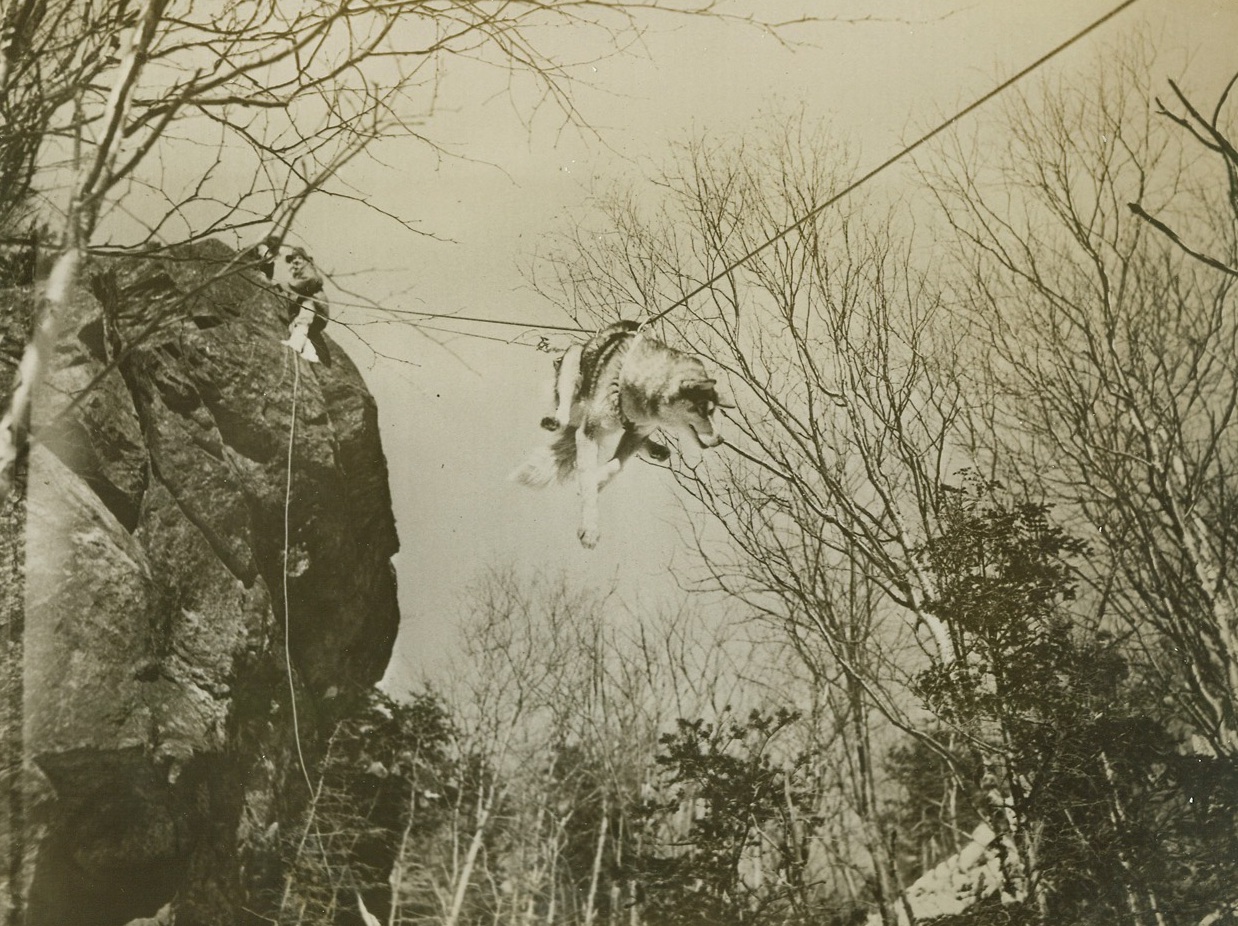
Rescuing Crashed Fliers in the North, 3/7/1944. Manchester, New Hampshire -- To rescue pilots and crewmen of planes forced down in arctic or semi-arctic country, the Search and Rescue section of the North Atlantic Wing of the Air Transport Command has been organized. Equipped and trained to cover difficult terrain in all kinds of weather, the base camps of the section are always ready to answer call for assistance. This series of photos taken at a Search and Rescue section base camp at Manchester shows how a crashed flier is rescued. While this was not an actual case of answering a distress call, the instance was carefully staged to follow the procedure of a typical rescue. New York Bureau Now the Siberian Husky dogs are sent down the rope to lower ground. When dogs, sled and “injured” man have been lowered, the party (now augmented by a second rescue party brought to the scene by a portable radio), sets off for the base. Credit: ACM;
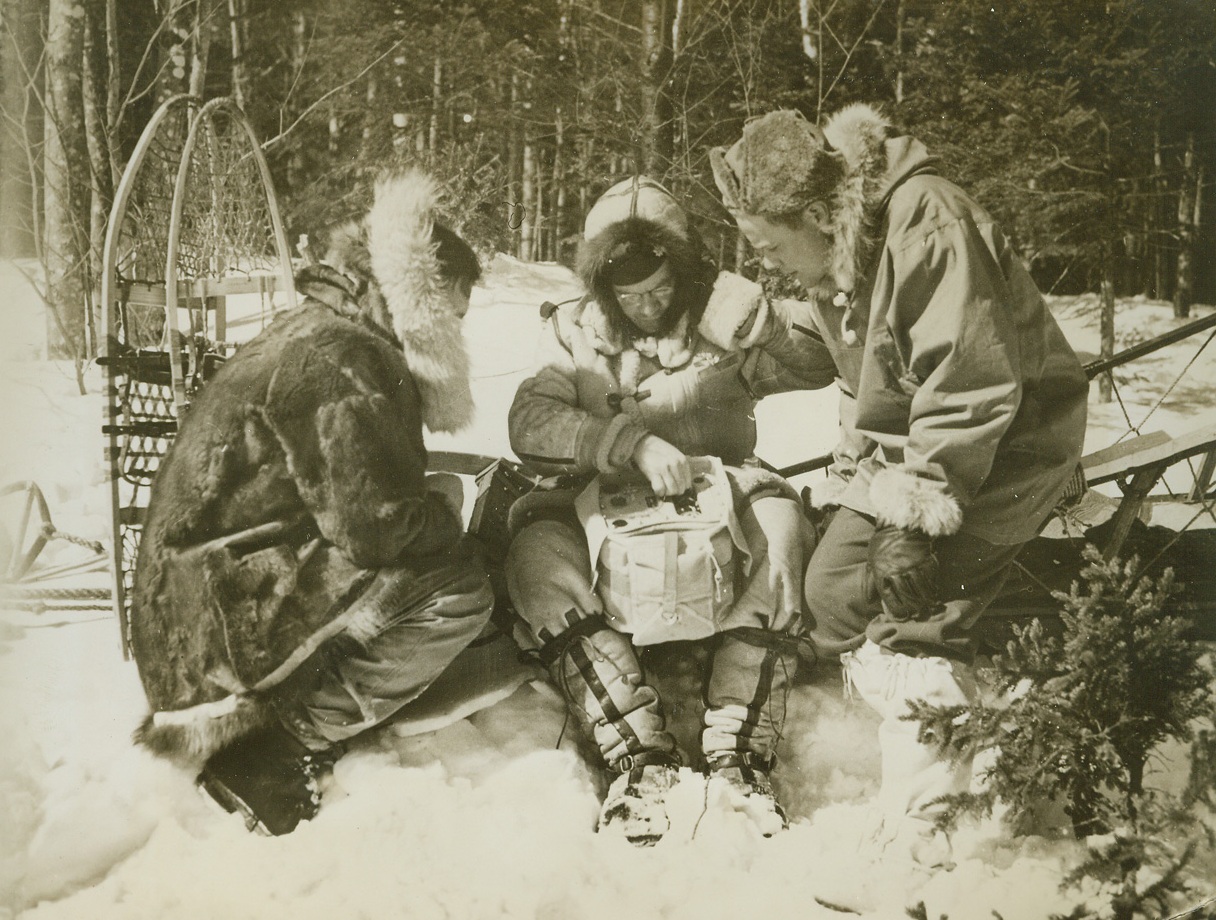
Rescuing Crashed Fliers in the North, 3/7/1944. Manchester, New Hampshire -- To rescue pilots and crewmen of planes forced down in arctic or semi-arctic country, the Search and Rescue section of the North Atlantic Wing of the Air Transport Command has been organized. Equipped and trained to cover difficult terrain in all kinds of weather, the base camps of the section are always ready to answer call for assistance. This series of photos taken at a Search and Rescue section base camp at Manchester shows how a crashed flier is rescued. While this was not an actual case of answering a distress call, the instance was carefully staged to follow the procedure of a typical rescue. New York Bureau Now the Siberian Husky dogs are sent down the rope to lower ground. When dogs, sled and “injured” man have been lowered, the party (now augmented by a second rescue party brought to the scene by a portable radio), sets off for the base.;
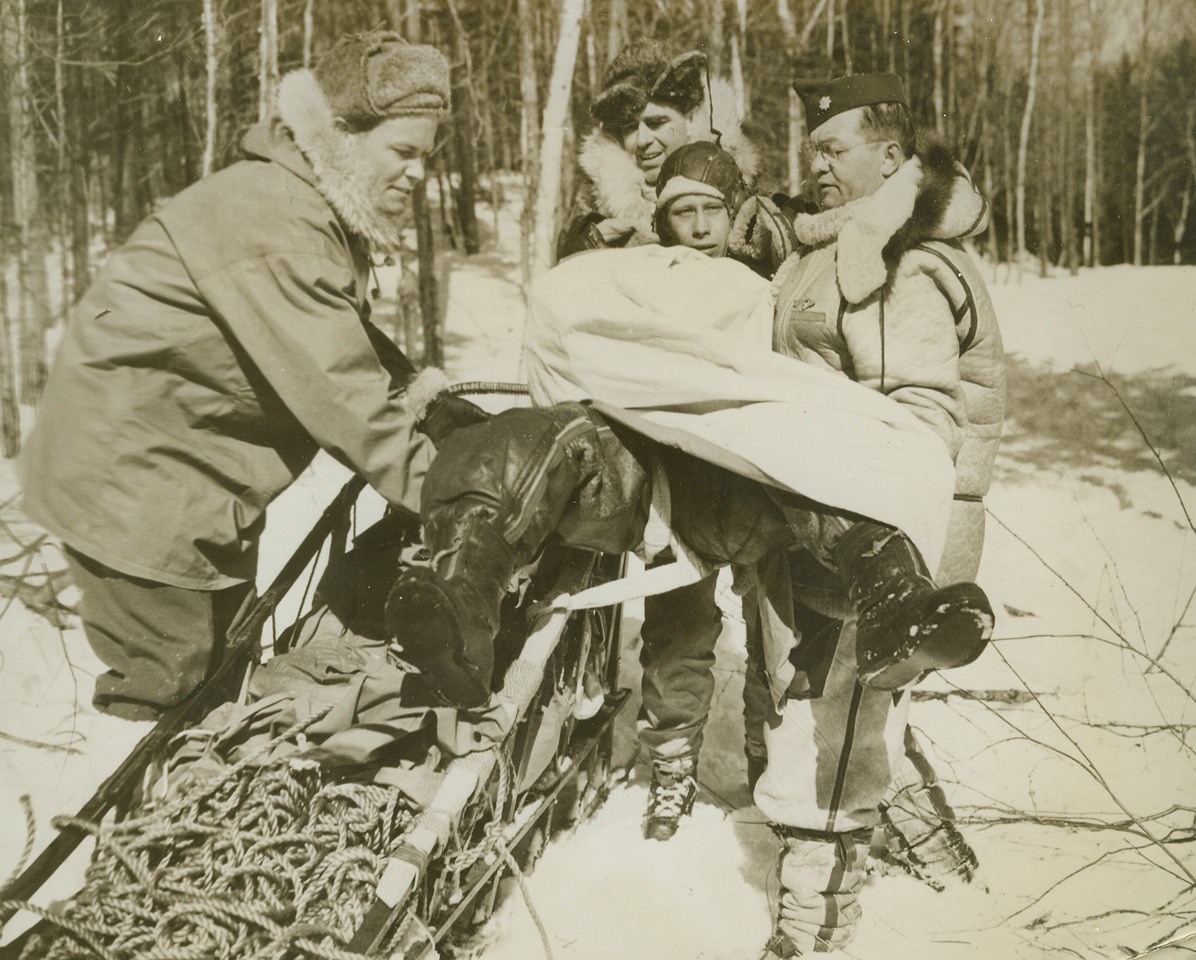
Rescuing Crashed Fliers in the North, 3/7/1944. Manchester, New Hampshire -- To rescue pilots and crewmen of planes forced down in arctic or semi-arctic country, the Search and Rescue section of the North Atlantic Wing of the Air Transport Command has been organized. Equipped and trained to cover difficult terrain in all kinds of weather, the base camps of the section are always ready to answer call for assistance. This series of photos taken at a Search and Rescue section base camp at Manchester shows how a crashed flier is rescued. While this was not an actual case of answering a distress call, the instance was carefully staged to follow the procedure of a typical rescue. New York Bureau After the “injured” pilot has received first aid, he is placed on the sled for the trip back to the base. Left to right, Sgt. Charles Clifton, Maj. Norman D. Vaughan, and Maj. Daniel Maunz. The man playing the role of the injured pilot was not identified. Credit: ACM;
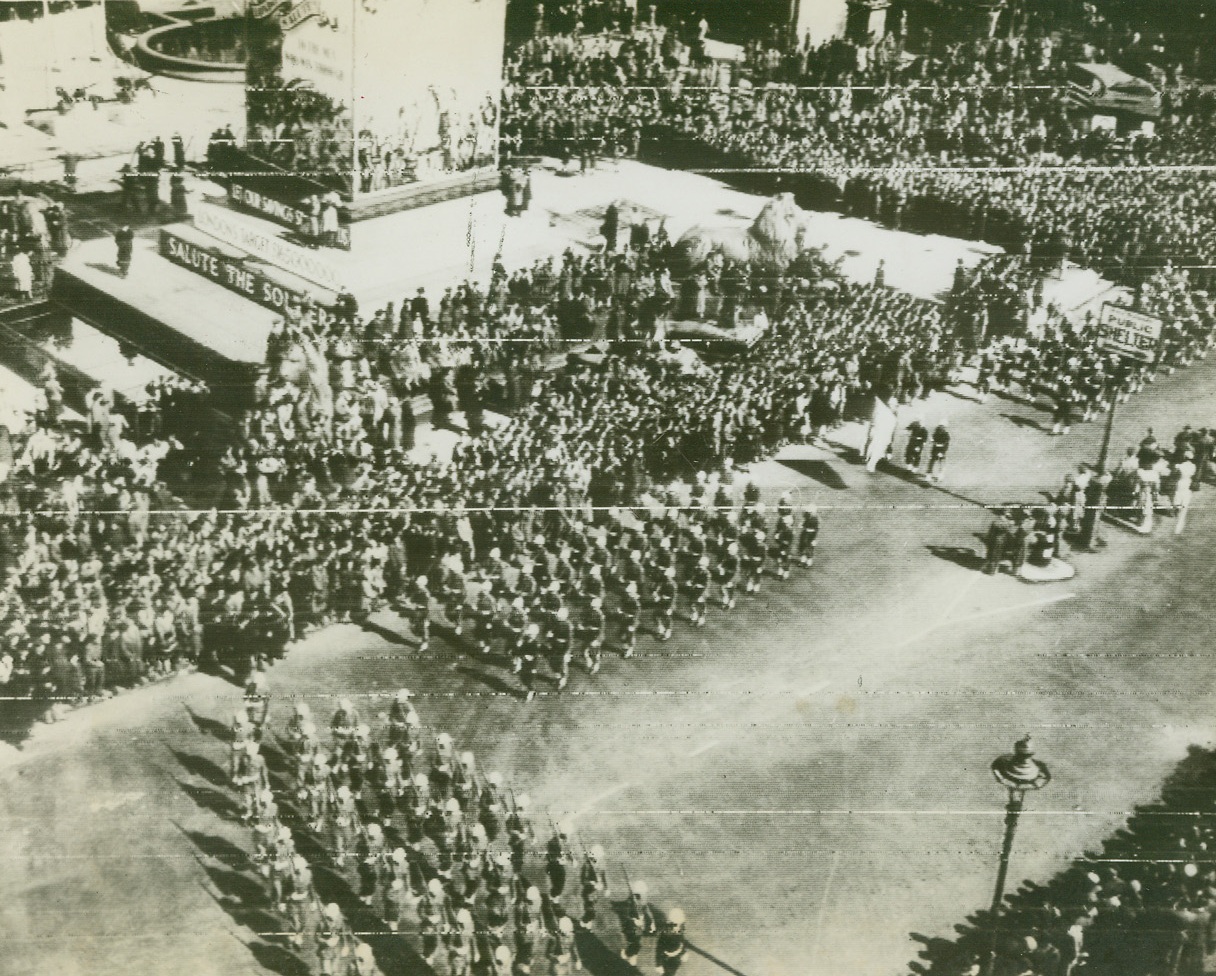
YANKS PARADE IN TRAFALGAR SQUARE, 3/30/1944. LONDON – Marching in the great parade to boost Britain’s current war bond drive today (March 30th), American warriors tramp past the reviewing stand in London’s Trafalgar Square. American soldiers, WACs and mechanized equipment were in the parade, with men of the U.S. Army Air Forces getting the biggest hand as they marched by. Photo radioed from London.Credit: Acme;
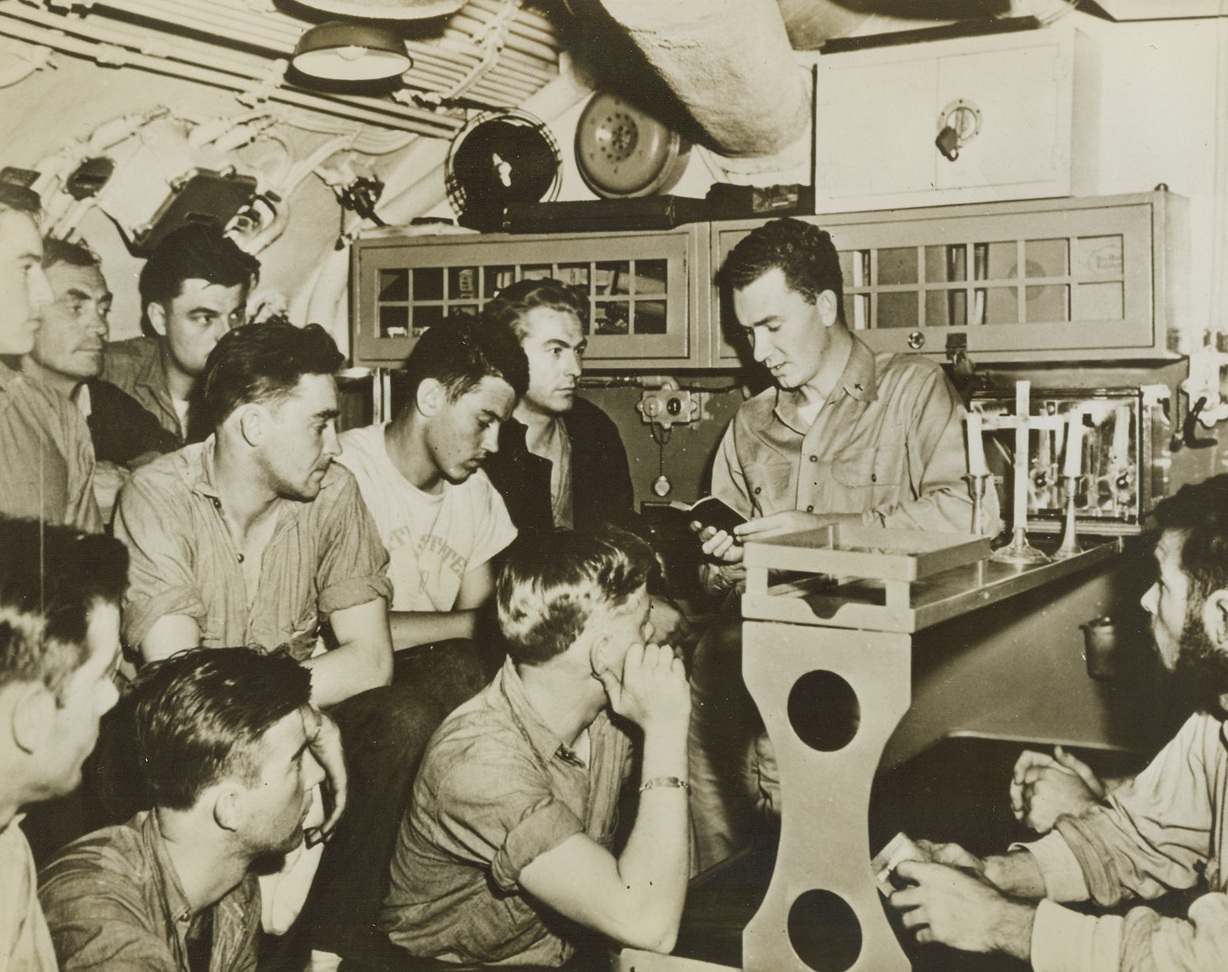
UNDERSEAS SERVICE, 3/28/1944. “SOMEWHERE AT SEA” : With a simple cross placed on a mess counter, Chaplain W.S. Brown, of Toledo, O., holds a church service in the confines of a U.S. submarine while it’s out on sea war patrol. It was believed to be the first service of its kind, as underseas fighters do not usually carry Chaplains. Chaplain Brown was a passenger aboard the submarine on his way to a new station “somewhere in the Pacific.”Credit: Acme;
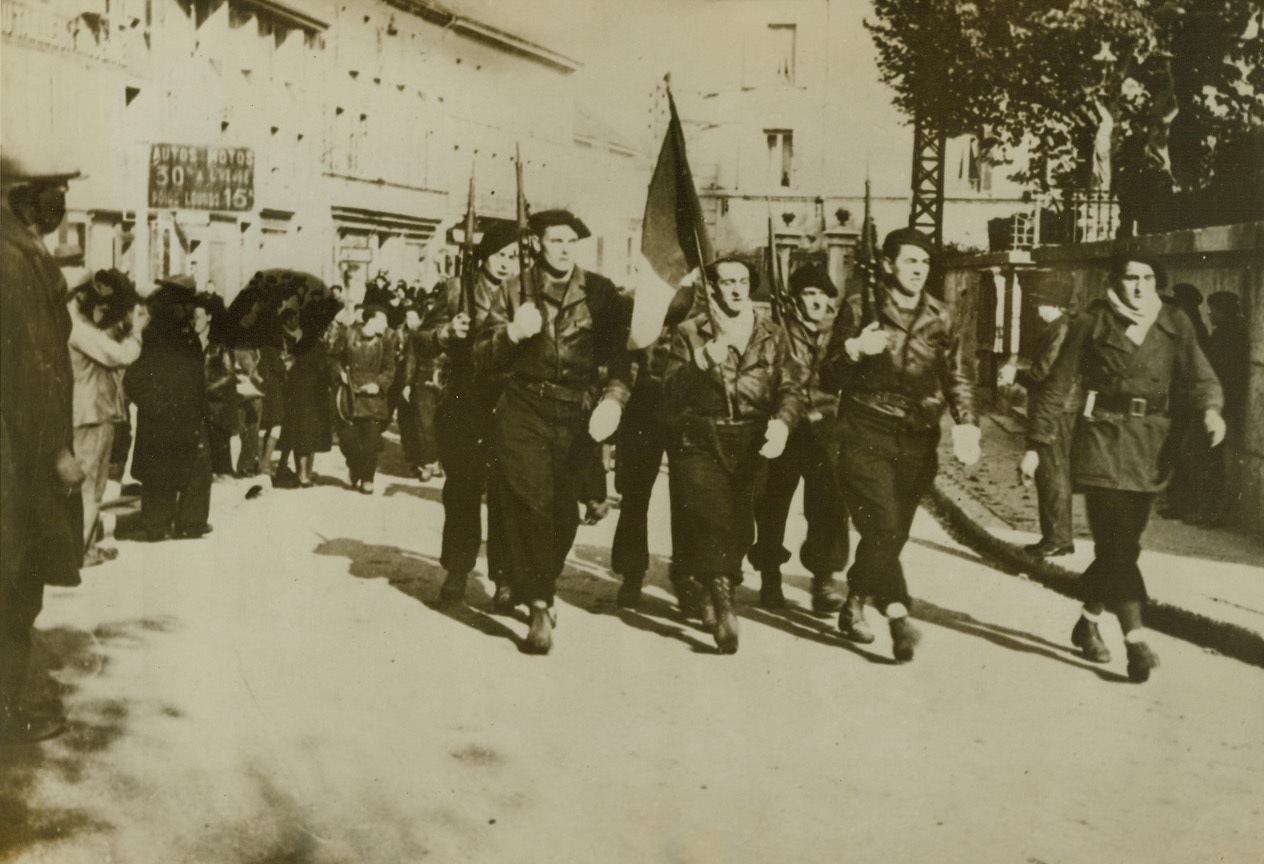
THEY “PULLED A FASTIE”, 3/28/1944. OYONNAX – Maquis warriors march through the streets of Oyonnax, 20 miles West of Geneva, on their way to an Armistice Day ceremony on Nov. 11, 1943. Putting one over on the Nazi and Vichy authorities, who were deceived by posters announcing an Armistice Day celebration in another town, the Maquis took over the town, conducted the memorial services, sang the marsellaise, and returned to their hidden camps. And the Nazis were waiting impatiently, 12 miles away, for the services to being.Credit: Acme;
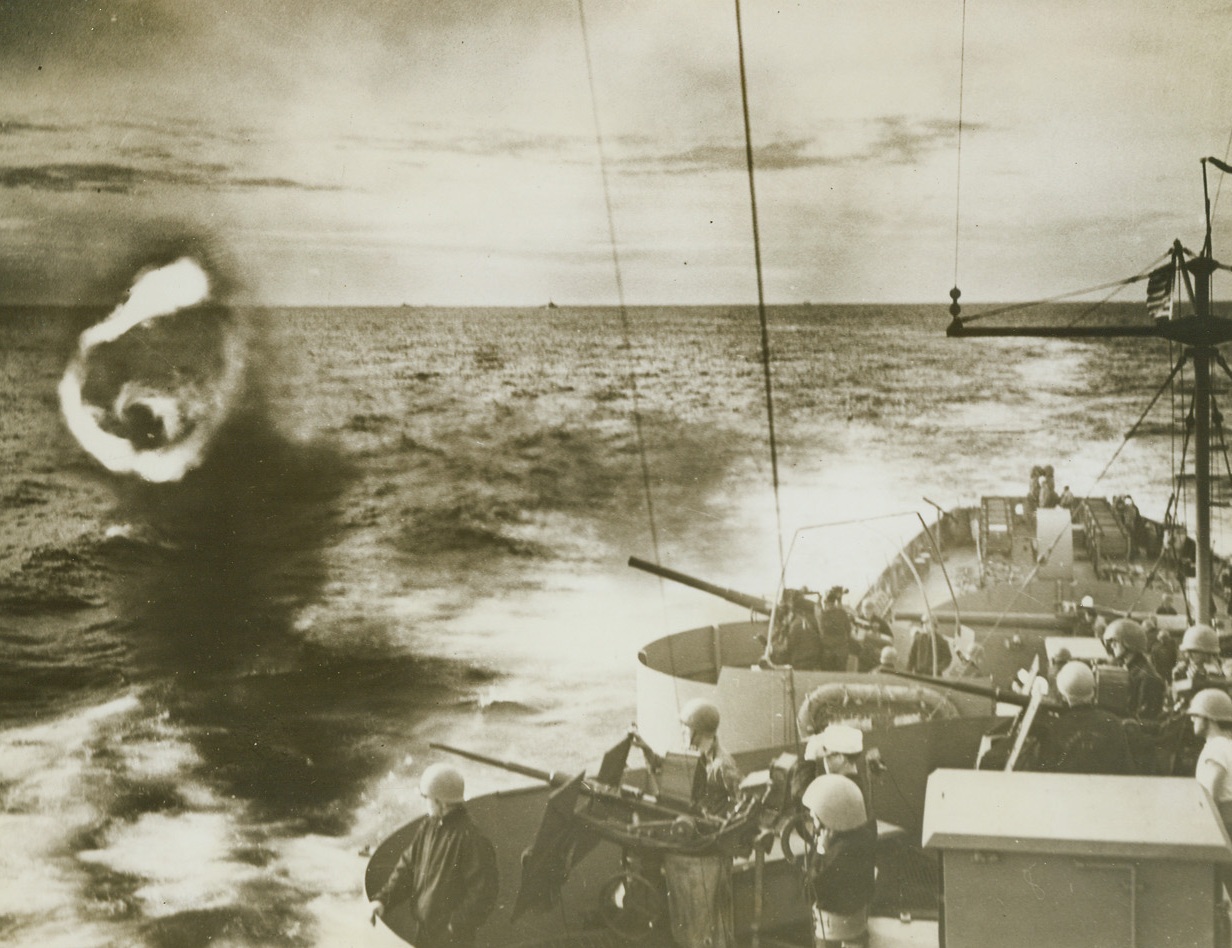
COAST GUARD GUN BLOWS SMOKE RING, 3/29/1944. IN THE NORTH ATLANTIC – Battle practice proves pleasurable for the Coast Guard gunners when their guns cut capers such as this huge smoke ring ejected from the mouth of a three-incher. Frequent drills while on convoy and patrol duty, keep the Coast Guard on the alert for battle.Credit: US Coast Guard photo from Acme;
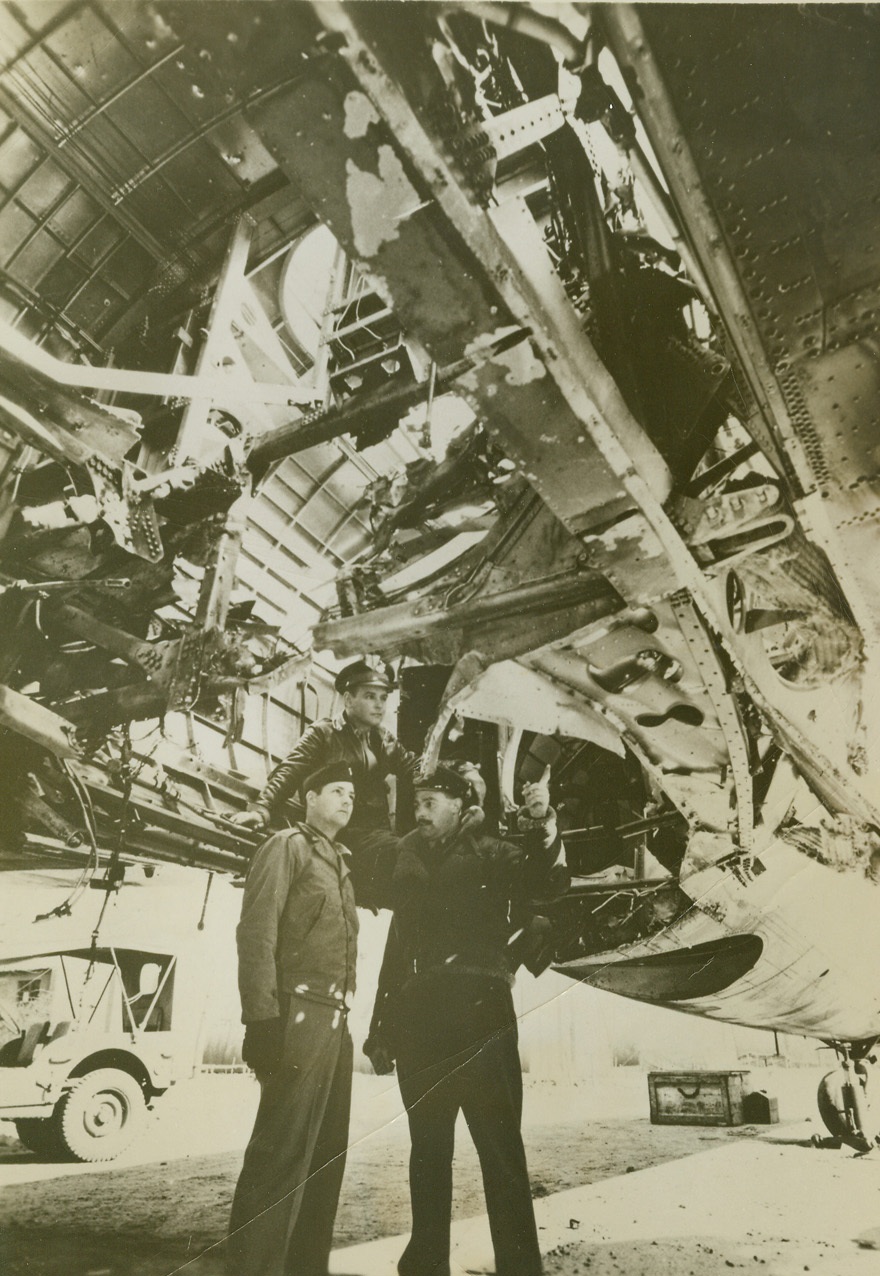
STILL SHE CAME HOME, 3/30/1944. ENGLAND – With cables, wires and tubing hanging limp and frayed from her gaping underbelly, her radio room floor cone, and a jagged hole torn in her roof, the Flying Fortress “Dottie Jane” returned to her base, an Eighth Air Force bomber station in England, after a raid on Nazi war plants in Berlin. The war bird was torn by a direct hit by flak while over the target, and her radio operator vanished into thin air five miles above Germany. Pilot 1st Lt. Arthur R. Socolofsky of Chicago, Ill., brought the battered ship back.Credit: Acme;
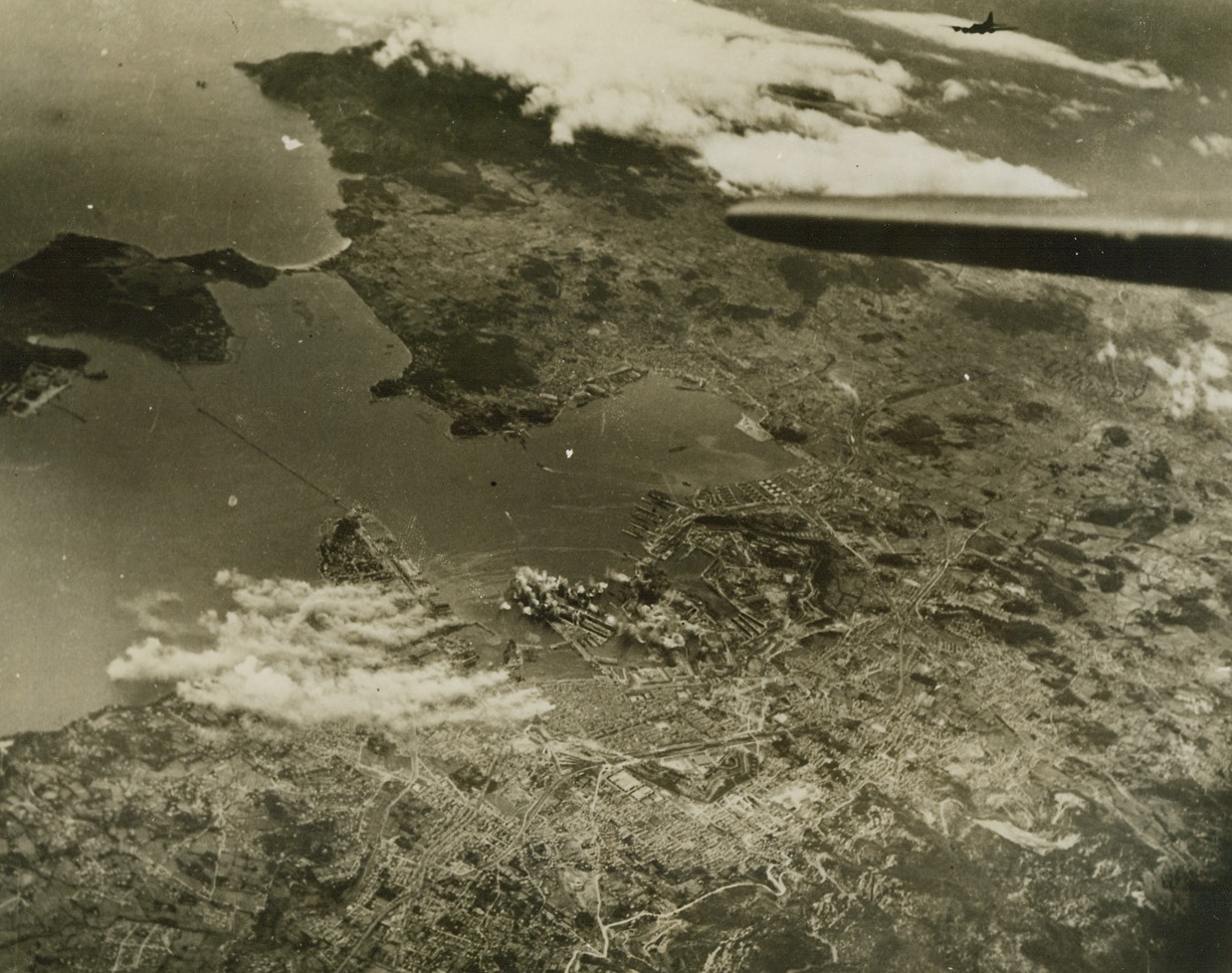
BLASTING SUB PENS AT TOULON, 3/8/1944. This photo, released in Washington today, shows bombs exploding on Nazi-held submarine pens (exact center of photo) in the harbor at Toulon, France, was taken by Major Gordon Sarre, of New York City, during a recent raid by heavy bombers of the U.S. Army Air Forces. To the left of the exploding bombs (in photo) columns of smoke mark burning installations. Today, it was announced that heavy U.S. bombers had again blasted Toulon. Credit: USAAF photo from Acme;
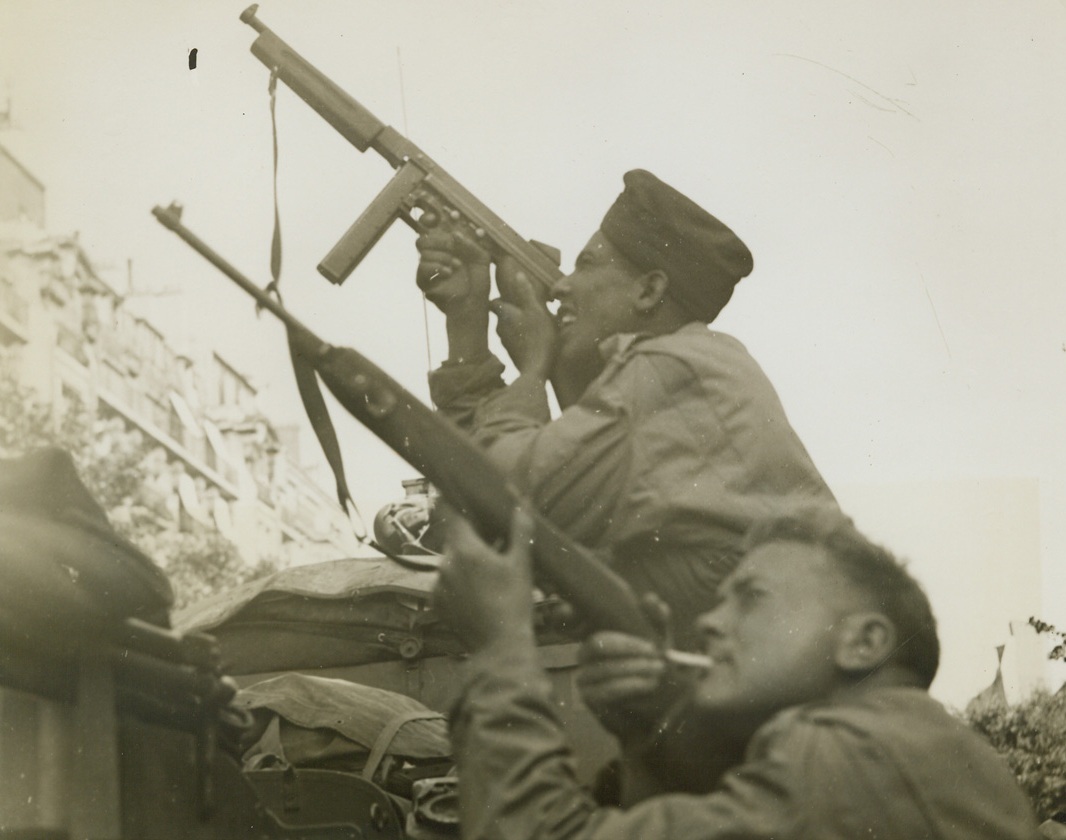
SNIPE AT NAZI SNIPERS IN PARIS, 3/30/1944. FRANCE – Two members of the French armored division, one with a cigarette in his mouth, fire at snipers in a Paris building as they cover the entry of the main column of French troops into the French capital. Credit: Acme photo by Charles Haacker, War pool correspondent;
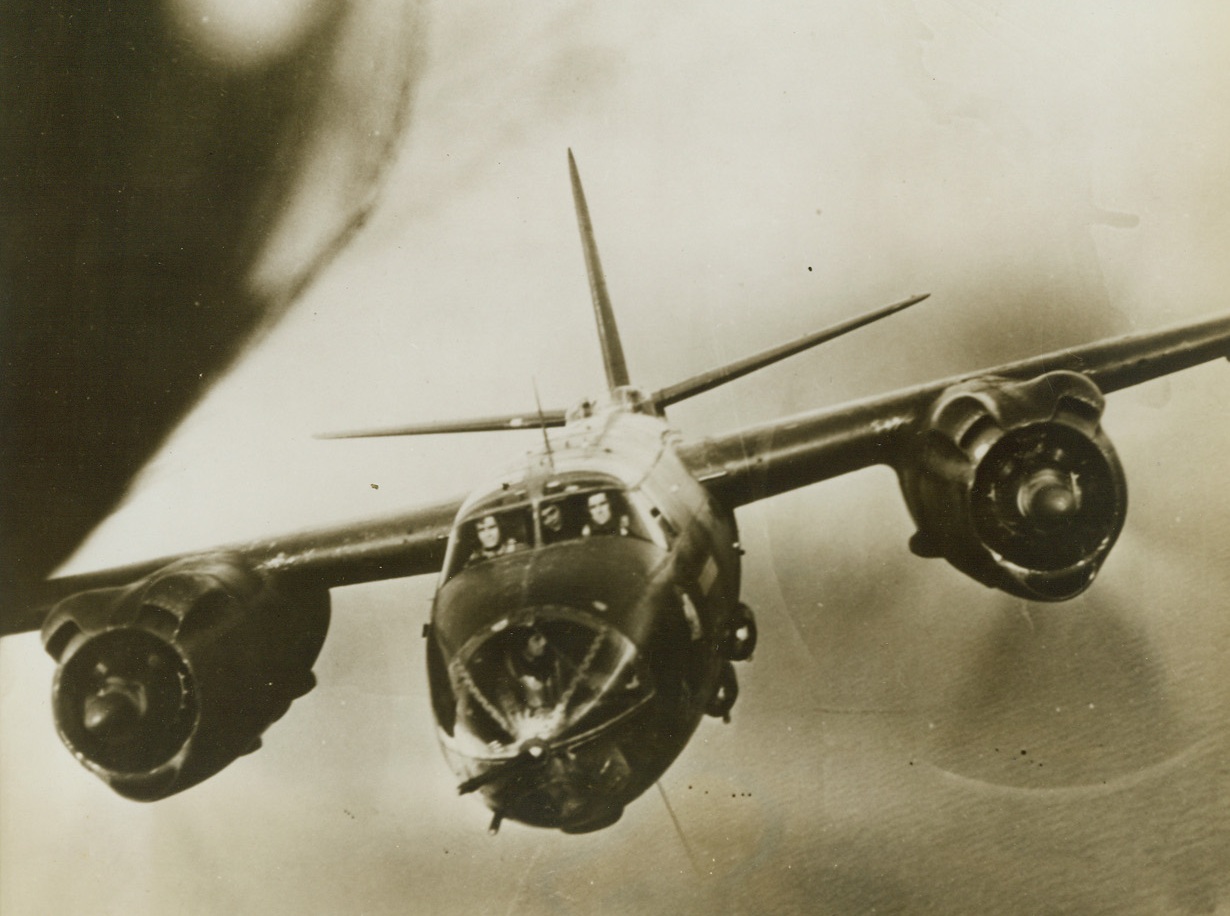
CLOSE FORMATION…BUT CLOSE!, 3/4/1944. BRITAIN—If this B-26 Marauder of the Ninth U.S. Air Force came any closer, it would be chewing off the tail of the ship before it! The medium bombers were flying in such close formation that the photographer in the ship ahead was able to make a clear photo of the crew at their stations. Credit Line (ACME);

ZOOMING ACK-ACK, 3/12/1944. SOMEWHERE IN ENGLAND—Many Nazi raiders who never lived to tell the tale met their death in the roaring flame of Britain’s new “Z-gun.” Anti-aircraft rockets that roar ominously as they zoom upward, this new “ack-ack” explodes in large and vivid flashes as it tangles with Luftwaffe planes. Details of the construction and operation of the “Z-guns” are still secret, but they have already accounted for many lost Nazi planes in raids over England. The rocket projectiles are shown as they climbed through the skies during a night raid. Credit Line (ACME);
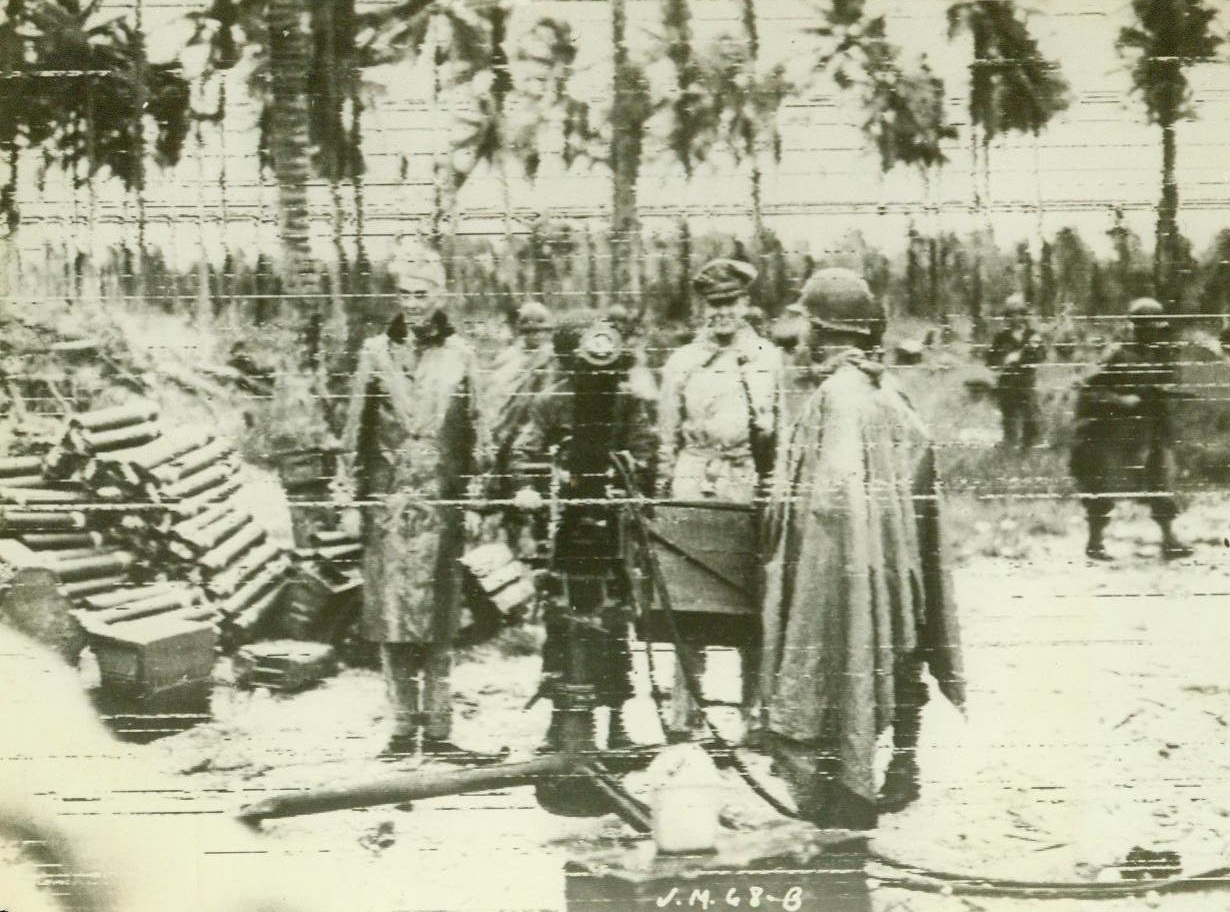
MacArthur in Admiralty Islands, 3/2/1944. Manus Island—Vice Admiral Thomas C.Kinkaid (Left) and General Douglas MacArthur (Second From Right) inspect a 50 Cal. Anti- Aircraft- machine gun at Momote bay, Manus Island, after American forces had occupied the island in the admiralty group, last Feb. 29th. Gen. MacArthur, supreme allied commander in the southwest Pacific, had watched the invasion of the Jap-held islands from a bridge of one of the vessels of the task force and had landed soon after elements of the first U.S. Cavalry Division (dismounted) had landed on Manus. 3/2/44 (ACME);
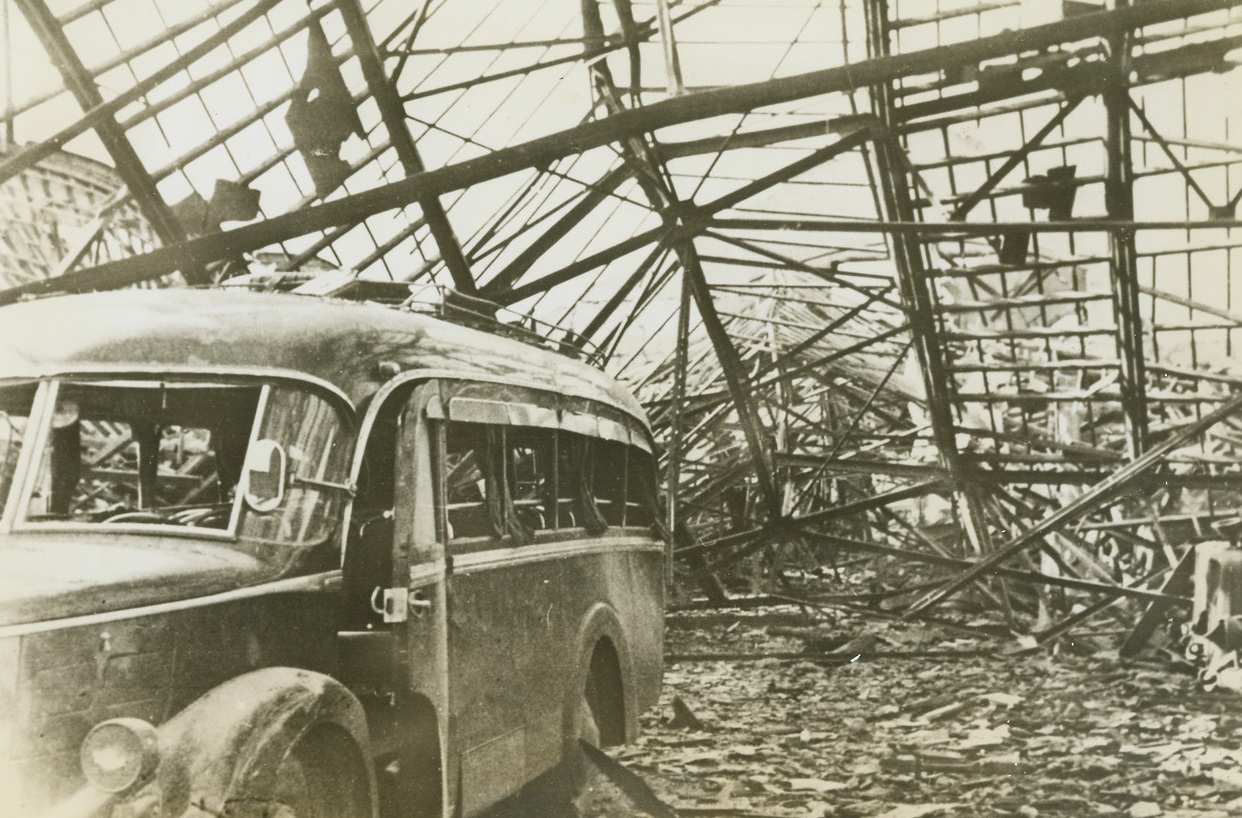
French Underground Scores Again, 3/28/1944. Grenoble, France – When German occupation troops refused an ultimatum from the French Underground demanding the release of hostages seized after French patriots had blown up the Artillery Park and Arsenal at Grenoble, Nov. 13, 1943, the Underground blew up the Barracks “De Ronne” killing 220 Germans outright, and wounding 500. Part of the wreckage of the blasted barracks and a motor garage are shown in this photo, smuggled out of France and just released in the United States. (Passed by Censor) Credit: ACME;
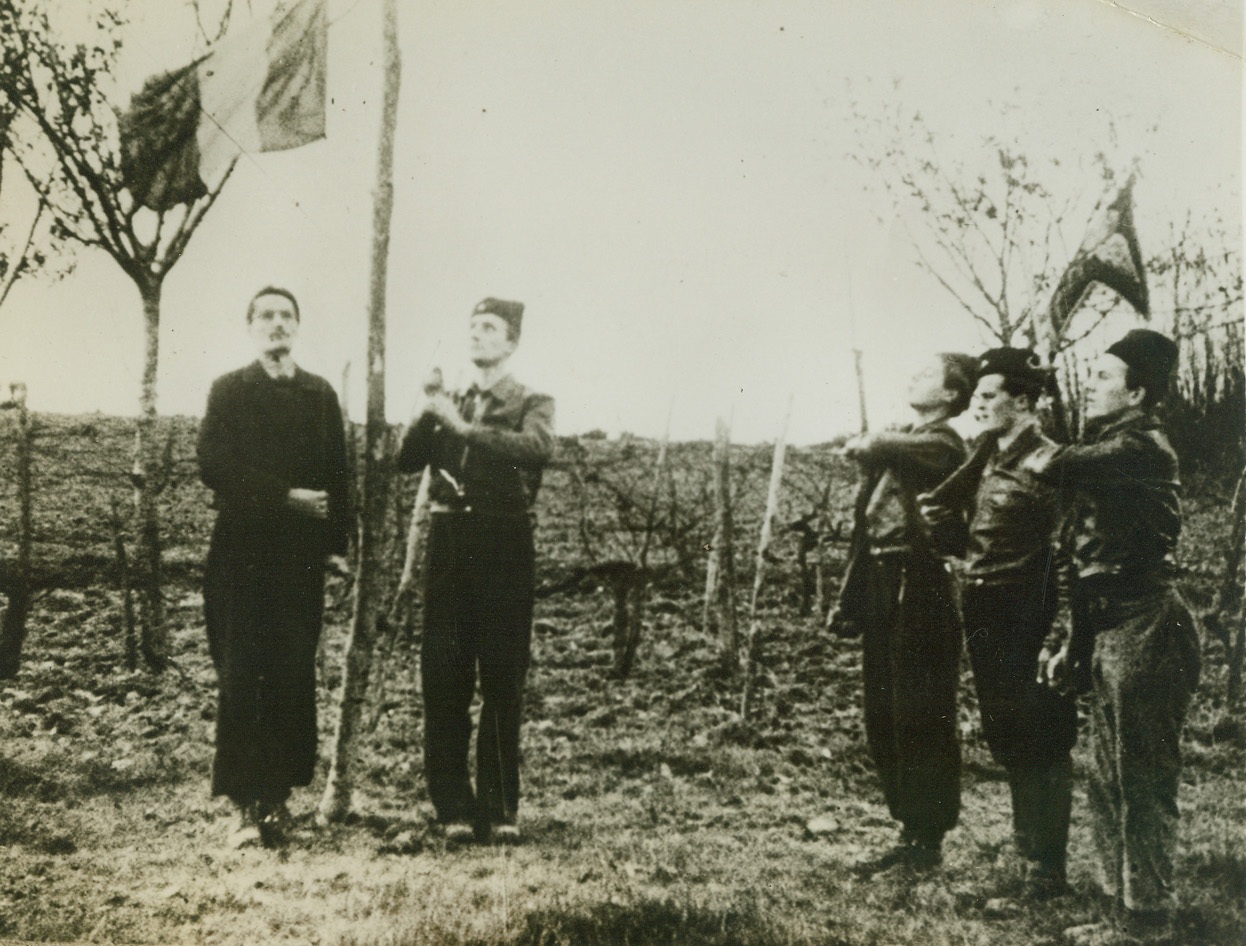
First Photos of French Underground, 3/13/1944. This photo, smuggled out of France and which just reached the U.S., is from a movie film made at one of the secret bases of the Maquis—French guerillas of the Underground who are fighting in the Savoy mountain regions. This is one of the first photos ever to reach the U.S. of the routine life of the guerillas before Darnand, the Himmler of France, launched his main attack on them early last February. These Maquis have forced the Germans to keep 6,000 troops in the Haute Savoie district, and are laying a solid foundation of offensive aid for the coming Allied invasion. Here, at a Maquis base, the day begins with the traditional French military ceremony of saluting the Tricoleur. Passed by censors. Credit: ACME;
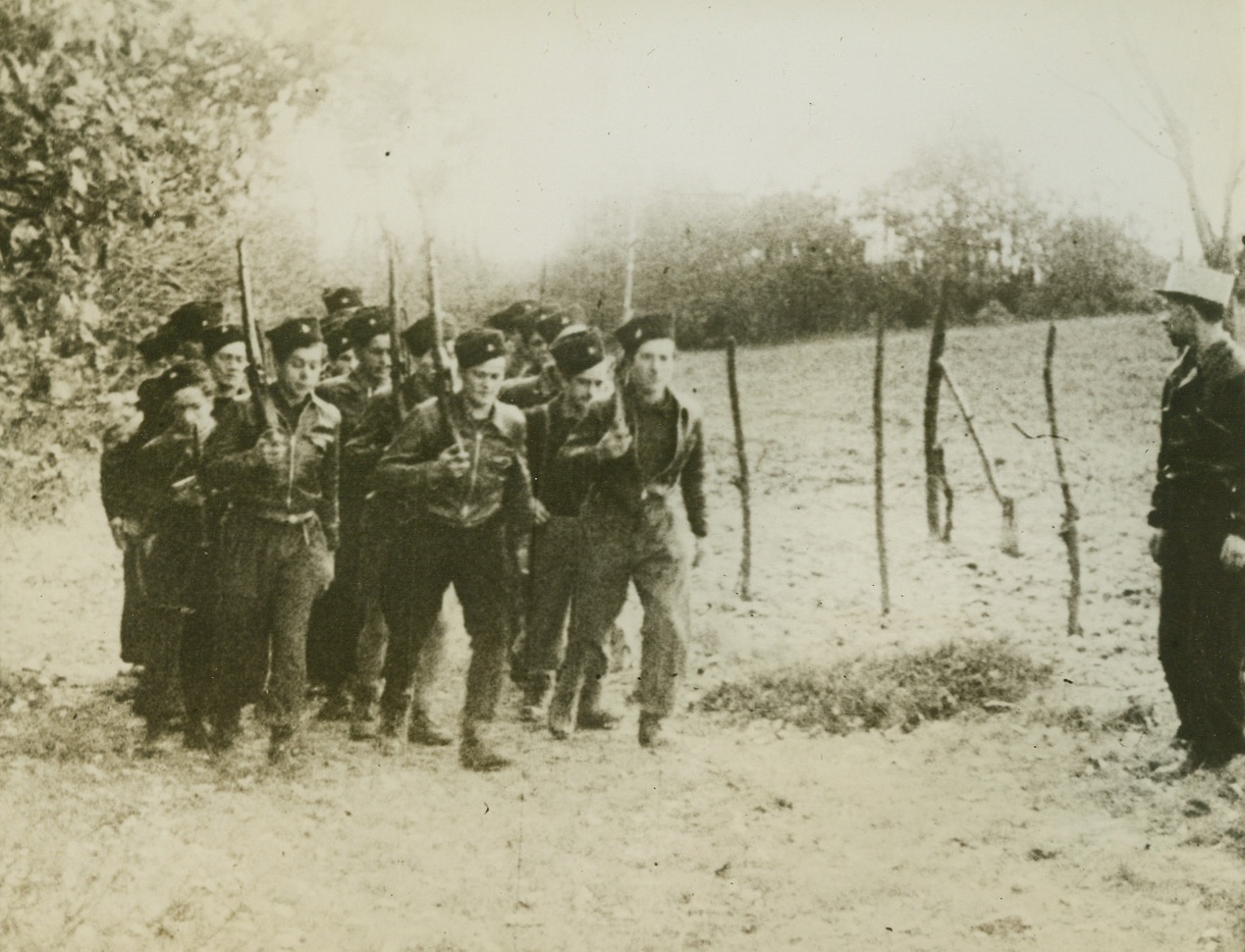
First Photos of French Underground, 3/13/1944. This photo, smuggled out of France and which just reached the U.S., is from a movie film made at one of the secret bases of the Maquis—French guerillas of the Underground who are fighting in the Savoy mountain regions. This is one of the first photos ever to reach the U.S. of the routine life of the guerillas before Darnand, the Himmler of France, launched his main attack on them early last February. These Maquis have forced the Germans to keep 6,000 troops in the Haute Savoie district, and are laying a solid foundation of offensive aid for the coming Allied invasion. Here, former cavalrymen drill on foot at a Maquis base. For security reasons, and to make food supplies easier, patriots are divided into small groups. Credit: ACME;
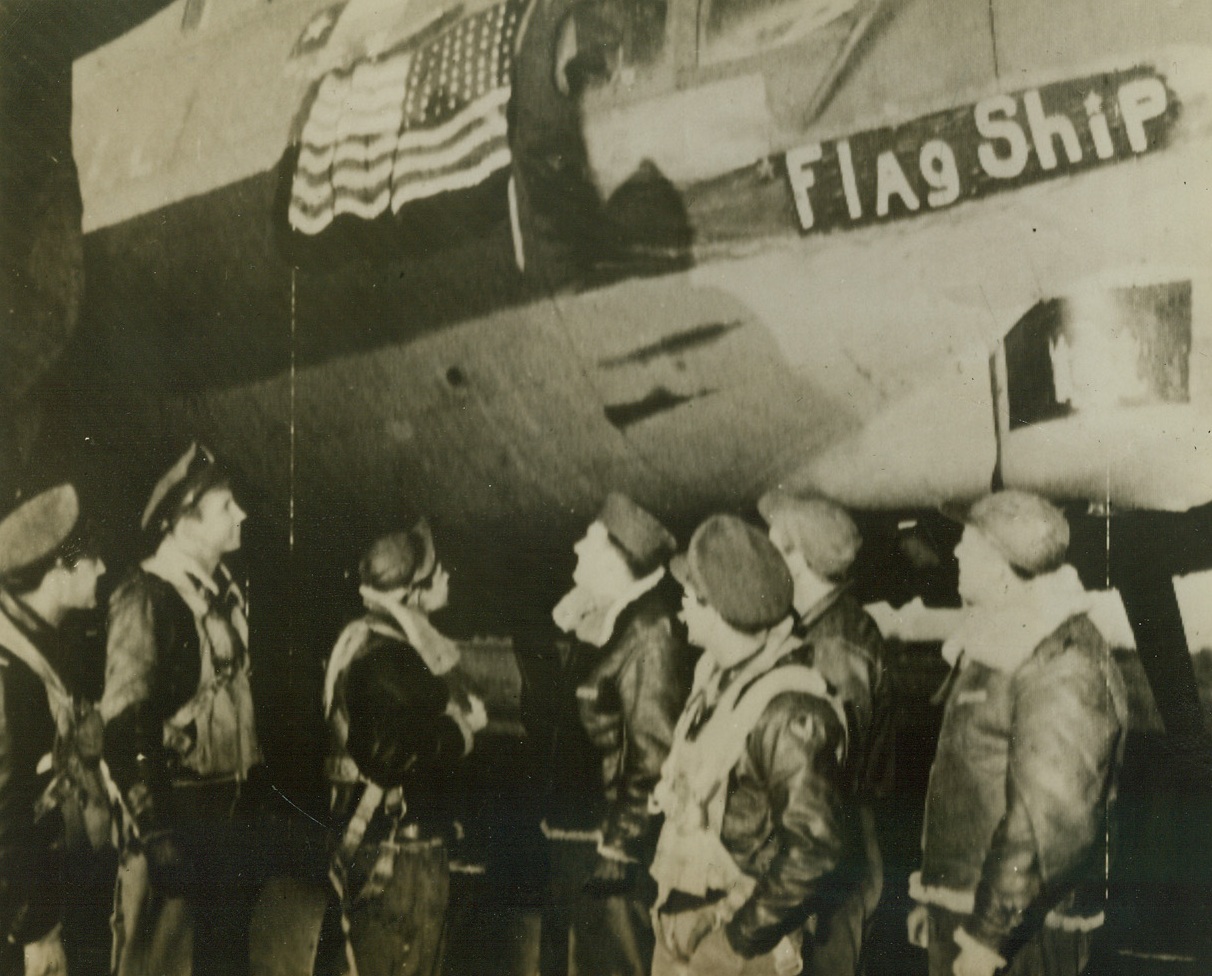
First U.S. Flag Over Berlin, 3/13/1944. Britain – Crew members of the Flying Fortress “Flagship” gaze at the Stars and Stripes painted on the side of their ship after their return to their base “somewhere in Britain,” from the first American daylight raid on Berlin. The flag on the plane’s fuselage was, therefore, the first flag to fly over the German capitol. Left to right are: Lt. William Matetich, of Koppel, Pennsylvania; Lt. Preston M. Dean, Hartsville, South Carolina; T/Sgt. Adolph A. Alvarez, Corpus Christi, Texas; S/Sgt. L.W. Bedey (CQ), of New York City; Lt. A.D. Wolfe, Richmond Hill Long Island, New York; S/Sgt. Thomas Cook, Pittsburgh, Pennsylvania; and S/Sgt. W. Pickup, of Camden, New Jersey. Credit: U.S. Signal Corps Radiotelephoto from ACME;
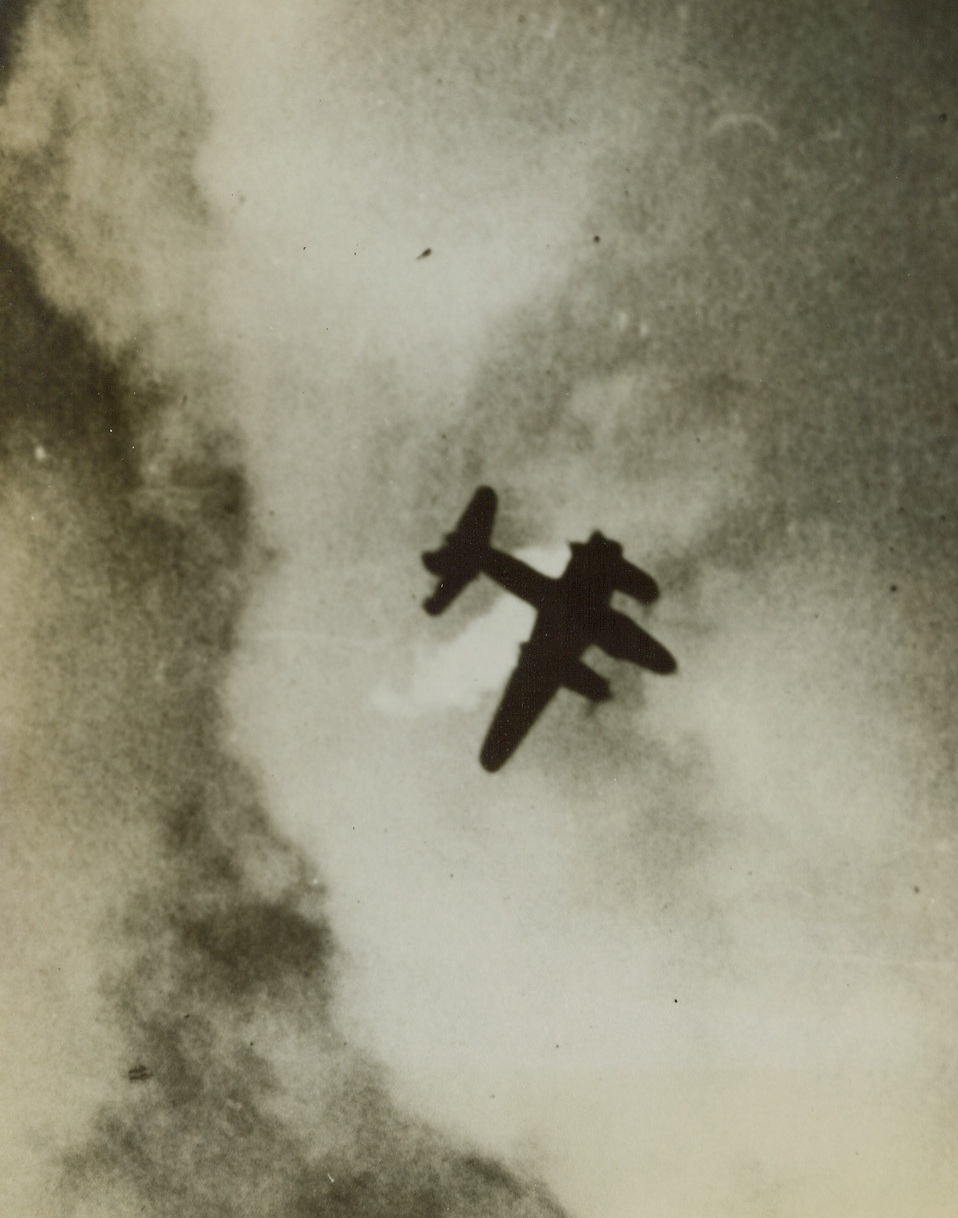
Mission Completed, 3/9/1944. Somewhere in France – Its wing shorn off by enemy flak, a B-26 Marauder goes down in flames after completing its bombing mission over military targets in the Pas de Calais area of France. The Ninth Air Force medium bomber streaked through a heavy curtain of flak to complete its job. Credit: ACME;
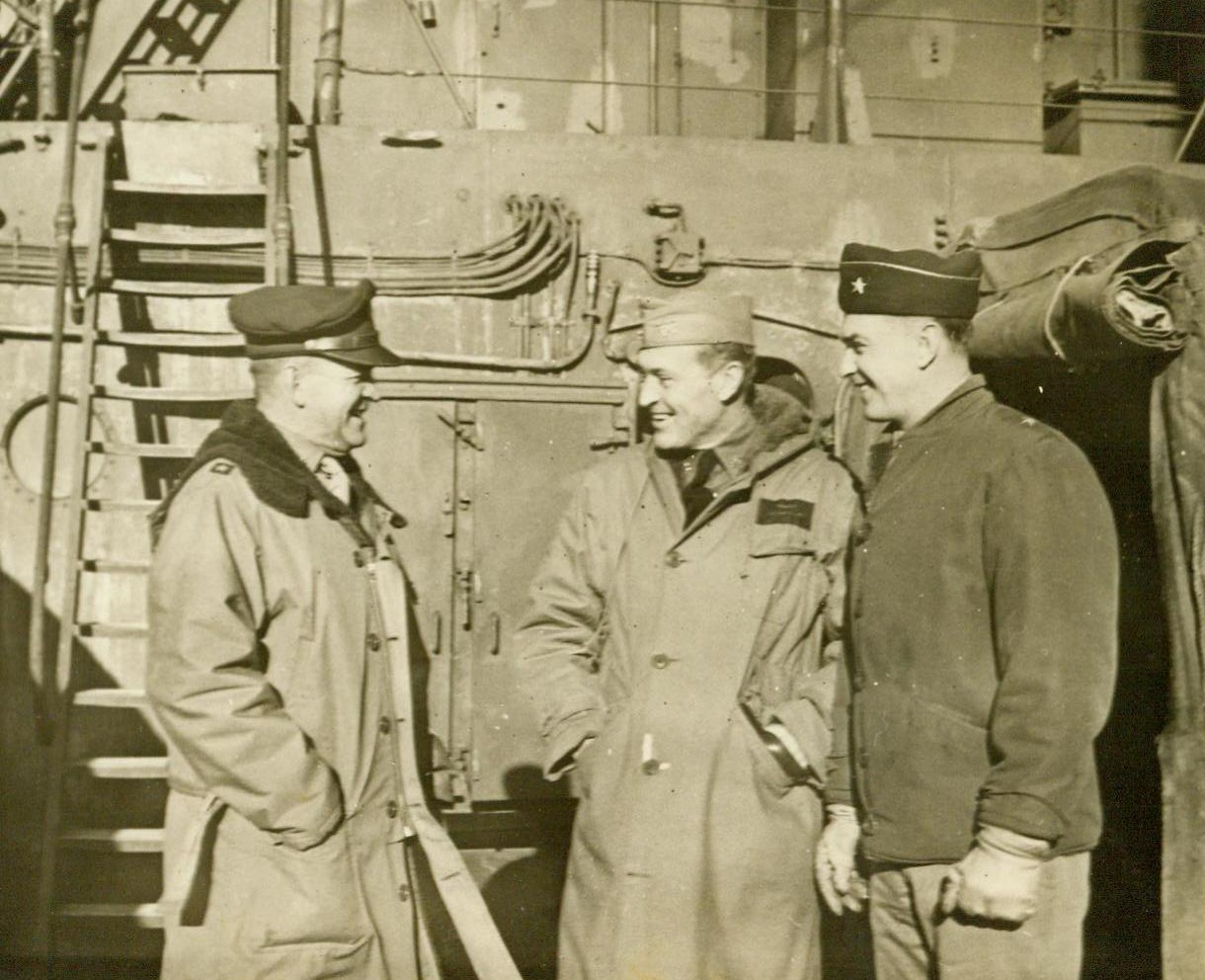
Task Force Commander and Observers, 3/2/1944. Somewhere in the Pacific— Aboard the flagship of a U.S. Naval task force which bombarded Paramushiro, Nipponese Kurile Islands Naval Base, early last February, are (LtR): Maj. Gen. Davenport Johnson, Commander with USAAF, based in Alaska; Rear Adm. Wilder D. Baker, Task Force Commander; And Brig. Gen. E. D. Post, Chief of Staff, Army Alaska Department. The two Army officers accompanied the force as observers. 3/2/44 (ACME);
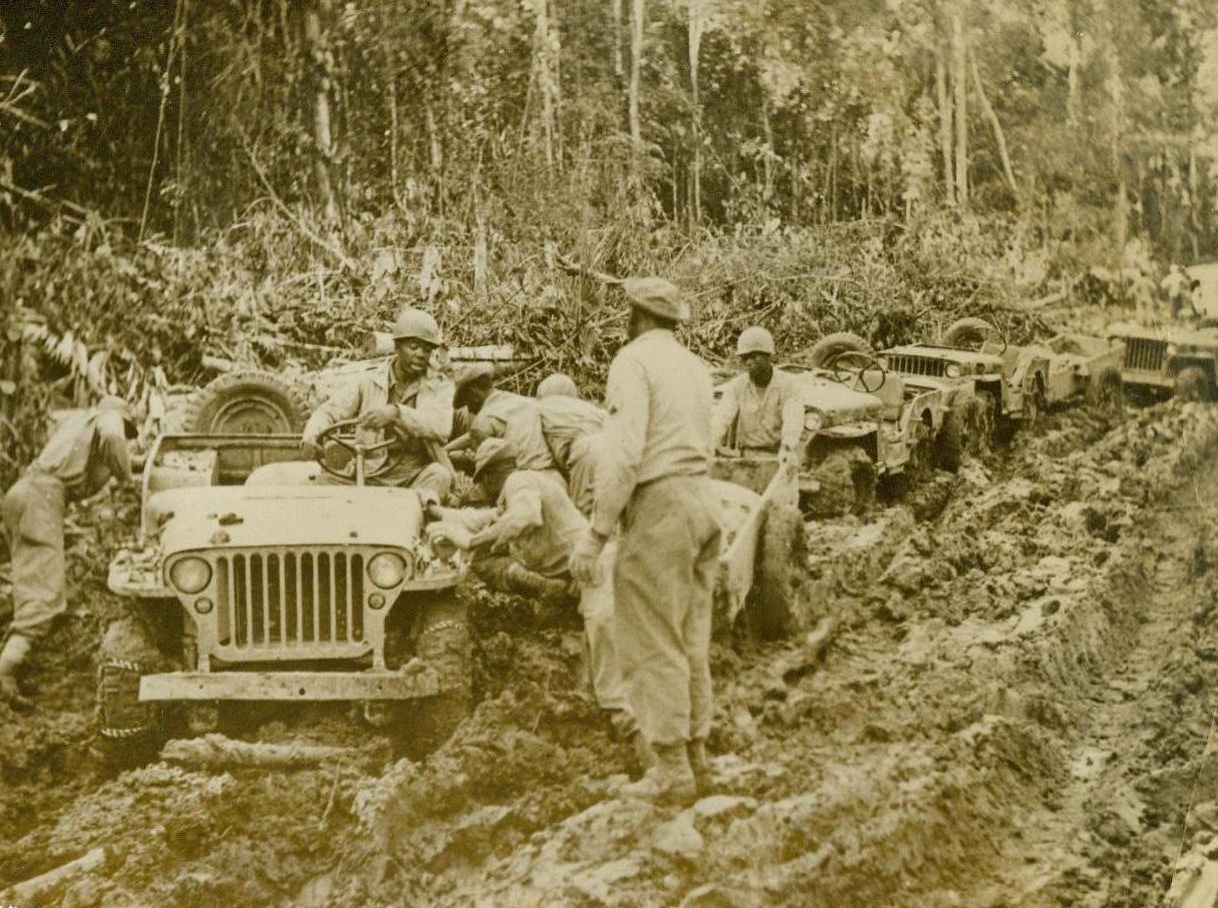
Supply Road to China-- Someday, 3/9/1944. Burma—If one Jeep bogs down in the mud of the New Ledo road, the whole caravan of blitz buggies is temporarily halted. Negro soldiers attached to an engineering Division building the supply route to China try to extricate a buggy from the deep, shifting mud on a section of the road that has just been cleared of Jungle growth. 3/9/44 Acme;
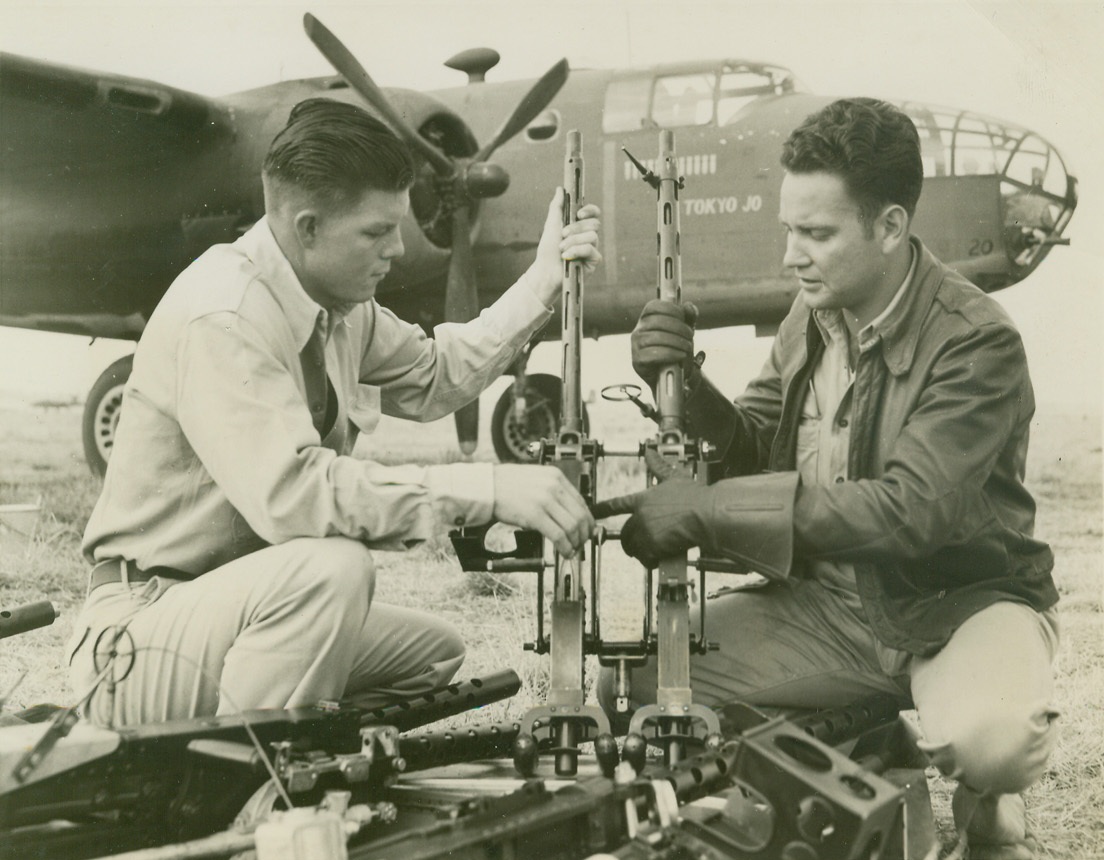
Ace Gunners Get Set For a Raid, 3/4/1944. CBI War Theater—Judged two of the leading gunners of all U.S. bomber crews in China, T/Sgt. Norton G. Stubblefield, of Dallas, Tex., (left) and T/Sgt. Adam R. Williams, of Morgantown, N.C., put their 50 caliber machine guns in top working order before a raid. Sgt. Stubblefield holds the Silver Star, and Sgt. Williams, veteran of the Tokyo mission, has the DFC, Silver Star and a Chinese decoration called “Order of the Clouds.” Credit: ACME photo by Frank Cancellare, war pool correspondent;
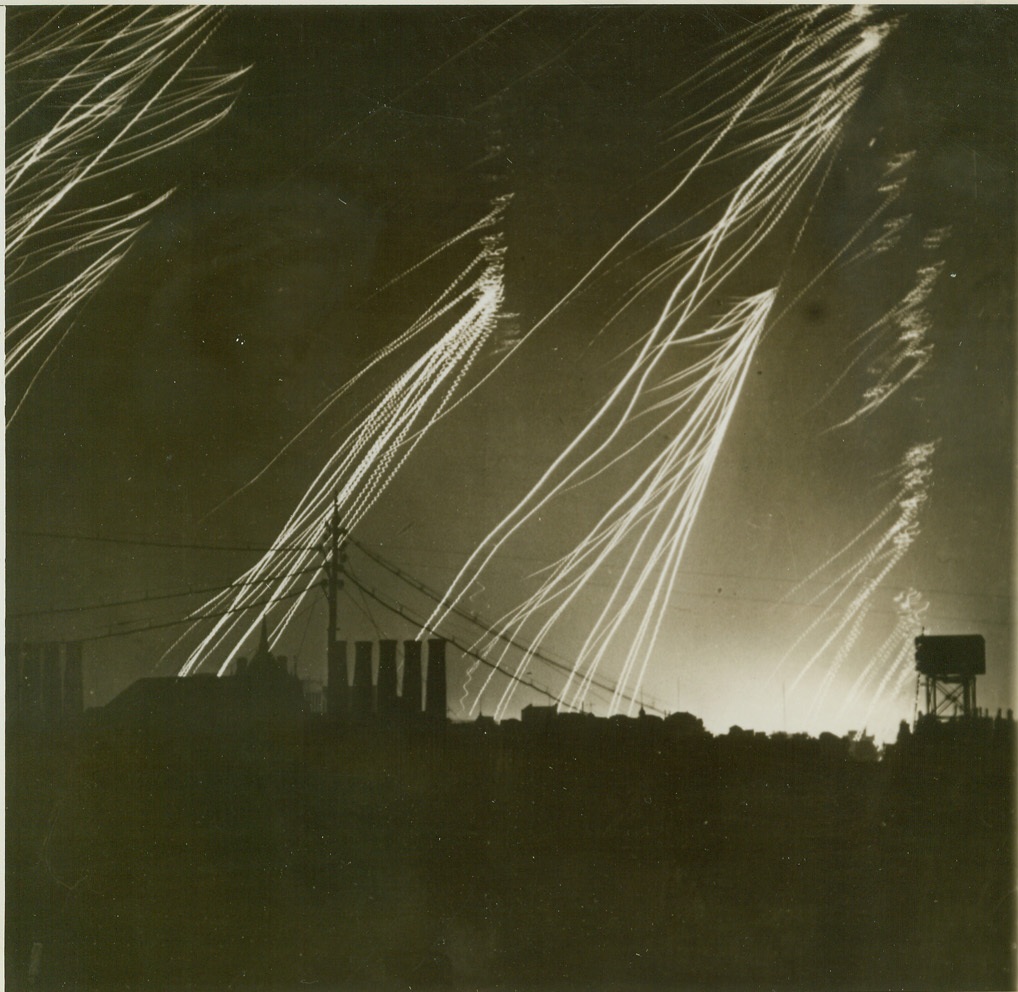
War Lightning Over London, 3/4/1944. London, Eng.—A weak Nazi raid over London is the signal for a barrage of bursting shells, pockets and new types of projectiles to be sent up by the defending British. Flares and flak make a silhouette of the rooftops and the continental roar of the anti-aircraft barrage far exceeds the sound of exploding Nazi bombs. Credit: ACME;
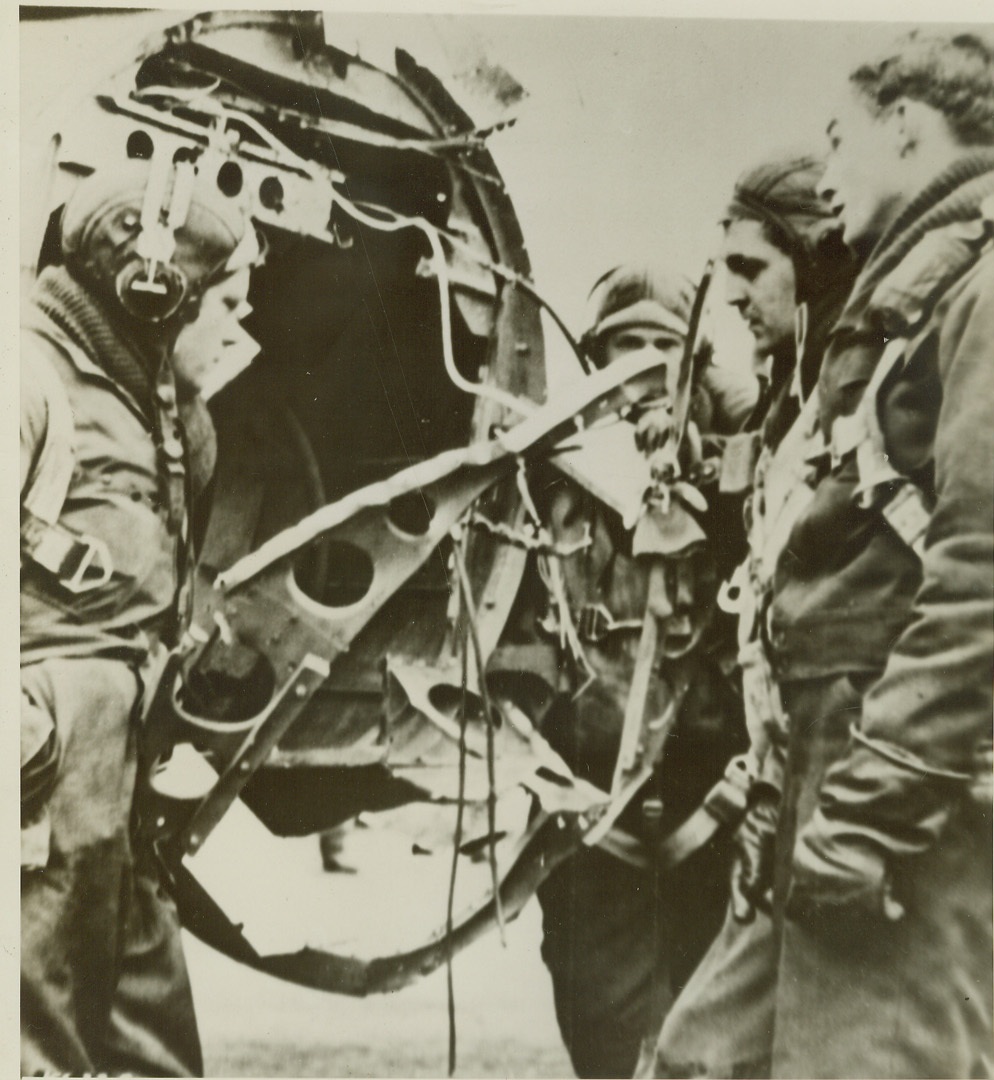
Lost Their Tail Gunner, 3/27/1944. England—The crew of an American bomber look sadly at the after end of their ship, following their return to a base in England. The tail gunner, and their buddy, was at his post when a burst of flak knocked a section of the plane’s tail off over Hamm, Germany. Left to right, are: Sgt. Ollie Crenshaw, of Birmingham, Ala.; S/Sgt William Blakeney, Little Rock, AR; Sgt. Bernard Bendin, East Chicago, Ind; and S/Sgt Seymour Berman, of New York City. Credit: U.S. Army radiotelephoto from ACME.;
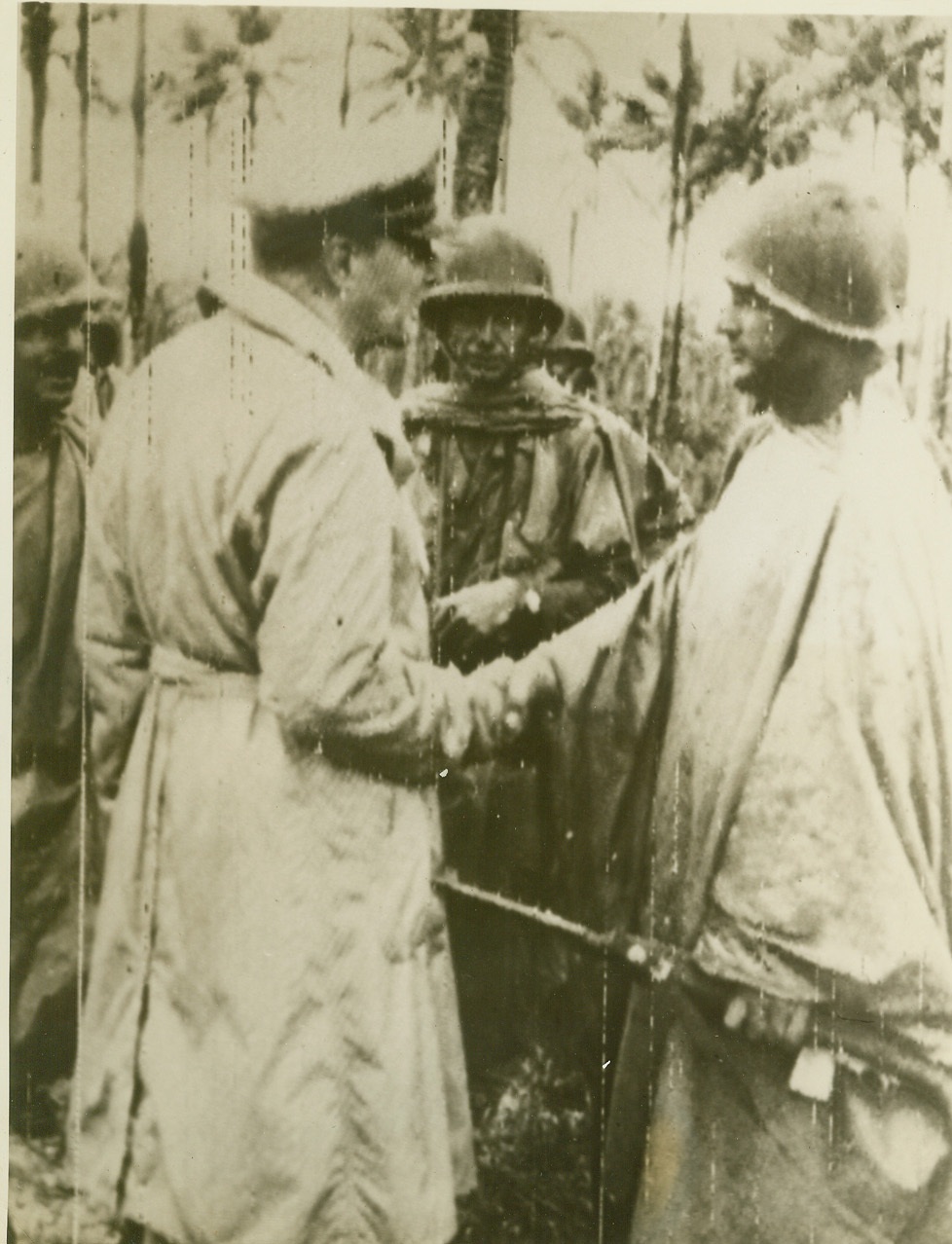
MacArthur Congratulates First Admiralty Lander, 3/2/1944. Los Negros, A.I.—Landing from destroyers Tuesday, Feb. 29th, elements of the U.S. 1st Cavalry Division captured Momote Airdrome on Los Negros Island in the Admiralties. General Douglas Macarthur (L) shakes hands with 1st Lt. Frank Henshaw of Alice, Texas, first man to land on the island, a feat for which he was awarded the D.S.C. Enemy resistance is being rapidly overcome and the operation proved to be extremely successful Macarthur said the action was started as a reconnaissance in force and became an invasion when the opportunity made itself available. Credit: Signal Corps radiotelephoto from ACME;
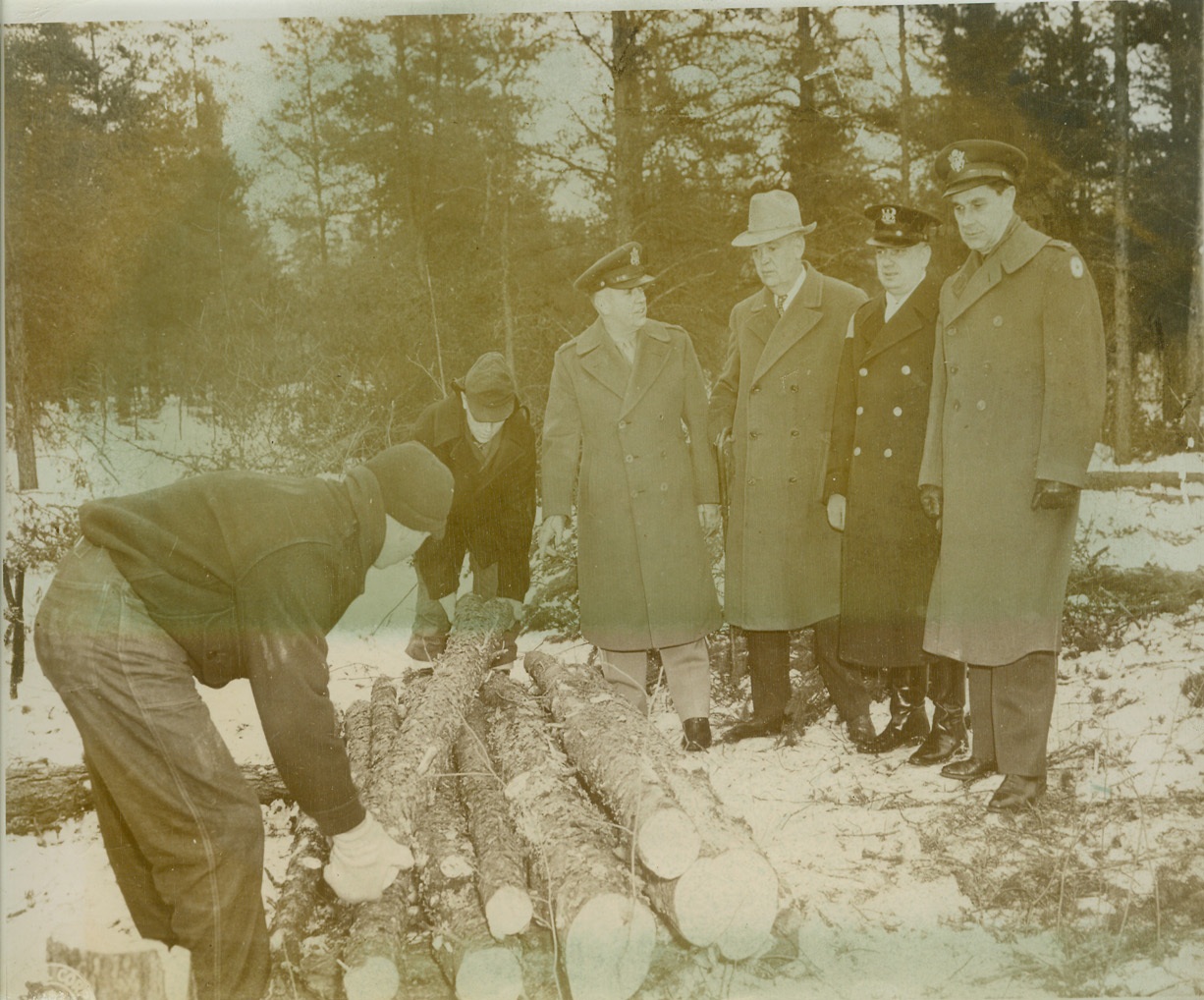
NAZIS HELP OUT IN NORTH WOODS, 3/12/1944. CAMP EVELYN, MICH. – Several hundred German prisoners from Rommel’s Afrika Korps have been brought to two former CCC camps in Northern Michigan near Evelyn and Sadinaw where they will learn the use of the double-bitted Michigan ax and the two-man saw with which they will cut pulp and chemical wood in this critical manpower shortage area. Geneva Conference provisions forbid prisoner of war participation in hazardous work, so these men will engage in less dangerous, but still necessary operations. Col. W.H. McCarty, Gov. H.F. Kelly, Michigan Police Commissioner Oscar G. Olander and Col. S.D. Ringsdorf (left to right) inspect logs cut by prisoners of war at Camp Evelyn, Mich. Credit: U.S. Army photo via OWI Radiophoto from ACME;





 Trash & Recycling
Trash & Recycling
 Online Payments
Online Payments
 City Documents
City Documents
 Parks
Parks
 Traffic Court
Traffic Court
 CITY PARKS
CITY PARKS
 RECREATION
RECREATION
 Volunteer
Volunteer
 Home
Home TRANSLATE
TRANSLATE
